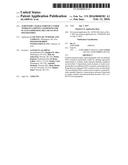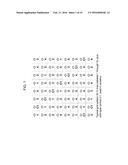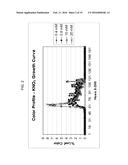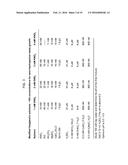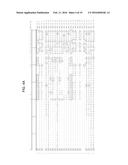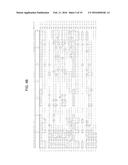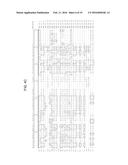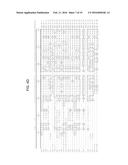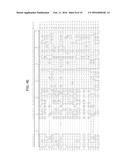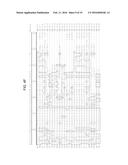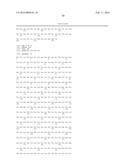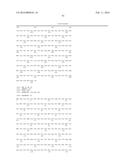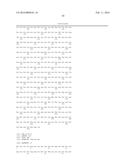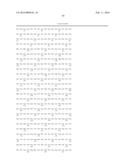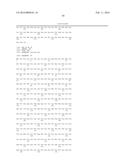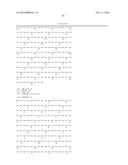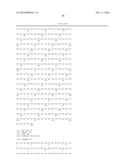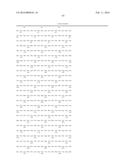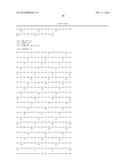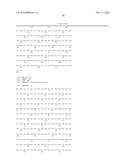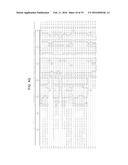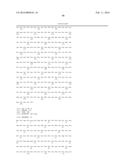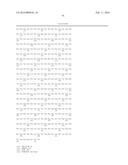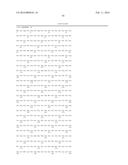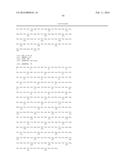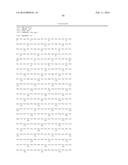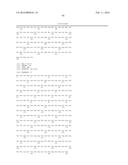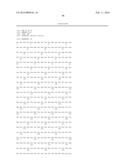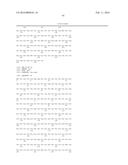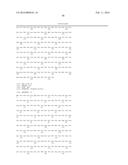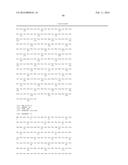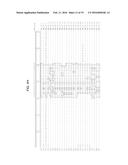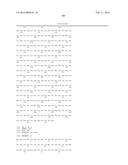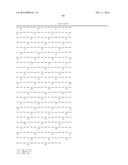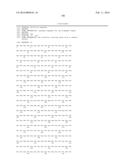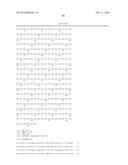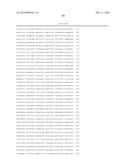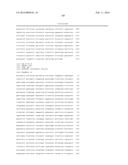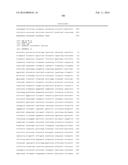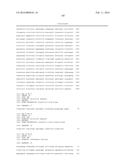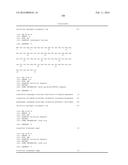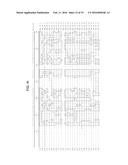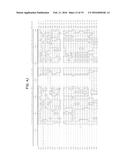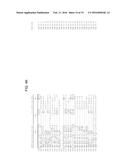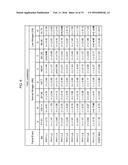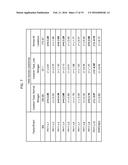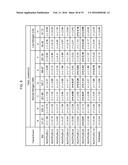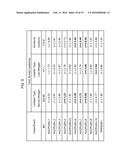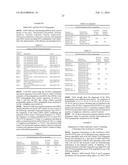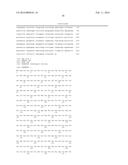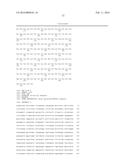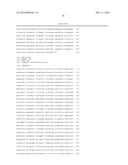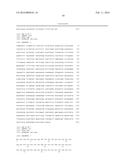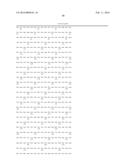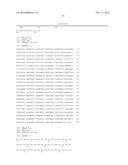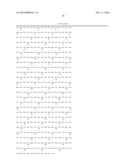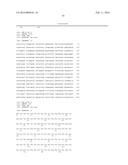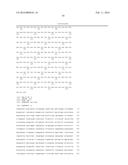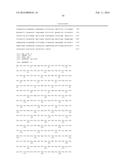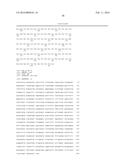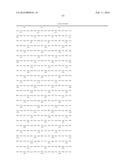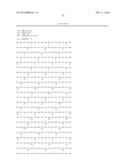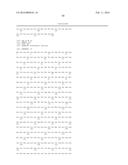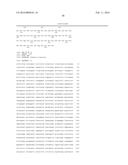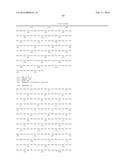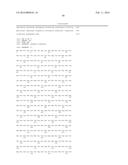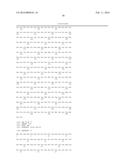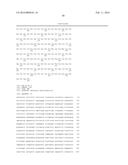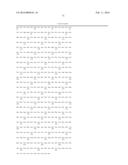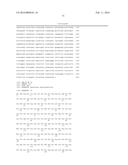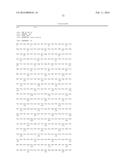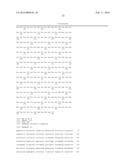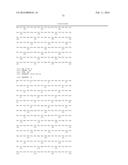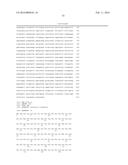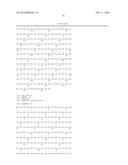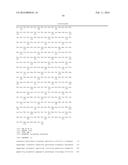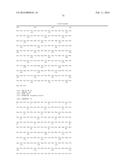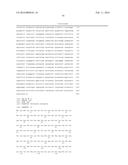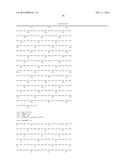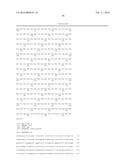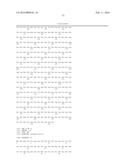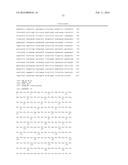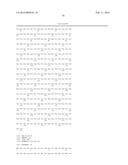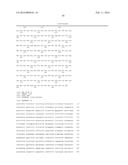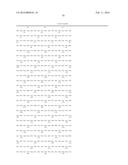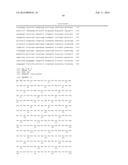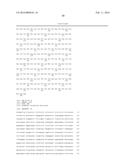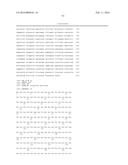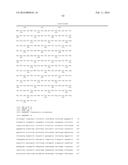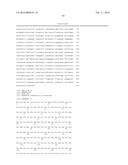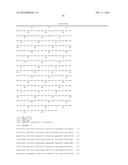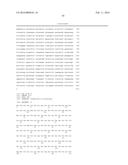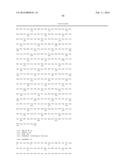Patent application title: AGRONOMIC CHARACTERISTICS UNDER NITROGEN LIMITING CONDITIONS FOR PLANTS EXPRESSING PH11 OR NUCPU29 POLYPEPTIDES
Inventors:
Sangeeta Agarwal (Secunderabad, IN)
Stephen M. Allen (Wilmington, DE, US)
Milo Jay Aukerman (Newark, DE, US)
Ratna Kumria (Hyderabad, IN)
H. Renee Lafitte (Davis, CA, US)
Stanley Luck (Wilmington, DE, US)
Amitabh Mohanty (Kowkur, IN)
Mark Mucha (Lincoln University, PA, US)
Hajime Sakai (Newark, DE, US)
IPC8 Class: AC12N1582FI
USPC Class:
800260
Class name: Multicellular living organisms and unmodified parts thereof and related processes method of using a plant or plant part in a breeding process which includes a step of sexual hybridization
Publication date: 2016-02-11
Patent application number: 20160040181
Abstract:
Isolated polynucleotides and polypeptides and recombinant DNA constructs
particularly useful for altering agronomic characteristics of plants
under nitrogen limiting conditions are described. Compositions (such as
plants or seeds) comprising these recombinant DNA constructs, and methods
utilizing these recombinant DNA constructs also are described. The
recombinant DNA construct may comprise a polynucleotide operably linked
to a heterologous promoter functional in a plant, wherein said
polynucleotide encodes a PH11 or a NUCPU29 polypeptide.Claims:
1. A plant comprising in its genome a recombinant DNA construct
comprising a polynucleotide operably linked to at least one heterologous
regulatory element, wherein said polynucleotide encodes a polypeptide
having an amino acid sequence of at least 80% sequence identity, based on
the Clustal V method of alignment, when compared to SEQ ID NO:3, 7, 9,
11, 13, 15, 17, 19, 21, 23, 25, 27, 29, 31, 33-62 or 70, and wherein said
plant exhibits at least one trait selected from the group consisting of:
increased nitrogen stress tolerance, increased yield, increased biomass,
and altered root architecture, when compared to a control plant not
comprising said recombinant DNA construct.
2. The plant of claim 1, wherein the altered root architecture is an increase in root biomass or in average root length, or both.
3. The plant of claim 1, wherein the polynucleotide is operably linked to a heterologous promoter that is preferably expressed in at least one tissue selected from the group consisting of: root, shoot and vasculature.
4. The plant of claim 1, wherein said plant exhibits an increase in yield, biomass, or both, when compared, under nitrogen limiting conditions, to said control plant.
5. The plant of any one of claim 1, wherein said plant is selected from the group consisting of: maize, soybean, sunflower, sorghum, canola, wheat, alfalfa, cotton, rice, barley, millet, sugar cane and switchgrass.
6. Seed of the plant of claim 1, wherein said seed comprises in its genome a recombinant DNA construct comprising a polynucleotide operably linked to at least one heterologous regulatory element, wherein said polynucleotide encodes a polypeptide having an amino acid sequence of at least 80% sequence identity, based on the Clustal V method of alignment, when compared to SEQ ID NO:3, 7, 9, 11, 13, 15, 17, 19, 21, 23, 25, 27, 29, 31, 33-62 or 70, and wherein a plant produced from said seed exhibits at least one trait selected from the group consisting of: increased nitrogen stress tolerance, increased yield, increased biomass, and altered root architecture, when compared to a control plant not comprising said recombinant DNA construct.
7. A method of increasing nitrogen stress tolerance in a plant, comprising: (a) introducing into a regenerable plant cell a recombinant DNA construct comprising a polynucleotide operably linked to at least one heterologous regulatory element, wherein the polynucleotide encodes a polypeptide having an amino acid sequence of at least 80% sequence identity, based on the Clustal V method of alignment, when compared to SEQ ID NO:3, 7, 9, 11, 13, 15, 17, 19, 21, 23, 25, 27, 29, 31, 33-62 or 70; (b) regenerating a transgenic plant from the regenerable plant cell after step (a), wherein the transgenic plant comprises in its genome the recombinant DNA construct; and (c) obtaining a progeny plant derived from the transgenic plant of step (b), wherein said progeny plant comprises in its genome the recombinant DNA construct and exhibits increased nitrogen stress tolerance when compared to a control plant not comprising the recombinant DNA construct.
8. The method of claim 8 wherein the polynucleotide in step (a) is operably linked to a heterologous promoter and wherein the promoter is expressed in at least one tissue selected from the group consisting of: root, shoot and vasculature.
9. A method of selecting for a plant that exhibits at least one trait selected from the group consisting of: increased nitrogen stress tolerance, increased yield, increased biomass, and altered root architecture, the method comprising: (a) obtaining a transgenic plant, wherein the transgenic plant comprises in its genome a recombinant DNA construct comprising a polynucleotide operably linked to at least one heterologous regulatory element, wherein said polynucleotide encodes a polypeptide having an amino acid sequence of at least 80% sequence identity, based on the Clustal V method of alignment, when compared to SEQ ID NO:3, 7, 9, 11, 13, 15, 17, 19, 21, 23, 25, 27, 29, 31, 33-62 or 70; (b) growing the transgenic plant of part (a) under conditions wherein the polynucleotide is expressed; and (c) selecting the transgenic plant of part (b) that exhibits at least one trait selected from the group consisting of: increased nitrogen stress tolerance, increased yield, increased biomass, and altered root architecture, when compared to a control plant not comprising the recombinant DNA construct.
10. The method of claim 9, wherein said selecting step (c) comprises determining whether the transgenic plant of (b) exhibits an alteration of yield, biomass or both when compared, under nitrogen limiting conditions, to a control plant not comprising the recombinant DNA construct.
11. The method of claim 9, wherein said altered root architecture is an increase in root biomass or in average root length, or both.
12. The method of any one of claim 9, wherein said plant is selected from the group consisting of: maize, soybean, sunflower, sorghum, canola, wheat, alfalfa, cotton, rice, barley, millet, sugar cane and switchgrass.
13. A recombinant DNA construct comprising a polynucleotide operably linked to at least one heterologous regulatory element, wherein said polynucleotide comprising: (a) a nucleotide sequence encoding a PH11 or NUCPU29 polypeptide, wherein the polypeptide has nitrogen stress tolerance activity, and wherein the polypeptide has an amino acid sequence of at least 80% sequence identity, based on the Clustal V method of alignment with pairwise alignment default parameters of KTUPLE=1, GAP PENALTY=3, WINDOW=5 and DIAGONALS SAVED=5, when compared to SEQ ID NO:3, 7, 9, 11, 13, 15, 17, 19, 21, 23, 25, 27, 29, 31, 33-62 or 70; or (b) the full complement of the nucleotide sequence of (a).
14. The polynucleotide of claim 13, wherein the amino acid sequence of the polypeptide comprises SEQ ID NO:3, 7, 9, 11, 13, 15, 17, 19, 21, 23, 25, 27, 29, 31, 33-62 or 70.
15. The polynucleotide of claim 13 wherein the nucleotide sequence comprises SEQ ID NO:2, 4, 6, 8, 10, 12, 14, 16, 18, 20, 22, 24, 26, 28, 30, 32, 69 or 71.
16. A method of producing a plant that exhibits at least one trait selected from the group consisting of: increased nitrogen stress tolerance, increased yield, increased biomass, and altered root architecture, wherein the method comprises growing a plant from the seed of claim 6, wherein the plant exhibits at least one trait selected from the group consisting of: increased nitrogen stress tolerance, increased yield, increased biomass, and altered root architecture, when compared to a control plant not comprising the recombinant DNA construct.
17. A method of producing a seed, the method comprising the following: (a) crossing a first plant with a second plant, wherein at least one of the first plant and the second plant is the plant of claim 1; and (b) selecting a seed of the crossing of step (a), wherein the seed comprises the recombinant DNA construct of claim 1.
18. The method of claim 17, wherein a plant grown from the seed of part (b) exhibits at least one trait selected from the group consisting of: increased nitrogen stress tolerance, increased yield, increased biomass, and altered root architecture, when compared to a control plant not comprising the recombinant DNA construct.
19. A method of producing oil or a seed by-product, or both, from a seed, the method comprising extracting oil or a seed by-product, or both, from the seed of claim 6.
20. The method of claim 19, wherein the oil or the seed by-product, or both, comprises the recombinant DNA construct.
Description:
CROSS REFERENCE TO RELATED APPLICATIONS
[0001] This application claims the benefit of U.S. Provisional Application No. 62/034,838, filed Aug. 8, 2014 and U.S. Provisional Application No. 62/076,504, filed Nov. 7, 2014, the entire content of each is herein incorporated by reference.
REFERENCE TO SEQUENCE LISTING SUBMITTED ELECTRONICALLY
[0002] The official copy of the sequence listing is submitted electronically via EFS-Web as an ASCII formatted sequence listing with a file named 20150807_BB2002USNP_SequenceListing.txt created on Aug. 7, 2015 and having a size of 212 kilobytes and is filed concurrently with the specification. The sequence listing contained in this ASCII formatted document is part of the specification and is herein incorporated by reference in its entirety.
FIELD
[0003] The field relates to plant breeding and genetics and, in particular, relates to recombinant DNA constructs useful in plants for conferring nitrogen use efficiency and/or tolerance to nitrogen limiting conditions.
BACKGROUND
[0004] Abiotic stressors significantly limit crop production worldwide. Cumulatively, these factors are estimated to be responsible for an average 70% reduction in agricultural production. Plants are sessile and have to adjust to the prevailing environmental conditions of their surroundings. This has led to their development of a great plasticity in gene regulation, morphogenesis, and metabolism. Adaptation and defense strategies involve the activation of genes encoding proteins important in the acclimation or defense towards the different stressors.
[0005] The adsorption of nitrogen by plants plays an important role in their growth (Gallais et al., J. Exp. Bot. 55(396):295-306 (2004)). Plants synthesize amino acids from inorganic nitrogen in the environment. Consequently, nitrogen fertilization has been a powerful tool for increasing the yield of cultivated plants, such as maize and soybean. Today farmers desire to reduce the use of nitrogen fertilizer, in order to avoid pollution by nitrates and to maintain a sufficient profit margin. If the nitrogen assimilation capacity of a plant can be increased, then increases in plant growth and yield increase are also expected. In summary, plant varieties that have better nitrogen use efficiency (NUE) are desirable.
SUMMARY
[0006] The present disclosure includes:
[0007] In one embodiment, a plant comprising in its genome a recombinant DNA construct comprising a polynucleotide operably linked to at least one heterologous regulatory element, wherein said polynucleotide encodes a polypeptide having an amino acid sequence of at least 80% sequence identity, based on the Clustal V method of alignment, when compared to SEQ ID NO:3, 7, 9, 11, 13, 15, 17, 19, 21, 23, 25, 27, 29, 31, 33-62 or 70, and wherein said plant exhibits increased nitrogen stress tolerance when compared to a control plant not comprising said recombinant DNA construct.
[0008] In another embodiment, a plant comprising in its genome a recombinant DNA construct comprising a polynucleotide operably linked to at least one heterologous regulatory element, wherein said polynucleotide encodes a polypeptide having an amino acid sequence of at least 80% sequence identity, based on the Clustal V method of alignment, when compared to SEQ ID NO:3, 7, 9, 11, 13, 15, 17, 19, 21, 23, 25, 27, 29, 31, 33-62 or 70, and wherein said plant exhibits an alteration of at least one agronomic characteristic when compared to a control plant not comprising said recombinant DNA construct. Optionally, the plant exhibits said alteration of said at least one agronomic characteristic when compared, under nitrogen limiting conditions, to said control plant not comprising said recombinant DNA construct. The at least one agronomic trait may be yield, biomass, or both, and the alteration may be an increase.
[0009] In one embodiment, the polynucleotides described in the current disclosure are operably linked to a tissue-specific promoter. In one embodiment, the polynucleotides described in the current disclosure are operably linked to a promoter that is preferably expressed in at least one tissue selected from the group consisting of: root, shoot and vasculature.
[0010] In another embodiment, the present disclosure includes any of the plants of the present disclosure wherein the plant is selected from the group consisting of: maize, soybean, sunflower, sorghum, canola, wheat, alfalfa, cotton, rice, barley, millet, sugar cane and switchgrass.
[0011] In another embodiment, the present disclosure includes seed of any of the plants of the present disclosure, wherein said seed comprises in its genome a recombinant DNA construct comprising a polynucleotide operably linked to at least one heterologous regulatory element, wherein said polynucleotide encodes a polypeptide having an amino acid sequence of at least 80% sequence identity, based on the Clustal V method of alignment, when compared to SEQ ID NO:3, 7, 9, 11, 13, 15, 17, 19, 21, 23, 25, 27, 29, 31, 33-62 or 70, and wherein a plant produced from said seed exhibits either an increased nitrogen stress tolerance, or an alteration of at least one agronomic characteristic, or both, when compared to a control plant not comprising said recombinant DNA construct. The at least one agronomic trait may be yield, biomass, or both and the alteration may be an increase.
[0012] In another embodiment, a method of increasing nitrogen stress tolerance in a plant, comprising (a) introducing into a regenerable plant cell a recombinant DNA construct comprising a polynucleotide operably linked to at least one heterologous regulatory sequence, wherein the polynucleotide encodes a polypeptide having an amino acid sequence of at least 80% sequence identity, based on the Clustal V method of alignment, when compared to SEQ ID NO:3, 7, 9, 11, 13, 15, 17, 19, 21, 23, 25, 27, 29, 31, 33-62 or 70; (b) regenerating a transgenic plant from the regenerable plant cell after step (a), wherein the transgenic plant comprises in its genome the recombinant DNA construct; and (c) obtaining a progeny plant derived from the transgenic plant of step (b), wherein said progeny plant comprises in its genome the recombinant DNA construct and exhibits increased nitrogen stress tolerance when compared to a control plant not comprising the recombinant DNA construct.
[0013] In another embodiment, a method of selecting for increased nitrogen stress tolerance in a plant, comprising (a) obtaining a transgenic plant, wherein the transgenic plant comprises in its genome a recombinant DNA construct comprising a polynucleotide operably linked to at least one heterologous regulatory sequence, wherein the polynucleotide encodes a polypeptide having an amino acid sequence of at least 80% sequence identity, based on the Clustal V method of alignment, when compared to SEQ ID NO:3, 7, 9, 11, 13, 15, 17, 19, 21, 23, 25, 27, 29, 31, 33-62 or 70; (b) growing the transgenic plant of part (a) under conditions wherein the polynucleotide is expressed; and (c) selecting for the transgenic plant of part (b) that exhibits nitrogen stress tolerance compared to a control plant not comprising the recombinant DNA construct.
[0014] In another embodiment, a method of selecting for nitrogen stress tolerance in a plant, comprising (a) introducing into a regenerable plant cell a recombinant DNA construct comprising a polynucleotide operably linked to at least one heterologous regulatory sequence, wherein the polynucleotide encodes a polypeptide having an amino acid sequence of at least 80% sequence identity, based on the Clustal V method of alignment, when compared to SEQ ID NO:3, 7, 9, 11, 13, 15, 17, 19, 21, 23, 25, 27, 29, 31, 33-62 or 70; (b) regenerating a transgenic plant from the regenerable plant cell after step (a), wherein the transgenic plant comprises in its genome the recombinant DNA construct; and (c) selecting a transgenic plant of (b) that exhibits nitrogen stress tolerance compared to a control plant not comprising the recombinant DNA construct; and optionally, (d) obtaining a progeny plant derived from the transgenic plant of (c), wherein the progeny plant comprises in its genome the recombinant DNA construct; and optionally, (e) selecting a progeny plant of (d) that exhibits nitrogen stress tolerance compared to a control plant not comprising the recombinant DNA construct.
[0015] In another embodiment, a method of selecting for nitrogen stress tolerance in a plant, comprising (a) introducing into a regenerable plant cell a recombinant DNA construct comprising a polynucleotide operably linked to at least one heterologous regulatory sequence, wherein the polynucleotide encodes a polypeptide having an amino acid sequence of at least 80% sequence identity, based on the Clustal V method of alignment, when compared to SEQ ID NO:3, 7, 9, 11, 13, 15, 17, 19, 21, 23, 25, 27, 29, 31, 33-62 or 70; (b) regenerating a transgenic plant from the regenerable plant cell after step (a), wherein the transgenic plant comprises in its genome the recombinant DNA construct; (c) obtaining a progeny plant derived from the transgenic plant, wherein the progeny plant comprises in its genome the recombinant DNA construct; and (d) selecting a progeny plant of (c) that exhibits nitrogen stress tolerance compared to a control plant not comprising the recombinant DNA construct.
[0016] In another embodiment, a method of selecting for altered root architecture in a plant, comprising: (a) obtaining a transgenic plant, wherein the transgenic plant comprises in its genome a recombinant DNA construct comprising a polynucleotide operably linked to at least one heterologous regulatory element, wherein said polynucleotide encodes a polypeptide having an amino acid sequence of at least 80% sequence identity, based on the Clustal V method of alignment, when compared to SEQ ID NO:3, 7, 9, 11, 13, 15, 17, 19, 21, 23, 25, 27, 29, 31, 33-62 or 70; (b) obtaining a progeny plant derived from the transgenic plant, wherein the progeny plant comprises in its genome the recombinant DNA construct; and (c) selecting the progeny plant for alteration of root architecture compared to a control plant not comprising the recombinant DNA construct. The progeny plant may be compared to the control plant when grown under non-limiting nitrogen conditions.
[0017] In another embodiment, a method of selecting for an alteration of at least one agronomic characteristic in a plant, comprising (a) obtaining a transgenic plant, wherein the transgenic plant comprises in its genome a recombinant DNA construct comprising a polynucleotide operably linked to at least one heterologous regulatory sequence, wherein the polynucleotide encodes a polypeptide having an amino acid sequence of at least 80% sequence identity, based on the Clustal V method of alignment, when compared to SEQ ID NO:3, 7, 9, 11, 13, 15, 17, 19, 21, 23, 25, 27, 29, 31, 33-62 or 70; (b) growing the transgenic plant of part (a) under conditions wherein the polynucleotide is expressed; and (c) selecting a transgenic plant of part (b) that exhibits an alteration of at least one agronomic characteristic when compared to a control plant not comprising the recombinant DNA construct. Optionally, said selecting step (c) comprises selecting a transgenic plant that exhibits an alteration of at least one agronomic characteristic when compared, under nitrogen limiting conditions, to a control plant not comprising the recombinant DNA construct. The at least one agronomic trait may be yield, biomass, or both and the alteration may be an increase.
[0018] In another embodiment, the present disclosure includes any of the methods of the present disclosure wherein the plant is selected from the group consisting of: maize, soybean, sunflower, sorghum, canola, wheat, alfalfa, cotton, rice, barley, millet, sugar cane and switchgrass.
[0019] In another embodiment, the present disclosure includes an isolated polynucleotide comprising: (a) a nucleotide sequence encoding a PH11 or NUCPU29 polypeptide with nitrogen stress tolerance activity, wherein the polypeptide has an amino acid sequence of at least 80%, 85%, 90%, or 95% sequence identity, based on the Clustal V method of alignment, when compared to SEQ ID NO:3, 7, 9, 11, 13, 15, 17, 19, 21, 23, 25, 27, 29, 31, 33-62 or 70, or (b) a full complement of the nucleotide sequence, wherein the full complement and the nucleotide sequence consist of the same number of nucleotides and are 100% complementary. The amino acid sequence of the PH11 or NUCPU29 polypeptide of part (a) may have less than 98%, 99%, or 100% sequence identity, based on the Clustal V method of alignment, when compared to SEQ ID NO:3, 7, 9, 11, 13, 15, 17, 19, 21, 23, 25, 27, 29, 31, 33-62 or 70. The polypeptide may comprise the amino acid sequence of SEQ ID NO:3, 7, 9, 11, 13, 15, 17, 19, 21, 23, 25, 27, 29, 31, 33-62 or 70. The nucleotide sequence may comprise the nucleotide sequence of SEQ ID NO:2, 4, 6, 8, 10, 12, 14, 16, 18, 20, 22, 24, 26, 28, 30, 32, 69 or 71.
[0020] In another embodiment, the present disclosure concerns a recombinant DNA construct comprising any of the isolated polynucleotides of the present disclosure operably linked to at least one heterologous regulatory sequence, and a cell, a microorganism, a plant, and a seed comprising the recombinant DNA construct. The cell may be eukaryotic, e.g., a yeast, insect or plant cell, or prokaryotic, e.g., a bacterial cell.
[0021] In another embodiment, a method of producing a plant that exhibits an increase in at least one trait selected from the group consisting of: increased nitrogen stress tolerance, increased yield, increased biomass, and altered root architecture, wherein the method comprises growing a plant from a seed comprising a recombinant DNA construct, wherein the recombinant DNA construct comprises a polynucleotide operably linked to at least one heterologous regulatory element, wherein the polynucleotide encodes a polypeptide having an amino acid sequence of at least 70%, 75%, 80%, 85%, 90%, 91%, 92%, 93%, 94%, 95%, 96%, 97%, 98%, 99% or 100% sequence identity, based on the Clustal V method of alignment, using the respective default parameters, when compared to SEQ ID NO:3, 7, 9, 11, 13, 15, 17, 19, 21, 23, 25, 27, 29, 31, 33-62 or 70, wherein the plant exhibits at least one trait selected from the group consisting of: increased nitrogen stress tolerance, increased yield, increased biomass, and altered root architecture, when compared to a control plant not comprising the recombinant DNA construct.
[0022] In another embodiment, a method of producing a seed, the method comprising: (a) crossing a first plant with a second plant, wherein at least one of the first plant and the second plant comprises a recombinant DNA construct, wherein the recombinant DNA construct comprises a polynucleotide operably linked to at least one heterologous regulatory element, wherein the polynucleotide encodes a polypeptide having an amino acid sequence of at least 70%, 75%, 80%, 85%, 90%, 91%, 92%, 93%, 94%, 95%, 96%, 97%, 98%, 99% or 100% sequence identity, based on the Clustal V method of alignment, using the respective default parameters, when compared to SEQ ID NO:3, 7, 9, 11, 13, 15, 17, 19, 21, 23, 25, 27, 29, 31, 33-62 or 70; and (b) selecting a seed of the crossing of step (a), wherein the seed comprises the recombinant DNA construct. A plant grown from the seed may exhibit at least one trait selected from the group consisting of: increased nitrogen stress tolerance, increased yield, increased biomass, and altered root architecture, when compared to a control plant not comprising the recombinant DNA construct.
[0023] In another embodiment, a method of producing oil or a seed by-product, or both, from a seed, the method comprising extracting oil or a seed by-product, or both, from a seed that comprises a recombinant DNA construct, wherein the recombinant DNA construct comprises a polynucleotide operably linked to at least one heterologous regulatory element, wherein the polynucleotide encodes a polypeptide having an amino acid sequence of at least 70%, 75%, 80%, 85%, 90%, 91%, 92%, 93%, 94%, 95%, 96%, 97%, 98%, 99% or 100% sequence identity, based on the Clustal V method of alignment, using the respective default parameters, when compared to SEQ ID NO:3, 7, 9, 11, 13, 15, 17, 19, 21, 23, 25, 27, 29, 31, 33-62 or 70. The seed may be obtained from a plant that comprises the recombinant DNA construct, wherein the plant exhibits at least one trait selected from the group consisting of: increased nitrogen stress tolerance, increased yield, increased biomass, and altered root architecture, when compared to a control plant not comprising the recombinant DNA construct. The oil or the seed by-product, or both, may comprise the recombinant DNA construct.
[0024] In any of the above embodiments, the altered root architecture may be an increase in root biomass or in average root length, or both.
BRIEF DESCRIPTION OF THE DRAWINGS AND SEQUENCE LISTING
[0025] The disclosure can be more fully understood from the following detailed description and the accompanying drawings and Sequence Listing which form a part of this application.
[0026] FIG. 1 shows a typical grid pattern for five lines (labeled 1 through 5--eleven individuals for each line), plus wild-type control C1 (nine individuals), used in screens.
[0027] FIG. 2 shows a graph of the effect of several different potassium nitrate concentrations on plant color as determined by image analysis. The response of the green color bin (hues 50 to 66) to nitrate dosage demonstrates that this bin can be used as an indicator of nitrogen assimilation.
[0028] FIG. 3 shows the growth medium used for semi-hydroponics maize growth in Example 18.
[0029] FIGS. 4A-4K show the alignment of the PH11 polypeptides from different plant species. The alignment of SEQ ID NOS. 3, 7, 9, 11, 13, 15, 17, 19, 21, 23, 25, 27, 29, 31, 33, 52-61 and 62 is shown. Residues that are identical to the residue of the AT-PH11 sequence (SEQ ID NO: 3) at a given position are enclosed in a box. A consensus or majority sequence (SEQ ID NO:63) is presented where a residue is shown if present in majority of sequences, otherwise, a period is shown.
[0030] FIG. 5 shows the percent sequence identity and the divergence values for each pair of amino acids sequences of PH11 polypeptides displayed in FIGS. 4A-4K.
[0031] FIG. 6 shows the yield analysis (in low nitrogen and normal nitrogen conditions) of transgenic maize lines comprising the recombinant construct PHP51603, overexpressing the AT-PH11 polypeptide.
[0032] FIG. 7 shows the yield analysis across locations (across all location, across all normal nitrogen locations (locations A-F), across all low nitrogen locations (locations G and H), for transgenic maize lines comprising the recombinant construct PHP51603, overexpressing the AT-PH11 polypeptide
[0033] FIG. 8 shows the yield analysis of maize lines transformed with PHP50351, expressing the Arabidopsis gene At-NUCPU29 with alternative codons (At-NUCPU29ac); under low-nitrogen (locations G-H) and normal-nitrogen conditions (locations A-F).
[0034] FIG. 9 shows the yield analysis across all locations; and across locations that are grouped according to the stress experienced in these locations.
[0035] The sequence descriptions and Sequence Listing attached hereto comply with the rules governing nucleotide and/or amino acid sequence disclosures in patent applications as set forth in 37 C.F.R. §1.821-1.825. The Sequence Listing contains the one letter code for nucleotide sequence characters and the three letter codes for amino acids as defined in conformity with the IUPAC-IUBMB standards described in Nucleic Acids Res. 13:3021-3030 (1985) and in the Biochemical J. 219 (2):345-373 (1984) which are herein incorporated by reference. The symbols and format used for nucleotide and amino acid sequence data comply with the rules set forth in 37 C.F.R. §1.822.
[0036] SEQ ID NO:1 is the sequence of a polylinker.
[0037] SEQ ID NO:2 is the nucleotide sequence of AT-PH11 protein-coding sequence (CDS), and corresponds to NCBI GI No. 186529090.
[0038] SEQ ID NO:3 is the amino acid sequence of the polypeptide encoded by SEQ ID NO:2, and corresponds to NCBI GI No. 15240022.
[0039] SEQ ID NO:4 is the AT-PH11 sequence with alternative codons (AT-PH11 ac).
[0040] SEQ ID NO:5 is the cDNA sequence from the locus At5g43870, encoding AT-PH11 polypeptide (Arabidopsis thaliana).
[0041] Table 1 presents SEQ ID NOs for the nucleotide sequences of the PH11 cDNA clones obtained from Zea mays, Sesbania bispinosa, Artemisia tridentata, Amaranthus hypochondriacus, Lamium amplexicaule, Delosperma nubigenum, Tradescantia sillamontana, Linum perenne, Triglochin maritima. The SEQ ID NOs for the corresponding amino acid sequences encoded by the cDNAs are also presented.
TABLE-US-00001 TABLE 1 cDNAs Encoding PH11 Polypeptides SEQ ID NO: SEQ ID NO: Plant Clone Designation (Nucleotide) (Amino Acid) Corn ZM-PH11-A 6 7 Corn ZM-PH11-B 8 9 Corn ZM-PH11-C 10 11 Corn ZM-PH11-D 12 13 Corn ZM-PH11-E 14 15 Sesbania sesgr1n.pk036.o8 16 17 bispinosa Amaranthus ahgr1c.pk088.o5 18 19 hypochondriacus Artemisia arttr1n.pk119.a3 20 21 tridentata Delosperma icegr1n.pk136.c5 22 23 nubigenum Linum perenne lpgr1n.pk075.f12 24 25 Linum perenne lpgr1n.pk026.f24 26 27 Triglochin maritima tmgr2n.pk006.j11 28 29 Tradescantia tsgr1n.pk037.f8 30 31 sillamontana Tradescantia tsgr1n.pk020.c8 32 33 sillamontana
[0042] SEQ ID NO:34 is an amino acid sequence encoded by the locus At4g14740.1 of Arabidopsis thaliana.
[0043] SEQ ID NO:35 is an amino acid sequence encoded by the locus At3g22810.1 of Arabidopsis thaliana.
[0044] SEQ ID NO:36 is an amino acid sequence encoded by the locus At3g63300.1 of Arabidopsis thaliana.
[0045] SEQ ID NO:37 is the amino acid sequence corresponding to the locus LOC_Os03g43510.1, a rice (japonica) predicted protein from the Michigan State University Rice Genome Annotation Project Osa1 release 6.
[0046] SEQ ID NO:38 is the amino acid sequence corresponding to the locus LOC_Os12g41140.1, a rice (japonica) predicted protein from the Michigan State University Rice Genome Annotation Project Osa1 release 6.
[0047] SEQ ID NO:39 is the amino acid sequence corresponding to the locus LOC_Os01g13070.1, a rice (japonica) predicted protein from the Michigan State University Rice Genome Annotation Project Osa1 release 6.
[0048] SEQ ID NO:40 is the amino acid sequence corresponding to Sb01g014000.1, a sorghum (Sorghum bicolor) predicted protein from the Sorghum JGI genomic sequence version 1.4 from the US Department of Energy Joint Genome Institute.
[0049] SEQ ID NO:41 is the amino acid sequence corresponding to Sb03g000810.1, a sorghum (Sorghum bicolor) predicted protein from the Sorghum JGI genomic sequence version 1.4 from the US Department of Energy Joint Genome Institute.
[0050] SEQ ID NO:42 is the amino acid sequence corresponding to Sb01g029090.1, a sorghum (Sorghum bicolor) predicted protein from the Sorghum JGI genomic sequence version 1.4 from the US Department of Energy Joint Genome Institute.
[0051] SEQ ID NO:43 is the amino acid sequence corresponding to Sb04g032910.1, a sorghum (Sorghum bicolor) predicted protein from the Sorghum JGI genomic sequence version 1.4 from the US Department of Energy Joint Genome Institute.
[0052] SEQ ID NO:44 is the amino acid sequence corresponding to Glyma10g38990.1, a soybean (Glycine max) predicted protein from predicted coding sequences from Soybean JGI Glyma1.01 genomic sequence from the US Department of Energy Joint Genome Institute.
[0053] SEQ ID NO:45 is the amino acid sequence corresponding to Glyma02g00760.1, a soybean (Glycine max) predicted protein from predicted coding sequences from Soybean JGI Glyma1.01 genomic sequence from the US Department of Energy Joint Genome Institute.
[0054] SEQ ID NO:46 is the amino acid sequence corresponding to Glyma20g28820.1, a soybean (Glycine max) predicted protein from predicted coding sequences from Soybean JGI Glyma1.01 genomic sequence from the US Department of Energy Joint Genome Institute.
[0055] SEQ ID NO:47 is the amino acid sequence corresponding to Glyma10g00600.1, a soybean (Glycine max) predicted protein from predicted coding sequences from Soybean JGI Glyma1.01 genomic sequence from the US Department of Energy Joint Genome Institute.
[0056] SEQ ID NO:48 is the amino acid sequence corresponding to Glyma03g31340.1, a soybean (Glycine max) predicted protein from predicted coding sequences from Soybean JGI Glyma1.01 genomic sequence from the US Department of Energy Joint Genome Institute.
[0057] SEQ ID NO:49 is the amino acid sequence corresponding to Glyma19g34180.1, a soybean (Glycine max) predicted protein from predicted coding sequences from Soybean JGI Glyma1.01 genomic sequence from the US Department of Energy Joint Genome Institute.
[0058] SEQ ID NO:50 is the amino acid sequence corresponding to Glyma02g16330.1, a soybean (Glycine max) predicted protein from predicted coding sequences from Soybean JGI Glyma1.01 genomic sequence from the US Department of Energy Joint Genome Institute.
[0059] SEQ ID NO:51 is the amino acid sequence corresponding to Glyma10g03500.1, a soybean (Glycine max) predicted protein from predicted coding sequences from Soybean JGI Glyma1.01 genomic sequence from the US Department of Energy Joint Genome Institute.
[0060] SEQ ID NO:52 is the amino acid sequence corresponding to SEQ ID NO:1647 from the US patent publication No. US20120227134.
[0061] SEQ ID NO:53 is the amino acid sequence corresponding to SEQ ID NO:1566 from the US patent publication No. US20120096584.
[0062] SEQ ID NO:54 is the amino acid sequence corresponding to NCBI GI No. 195656831.
[0063] SEQ ID NO:55 is the amino acid sequence corresponding to SEQ ID NO:68801 from the US patent publication No. US20120017338.
[0064] SEQ ID NO:56 is the amino acid sequence corresponding to NCBI GI No. 293336271.
[0065] SEQ ID NO:57 is the amino acid sequence corresponding to SEQ ID NO:58064 from the US patent publication No. US20120017292.
[0066] SEQ ID NO:58 is the amino acid sequence corresponding to NCBI GI No. 514754743.
[0067] SEQ ID NO:59 is the amino acid sequence corresponding to SEQ ID NO:43844 from the US patent publication No. US20120017338.
[0068] SEQ ID NO:60 is the amino acid sequence corresponding to NCBI GI No. 242055855.
[0069] SEQ ID NO:61 is the amino acid sequence corresponding to SEQ ID NO:174 from the PCT publication No. WO2013072832.
[0070] SEQ ID NO:62 is the amino acid sequence corresponding to Uniprot Accession No. K7UXW2.
[0071] SEQ ID NO:63 is the consensus sequence obtained by aligning the SEQ ID NOS:3, 7, 9, 11, 13, 15, 17, 19, 21, 23, 25, 27, 29, 31, 33, 52-61 and 62, as shown in FIGS. 4A-4K.
[0072] SEQ ID NO:64 is the sequence of the Arabidopsis Phosphate Transporter 1 (PHT1) promoter.
[0073] SEQ ID NO:65 is the sequence of the Arabidopsis Oxygen evolving enhancer protein 2 (OEE2) promoter.
[0074] SEQ ID NO:66 is the sequence of the Arabidopsis Sucrose Transporter (SUC2) promoter.
[0075] SEQ ID NO:67 is the nucleotide sequence of the At2g36030-5' attB forward primer.
[0076] SEQ ID NO:68 is the nucleotide sequence of the At2g36030-3' attB reverse primer.
[0077] SEQ ID NO:69 is the nucleotide sequence of AT-NUCPU29 cDNA (identical to the CDS sequence from the Arabidopsis thaliana locus At2g36030), and corresponds to NCBI GI no. 18404023.
[0078] SEQ ID NO:70 is the amino acid sequence of the polypeptide encoded by SEQ ID NO:69, and corresponds to NCBI GI no. 15227254.
[0079] SEQ ID NO:71 is the AT-NUCPU29 nucleotide sequence with alternative codons (AT-NUCPU29ac). In SEQ ID NO:71 the nucleotide sequence encoding the NUCPU29 polypeptide has been altered to utilize maize-preferred codons.
[0080] SEQ ID NO:72 is the nucleotide sequence of the attB1 site.
[0081] SEQ ID NO:73 is the nucleotide sequence of the attB2 site.
DETAILED DESCRIPTION
[0082] The disclosure of each reference set forth herein is hereby incorporated by reference in its entirety.
[0083] As used herein and in the appended claims, the singular forms "a", "an", and "the" include plural reference unless the context clearly dictates otherwise. Thus, for example, reference to "a plant" includes a plurality of such plants, reference to "a cell" includes one or more cells and equivalents thereof known to those skilled in the art, and so forth.
[0084] As used herein:
[0085] The terms "monocot" and "monocotyledonous plant" are used interchangeably herein. A monocot of the current disclosure includes the Gramineae.
[0086] The terms "dicot" and "dicotyledonous plant" are used interchangeably herein. A dicot of the current disclosure includes the following families: Brassicaceae, Leguminosae, and Solanaceae.
[0087] The terms "full complement" and "full-length complement" are used interchangeably herein, and refer to a complement of a given nucleotide sequence, wherein the complement and the nucleotide sequence consist of the same number of nucleotides and are 100% complementary.
[0088] A "trait" refers to a physiological, morphological, biochemical, or physical characteristic of a plant or particular plant material or cell. In some instances, this characteristic is visible to the human eye, such as seed or plant size, or can be measured by biochemical techniques, such as detecting the protein, starch, or oil content of seed or leaves, or by observation of a metabolic or physiological process, e.g. by measuring tolerance to water deprivation or particular salt or sugar concentrations, or by the observation of the expression level of a gene or genes, or by agricultural observations such as osmotic stress tolerance or yield.
[0089] "Nitrogen limiting conditions" refers to conditions where the amount of total available nitrogen (e.g., from nitrates, ammonia, or other known sources of nitrogen) is not sufficient to sustain optimal plant growth and development. One skilled in the art would recognize conditions where total available nitrogen is sufficient to sustain optimal plant growth and development. One skilled in the art would recognize what constitutes sufficient amounts of total available nitrogen, and what constitutes soils, media and fertilizer inputs for providing nitrogen to plants. Nitrogen limiting conditions will vary depending upon a number of factors, including but not limited to, the particular plant and environmental conditions.
[0090] "Agronomic characteristic" is a measurable parameter including but not limited to, abiotic stress tolerance, nitrogen stress tolerance, greenness, yield, growth rate, biomass, fresh weight at maturation, dry weight at maturation, fruit yield, seed yield, total plant nitrogen content, fruit nitrogen content, seed nitrogen content, nitrogen content in vegetative tissue, whole plant amino acid content, vegetative tissue free amino acid content, fruit free amino acid content, total plant protein content, seed free amino acid content, fruit protein content, seed protein content, protein content in a vegetative tissue, drought tolerance, nitrogen uptake, resistance to root lodging, root biomass, average root length, harvest index, stalk lodging, plant height, ear height, ear length, salt tolerance, early seedling vigor, and seedling emergence under low temperature stress.
[0091] Abiotic stress may be at least one condition selected from the group consisting of: drought, water deprivation, flood, high light intensity, high temperature, low temperature, salinity, etiolation, defoliation, heavy metal toxicity, anaerobiosis, nutrient deficiency, nutrient excess, UV irradiation, atmospheric pollution (e.g., ozone) and exposure to chemicals (e.g., paraquat) that induce production of reactive oxygen species (ROS). Nutrients include, but are not limited to, the following: nitrogen (N), phosphorus (P), potassium (K), calcium (Ca), magnesium (Mg) and sulfur (S).
[0092] "Increased stress tolerance" of a plant is measured relative to a reference or control plant, and is a trait of the plant to survive under stress conditions over prolonged periods of time, without exhibiting the same degree of physiological or physical deterioration relative to the reference or control plant grown under similar stress conditions.
[0093] A plant with "increased stress tolerance" can exhibit increased tolerance to one or more different stress conditions.
[0094] "Stress tolerance activity" of a polypeptide indicates that over-expression of the polypeptide in a transgenic plant confers increased stress tolerance to the transgenic plant relative to a reference or control plant.
[0095] Increased biomass can be measured, for example, as an increase in plant height, plant total leaf area, plant fresh weight, plant dry weight or plant seed yield, as compared with control plants.
[0096] The ability to increase the biomass or size of a plant would have several important commercial applications. Crop species may be generated that produce larger cultivars, generating higher yield in, for example, plants in which the vegetative portion of the plant is useful as food, biofuel or both.
[0097] Increased leaf size may be of particular interest. Increasing leaf biomass can be used to increase production of plant-derived pharmaceutical or industrial products. An increase in total plant photosynthesis is typically achieved by increasing leaf area of the plant. Additional photosynthetic capacity may be used to increase the yield derived from particular plant tissue, including the leaves, roots, fruits or seed, or permit the growth of a plant under decreased light intensity or under high light intensity.
[0098] Modification of the biomass of another tissue, such as root tissue, may be useful to improve a plant's ability to grow under harsh environmental conditions, including drought or nutrient deprivation, because larger roots may better reach water or nutrients or take up water or nutrients.
[0099] For some ornamental plants, the ability to provide larger varieties would be highly desirable. For many plants, including fruit-bearing trees, trees that are used for lumber production, or trees and shrubs that serve as view or wind screens, increased stature provides improved benefits in the forms of greater yield or improved screening.
[0100] "Harvest index" refers to the grain weight divided by the total plant weight.
[0101] The term "AT-PH11 polynucleotide" as used herein refers to the CDS (NCBI GI NO. 186529090; SEQ ID NO:2) encoding AT-PH11 polypeptide (SEQ ID NO:3; NCBI GI NO. 15240022), from the Arabidopsis thaliana gene locus At5g43870.
[0102] The term "PH11 polynucleotide" as used herein refers to the CDS (NCBI GI NO. 186529090; SEQ ID NO:2) encoding the AT-PH11 polypeptide (SEQ ID NO:3; NCBI GI NO. 15240022), and to polynucleotides that encode homologs of the Arabidopsis thaliana PH11 polypeptide, from the same and/or different species.
[0103] The term "AT-PH11 polypeptide" as used herein refers to the protein (SEQ ID NO:3; NCBI GI NO. 15240022) encoded by the Arabidopsis thaliana locus At5g43870 (SEQ ID NO:2 (AT-PH11 CDS sequence), SEQ ID NO:4 (AT-PH11 with alternate codons) or SEQ ID NO:5 (AT-PH11 cDNA sequence).
[0104] Genes encoding PH11 polypeptides include without limitation the Arabidopsis thaliana gene At5g43870 (SEQ ID NO:2), and its nucleotide homologs.
[0105] The term "PH11 polypeptides", refers to homologs of AT-PH11, from the same or different species.
[0106] AT-PH11 contains a Pleckstrin-homology domain, and is a putative Phosphoinositide Binding protein (PBP) (Leeuwen et al. (2004) Trends in Plant Science Vol.9 No. 8 Aug. 2004). Benschop et al. (Mol. Cell. Proteom. (2007) 6:1198-1214) have shown that peptides from the At5g43870 polypeptide are phosphorylated upon xylanase or flagellin peptide treatment of Arabidopsis cells. One of the AT-PH11 homologs from Arabidopsis, At3g63300, encodes the FORKED1 protein that has been shown to be involved in auxin transport (Hou et al., Plant Journal (2010) 63:960-973).
[0107] The term "AT-NUCPU29 polynucleotide" as used herein refers to the cDNA (NCBI GI NO. 18404023; SEQ ID NO:69) encoding the AT-NUCPU29 polypeptide (SEQ ID NO:70; NCBI GI NO. 15227560), from the Arabidopsis thaliana gene locus At2g36030.
[0108] The term "NUCPU29 polynucleotide" as used herein refers to the cDNA (NCBI GI NO. 18404023; SEQ ID NO:69) encoding AT-NUCPU29 polypeptide (SEQ ID NO:70; NCBI GI NO. 15227560), and to polynucleotides that encode homologs of the Arabidopsis thaliana NUCPU29 polypeptide, from the same and/or different species.
[0109] The term "AT-NUCPU29 polypeptide" as used herein refers to the protein (SEQ ID NO:70; NCBI GI NO. 15227560) encoded by the Arabidopsis thaliana locus At2g36030 (SEQ ID NO:69).
[0110] Genes encoding NUCPU29 polypeptides include without limitation the Arabidopsis thaliana gene At2g36030 (SEQ ID NO:69), and its nucleotide homologs.
[0111] The term "NUCPU29 polypeptides", refers to the AT-NUCPU29 polypeptide and its homologs, from the same or different species.
[0112] Katz et al. (Mol. Cell. Proteom. 2.8 (2003) 525-540; supplementary data) have predicted the possibility of the polypeptide encoded by At2g36030 to be a methyltransferase, by computational analysis.
[0113] "Splice variants" used herein refers to alternative forms of RNA transcribed from a gene. Splice variation naturally occurs as a result of alternative sites being spliced within a single transcribed RNA molecule or between separately transcribed RNA molecules, and may result in several different forms of mRNA transcribed from the same gene. Thus, splice variants may encode polypeptides having different amino acid sequences, which may or may not have similar functions in the organism.
[0114] "Nitrogen stress tolerance" is a trait of a plant and refers to the ability of the plant to survive under nitrogen limiting conditions.
[0115] "Increased nitrogen stress tolerance" of a plant is measured relative to a reference or control plant, and means that the nitrogen stress tolerance of the plant is increased by any amount or measure when compared to the nitrogen stress tolerance of the reference or control plant.
[0116] A "nitrogen stress tolerant plant" is a plant that exhibits nitrogen stress tolerance. A nitrogen stress tolerant plant may be a plant that exhibits an increase in at least one agronomic characteristic relative to a control plant under nitrogen limiting conditions.
[0117] "Environmental conditions" refer to conditions under which the plant is grown, such as the availability of water, availability of nutrients (for example nitrogen), or the presence of insects or disease.
[0118] "Transgenic" refers to any cell, cell line, callus, tissue, plant part or plant, the genome of which has been altered by the presence of a heterologous nucleic acid, such as a recombinant DNA construct, including those initial transgenic events as well as those created by sexual crosses or asexual propagation from the initial transgenic event. The term "transgenic" as used herein does not encompass the alteration of the genome (chromosomal or extra-chromosomal) by conventional plant breeding methods or by naturally occurring events such as random cross-fertilization, non-recombinant viral infection, non-recombinant bacterial transformation, non-recombinant transposition, or spontaneous mutation.
[0119] "Genome" as it applies to plant cells encompasses not only chromosomal DNA found within the nucleus, but organelle DNA found within subcellular components (e.g., mitochondrial, plastid) of the cell.
[0120] "Plant" includes reference to whole plants, plant organs, plant tissues, plant propagules, seeds and plant cells and progeny of same. Plant cells include, without limitation, cells from seeds, suspension cultures, embryos, meristematic regions, callus tissue, leaves, roots, shoots, gametophytes, sporophytes, pollen, and microspores.
[0121] "Propagule" includes all products of meiosis and mitosis able to propagate a new plant, including but not limited to, seeds, spores and parts of a plant that serve as a means of vegetative reproduction, such as corms, tubers, offsets, or runners. Propagule also includes grafts where one portion of a plant is grafted to another portion of a different plant (even one of a different species) to create a living organism. Propagule also includes all plants and seeds produced by cloning or by bringing together meiotic products, or allowing meiotic products to come together to form an embryo or fertilized egg (naturally or with human intervention).
[0122] "Progeny" comprises any subsequent generation of a plant.
[0123] "Transgenic plant" includes reference to a plant which comprises within its genome a heterologous polynucleotide. For example, the heterologous polynucleotide is stably integrated within the genome such that the polynucleotide is passed on to successive generations. The heterologous polynucleotide may be integrated into the genome alone or as part of a recombinant DNA construct.
[0124] The commercial development of genetically improved germplasm has also advanced to the stage of introducing multiple traits into crop plants, often referred to as a gene stacking approach. In this approach, multiple genes conferring different characteristics of interest can be introduced into a plant. Gene stacking can be accomplished by many means including but not limited to co-transformation, retransformation, and crossing lines with different transgenes.
[0125] "Transgenic plant" also includes reference to plants which comprise more than one heterologous polynucleotide within their genome. Each heterologous polynucleotide may confer a different trait to the transgenic plant.
[0126] "Heterologous" with respect to sequence means a sequence that originates from a foreign species, or, if from the same species, is substantially modified from its native form in composition and/or genomic locus by deliberate human intervention.
[0127] "Polynucleotide", "nucleic acid sequence", "nucleotide sequence", or "nucleic acid fragment" are used interchangeably to refer to a polymer of RNA or DNA that is single- or double-stranded, optionally containing synthetic, non-natural or altered nucleotide bases. Nucleotides (usually found in their 5'-monophosphate form) are referred to by their single letter designation as follows: "A" for adenylate or deoxyadenylate (for RNA or DNA, respectively), "C" for cytidylate or deoxycytidylate, "G" for guanylate or deoxyguanylate, "U" for uridylate, "T" for deoxythymidylate, "R" for purines (A or G), "Y" for pyrimidines (C or T), "K" for G or T, "H" for A or C or T, "I" for inosine, and "N" for any nucleotide.
[0128] "Polypeptide", "peptide", "amino acid sequence" and "protein" are used interchangeably herein to refer to a polymer of amino acid residues. The terms apply to amino acid polymers in which one or more amino acid residue is an artificial chemical analogue of a corresponding naturally occurring amino acid, as well as to naturally occurring amino acid polymers. The terms "polypeptide", "peptide", "amino acid sequence", and "protein" are also inclusive of modifications including, but not limited to, glycosylation, lipid attachment, sulfation, gamma-carboxylation of glutamic acid residues, hydroxylation and ADP-ribosylation.
[0129] "CDS" refers to the coding sequence of a gene.
[0130] "Messenger RNA (mRNA)" refers to the RNA that is without introns and that can be translated into protein by the cell.
[0131] "cDNA" refers to a DNA that is complementary to and synthesized from an mRNA template using the enzyme reverse transcriptase. The cDNA can be single-stranded or converted into the double-stranded form using the Klenow fragment of DNA polymerase I.
[0132] An "Expressed Sequence Tag" ("EST") is a DNA sequence derived from a cDNA library and therefore is a sequence which has been transcribed. An EST is typically obtained by a single sequencing pass of a cDNA insert. The sequence of an entire cDNA insert is termed the "Full-Insert Sequence" ("FIS"). A "Contig" sequence is a sequence assembled from two or more sequences that can be selected from, but not limited to, the group consisting of an EST, FIS and PCR sequence. A sequence encoding an entire or functional protein is termed a "Complete Gene Sequence" ("CGS") and can be derived from an FIS or a contig.
[0133] "Coding region" refers to the portion of a messenger RNA (or the corresponding portion of another nucleic acid molecule such as a DNA molecule) which encodes a protein or polypeptide. "Non-coding region" refers to all portions of a messenger RNA or other nucleic acid molecule that are not a coding region, including but not limited to, for example, the promoter region, 5' untranslated region ("UTR"), 3' UTR, intron and terminator. The terms "coding region" and "coding sequence" are used interchangeably herein. The terms "non-coding region" and "non-coding sequence" are used interchangeably herein.
[0134] "Mature" protein refers to a post-translationally processed polypeptide; i.e., one from which any pre- or pro-peptides present in the primary translation product have been removed.
[0135] "Precursor" protein refers to the primary product of translation of mRNA; i.e., with pre- and pro-peptides still present. Pre- and pro-peptides may be and are not limited to intracellular localization signals.
[0136] "Isolated" refers to materials, such as nucleic acid molecules and/or proteins, which are substantially free or otherwise removed from components that normally accompany or interact with the materials in a naturally occurring environment. Isolated polynucleotides may be purified from a host cell in which they naturally occur. Conventional nucleic acid purification methods known to skilled artisans may be used to obtain isolated polynucleotides. The term also embraces recombinant polynucleotides and chemically synthesized polynucleotides.
[0137] "Recombinant" refers to an artificial combination of two otherwise separated segments of sequence, e.g., by chemical synthesis or by the manipulation of isolated segments of nucleic acids by genetic engineering techniques. "Recombinant" also includes reference to a cell or vector, that has been modified by the introduction of a heterologous nucleic acid or a cell derived from a cell so modified, but does not encompass the alteration of the cell or vector by naturally occurring events (e.g., spontaneous mutation, natural transformation/transduction/transposition) such as those occurring without deliberate human intervention.
[0138] "Recombinant DNA construct" refers to a combination of nucleic acid fragments that are not normally found together in nature. Accordingly, a recombinant DNA construct may comprise regulatory sequences and coding sequences that are derived from different sources, or regulatory sequences and coding sequences derived from the same source, but arranged in a manner different than that normally found in nature.
[0139] The terms "entry clone" and "entry vector" are used interchangeably herein.
[0140] "Regulatory sequences" or "regulatory elements" are used interchangeably and refer to nucleotide sequences located upstream (5' non-coding sequences), within, or downstream (3' non-coding sequences) of a coding sequence, and which influence the transcription, RNA processing or stability, or translation of the associated coding sequence. Regulatory sequences may include, but are not limited to, promoters, translation leader sequences, introns, and polyadenylation recognition sequences. The terms "regulatory sequence" and "regulatory element" are used interchangeably herein.
[0141] "Promoter" refers to a nucleic acid fragment capable of controlling transcription of another nucleic acid fragment.
[0142] "Promoter functional in a plant" is a promoter capable of controlling transcription in plant cells whether or not its origin is from a plant cell.
[0143] "Tissue-specific promoter" and "tissue-preferred promoter" are used interchangeably to refer to a promoter that is expressed predominantly but not necessarily exclusively in one tissue or organ, but that may also be expressed in one specific cell.
[0144] "Developmentally regulated promoter" refers to a promoter whose activity is determined by developmental events.
[0145] "Operably linked" refers to the association of nucleic acid fragments in a single fragment so that the function of one is regulated by the other. For example, a promoter is operably linked with a nucleic acid fragment when it is capable of regulating the transcription of that nucleic acid fragment.
[0146] "Expression" refers to the production of a functional product. For example, expression of a nucleic acid fragment may refer to transcription of the nucleic acid fragment (e.g., transcription resulting in mRNA or functional RNA) and/or translation of mRNA into a precursor or mature protein.
[0147] "Phenotype" means the detectable characteristics of a cell or organism.
[0148] "Introduced" in the context of inserting a nucleic acid fragment (e.g., a recombinant DNA construct) into a cell, means "transfection" or "transformation" or "transduction" and includes reference to the incorporation of a nucleic acid fragment into a eukaryotic or prokaryotic cell where the nucleic acid fragment may be incorporated into the genome of the cell (e.g., chromosome, plasmid, plastid or mitochondrial DNA), converted into an autonomous replicon, or transiently expressed (e.g., transfected mRNA).
[0149] A "transformed cell" is any cell into which a nucleic acid fragment (e.g., a recombinant DNA construct) has been introduced.
[0150] "Transformation" as used herein refers to both stable transformation and transient transformation.
[0151] "Stable transformation" refers to the introduction of a nucleic acid fragment into a genome of a host organism resulting in genetically stable inheritance. Once stably transformed, the nucleic acid fragment is stably integrated in the genome of the host organism and any subsequent generation.
[0152] "Transient transformation" refers to the introduction of a nucleic acid fragment into the nucleus, or DNA-containing organelle, of a host organism resulting in gene expression without genetically stable inheritance.
[0153] "Allele" is one of several alternative forms of a gene occupying a given locus on a chromosome. When the alleles present at a given locus on a pair of homologous chromosomes in a diploid plant are the same that plant is homozygous at that locus. If the alleles present at a given locus on a pair of homologous chromosomes in a diploid plant differ that plant is heterozygous at that locus. If a transgene is present on one of a pair of homologous chromosomes in a diploid plant that plant is hemizygous at that locus.
[0154] A "chloroplast transit peptide" is an amino acid sequence which is translated in conjunction with a protein and directs the protein to the chloroplast or other plastid types present in the cell in which the protein is made (Lee et al. (2008) Plant Cell 20:1603-1622). The terms "chloroplast transit peptide" and "plastid transit peptide" are used interchangeably herein. "Chloroplast transit sequence" refers to a nucleotide sequence that encodes a chloroplast transit peptide. A "signal peptide" is an amino acid sequence which is translated in conjunction with a protein and directs the protein to the secretory system (Chrispeels (1991) Ann. Rev. Plant Phys. Plant Mol. Biol. 42:21-53). If the protein is to be directed to a vacuole, a vacuolar targeting signal (supra) can further be added, or if to the endoplasmic reticulum, an endoplasmic reticulum retention signal (supra) may be added. If the protein is to be directed to the nucleus, any signal peptide present should be removed and instead a nuclear localization signal included (Raikhel (1992) Plant Phys. 100:1627-1632). A "mitochondrial signal peptide" is an amino acid sequence which directs a precursor protein into the mitochondria (Zhang and Glaser (2002) Trends Plant Sci 7:14-21).
[0155] Sequence alignments and percent identity calculations may be determined using a variety of comparison methods designed to detect homologous sequences including, but not limited to, the MEGALIGN® program of the LASERGENE® bioinformatics computing suite (DNASTAR Inc., Madison, Wis.). Unless stated otherwise, multiple alignment of the sequences provided herein were performed using the Clustal V method of alignment (Higgins and Sharp, CABIOS. 5:151-153 (1989)) with the default parameters (GAP PENALTY=10, GAP LENGTH PENALTY=10). Default parameters for pairwise alignments and calculation of percent identity of protein sequences using the Clustal V method are KTUPLE=1, GAP PENALTY=3, WINDOW=5 and DIAGONALS SAVED=5. For nucleic acids these parameters are KTUPLE=2, GAP PENALTY=5, WINDOW=4 and DIAGONALS SAVED=4. After alignment of the sequences, using the Clustal V program, it is possible to obtain "percent identity" and "divergence" values by viewing the "sequence distances" table on the same program; unless stated otherwise, percent identities and divergences provided and claimed herein were calculated in this manner.
[0156] Alternatively, the Clustal W method of alignment may be used. The Clustal W method of alignment (described by Higgins and Sharp, CABIOS. 5:151-153 (1989); Higgins, D. G. et al., Comput. Appl. Biosci. 8:189-191 (1992)) can be found in the MEGALIGN® v6.1 program of the LASERGENE® bioinformatics computing suite (DNASTAR Inc., Madison, Wis.). Default parameters for multiple alignment correspond to GAP PENALTY=10, GAP LENGTH PENALTY=0.2, Delay Divergent Sequences=30%, DNA Transition Weight=0.5, Protein Weight Matrix=Gonnet Series, DNA Weight Matrix=IUB. For pairwise alignments the default parameters are Alignment=Slow-Accurate, Gap Penalty=10.0, Gap Length=0.10, Protein Weight Matrix=Gonnet 250 and DNA Weight Matrix=IUB. After alignment of the sequences using the Clustal W program, it is possible to obtain "percent identity" and "divergence" values by viewing the "sequence distances" table in the same program.
[0157] Standard recombinant DNA and molecular cloning techniques used herein are well known in the art and are described more fully in Sambrook, J., Fritsch, E. F. and Maniatis, T. Molecular Cloning: A Laboratory Manual; Cold Spring Harbor Laboratory Press: Cold Spring Harbor, 1989 (hereinafter "Sambrook").
[0158] Turning now to the embodiments:
[0159] Embodiments include isolated polynucleotides and polypeptides, recombinant DNA constructs, compositions (such as plants or seeds) comprising these recombinant DNA constructs, and methods utilizing these recombinant DNA constructs.
[0160] Isolated Polynucleotides and Polypeptides
[0161] The present disclosure includes the following isolated polynucleotides and polypeptides:
[0162] An isolated polynucleotide comprising: (i) a nucleic acid sequence encoding a polypeptide having an amino acid sequence of at least 50%, 51%, 52%, 53%, 54%, 55%, 56%, 57%, 58%, 59%, 60%, 61%, 62%, 63%, 64%, 65%, 66%, 67%, 68%, 69%, 70%, 71%, 72%, 73%, 74%, 75%, 76%, 77%, 78%, 79%, 80%, 81%, 82%, 83%, 84%, 85%, 86%, 87%, 88%, 89%, 90%, 91%, 92%, 93%, 94%, 95%, 96%, 97%, 98%, 99%, or 100% sequence identity, based on the Clustal V method of alignment, when compared to SEQ ID NO:3, 7, 9, 11, 13, 15, 17, 19, 21, 23, 25, 27, 29, 31, 33-62 or 70; or (ii) a full complement of the nucleic acid sequence of (i), wherein the full complement and the nucleic acid sequence of (i) consist of the same number of nucleotides and are 100% complementary. Any of the foregoing isolated polynucleotides may be utilized in any recombinant DNA constructs (including suppression DNA constructs) of the present disclosure. The polypeptide is preferably a PH11 or NUCPU29 polypeptide. The PH11 or NUCPU29 polypeptide preferably has nitrogen stress tolerance activity.
[0163] An isolated polypeptide having an amino acid sequence of at least 50%, 51%, 52%, 53%, 54%, 55%, 56%, 57%, 58%, 59%, 60%, 61%, 62%, 63%, 64%, 65%, 66%, 67%, 68%, 69%, 70%, 71%, 72%, 73%, 74%, 75%, 76%, 77%, 78%, 79%, 80%, 81%, 82%, 83%, 84%, 85%, 86%, 87%, 88%, 89%, 90%, 91%, 92%, 93%, 94%, 95%, 96%, 97%, 98%, 99%, or 100% sequence identity, based on the Clustal V method of alignment, when compared to SEQ ID NO:3, 7, 9, 11, 13, 15, 17, 19, 21, 23, 25, 27, 29, 31, 33-62 or 70. The polypeptide is preferably a PH11 or NUCPU29 polypeptide. The PH11 or NUCPU29 polypeptide preferably has nitrogen stress tolerance activity.
[0164] An isolated polynucleotide comprising (i) a nucleic acid sequence of at least 50%, 51%, 52%, 53%, 54%, 55%, 56%, 57%, 58%, 59%, 60%, 61%, 62%, 63%, 64%, 65%, 66%, 67%, 68%, 69%, 70%, 71%, 72%, 73%, 74%, 75%, 76%, 77%, 78%, 79%, 80%, 81%, 82%, 83%, 84%, 85%, 86%, 87%, 88%, 89%, 90%, 91%, 92%, 93%, 94%, 95%, 96%, 97%, 98%, 99%, or 100% sequence identity, based on the Clustal V method of alignment, when compared to SEQ ID NO:2, 4, 6, 8, 10, 12, 14, 16, 18, 20, 22, 24, 26, 28, 30, 32, 69 or 71; or (ii) a full complement of the nucleic acid sequence of (i). Any of the foregoing isolated polynucleotides may be utilized in any recombinant DNA constructs (including suppression DNA constructs) of the present disclosure. The isolated polynucleotide preferably encodes a PH11 or NUCPU29 polypeptide. The PH11 or NUCPU29 polypeptide preferably has nitrogen stress tolerance activity.
[0165] Recombinant DNA Constructs and Suppression DNA Constructs
[0166] In one aspect, the present disclosure includes recombinant DNA constructs (including suppression DNA constructs).
[0167] In one embodiment, a recombinant DNA construct comprises a polynucleotide operably linked to at least one heterologous regulatory sequence (e.g., a promoter functional in a plant), wherein the polynucleotide comprises (i) a nucleic acid sequence encoding an amino acid sequence of at least 50%, 51%, 52%, 53%, 54%, 55%, 56%, 57%, 58%, 59%, 60%, 61%, 62%, 63%, 64%, 65%, 66%, 67%, 68%, 69%, 70%, 71%, 72%, 73%, 74%, 75%, 76%, 77%, 78%, 79%, 80%, 81%, 82%, 83%, 84%, 85%, 86%, 87%, 88%, 89%, 90%, 91%, 92%, 93%, 94%, 95%, 96%, 97%, 98%, 99%, or 100% sequence identity, based on the Clustal V method of alignment, when compared to SEQ ID NO:3, 7, 9, 11, 13, 15, 17, 19, 21, 23, 25, 27, 29, 31, 33-62 or 70; or (ii) a full complement of the nucleic acid sequence of (i).
[0168] In another embodiment, a recombinant DNA construct comprises a polynucleotide operably linked to at least one heterologous regulatory sequence (e.g., a promoter functional in a plant), wherein said polynucleotide comprises (i) a nucleic acid sequence of at least 50%, 51%, 52%, 53%, 54%, 55%, 56%, 57%, 58%, 59%, 60%, 61%, 62%, 63%, 64%, 65%, 66%, 67%, 68%, 69%, 70%, 71%, 72%, 73%, 74%, 75%, 76%, 77%, 78%, 79%, 80%, 81%, 82%, 83%, 84%, 85%, 86%, 87%, 88%, 89%, 90%, 91%, 92%, 93%, 94%, 95%, 96%, 97%, 98%, 99%, or 100% sequence identity, based on the Clustal V method of alignment, when compared to SEQ ID NO:2, 4, 6, 8, 10, 12, 14, 16, 18, 20, 22, 24, 26, 28, 30, 32, 69 or 71; or (ii) a full complement of the nucleic acid sequence of (i)
[0169] In another embodiment, a recombinant DNA construct comprises a polynucleotide operably linked to at least one heterologous regulatory sequence (e.g., a promoter functional in a plant), wherein said polynucleotide encodes a PH11 or NUCPU29 polypeptide. The PH11 or NUCPU29 polypeptide preferably has nitrogen stress tolerance activity. The PH11 or NUCPU29 polypeptide may be from Arabidopsis thaliana, Zea mays, Glycine max, Glycine tabacina, Glycine soja, Glycine tomentella, Oryza sativa, Brassica napus, Sorghum bicolor, Saccharum officinarum, or Triticum aestivum.
[0170] In one embodiment, the polynucleotides described in the current disclosure are operably linked to a tissue-specific promoter. In one embodiment, the polynucleotides described in the current disclosure are operably linked to a promoter that is preferably expressed in any one or more of these tissues: root, shoot and vasculature.
[0171] It is understood, as those skilled in the art will appreciate, that the disclosure encompasses more than the specific exemplary sequences. Alterations in a nucleic acid fragment which result in the production of a chemically equivalent amino acid at a given site, but do not affect the functional properties of the encoded polypeptide, are well known in the art. For example, a codon for the amino acid alanine, a hydrophobic amino acid, may be substituted by a codon encoding another less hydrophobic residue, such as glycine, or a more hydrophobic residue, such as valine, leucine, or isoleucine. Similarly, changes which result in substitution of one negatively charged residue for another, such as aspartic acid for glutamic acid, or one positively charged residue for another, such as lysine for arginine, can also be expected to produce a functionally equivalent product. Nucleotide changes which result in alteration of the N-terminal and C-terminal portions of the polypeptide molecule would also not be expected to alter the activity of the polypeptide. Each of the proposed modifications is well within the routine skill in the art, as is determination of retention of biological activity of the encoded products.
[0172] The protein of the present disclosure may also be a protein which is encoded by a nucleic acid comprising a nucleotide sequence hybridizable under stringent conditions with the complementary strand of any of the nucleotide sequences of the present disclosure.
[0173] The term "under stringent conditions" means that two sequences hybridize under moderately or highly stringent conditions. More specifically, moderately stringent conditions can be readily determined by those having ordinary skill in the art, e.g., depending on the length of DNA. The basic conditions are set forth by Sambrook et al., Molecular Cloning: A Laboratory Manual, third edition, chapters 6 and 7, Cold Spring Harbor Laboratory Press, 2001 and include the use of a prewashing solution for nitrocellulose filters 5×SSC, 0.5% SDS, 1.0 mM EDTA (pH 8.0), hybridization conditions of about 50% formamide, 2×SSC to 6×SSC at about 40-50° C. (or other similar hybridization solutions, such as Stark's solution, in about 50% formamide at about 42° C.) and washing conditions of, for example, about 40-60° C., 0.5-6×SSC, 0.1% SDS. Preferably, moderately stringent conditions include hybridization (and washing) at about 50° C. and 6×SSC. Highly stringent conditions can also be readily determined by those skilled in the art, e.g., depending on the length of DNA.
[0174] Generally, such conditions include hybridization and/or washing at higher temperature and/or lower salt concentration (such as hybridization at about 65° C., 6×SSC to 0.2×SSC, preferably 6×SSC, more preferably 2×SSC, most preferably 0.2×SSC), compared to the moderately stringent conditions. For example, highly stringent conditions may include hybridization as defined above, and washing at approximately 65-68° C., 0.2×SSC, 0.1% SDS. SSPE (1×SSPE is 0.15 M NaCl, 10 mM NaH2PO4, and 1.25 mM EDTA, pH 7.4) can be substituted for SSC (1×SSC is 0.15 M NaCl and 15 mM sodium citrate) in the hybridization and washing buffers; washing is performed for 15 minutes after hybridization is completed.
[0175] It is also possible to use a commercially available hybridization kit which uses no radioactive substance as a probe. Specific examples include hybridization with an ECL direct labeling & detection system (Amersham). Stringent conditions include, for example, hybridization at 42° C. for 4 hours using the hybridization buffer included in the kit, which is supplemented with 5% (w/v) Blocking reagent and 0.5 M NaCl, and washing twice in 0.4% SDS, 0.5×SSC at 55° C. for 20 minutes and once in 2×SSC at room temperature for 5 minutes.
[0176] In another aspect, the present disclosure includes suppression DNA constructs.
[0177] A suppression DNA construct may comprise at least one heterologous regulatory sequence (for example, a promoter functional in a plant) operably linked to (a) all or part of: (i) a nucleic acid sequence encoding a polypeptide having an amino acid sequence of at least 50%, 51%, 52%, 53%, 54%, 55%, 56%, 57%, 58%, 59%, 60%, 61%, 62%, 63%, 64%, 65%, 66%, 67%, 68%, 69%, 70%, 71%, 72%, 73%, 74%, 75%, 76%, 77%, 78%, 79%, 80%, 81%, 82%, 83%, 84%, 85%, 86%, 87%, 88%, 89%, 90%, 91%, 92%, 93%, 94%, 95%, 96%, 97%, 98%, 99%, or 100% sequence identity, based on the Clustal V method of alignment, when compared to SEQ ID NO:3, 7, 9, 11, 13, 15, 17, 19, 21, 23, 25, 27, 29, 31, 33-62 or 70; or (ii) a full complement of the nucleic acid sequence of (a)(i); or (b) a region derived from all or part of a sense strand or antisense strand of a target gene of interest, said region having a nucleic acid sequence of at least 50%, 51%, 52%, 53%, 54%, 55%, 56%, 57%, 58%, 59%, 60%, 61%, 62%, 63%, 64%, 65%, 66%, 67%, 68%, 69%, 70%, 71%, 72%, 73%, 74%, 75%, 76%, 77%, 78%, 79%, 80%, 81%, 82%, 83%, 84%, 85%, 86%, 87%, 88%, 89%, 90%, 91%, 92%, 93%, 94%, 95%, 96%, 97%, 98%, 99%, or 100% sequence identity, based on the Clustal V method of alignment, when compared to said all or part of a sense strand or antisense strand from which said region is derived, and wherein said target gene of interest encodes a PH11 or NUCPU29 protein; or (c) all or part of: (i) a nucleic acid sequence of at least 50%, 51%, 52%, 53%, 54%, 55%, 56%, 57%, 58%, 59%, 60%, 61%, 62%, 63%, 64%, 65%, 66%, 67%, 68%, 69%, 70%, 71%, 72%, 73%, 74%, 75%, 76%, 77%, 78%, 79%, 80%, 81%, 82%, 83%, 84%, 85%, 86%, 87%, 88%, 89%, 90%, 91%, 92%, 93%, 94%, 95%, 96%, 97%, 98%, 99%, or 100% sequence identity, based on the Clustal V method of alignment, when compared to SEQ ID NO:2, 4, 6, 8, 10, 12, 14, 16, 18, 20, 22, 24, 26, 28, 30, 32, 69 or 71; or (ii) a full complement of the nucleic acid sequence of (c)(i). The suppression DNA construct may comprise a cosuppression construct, antisense construct, viral-suppression construct, hairpin suppression construct, stem-loop suppression construct, double-stranded RNA-producing construct, RNAi construct, or small RNA construct (e.g., an sRNA construct or an miRNA construct).
[0178] "Suppression DNA construct" is a recombinant DNA construct which when transformed or stably integrated into the genome of the plant, results in "silencing" of a target gene in the plant. The target gene may be endogenous or transgenic to the plant. "Silencing," as used herein with respect to the target gene, refers generally to the suppression of levels of mRNA or protein/enzyme expressed by the target gene, and/or the level of the enzyme activity or protein functionality. The terms "suppression", "suppressing" and "silencing", used interchangeably herein, includes lowering, reducing, declining, decreasing, inhibiting, eliminating or preventing. "Silencing" or "gene silencing" does not specify mechanism and is inclusive, and not limited to, anti-sense, cosuppression, viral-suppression, hairpin suppression, stem-loop suppression, RNAi-based approaches, and small RNA-based approaches.
[0179] A suppression DNA construct may comprise a region derived from a target gene of interest and may comprise all or part of the nucleic acid sequence of the sense strand (or antisense strand) of the target gene of interest. Depending upon the approach to be utilized, the region may be 100% identical or less than 100% identical (e.g., at least 50%, 51%, 52%, 53%, 54%, 55%, 56%, 57%, 58%, 59%, 60%, 61%, 62%, 63%, 64%, 65%, 66%, 67%, 68%, 69%, 70%, 71%, 72%, 73%, 74%, 75%, 76%, 77%, 78%, 79%, 80%, 81%, 82%, 83%, 84%, 85%, 86%, 87%, 88%, 89%, 90%, 91%, 92%, 93%, 94%, 95%, 96%, 97%, 98%, or 99% identical) to all or part of the sense strand (or antisense strand) of the gene of interest.
[0180] A suppression DNA construct may comprise 100, 200, 300, 400, 500, 600, 700, 800, 900 or 1000 contiguous nucleotides of the sense strand (or antisense strand) of the gene of interest, and combinations thereof.
[0181] Suppression DNA constructs are well-known in the art, are readily constructed once the target gene of interest is selected, and include, without limitation, cosuppression constructs, antisense constructs, viral-suppression constructs, hairpin suppression constructs, stem-loop suppression constructs, double-stranded RNA-producing constructs, and more generally, RNAi (RNA interference) constructs and small RNA constructs such as sRNA (short interfering RNA) constructs and miRNA (microRNA) constructs.
[0182] Suppression of gene expression may also be achieved by use of artificial miRNA precursors, ribozyme constructs and gene disruption. A modified plant miRNA precursor may be used, wherein the precursor has been modified to replace the miRNA encoding region with a sequence designed to produce a miRNA directed to the nucleotide sequence of interest. Gene disruption may be achieved by use of transposable elements or by use of chemical agents that cause site-specific mutations.
[0183] "Antisense inhibition" refers to the production of antisense RNA transcripts capable of suppressing the expression of the target gene or gene product. "Antisense RNA" refers to an RNA transcript that is complementary to all or part of a target primary transcript or mRNA and that blocks the expression of a target isolated nucleic acid fragment (U.S. Pat. No. 5,107,065). The complementarity of an antisense RNA may be with any part of the specific gene transcript, i.e., at the 5' non-coding sequence, 3' non-coding sequence, introns, or the coding sequence.
[0184] "Cosuppression" refers to the production of sense RNA transcripts capable of suppressing the expression of the target gene or gene product. "Sense" RNA refers to RNA transcript that includes the mRNA and can be translated into protein within a cell or in vitro. Cosuppression constructs in plants have been previously designed by focusing on overexpression of a nucleic acid sequence having homology to a native mRNA, in the sense orientation, which results in the reduction of all RNA having homology to the overexpressed sequence (see Vaucheret et al., Plant J. 16:651-659 (1998); and Gura, Nature 404:804-808 (2000)).
[0185] Another variation describes the use of plant viral sequences to direct the suppression of proximal mRNA encoding sequences (PCT Publication No. WO 98/36083 published on Aug. 20, 1998).
[0186] RNA interference refers to the process of sequence-specific post-transcriptional gene silencing in animals mediated by short interfering RNAs (siRNAs) (Fire et al., Nature 391:806 (1998)). The corresponding process in plants is commonly referred to as post-transcriptional gene silencing (PTGS) or RNA silencing and is also referred to as quelling in fungi. The process of post-transcriptional gene silencing is thought to be an evolutionarily-conserved cellular defense mechanism used to prevent the expression of foreign genes and is commonly shared by diverse flora and phyla (Fire et al., Trends Genet. 15:358 (1999)).
[0187] Small RNAs play an important role in controlling gene expression. Regulation of many developmental processes, including flowering, is controlled by small RNAs. It is now possible to engineer changes in gene expression of plant genes by using transgenic constructs which produce small RNAs in the plant.
[0188] Small RNAs appear to function by base-pairing to complementary RNA or DNA target sequences. When bound to RNA, small RNAs trigger either RNA cleavage or translational inhibition of the target sequence. When bound to DNA target sequences, it is thought that small RNAs can mediate DNA methylation of the target sequence. The consequence of these events, regardless of the specific mechanism, is that gene expression is inhibited.
[0189] MicroRNAs (miRNAs) are noncoding RNAs of about 19 to about 24 nucleotides (nt) in length that have been identified in both animals and plants (Lagos-Quintana et al., Science 294:853-858 (2001), Lagos-Quintana et al., Curr. Biol. 12:735-739 (2002); Lau et al., Science 294:858-862 (2001); Lee and Ambros, Science 294:862-864 (2001); Llave et al., Plant Cell 14:1605-1619 (2002); Mourelatos et al., Genes. Dev. 16:720-728 (2002); Park et al., Curr. Biol. 12:1484-1495 (2002); Reinhart et al., Genes. Dev. 16:1616-1626 (2002)). They are processed from longer precursor transcripts that range in size from approximately 70 to 200 nt, and these precursor transcripts have the ability to form stable hairpin structures.
[0190] MicroRNAs (miRNAs) appear to regulate target genes by binding to complementary sequences located in the transcripts produced by these genes. It seems likely that miRNAs can enter at least two pathways of target gene regulation: (1) translational inhibition and (2) RNA cleavage. MicroRNAs entering the RNA cleavage pathway are analogous to the 21-25 nt short interfering RNAs (siRNAs) generated during RNA interference (RNAi) in animals and posttranscriptional gene silencing (PTGS) in plants, and likely are incorporated into an RNA-induced silencing complex (RISC) that is similar or identical to that seen for RNAi.
[0191] The terms "miRNA-star sequence" and "miRNA*sequence" are used interchangeably herein and they refer to a sequence in the miRNA precursor that is highly complementary to the miRNA sequence. The miRNA and miRNA*sequences form part of the stem region of the miRNA precursor hairpin structure.
[0192] Regulatory Sequences:
[0193] A recombinant DNA construct (including a suppression DNA construct) of the present disclosure may comprise at least one heterologous regulatory sequence.
[0194] A regulatory sequence may be a promoter.
[0195] A number of promoters can be used in recombinant DNA constructs (and suppression DNA constructs) of the present disclosure. The promoters can be selected based on the desired outcome, and may include constitutive, tissue-specific, inducible, or other promoters for expression in the host organism.
[0196] Promoters that cause a gene to be expressed in most cell types at most times are commonly referred to as "constitutive promoters".
[0197] High level, constitutive expression of the candidate gene under control of the 35S or UBI promoter may (or may not) have pleiotropic effects, although candidate gene efficacy may be estimated when driven by a constitutive promoter. Use of tissue-specific and/or stress-specific promoters may eliminate undesirable effects, but retain the ability to enhance nitrogen tolerance. This type of effect has been observed in Arabidopsis for drought and cold tolerance (Kasuga et al., Nature Biotechnol. 17:287-91 (1999)).
[0198] Suitable constitutive promoters for use in a plant host cell include, for example, the core promoter of the Rsyn7 promoter and other constitutive promoters disclosed in WO 99/43838 and U.S. Pat. No. 6,072,050; the core CaMV 35S promoter (Odell et al., Nature 313:810-812 (1985)); rice actin (McElroy et al., Plant Cell 2:163-171 (1990)); ubiquitin (Christensen et al., Plant Mol. Biol. 12:619-632 (1989) and Christensen et al., Plant Mol. Biol. 18:675-689 (1992)); pEMU (Last et al., Theor. Appl. Genet. 81:581-588 (1991)); MAS (Velten et al., EMBO J. 3:2723-2730 (1984)); ALS promoter (U.S. Pat. No. 5,659,026), and the like. Other constitutive promoters include, for example, those discussed in U.S. Pat. Nos. 5,608,149; 5,608,144; 5,604,121; 5,569,597; 5,466,785; 5,399,680; 5,268,463; 5,608,142; and 6,177,611.
[0199] In choosing a promoter to use in the methods of the disclosure, it may be desirable to use a tissue-specific or developmentally regulated promoter.
[0200] A tissue-specific or developmentally regulated promoter is a DNA sequence which regulates the expression of a DNA sequence selectively in the cells/tissues of a plant critical to tassel development, seed set, or both, and limits the expression of such a DNA sequence to the period of tassel development or seed maturation in the plant. Any identifiable promoter may be used in the methods of the present disclosure which causes the desired temporal and spatial expression.
[0201] Promoters which are seed or embryo-specific and may be useful in the disclosure include soybean Kunitz trypsin inhibitor (Kti3, Jofuku and Goldberg, Plant Cell 1:1079-1093 (1989)), patatin (potato tubers) (Rocha-Sosa, M., et al., EMBO J. 8:23-29 (1989)), convicilin, vicilin, and legumin (pea cotyledons) (Rerie, W. G., et al., Mol. Gen. Genet. 259:149-157 (1991); Newbigin, E. J., et al., Planta 180:461-470 (1990); Higgins, T. J. V., et al., Plant. Mol. Biol. 11:683-695 (1988)), zein (maize endosperm) (Schemthaner, J. P., et al., EMBO J. 7:1249-1255 (1988)), phaseolin (bean cotyledon) (Segupta-Gopalan, C., et al., Proc. Natl. Acad. Sci. U.S.A. 82:3320-3324 (1995)), phytohemagglutinin (bean cotyledon) (Voelker, T. et al., EMBO J. 6:3571-3577 (1987)), B-conglycinin and glycinin (soybean cotyledon) (Chen, Z-L, et al., EMBO J. 7:297-302 (1988)), glutelin (rice endosperm), hordein (barley endosperm) (Marris, C., et al., Plant Mol. Biol. 10:359-366 (1988)), glutenin and gliadin (wheat endosperm) (Colot, V., et al., EMBO J. 6:3559-3564 (1987)), and sporamin (sweet potato tuberous root) (Hattori, T., et al., Plant Mol. Biol. 14:595-604 (1990)). Promoters of seed-specific genes operably linked to heterologous coding regions in chimeric gene constructions maintain their temporal and spatial expression pattern in transgenic plants. Such examples include Arabidopsis thaliana 2S seed storage protein gene promoter to express enkephalin peptides in Arabidopsis and Brassica napus seeds (Vanderkerckhove et al., Bio/Technology 7:L929-932 (1989)), bean lectin and bean beta-phaseolin promoters to express luciferase (Riggs et al., Plant Sci. 63:47-57 (1989)), and wheat glutenin promoters to express chloramphenicol acetyl transferase (Colot et al., EMBO J. 6:3559-3564 (1987)).
[0202] Inducible promoters selectively express an operably linked DNA sequence in response to the presence of an endogenous or exogenous stimulus, for example by chemical compounds (chemical inducers) or in response to environmental, hormonal, chemical, and/or developmental signals. Inducible or regulated promoters include, for example, promoters regulated by light, heat, stress, flooding or drought, phytohormones, wounding, or chemicals such as ethanol, jasmonate, salicylic acid, or safeners.
[0203] Promoters for use in the current disclosure include the following: 1) the stress-inducible RD29A promoter (Kasuga et al., Nature Biotechnol. 17:287-91 (1999)); 2) the barley promoter, B22E; expression of B22E is specific to the pedicel in developing maize kernels ("Primary Structure of a Novel Barley Gene Differentially Expressed in Immature Aleurone Layers", Klemsdal et al., Mol. Gen. Genet. 228(1/2):9-16 (1991)); and 3) maize promoter, Zag2 ("Identification and molecular characterization of ZAG1, the maize homolog of the Arabidopsis floral homeotic gene AGAMOUS", Schmidt et al., Plant Cell 5(7):729-737 (1993); "Structural characterization, chromosomal localization and phylogenetic evaluation of two pairs of AGAMOUS-like MADS-box genes from maize", Theissen et al., Gene 156(2):155-166 (1995); NCBI GenBank Accession No. X80206)). Zag2 transcripts can be detected five days prior to pollination to seven to eight days after pollination ("DAP"), and directs expression in the carpel of developing female inflorescences and Ciml which is specific to the nucleus of developing maize kernels. Ciml transcript is detected four to five days before pollination to six to eight DAP. Other useful promoters include any promoter which can be derived from a gene whose expression is maternally associated with developing female florets.
[0204] Additional promoters for regulating the expression of the nucleotide sequences of the present disclosure in plants are stalk-specific promoters. Such stalk-specific promoters include the alfalfa S2A promoter (GenBank Accession No. EF030816; Abrahams et al., Plant Mol. Biol. 27:513-528 (1995)) and S2B promoter (GenBank Accession No. EF030817) and the like, herein incorporated by reference.
[0205] Promoters may be derived in their entirety from a native gene, or be composed of different elements derived from different promoters found in nature, or even comprise synthetic DNA segments.
[0206] Promoters for use in the current disclosure may include: RIP2, mLIP15, ZmCOR1, Rab17, CaMV 35S, RD29A, B22E, Zag2, SAM synthetase, ubiquitin, CaMV 19S, nos, Adh, sucrose synthase, R-allele, the vascular tissue preferred promoters S2A (Genbank accession number EF030816) and S2B (GenBank Accession No. EF030817), and the constitutive promoter GOS2 from Zea mays. Other promoters include root preferred promoters, such as the maize NAS2 promoter, the maize Cyclo promoter (US Publication No. 2006/0156439, published Jul. 13, 2006), the maize ROOTMET2 promoter (WO 2005/063998, published Jul. 14, 2005), the CR1BIO promoter (WO 2006/055487, published May 26, 2006), the CRWAQ81 (WO 2005/035770, published Apr. 21, 2005) and the maize ZRP2.47 promoter (NCBI Accession No. U38790; NCBI GI No. 1063664).
[0207] Recombinant DNA constructs (and suppression DNA constructs) of the present disclosure may also include other regulatory sequences including, but not limited to, translation leader sequences, introns, and polyadenylation recognition sequences. In another embodiment of the present disclosure, a recombinant DNA construct of the present disclosure further comprises an enhancer or silencer.
[0208] An intron sequence can be added to the 5' untranslated region, the protein-coding region or the 3' untranslated region to increase the amount of the mature message that accumulates in the cytosol. Inclusion of a spliceable intron in the transcription unit in both plant and animal expression constructs has been shown to increase gene expression at both the mRNA and protein levels up to 1000-fold (Buchman and Berg, Mol. Cell Biol. 8:4395-4405 (1988); Callis et al., Genes Dev. 1:1183-1200 (1987)).
[0209] Any plant can be selected for the identification of regulatory sequences and PH11 or NUCPU29 polypeptide genes to be used in recombinant DNA constructs of the present disclosure. Examples of suitable plant targets for the isolation of genes and regulatory sequences would include but are not limited to alfalfa, apple, apricot, Arabidopsis, artichoke, arugula, asparagus, avocado, banana, barley, beans, beet, blackberry, blueberry, broccoli, brussels sprouts, cabbage, canola, cantaloupe, carrot, cassava, castorbean, cauliflower, celery, cherry, chicory, cilantro, citrus, clementines, clover, coconut, coffee, corn, cotton, cranberry, cucumber, Douglas fir, eggplant, endive, escarole, eucalyptus, fennel, figs, garlic, gourd, grape, grapefruit, honey dew, jicama, kiwifruit, lettuce, leeks, lemon, lime, Loblolly pine, linseed, maize, mango, melon, mushroom, nectarine, nut, oat, oil palm, oil seed rape, okra, olive, onion, orange, an ornamental plant, palm, papaya, parsley, parsnip, pea, peach, peanut, pear, pepper, persimmon, pine, pineapple, plantain, plum, pomegranate, poplar, potato, pumpkin, quince, radiata pine, radicchio, radish, rapeseed, raspberry, rice, rye, sorghum, Southern pine, soybean, spinach, squash, strawberry, sugarbeet, sugarcane, sunflower, sweet potato, sweetgum, tangerine, tea, tobacco, tomato, triticale, turf, turnip, a vine, watermelon, wheat, yams, and zucchini.
[0210] Compositions:
[0211] A composition of the present disclosure includes a transgenic microorganism, cell, plant, and seed comprising the recombinant DNA construct. The cell may be eukaryotic, e.g., a yeast, insect or plant cell, or prokaryotic, e.g., a bacterial cell.
[0212] A composition of the present disclosure is a plant comprising in its genome any of the recombinant DNA constructs (including any of the suppression DNA constructs) of the present disclosure (such as any of the constructs discussed above). Compositions also include any progeny of the plant, and any seed obtained from the plant or its progeny, wherein the progeny or seed comprises within its genome the recombinant DNA construct (or suppression DNA construct). Progeny includes subsequent generations obtained by self-pollination or out-crossing of a plant. Progeny also includes hybrids and inbreds.
[0213] In hybrid seed propagated crops, mature transgenic plants can be self-pollinated to produce a homozygous inbred plant. The inbred plant produces seed containing the newly introduced recombinant DNA construct (or suppression DNA construct). These seeds can be grown to produce plants that would exhibit an altered agronomic characteristic (e.g., an increased agronomic characteristic optionally under nitrogen limiting conditions), or used in a breeding program to produce hybrid seed, which can be grown to produce plants that would exhibit such an altered agronomic characteristic. The seeds may be maize seeds.
[0214] The plant may be a monocotyledonous or dicotyledonous plant, for example, a maize or soybean plant, such as a maize hybrid plant or a maize inbred plant. The plant may also be sunflower, sorghum, canola, wheat, alfalfa, cotton, rice, barley, millet, sugar cane, or switchgrass.
[0215] The recombinant DNA construct may be stably integrated into the genome of the plant.
[0216] Particular embodiments include but are not limited to the following:
[0217] 1. A plant (for example, a maize or soybean plant) comprising in its genome a recombinant DNA construct comprising a polynucleotide operably linked to at least one heterologous regulatory sequence, wherein said polynucleotide encodes a polypeptide having an amino acid sequence of at least 50%, 51%, 52%, 53%, 54%, 55%, 56%, 57%, 58%, 59%, 60%, 61%, 62%, 63%, 64%, 65%, 66%, 67%, 68%, 69%, 70%, 71%, 72%, 73%, 74%, 75%, 76%, 77%, 78%, 79%, 80%, 81%, 82%, 83%, 84%, 85%, 86%, 87%, 88%, 89%, 90%, 91%, 92%, 93%, 94%, 95%, 96%, 97%, 98%, 99%, or 100% sequence identity, based on the Clustal V method of alignment, when compared to SEQ ID NO:3, 7, 9, 11, 13, 15, 17, 19, 21, 23, 25, 27, 29, 31, 33-62 or 70, and wherein said plant exhibits increased nitrogen stress tolerance when compared to a control plant not comprising said recombinant DNA construct. The plant may further exhibit an alteration of at least one agronomic characteristic when compared to the control plant.
[0218] 2. A plant (for example, a maize or soybean plant) comprising in its genome a recombinant DNA construct comprising a polynucleotide operably linked to at least one heterologous regulatory sequence, wherein said polynucleotide encodes a PH11 or NUCPU29 polypeptide, and wherein said plant exhibits increased nitrogen stress tolerance when compared to a control plant not comprising said recombinant DNA construct. The plant may further exhibit an alteration of at least one agronomic characteristic when compared to the control plant.
[0219] 3. A plant (for example, a maize or soybean plant) comprising in its genome a recombinant DNA construct comprising a polynucleotide operably linked to at least one heterologous regulatory sequence, wherein said polynucleotide encodes a PH11 or NUCPU29 polypeptide, and wherein said plant exhibits increased nitrogen stress tolerance when compared to a control plant not comprising said recombinant DNA construct. The plant may further exhibit an alteration of at least one agronomic characteristic when compared to the control plant.
[0220] 4. A plant (for example, a maize or soybean plant) comprising in its genome a recombinant DNA construct comprising a polynucleotide operably linked to at least one heterologous regulatory sequence, wherein said polynucleotide encodes a PH11 or NUCPU29 polypeptide, and wherein said plant exhibits an alteration of at least one agronomic characteristic under nitrogen limiting conditions when compared to a control plant not comprising said recombinant DNA construct.
[0221] 5. A plant (for example, a maize or soybean plant) comprising in its genome a recombinant DNA construct comprising a polynucleotide operably linked to at least one heterologous regulatory element, wherein said polynucleotide encodes a polypeptide having an amino acid sequence of at least 50%, 51%, 52%, 53%, 54%, 55%, 56%, 57%, 58%, 59%, 60%, 61%, 62%, 63%, 64%, 65%, 66%, 67%, 68%, 69%, 70%, 71%, 72%, 73%, 74%, 75%, 76%, 77%, 78%, 79%, 80%, 81%, 82%, 83%, 84%, 85%, 86%, 87%, 88%, 89%, 90%, 91%, 92%, 93%, 94%, 95%, 96%, 97%, 98%, 99%, or 100% sequence identity, based on the Clustal V method of alignment, when compared to SEQ ID NO:3, 7, 9, 11, 13, 15, 17, 19, 21, 23, 25, 27, 29, 31, 33-62 or 70, and wherein said plant exhibits an alteration of at least one agronomic characteristic under nitrogen limiting conditions when compared to a control plant not comprising said recombinant DNA construct.
[0222] 6. A plant (for example, a maize or soybean plant) comprising in its genome a suppression DNA construct comprising at least one heterologous regulatory element operably linked to a region derived from all or part of a sense strand or antisense strand of a target gene of interest, said region having a nucleic acid sequence of at least 50%, 51%, 52%, 53%, 54%, 55%, 56%, 57%, 58%, 59%, 60%, 61%, 62%, 63%, 64%, 65%, 66%, 67%, 68%, 69%, 70%, 71%, 72%, 73%, 74%, 75%, 76%, 77%, 78%, 79%, 80%, 81%, 82%, 83%, 84%, 85%, 86%, 87%, 88%, 89%, 90%, 91%, 92%, 93%, 94%, 95%, 96%, 97%, 98%, 99%, or 100% sequence identity, based on the Clustal V method of alignment, when compared to said all or part of a sense strand or antisense strand from which said region is derived, and wherein said target gene of interest encodes a PH11 or NUCPU29 polypeptide, and wherein said plant exhibits an alteration of at least one agronomic characteristic under nitrogen limiting conditions when compared to a control plant not comprising said suppression DNA construct.
[0223] 7. A plant (for example, a maize or soybean plant) comprising in its genome a suppression DNA construct comprising at least one heterologous regulatory element operably linked to all or part of: (a) a nucleic acid sequence encoding a polypeptide having an amino acid sequence of at least 50%, 51%, 52%, 53%, 54%, 55%, 56%, 57%, 58%, 59%, 60%, 61%, 62%, 63%, 64%, 65%, 66%, 67%, 68%, 69%, 70%, 71%, 72%, 73%, 74%, 75%, 76%, 77%, 78%, 79%, 80%, 81%, 82%, 83%, 84%, 85%, 86%, 87%, 88%, 89%, 90%, 91%, 92%, 93%, 94%, 95%, 96%, 97%, 98%, 99%, or 100% sequence identity, based on the Clustal V method of alignment, when compared to SEQ ID NO:3, 7, 9, 11, 13, 15, 17, 19, 21, 23, 25, 27, 29, 31, 33-62 or 70; or (b) a full complement of the nucleic acid sequence of (a), and wherein said plant exhibits an alteration of at least one agronomic characteristic under nitrogen limiting conditions when compared to a control plant not comprising said suppression DNA construct.
[0224] 8. In another embodiment, a plant comprising in its genome a recombinant DNA construct comprising a polynucleotide operably linked to at least one heterologous regulatory element, wherein said polynucleotide encodes a polypeptide having an amino acid sequence of at least 50% sequence identity, based on the Clustal V method of alignment, when compared to SEQ ID NO:3, 7, 9, 11, 13, 15, 17, 19, 21, 23, 25, 27, 29, 31, 33-62 or 70, and wherein said plant exhibits altered root architecture when compared to a control plant not comprising said recombinant DNA construct.
[0225] 9. A plant (for example, a maize, rice or soybean plant) comprising in its genome a polynucleotide (optionally an endogenous polynucleotide) operably linked to at least one heterologous regulatory element, wherein said polynucleotide encodes a polypeptide having an amino acid sequence of at least 50%, 51%, 52%, 53%, 54%, 55%, 56%, 57%, 58%, 59%, 60%, 61%, 62%, 63%, 64%, 65%, 66%, 67%, 68%, 69%, 70%, 71%, 72%, 73%, 74%, 75%, 76%, 77%, 78%, 79%, 80%, %, 92%, 93%, 94%, 81%, 82%, 83%, 84%, 85%, 86%, 87%, 88%, 89%, 90%, 91 95%, 96%, 97%, 98%, 99%, or 100% sequence identity, based on the Clustal V or Clustal W method of alignment, when compared to SEQ ID NO:3, 7, 9, 11, 13, 15, 17, 19, 21, 23, 25, 27, 29, 31, 33-62 or 70, and wherein said plant exhibits at least one trait selected from the group consisting of: increased nitrogen stress tolerance, increased yield, increased biomass, and altered root architecture, when compared to a control plant not comprising the recombinant regulatory element. The at least one heterologous regulatory element may comprise an enhancer sequence or a multimer of identical or different enhancer sequences. The at least one heterologous regulatory element may comprise one, two, three or four copies of the CaMV 35S enhancer.
[0226] 10. Any progeny of the plants described herein, any seeds of the plants described herein, any seeds of progeny of the plants described herein, and cells from any of the above plants described herein and progeny thereof.
[0227] In any of the plants, seeds or cells described herein, the PH11 or NUCPU29 polypeptide may be from Arabidopsis thaliana, Zea mays, Glycine max, Glycine tabacina, Glycine soja or Glycine tomentella Oryza sativa, Brassica napus, Sorghum bicolor, Saccharum officinarum, or Triticum aestivum.
[0228] In any of the plants, seeds or cells described herein, the recombinant DNA construct (or suppression DNA construct) may comprise at least a promoter functional in a plant as a regulatory sequence.
[0229] In any of the plants, seeds or cells described herein, the alteration of at least one agronomic characteristic is either an increase or decrease.
[0230] In any of the plants, seeds or cells described herein, the at least one agronomic characteristic may be selected from the group consisting of abiotic stress tolerance, nitrogen stress tolerance, greenness, yield, growth rate, biomass, fresh weight at maturation, dry weight at maturation, fruit yield, seed yield, total plant nitrogen content, fruit nitrogen content, seed nitrogen content, nitrogen content in a vegetative tissue, whole plant amino acid content, vegetative tissue free amino acid content, fruit free amino acid content, seed free amino acid content, total plant protein content, fruit protein content, seed protein content, protein content in a vegetative tissue, drought tolerance, nitrogen uptake, resistance to root lodging, root biomass, average root length, harvest index, stalk lodging, plant height, ear height, ear length, salt tolerance, early seedling vigor, and seedling emergence under low temperature stress. For example, the alteration of at least one agronomic characteristic may be an increase in yield, greenness, or biomass.
[0231] "Yield" can be measured in many ways, including, for example, test weight, seed weight, seed number per plant, seed number per unit area (i.e. seeds, or weight of seeds, per acre), bushels per acre, tonnes per acre, tons per acre, kilo per hectare.
[0232] In any of the plants, seeds or cells described herein, the plant may exhibit the alteration of at least one agronomic characteristic when compared, under nitrogen stress conditions, to a control plant not comprising said recombinant DNA construct (or suppression DNA construct).
[0233] One of ordinary skill in the art is familiar with protocols for simulating nitrogen conditions, whether limiting or non-limiting, and for evaluating plants that have been subjected to simulated or naturally-occurring nitrogen conditions, whether limiting or non-limiting. For example, one can simulate nitrogen conditions by giving plants less nitrogen than normally required or no nitrogen over a period of time, and one can evaluate such plants by looking for differences in agronomic characteristics, e.g., changes in physiological and/or physical condition, including (but not limited to) vigor, growth, size, or root length, or in particular, leaf color or leaf area size. Other techniques for evaluating such plants include measuring chlorophyll fluorescence, photosynthetic rates, root growth or gas exchange rates.
[0234] The Examples below describe some representative protocols and techniques for simulating nitrogen limiting conditions and/or evaluating plants under such conditions.
[0235] One can also evaluate nitrogen stress tolerance by the ability of a plant to maintain sufficient yield (at least 75%, 76%, 77%, 78%, 79%, 80%, 81%, 82%, 83%, 84%, 85%, 86%, 87%, 88%, 89%, 90%, 91%, 92%, 93%, 94%, 95%, 96%, 97%, 98%, 99%, or 100% yield) in field testing under simulated or naturally-occurring low or high nitrogen conditions (e.g., by measuring for substantially equivalent yield under low or high nitrogen conditions compared to normal nitrogen conditions, or by measuring for less yield loss under low or high nitrogen conditions compared to a control or reference plant).
[0236] One of ordinary skill in the art would readily recognize a suitable control or reference plant to be utilized when assessing or measuring an agronomic characteristic or phenotype of a transgenic plant in any embodiment of the present disclosure in which a control plant is utilized (e.g., compositions or methods as described herein). For example, by way of non-limiting illustrations:
[0237] 1. Progeny of a transformed plant which is hemizygous with respect to a recombinant DNA construct (or suppression DNA construct), such that the progeny are segregating into plants either comprising or not comprising the recombinant DNA construct (or suppression DNA construct): the progeny comprising the recombinant DNA construct (or suppression DNA construct) would be typically measured relative to the progeny not comprising the recombinant DNA construct (or suppression DNA construct) (i.e., the progeny not comprising the recombinant DNA construct (or the suppression DNA construct) is the control or reference plant).
[0238] 2. Introgression of a recombinant DNA construct (or suppression DNA construct) into an inbred line, such as in maize, or into a variety, such as in soybean: the introgressed line would typically be measured relative to the parent inbred or variety line (i.e., the parent inbred or variety line is the control or reference plant).
[0239] 3. Two hybrid lines, where the first hybrid line is produced from two parent inbred lines, and the second hybrid line is produced from the same two parent inbred lines except that one of the parent inbred lines contains a recombinant DNA construct (or suppression DNA construct): the second hybrid line would typically be measured relative to the first hybrid line (i.e., the first hybrid line is the control or reference plant).
[0240] 4. A plant comprising a recombinant DNA construct (or suppression DNA construct): the plant may be assessed or measured relative to a control plant not comprising the recombinant DNA construct (or suppression DNA construct) but otherwise having a comparable genetic background to the plant (e.g., sharing at least 90%, 91%, 92%, 93%, 94%, 95%, 96%, 97%, 98%, 99%, or 100% sequence identity of nuclear genetic material compared to the plant comprising the recombinant DNA construct (or suppression DNA construct)). There are many laboratory-based techniques available for the analysis, comparison and characterization of plant genetic backgrounds; among these are Isozyme Electrophoresis, Restriction Fragment Length Polymorphisms (RFLPs), Randomly Amplified Polymorphic DNAs (RAPDs), Arbitrarily Primed Polymerase Chain Reaction (AP-PCR), DNA Amplification Fingerprinting (DAF), Sequence Characterized Amplified Regions (SCARs), Amplified Fragment Length Polymorphisms (AFLP®s), and Simple Sequence Repeats (SSRs) which are also referred to as Microsatellites.
[0241] Furthermore, one of ordinary skill in the art would readily recognize that a suitable control or reference plant to be utilized when assessing or measuring an agronomic characteristic or phenotype of a transgenic plant would not include a plant that had been previously selected, via mutagenesis or transformation, for the desired agronomic characteristic or phenotype.
[0242] Methods:
[0243] Methods include but are not limited to methods for increasing nitrogen stress tolerance in a plant, methods for evaluating (or selecting for) nitrogen stress tolerance in a plant, methods for altering an agronomic characteristic in a plant, methods for determining (or selecting for) an alteration of an agronomic characteristic in a plant, and methods for producing seed. The plant may be a monocotyledonous or dicotyledonous plant, for example, a maize or soybean plant. The plant may also be sunflower, sorghum, canola, wheat, alfalfa, cotton, rice, barley, millet, sugar cane, or switchgrass. The seed may be a maize or soybean seed, for example a maize hybrid seed or maize inbred seed.
[0244] Methods include but are not limited to the following:
[0245] A method for transforming a cell (or microorganism) comprising transforming a cell (or microorganism) with any of the isolated polynucleotides or recombinant DNA constructs of the present disclosure. The cell (or microorganism) transformed by this method is also included. In particular embodiments, the cell is eukaryotic cell, e.g., a yeast, insect or plant cell, or prokaryotic, e.g., a bacterial cell. The microorganism may be Agrobacterium, e.g. Agrobacterium tumefaciens or Agrobacterium rhizogenes.
[0246] A method for producing a transgenic plant comprising transforming a plant cell with any of the isolated polynucleotides or recombinant DNA constructs (including suppression DNA constructs) of the present disclosure and regenerating a transgenic plant from the transformed plant cell. The disclosure is also directed to the transgenic plant produced by this method, and transgenic seed obtained from this transgenic plant. The transgenic plant obtained by this method may be used in other methods of the present disclosure.
[0247] A method for isolating a polypeptide of the disclosure from a cell or culture medium of the cell, wherein the cell comprises a recombinant DNA construct comprising a polynucleotide of the disclosure operably linked to at least one heterologous regulatory sequence, and wherein the transformed host cell is grown under conditions that are suitable for expression of the recombinant DNA construct.
[0248] A method of altering the level of expression of a polypeptide of the disclosure in a host cell comprising: (a) transforming a host cell with a recombinant DNA construct of the present disclosure; and (b) growing the transformed host cell under conditions that are suitable for expression of the recombinant DNA construct wherein expression of the recombinant DNA construct results in production of altered levels of the polypeptide of the disclosure in the transformed host cell.
[0249] A method of increasing nitrogen stress tolerance in a plant, comprising: (a) introducing into a regenerable plant cell a recombinant DNA construct comprising a polynucleotide operably linked to at least one heterologous regulatory sequence (for example, a promoter functional in a plant), wherein the polynucleotide encodes a polypeptide having an amino acid sequence of at least 50%, 51%, 52%, 53%, 54%, 55%, 56%, 57%, 58%, 59%, 60%, 61%, 62%, 63%, 64%, 65%, 66%, 67%, 68%, 69%, 70%, 71%, 72%, 73%, 74%, 75%, 76%, 77%, 78%, 79%, 80%, 81%, 82%, 83%, 84%, 85%, 86%, 87%, 88%, 89%, 90%, 91%, 92%, 93%, 94%, 95%, 96%, 97%, 98%, 99%, or 100% sequence identity, based on the Clustal V method of alignment, when compared to SEQ ID NO:3, 7, 9, 11, 13, 15, 17, 19, 21, 23, 25, 27, 29, 31, 33-62 or 70; and (b) regenerating a transgenic plant from the regenerable plant cell after step (a), wherein the transgenic plant comprises in its genome the recombinant DNA. The method may further comprise (c) obtaining a progeny plant derived from the transgenic plant, wherein said progeny plant comprises in its genome the recombinant DNA construct and exhibits increased nitrogen stress tolerance when compared to a control plant not comprising the recombinant DNA construct.
[0250] A method of increasing nitrogen stress tolerance, the method comprising: (a) introducing into a regenerable plant cell a recombinant DNA construct comprising a polynucleotide operably linked to at least one heterologous regulatory element, wherein said polynucleotide comprises a nucleotide sequence, wherein the nucleotide sequence is: (a) hybridizable under stringent conditions with a DNA molecule comprising the full complement of SEQ ID NO:2, 4, 6, 8, 10, 12, 14, 16, 18, 20, 22, 24, 26, 28, 30, 32, 69 or 71; or (b) derived from SEQ ID NO:2, 4, 6, 8, 10, 12, 14, 16, 18, 20, 22, 24, 26, 28, 30, 32, 69 or 71, by alteration of one or more nucleotides by at least one method selected from the group consisting of: deletion, substitution, addition and insertion; and (b) regenerating a transgenic plant from the regenerable plant cell after step (a), wherein the transgenic plant comprises in its genome the recombinant DNA construct and exhibits increased nitrogen stress tolerance when compared to a control plant not comprising the recombinant DNA construct. The method may further comprise (c) obtaining a progeny plant derived from the transgenic plant, wherein said progeny plant comprises in its genome the recombinant DNA construct and exhibits increased nitrogen stress tolerance, when compared to a control plant not comprising the recombinant DNA construct.
[0251] A method of increasing nitrogen stress tolerance in a plant, comprising (a) obtaining a transgenic plant, wherein the transgenic plant comprises in its genome a recombinant DNA construct comprising a polynucleotide operably linked to at least one heterologous regulatory sequence (for example, a promoter functional in a plant), wherein the polynucleotide encodes a polypeptide having an amino acid sequence of at least 50%, 51%, 52%, 53%, 54%, 55%, 56%, 57%, 58%, 59%, 60%, 61%, 62%, 63%, 64%, 65%, 66%, 67%, 68%, 69%, 70%, 71%, 72%, 73%, 74%, 75%, 76%, 77%, 78%, 79%, 80%, 81%, 82%, 83%, 84%, 85%, 86%, 87%, 88%, 89%, 90%, 91%, 92%, 93%, 94%, 95%, 96%, 97%, 98%, 99%, or 100% sequence identity, based on the Clustal V method of alignment, when compared to SEQ ID NO:3, 7, 9, 11, 13, 15, 17, 19, 21, 23, 25, 27, 29, 31, 33-62 or 70; (b) obtaining a progeny plant derived from the transgenic plant, wherein the progeny plant comprises in its genome the recombinant DNA construct; and; (c) evaluating (or selecting for) the progeny plant that exhibits nitrogen stress tolerance compared to a control plant not comprising the recombinant DNA construct.
[0252] A method of selecting for increased nitrogen stress tolerance in a plant, comprising (a) obtaining a transgenic plant, wherein the transgenic plant comprises in its genome a recombinant DNA construct comprising a polynucleotide operably linked to at least one heterologous regulatory sequence (for example, a promoter functional in a plant), wherein said polynucleotide encodes a polypeptide having an amino acid sequence of at least 50%, 51%, 52%, 53%, 54%, 55%, 56%, 57%, 58%, 59%, 60%, 61%, 62%, 63%, 64%, 65%, 66%, 67%, 68%, 69%, 70%, 71%, 72%, 73%, 74%, 75%, 76%, 77%, 78%, 79%, 80%, 81%, 82%, 83%, 84%, 85%, 86%, 87%, 88%, 89%, 90%, 91%, 92%, 93%, 94%, 95%, 96%, 97%, 98%, 99%, or 100% sequence identity, based on the Clustal V method of alignment, when compared to SEQ ID NO:3, 7, 9, 11, 13, 15, 17, 19, 21, 23, 25, 27, 29, 31, 33-62 or 70; (b) obtaining a progeny plant derived from said transgenic plant, wherein the progeny plant comprises in its genome the recombinant DNA construct; and (c) selecting for the progeny plant with increased nitrogen stress tolerance compared to a control plant not comprising the recombinant DNA construct.
[0253] In another embodiment, a method of selecting for increased nitrogen stress tolerance in a plant, comprising: (a) obtaining a transgenic plant, wherein the transgenic plant comprises in its genome a recombinant DNA construct comprising a polynucleotide operably linked to at least one heterologous regulatory element, wherein said polynucleotide encodes a polypeptide having an amino acid sequence of at least 50%, 51%, 52%, 53%, 54%, 55%, 56%, 57%, 58%, 59%, 60%, 61%, 62%, 63%, 64%, 65%, 66%, 67%, 68%, 69%, 70%, 71%, 72%, 73%, 74%, 75%, 76%, 77%, 78%, 79%, 80%, 81%, 82%, 83%, 84%, 85%, 86%, 87%, 88%, 89%, 90%, 91%, 92%, 93%, 94%, 95%, 96%, 97%, 98%, 99%, or 100% sequence identity, based on the Clustal V method of alignment, when compared to SEQ ID NO:3, 7, 9, 11, 13, 15, 17, 19, 21, 23, 25, 27, 29, 31, 33-62 or 70; (b) growing the transgenic plant of part (a) under conditions wherein the polynucleotide is expressed; and (c) selecting for the transgenic plant of part (b) with increased nitrogen stress tolerance compared to a control plant not comprising the recombinant DNA construct.
[0254] A method of selecting for increased nitrogen stress tolerance in a plant, the method comprising: (a) obtaining a transgenic plant, wherein the transgenic plant comprises in its genome a recombinant DNA construct comprising a polynucleotide operably linked to at least one heterologous regulatory element, wherein said polynucleotide comprises a nucleotide sequence, wherein the nucleotide sequence is: (i) hybridizable under stringent conditions with a DNA molecule comprising the full complement of SEQ ID NO:2, 4, 6, 8, 10, 12, 14, 16, 18, 20, 22, 24, 26, 28, 30, 32, 69 or 71; or (ii) derived from SEQ ID NO:2, 4, 6, 8, 10, 12, 14, 16, 18, 20, 22, 24, 26, 28, 30, 32, 69 or 71 by alteration of one or more nucleotides by at least one method selected from the group consisting of: deletion, substitution, addition and insertion; (b) obtaining a progeny plant derived from said transgenic plant, wherein the progeny plant comprises in its genome the recombinant DNA construct; and (c) selecting for the progeny plant with increased nitrogen stress tolerance, when compared to a control plant not comprising the recombinant DNA construct.
[0255] The use of a recombinant DNA construct for producing a plant that exhibits at least one trait selected from the group consisting of: increased nitrogen stress tolerance, increased yield, increased biomass, and altered root architecture, when compared to a control plant not comprising said recombinant DNA construct, wherein the recombinant DNA construct comprises a polynucleotide operably linked to at least one heterologous regulatory element, wherein the polynucleotide encodes a polypeptide having an amino acid sequence of at least 70%, 75%, 80%, 85%, 90%, 91%, 92%, 93%, 94%, 95%, 96%, 97%, 98%, 99% or 100% sequence identity, based on the Clustal V or the Clustal W method of alignment, using the respective default parameters, when compared to SEQ ID NO:3, 7, 9, 11, 13, 15, 17, 19, 21, 23, 25, 27, 29, 31, 33-62 or 70. The polypeptide may be over-expressed in at least one tissue of the plant, or during at least one condition of environmental stress, or both. The plant may be selected from the group consisting of: maize, soybean, sunflower, sorghum, canola, wheat, alfalfa, cotton, rice, barley, millet, sugar cane and switchgrass.
[0256] A method of altering root architecture in a plant, comprising: (a) introducing into regenerable plant cell a recombinant DNA construct comprising a polynucleotide operably linked to at least one heterologous regulatory sequence, wherein the polynucleotide encodes a polypeptide having an amino acid sequence of at least 50%, 51%, 52%, 53%, 54%, 55%, 56%, 57%, 58%, 59%, 60%, 61%, 62%, 63%, 64%, 65%, 66%, 67%, 68%, 69%, 70%, 71%, 72%, 73%, 74%, 75%, 76%, 77%, 78%, 79%, 80%, 81%, 82%, 83%, 84%, 85%, 86%, 87%, 88%, 89%, 90%, 91%, 92%, 93%, 94%, 95%, 96%, 97%, 98%, 99%, or 100% sequence identity, based on the Clustal V method of alignment, when compared to SEQ ID NO:3, 7, 9, 11, 13, 15, 17, 19, 21, 23, 25, 27, 29, 31, 33-62 or 70 (b) regenerating a transgenic plant from the regenerable plant cell after step (a), wherein the transgenic plant comprises in its genome the recombinant DNA construct; and (c) obtaining a progeny plant derived from the transgenic plant of step (b), wherein said progeny plant comprises in its genome the recombinant DNA construct and exhibits altered root architecture when compared to a control plant not comprising the recombinant DNA construct.
[0257] In another embodiment, a method of selecting for altered root architecture in a plant, comprising: (a) obtaining a transgenic plant, wherein the transgenic plant comprises in its genome a recombinant DNA construct comprising a polynucleotide operably linked to at least one heterologous regulatory element, wherein said polynucleotide encodes a polypeptide having an amino acid sequence of at least 50%, 51%, 52%, 53%, 54%, 55%, 56%, 57%, 58%, 59%, 60%, 61%, 62%, 63%, 64%, 65%, 66%, 67%, 68%, 69%, 70%, 71%, 72%, 73%, 74%, 75%, 76%, 77%, 78%, 79%, 80%, 81%, 82%, 83%, 84%, 85%, 86%, 87%, 88%, 89%, 90%, 91%, 92%, 93%, 94%, 95%, 96%, 97%, 98%, 99%, or 100% sequence identity, based on the Clustal V method of alignment, when compared to SEQ ID NO:3, 7, 9, 11, 13, 15, 17, 19, 21, 23, 25, 27, 29, 31, 33-62 or 70; (b) selecting for a progeny plant derived from the transgenic plant, wherein the progeny plant comprises in its genome the recombinant DNA construct; and (c) evaluating (or selecting for) the progeny plant that exhibits alteration of root architecture compared to a control plant not comprising the recombinant DNA construct.
[0258] A method of selecting for altered root architecture in a plant, the method comprising: (a) obtaining a transgenic plant, wherein the transgenic plant comprises in its genome a recombinant DNA construct comprising a polynucleotide operably linked to at least one heterologous regulatory element, wherein said polynucleotide comprises a nucleotide sequence, wherein the nucleotide sequence is: (i) hybridizable under stringent conditions with a DNA molecule comprising the full complement of SEQ ID NO:2, 4, 6, 8, 10, 12, 14, 16, 18, 20, 22, 24, 26, 28, 30, 32, 69 or 71; or (ii) derived from SEQ ID NO:2, 4, 6, 8, 10, 12, 14, 16, 18, 20, 22, 24, 26, 28, 30, 32, 69 or 71 by alteration of one or more nucleotides by at least one method selected from the group consisting of: deletion, substitution, addition and insertion; (b) obtaining a progeny plant derived from said transgenic plant, wherein the progeny plant comprises in its genome the recombinant DNA construct; and (c) selecting for the progeny plant with altered root architecture, when compared to a control plant not comprising the recombinant DNA construct.
[0259] A method of selecting for an alteration of an agronomic characteristic in a plant, comprising (a) obtaining a transgenic plant, wherein the transgenic plant comprises in its genome a recombinant DNA construct comprising a polynucleotide operably linked to at least one heterologous regulatory sequence (for example, a promoter functional in a plant), wherein said polynucleotide encodes a polypeptide having an amino acid sequence of at least 50%, 51%, 52%, 53%, 54%, 55%, 56%, 57%, 58%, 59%, 60%, 61%, 62%, 63%, 64%, 65%, 66%, 67%, 68%, 69%, 70%, 71%, 72%, 73%, 74%, 75%, 76%, 77%, 78%, 79%, 80%, 81%, 82%, 83%, 84%, 85%, 86%, 87%, 88%, 89%, 90%, 91%, 92%, 93%, 94%, 95%, 96%, 97%, 98%, 99%, or 100% sequence identity, based on the Clustal V method of alignment, when compared to SEQ ID NO:3, 7, 9, 11, 13, 15, 17, 19, 21, 23, 25, 27, 29, 31, 33-62 or 70; (b) obtaining a progeny plant derived from the transgenic plant, wherein the progeny plant comprises in its genome the recombinant DNA construct; and (c) selecting a progeny plant of (b) that exhibits an alteration of at least one agronomic characteristic when compared, optionally under nitrogen limiting conditions, to a control plant not comprising the recombinant DNA construct. The polynucleotide preferably encodes a PH11 or NUCPU29 polypeptide. The PH11 or NUCPU29 polypeptide preferably has nitrogen stress tolerance activity.
[0260] A method of selecting for an alteration of an agronomic characteristic in a plant, comprising (a) obtaining a transgenic plant, wherein the transgenic plant comprises in its genome a recombinant DNA construct comprising a polynucleotide operably linked to at least one heterologous regulatory sequence (for example, a promoter functional in a plant), wherein said polynucleotide encodes a polypeptide having an amino acid sequence of at least 50%, 51%, 52%, 53%, 54%, 55%, 56%, 57%, 58%, 59%, 60%, 61%, 62%, 63%, 64%, 65%, 66%, 67%, 68%, 69%, 70%, 71%, 72%, 73%, 74%, 75%, 76%, 77%, 78%, 79%, 80%, 81%, 82%, 83%, 84%, 85%, 86%, 87%, 88%, 89%, 90%, 91%, 92%, 93%, 94%, 95%, 96%, 97%, 98%, 99%, or 100% sequence identity, based on the Clustal V method of alignment, when compared to SEQ ID NO:3, 7, 9, 11, 13, 15, 17, 19, 21, 23, 25, 27, 29, 31, 33-62 or 70; (b) growing the transgenic plant of part (a) under conditions wherein the polynucleotide is expressed; and (c) selecting a transgenic plant of part (b) that exhibits an alteration of at least one agronomic characteristic when compared, optionally under nitrogen limiting conditions, to a control plant not comprising the recombinant DNA construct.
[0261] A method of selecting for an alteration of an agronomic characteristic in a plant, comprising (a) obtaining a transgenic plant, wherein the transgenic plant comprises in its genome a recombinant DNA construct comprising a polynucleotide operably linked to at least one heterologous regulatory element, wherein said polynucleotide comprises a nucleotide sequence, wherein the nucleotide sequence is: (i) hybridizable under stringent conditions with a DNA molecule comprising the full complement of SEQ ID NO:2, 4, 6, 8, 10, 12, 14, 16, 18, 20, 22, 24, 26, 28, 30, 32, 69 or 71; or (ii) derived from SEQ ID NO:2, 4, 6, 8, 10, 12, 14, 16, 18, 20, 22, 24, 26, 28, 30, 32, 69 or 71 by alteration of one or more nucleotides by at least one method selected from the group consisting of: deletion, substitution, addition and insertion; (b) obtaining a progeny plant derived from said transgenic plant, wherein the progeny plant comprises in its genome the recombinant DNA construct; and (c) selecting (or identifying) the progeny plant that exhibits an alteration in at least one agronomic characteristic when compared, optionally under nitrogen limiting conditions, to a control plant not comprising the recombinant DNA construct. The polynucleotide preferably encodes a PH11 or NUCPU29 polypeptide. The PH11 or NUCPU29 polypeptide preferably has nitrogen stress tolerance activity.
[0262] A method of selecting for an alteration of an agronomic characteristic in a plant, comprising (a) introducing into a regenerable plant cell a recombinant DNA construct comprising a polynucleotide operably linked to at least one heterologous regulatory sequence (for example, a promoter functional in a plant), wherein said polynucleotide encodes a polypeptide having an amino acid sequence of at least 50%, 51%, 52%, 53%, 54%, 55%, 56%, 57%, 58%, 59%, 60%, 61%, 62%, 63%, 64%, 65%, 66%, 67%, 68%, 69%, 70%, 71%, 72%, 73%, 74%, 75%, 76%, 77%, 78%, 79%, 80%, 81%, 82%, 83%, 84%, 85%, 86%, 87%, 88%, 89%, 90%, 91%, 92%, 93%, 94%, 95%, 96%, 97%, 98%, 99%, or 100% sequence identity, based on the Clustal V method of alignment, when compared to SEQ ID NO:3, 7, 9, 11, 13, 15, 17, 19, 21, 23, 25, 27, 29, 31, 33-62 or 70; (b) regenerating a transgenic plant from the regenerable plant cell after step (a), wherein the transgenic plant comprises in its genome said recombinant DNA construct; and (c) selecting a transgenic plant of (b) that exhibits an alteration of at least one agronomic characteristic when compared, optionally under nitrogen limiting conditions, to a control plant not comprising the recombinant DNA construct. The method may further comprise (d) obtaining a progeny plant derived from the transgenic plant, wherein the progeny plant comprises in its genome the recombinant DNA construct; and (e) selecting a progeny plant of (d) that exhibits an alteration of at least one agronomic characteristic when compared, optionally under nitrogen limiting conditions, to a control plant not comprising the recombinant DNA construct.
[0263] A method of selecting for an alteration of an agronomic characteristic in a plant, comprising (a) introducing into a regenerable plant cell a recombinant DNA construct comprising a polynucleotide operably linked to at least one heterologous regulatory sequence (for example, a promoter functional in a plant), wherein said polynucleotide encodes a polypeptide having an amino acid sequence of at least 50%, 51%, 52%, 53%, 54%, 55%, 56%, 57%, 58%, 59%, 60%, 61%, 62%, 63%, 64%, 65%, 66%, 67%, 68%, 69%, 70%, 71%, 72%, 73%, 74%, 75%, 76%, 77%, 78%, 79%, 80%, 81%, 82%, 83%, 84%, 85%, 86%, 87%, 88%, 89%, 90%, 91%, 92%, 93%, 94%, 95%, 96%, 97%, 98%, 99%, or 100% sequence identity, based on the Clustal V method of alignment, when compared to SEQ ID NO:3, 7, 9, 11, 13, 15, 17, 19, 21, 23, 25, 27, 29, 31, 33-62 or 70; (b) regenerating a transgenic plant from the regenerable plant cell after step (a), wherein the transgenic plant comprises in its genome said recombinant DNA construct; (c) obtaining a progeny plant derived from said transgenic plant, wherein the progeny plant comprises in its genome the recombinant DNA construct; and (d) selecting a progeny plant of (c) that exhibits an alteration of at least one agronomic characteristic when compared, optionally under nitrogen limiting conditions, to a control plant not comprising the recombinant DNA construct.
[0264] A method of producing a plant that exhibits an increase in at least one trait selected from the group consisting of: increased nitrogen stress tolerance, increased yield, increased biomass, and altered root architecture, wherein the method comprises growing a plant from a seed comprising a recombinant DNA construct, wherein the recombinant DNA construct comprises a polynucleotide operably linked to at least one heterologous regulatory element, wherein the polynucleotide encodes a polypeptide having an amino acid sequence of at least 70%, 75%, 80%, 85%, 90%, 91%, 92%, 93%, 94%, 95%, 96%, 97%, 98%, 99% or 100% sequence identity, based on the Clustal V or the Clustal W method of alignment, using the respective default parameters, when compared to SEQ ID NO:3, 7, 9, 11, 13, 15, 17, 19, 21, 23, 25, 27, 29, 31, 33-62 or 70, wherein the plant exhibits at least one trait selected from the group consisting of: increased nitrogen stress tolerance, increased yield, increased biomass, and altered root architecture, when compared to a control plant not comprising the recombinant DNA construct. The polypeptide may be over-expressed in at least one tissue of the plant, or during at least one condition of abiotic stress, or both. The plant may be selected from the group consisting of: maize, soybean, sunflower, sorghum, canola, wheat, alfalfa, cotton, rice, barley, millet, sugar cane and switchgrass.
[0265] A method of producing a seed, the method comprising: (a) crossing a first plant with a second plant, wherein at least one of the first plant and the second plant comprises a recombinant DNA construct, wherein the recombinant DNA construct comprises a polynucleotide operably linked to at least one heterologous regulatory element, wherein the polynucleotide encodes a polypeptide having an amino acid sequence of at least 70%, 75%, 80%, 85%, 90%, 91%, 92%, 93%, 94%, 95%, 96%, 97%, 98%, 99% or 100% sequence identity, based on the Clustal V or the Clustal W method of alignment, using the respective default parameters, when compared to SEQ ID NO:3, 7, 9, 11, 13, 15, 17, 19, 21, 23, 25, 27, 29, 31, 33-62 or 70; and (b) selecting a seed of the crossing of step (a), wherein the seed comprises the recombinant DNA construct. A plant grown from the seed may exhibit at least one trait selected from the group consisting of: increased nitrogen stress tolerance, increased yield, increased biomass, and altered root architecture, when compared to a control plant not comprising the recombinant DNA construct. The polypeptide may be over-expressed in at least one tissue of the plant, or during at least one condition of abiotic stress, or both. The plant may be selected from the group consisting of: maize, soybean, sunflower, sorghum, canola, wheat, alfalfa, cotton, rice, barley, millet, sugar cane and switchgrass.
[0266] A method of producing seed (for example, seed that can be sold as a nitrogen stress tolerant product offering) comprising any of the preceding methods, and further comprising obtaining seeds from said progeny plant, wherein said seeds comprise in their genome said recombinant DNA construct (or suppression DNA construct).
[0267] A method of producing oil or a seed by-product, or both, from a seed, the method comprising extracting oil or a seed by-product, or both, from a seed that comprises a recombinant DNA construct, wherein the recombinant DNA construct comprises a polynucleotide operably linked to at least one heterologous regulatory element, wherein the polynucleotide encodes a polypeptide having an amino acid sequence of at least 70%, 75%, 80%, 85%, 90%, 91%, 92%, 93%, 94%, 95%, 96%, 97%, 98%, 99% or 100% sequence identity, based on the Clustal V or the Clustal W method of alignment, using the respective default parameters, when compared to SEQ ID NO:3, 7, 9, 11, 13, 15, 17, 19, 21, 23, 25, 27, 29, 31, 33-62 or 70. The seed may be obtained from a plant that comprises the recombinant DNA construct, wherein the plant exhibits at least one trait selected from the group consisting of: increased nitrogen stress tolerance, increased yield, increased biomass, and altered root architecture, when compared to a control plant not comprising the recombinant DNA construct. The polypeptide may be over-expressed in at least one tissue of the plant, or during at least one condition of abiotic stress, or both. The plant may be selected from the group consisting of: maize, soybean, sunflower, sorghum, canola, wheat, alfalfa, cotton, rice, barley, millet, sugar cane and switchgrass. The oil or the seed by-product, or both, may comprise the recombinant DNA construct.
[0268] Methods of isolating seed oils are well known in the art: (Young et al., Processing of Fats and Oils, In The Lipid Handbook, Gunstone et al., eds., Chapter 5 pp 253 257; Chapman & Hall: London (1994)). Seed by-products include but are not limited to the following: meal, lecithin, gums, free fatty acids, pigments, soap, stearine, tocopherols, sterols and volatiles.
[0269] One may evaluate altered root architecture in a controlled environment (e.g., greenhouse) or in field testing. The evaluation may be under simulated or naturally-occurring low or high nitrogen conditions. The altered root architecture may be an increase in root mass. The increase in root mass may be at least 5%, 6%, 7%, 8%, 9%, 10%, 11%, 12%, 13%, 14%, 15%, 16%, 17%, 18%, 19%, 20%, 21%, 22%, 23%, 24%, 25%, 30%, 35%, 40%, 45% or 50%, when compared to a control plant not comprising the recombinant DNA construct.
[0270] Also provided is the use of a recombinant DNA construct for producing a plant that exhibits at least one trait selected from the group consisting of: increased nitrogen stress tolerance, increased yield, increased biomass, and altered root architecture, when compared to a control plant not comprising said recombinant DNA construct, wherein the recombinant DNA construct comprises a polynucleotide operably linked to at least one heterologous regulatory element, wherein the polynucleotide encodes a polypeptide having an amino acid sequence of at least 70%, 75%, 80%, 85%, 90%, 91%, 92%, 93%, 94%, 95%, 96%, 97%, 98%, 99% or 100% sequence identity, based on the Clustal V or the Clustal W method of alignment, using the respective default parameters, when compared to SEQ ID NO:3, 7, 9, 11, 13, 15, 17, 19, 21, 23, 25, 27, 29, 31, 33-62 or 70. The polypeptide may be over-expressed in at least one tissue of the plant, or during at least one condition of abiotic stress, or both. The plant may be selected from the group consisting of: maize, soybean, sunflower, sorghum, canola, wheat, alfalfa, cotton, rice, barley, millet, sugar cane and switchgrass.
[0271] In any of the foregoing methods or any other embodiments of methods of the present disclosure, the step of selecting for an alteration of an agronomic characteristic in a transgenic plant (or progeny plant), if applicable, may comprise selecting a transgenic plant (or progeny plant) that exhibits an alteration of at least one agronomic characteristic when compared, under varying environmental conditions, to a control plant not comprising the recombinant DNA construct.
[0272] In any of the preceding methods or any other embodiments of methods of the present disclosure, in said introducing step said regenerable plant cell may comprise a callus cell, an embryogenic callus cell, a gametic cell, a meristematic cell, or a cell of an immature embryo. The regenerable plant cells may derive from an inbred maize plant.
[0273] In any of the preceding methods or any other embodiments of methods of the present disclosure, said regenerating step may comprise: (i) culturing said transformed plant cells in a media comprising an embryogenic promoting hormone until callus organization is observed; (ii) transferring said transformed plant cells of step (i) to a first media which includes a tissue organization promoting hormone; and (iii) subculturing said transformed plant cells after step (ii) onto a second media, to allow for shoot elongation, root development or both.
[0274] In any of the preceding methods or any other embodiments of methods of the present disclosure, the at least one agronomic characteristic may be selected from the group consisting of abiotic stress tolerance, nitrogen stress tolerance, greenness, yield, growth rate, biomass, fresh weight at maturation, dry weight at maturation, fruit yield, seed yield, total plant nitrogen content, fruit nitrogen content, seed nitrogen content, nitrogen content in a vegetative tissue, whole plant amino acid content, vegetative tissue free amino acid content, fruit free amino acid content, seed free amino acid content, total plant protein content, fruit protein content, seed protein content, protein content in a vegetative tissue, drought tolerance, nitrogen uptake, resistance to root lodging, root architecture, root biomass, average root length, harvest index, stalk lodging, plant height, ear height, ear length, salt tolerance, early seedling vigor, and seedling emergence under low temperature stress. The alteration of at least one agronomic characteristic may be an increase in yield, greenness, or biomass.
[0275] In any of the preceding methods or any other embodiments of methods of the present disclosure, the plant may exhibit the alteration of at least one agronomic characteristic when compared, under nitrogen stress conditions, to a control plant not comprising said recombinant DNA construct (or suppression DNA construct).
[0276] In any of the preceding methods or any other embodiments, the altered root architecture may be an increase in root biomass or in average root length, or both.
[0277] In any of the preceding methods or any other embodiments of methods of the present disclosure, alternatives exist for introducing into a regenerable plant cell a recombinant DNA construct comprising a polynucleotide operably linked to at least one heterologous regulatory sequence. For example, one may introduce into a regenerable plant cell a regulatory sequence (such as one or more enhancers, optionally as part of a transposable element), and then screen for an event in which the regulatory sequence is operably linked to an endogenous gene encoding a polypeptide of the instant disclosure.
[0278] The introduction of recombinant DNA constructs of the present disclosure into plants may be carried out by any suitable technique, including but not limited to direct DNA uptake, chemical treatment, electroporation, microinjection, cell fusion, infection, vector mediated DNA transfer, bombardment, or Agrobacterium mediated transformation. Techniques for plant transformation and regeneration have been described in International Patent Publication WO 2009/006276, the contents of which are herein incorporated by reference.
[0279] The development or regeneration of plants containing the foreign, exogenous isolated nucleic acid fragment that encodes a protein of interest is well known in the art. The regenerated plants may be self-pollinated to provide homozygous transgenic plants. Otherwise, pollen obtained from the regenerated plants is crossed to seed-grown plants of agronomically important lines. Conversely, pollen from plants of these important lines is used to pollinate regenerated plants. A transgenic plant of the present disclosure containing a desired polypeptide is cultivated using methods well known to one skilled in the art.
EXAMPLES
[0280] The present disclosure is further illustrated in the following Examples, in which parts and percentages are by weight and degrees are Celsius, unless otherwise stated. It should be understood that these Examples, while indicating embodiments of the disclosure, are given by way of illustration only. From the above discussion and these Examples, one skilled in the art can ascertain the essential characteristics of this disclosure, and without departing from the spirit and scope thereof, can make various changes and modifications of the disclosure to adapt it to various usages and conditions. Furthermore, various modifications of the disclosure in addition to those shown and described herein will be apparent to those skilled in the art from the foregoing description. Such modifications are also intended to fall within the scope of the appended claims.
Example 1
Creation of an Arabidopsis Population with Activation-Tagged Genes
[0281] An 18.49-kb T-DNA based binary construct was created, pHSbarENDs2 (PCT Publication No. WO/2012/058528), that contains four multimerized enhancer elements derived from the Cauliflower Mosaic Virus 35S promoter (corresponding to sequences -341 to -64, as defined by Odell et al., Nature 313:810-812 (1985)). The construct also contains vector sequences (pUC9) and a poly-linker (SEQ ID NO:1) to allow plasmid rescue, transposon sequences (Ds) to remobilize the T-DNA, and the bar gene to allow for glufosinate selection of transgenic plants. In principle, only the 10.8-kb segment from the right border (RB) to left border (LB) inclusive will be transferred into the host plant genome. Since the enhancer elements are located near the RB, they can induce cis-activation of genomic loci following T-DNA integration.
[0282] Arabidopsis activation-tagged populations were created by whole plant Agrobacterium transformation. The pHSbarENDs2 construct was transformed into Agrobacterium tumefaciens strain C58, grown in lysogeny broth medium at 25° C. to OD600 ˜1.0. Cells were then pelleted by centrifugation and resuspended in an equal volume of 5% sucrose/0.05% Silwet L-77 (OSI Specialties, Inc). At early bolting, soil grown Arabidopsis thaliana ecotype Col-0 were top watered with the Agrobacterium suspension. A week later, the same plants were top watered again with the same Agrobacterium strain in sucrose/Silwet. The plants were then allowed to set seed as normal. The resulting T1 seed were sown on soil, and transgenic seedlings were selected by spraying with glufosinate (FINALE® herbicide; AgrEvo; Bayer Environmental Science). A total of 100,000 glufosinate resistant T1 seedlings were selected. T2 seed from each line was kept separate.
Example 2
Screens to Identify Lines with Tolerance to Low Nitrogen
[0283] From each of 100,000 separate T1 activation-tagged lines, eleven T2 plants are sown on square plates (15 mm×15 mm) containing 0.5× N-Free Hoagland's, 0.4 mM potassium nitrate, 0.1% sucrose, 1 mM MES and 0.25% PHYTAGEL® (Low N medium). Five lines are plated per plate, and the inclusion of 9 wild-type individuals on each plate makes for a total of 64 individuals in an 8×8 grid pattern (see FIG. 10). Plates are kept for three days in the dark at 4° C. to stratify seeds and then placed horizontally for nine days at 22° C. light and 20° C. dark. Photoperiod is sixteen hours light and eight hours dark, with an average light intensity of ˜200 mmol/m2/s. Plates are rotated and shuffled daily within each shelf. At day twelve (nine days of growth), seedling status is evaluated by imaging the entire plate.
[0284] After masking the plate image to remove background color, two different measurements are collected for each individual: total rosette area, and the percentage of color that falls into a green color bin. Using hue, saturation and intensity data (HSI), the green color bin consists of hues 50 to 66. Total rosette area is used as a measure of plant biomass, whereas the green color bin has been shown by dose-response studies to be an indicator of nitrogen assimilation.
[0285] Lines with a significant increase in total rosette area and/or green color bin, when compared to the wild-type controls, are designated as Phase 1 hits. Phase 1 hits are re-screened in duplicate under the same assay conditions (Phase 2 screen). A Phase 3 screen is also employed to further validate mutants that pass through Phases 1 and 2. In Phase 3, each line is plated separately on Low N medium, such that 32 T2 individuals are grown next to 32 wild-type individuals on one plate, providing greater statistical rigor to the analysis. If a line shows a significant difference from the controls in Phase 3, the line is then considered a validated nitrogen-deficiency tolerant line.
Example 3
Identification of Activation-Tagged Genes
[0286] Genes flanking the T-DNA insert in nitrogen tolerant lines are identified using one, or both, of the following two standard procedures: (1) thermal asymmetric interlaced (TAIL) PCR (Liu et al., Plant J. 8:457-63 (1995)); and (2) SAIFF PCR (Siebert et al., Nucleic Acids Res. 23:1087-1088 (1995)). In lines with complex multimerized T-DNA inserts, TAIL PCR and SAIFF PCR may both prove insufficient to identify candidate genes. In these cases, other procedures, including inverse PCR, plasmid rescue and/or genomic library construction, can be employed.
[0287] A successful result is one where a single TAIL or SAIFF PCR fragment contains a T-DNA border sequence and Arabidopsis genomic sequence. Once a tag of genomic sequence flanking a T-DNA insert is obtained, candidate genes are identified by alignment to publicly available Arabidopsis genome sequence. Specifically, the annotated gene nearest the 35S enhancer elements/T-DNA RB are candidates for genes that are activated.
[0288] To verify that an identified gene is truly near a T-DNA and to rule out the possibility that the TAIL/SAIFF fragment is a chimeric cloning artifact, a diagnostic PCR on genomic DNA is done with one oligo in the T-DNA and one oligo specific for the candidate gene. Genomic DNA samples that give a PCR product are interpreted as representing a T-DNA insertion. This analysis also verifies a situation in which more than one insertion event occurs in the same line, e.g., if multiple differing genomic fragments are identified in TAIL and/or SAIFF PCR analyses.
Example 4A
Identification of Activation-Tagged PH11 Gene
[0289] An activation tagged-line (line 101057) was further analyzed. DNA from the line was extracted, and genes flanking the T-DNA insert in the mutant line were identified using ligation-mediated PCR (Siebert et al., Nucleic Acids Res. 23:1087-1088 (1995)). A single amplified fragment was identified that contained a T-DNA border sequence and Arabidopsis genomic sequence. Once a tag of genomic sequence flanking a T-DNA insert was obtained, a candidate gene was identified by alignment to the completed Arabidopsis genome. Specifically, the annotated gene that was next to the nearest annotated gene to the 35S enhancer elements/T-DNA RB was the candidate for the gene activated in the line was also tested for validation. In the case of line 101057 the gene that was next to the nearest annotated gene to the 35S enhancer elements/T-DNA RB was At5g43870 (SEQ ID NO:2; NCBI GI No: 186529090), encoding the Arabidopsis thaliana "PH11" polypeptide referred to herein as AT-PH11 polypeptide (SEQ ID NO:3; NCBI GI 15240022).
Example 4B
Identification of Activation-Tagged NUCPU29 Gene
[0290] An activation tagged-line (line 119162) was further analyzed. DNA from the line was extracted, and genes flanking the T-DNA insert in the mutant line were identified using ligation-mediated PCR (Siebert et al., Nucleic Acids Res. 23:1087-1088 (1995)). A single amplified fragment was identified that contained a T-DNA border sequence and Arabidopsis genomic sequence. Once a tag of genomic sequence flanking a T-DNA insert was obtained, a candidate gene was identified by alignment to the completed Arabidopsis genome. Specifically, the annotated gene that was the nearest annotated gene to the 35S enhancer elements/T-DNA was the candidate for the gene activated in the line was also tested for validation. In the case of line 119162 the gene nearest the 35S enhancer was At2g36030 (SEQ ID NO:69; NCBI GI No: 18404023), encoding the Arabidopsis thaliana "NUCPU29" polypeptide referred to herein as AT-NUCPU29 (SEQ ID NO:70; NCBI GI 15227560).
Example 5A
Validation of Candidate Arabidopsis Gene (At5g43870) Via Transformation into Arabidopsis
[0291] Candidate genes can be transformed into Arabidopsis and overexpressed under the 35S promoter. If the same or similar phenotype is observed in the transgenic line as in the parent activation-tagged line, then the candidate gene is considered to be a validated "lead gene" in Arabidopsis.
[0292] The candidate Arabidopsis PH11 gene (At5g43870; SEQ ID NO:2; NCBI GI No. 186529090), encoding a PH11 polypeptide, was tested for its ability to confer nitrogen-deficiency tolerance in the following manner.
[0293] The At5g43870 CDS was synthesized and cloned into pDONR® Zeo.
[0294] Using the INVITROGEN® GATEWAY® CLONASE® technology, a BP Recombination Reaction was performed for the PCR product with pDONR® Zeo (PCT Publication No. WO/2012/058528). This process removes the bacteria lethal ccdB gene, as well as the chloramphenicol resistance gene (CAM) from pDONR® Zeo and directionally clones the PCR product with flanking attB1 and attB2 sites, creating an entry clone. This entry clone was used for a subsequent LR Recombination Reaction with a destination vector, as follows.
[0295] A 16.8-kb T-DNA based binary vector (destination vector), called pBC-yellow (PCT Publication No. WO/2012/058528), was constructed with a 1.3-kb 35S promoter immediately upstream of the INVITROGEN® GATEWAY C1 conversion insert, which contains the bacterial lethal ccdB gene as well as the chloramphenicol resistance gene (CAM) flanked by attR1 and attR2 sequences. The vector also contains the RD29a promoter driving expression of the gene for ZS-Yellow (INVITROGEN®), which confers yellow fluorescence to transformed seed. Using the INVITROGEN® GATEWAY® technology, an LR Recombination Reaction was performed on the entry clone containing the synthesized At5g43870 CDS product and pBC-yellow. This amplification allowed for rapid and directional cloning of the At5g43870 gene behind the 35S promoter in pBC-yellow.
[0296] Applicants then introduced the 35S promoter::At5g43870 expression construct into wild-type Arabidopsis ecotype Col-0, using the same Agrobacterium-mediated transformation procedure described in Example 1. Transgenic T1 seeds were selected by yellow fluorescence, and 32 of these T1 seeds were plated next to 32 T1 empty vector transformed wild-type Arabidopsis ecotype Col-0 seeds selected by yellow fluorescence on low nitrogen medium. All subsequent growth conditions and imaging analyses were performed as described in Example 2. It was found that the wild-type Arabidopsis plants that were transformed with a construct where At5g43870 was directly expressed by the 35S promoter exhibited tolerance to nitrogen limiting conditions. The assay involved the comparison of 32 transgenic seedlings with 32 control seedlings for size and green color on 4 consecutive days.
[0297] P value of less than 10-3 for either of the parameters in imaging done on multiple days is considered a validation.
[0298] The At5g43870 CDS was also cloned under the root-specific PHT1 promoter (SEQ ID NO:64), shoot-specific OEE-2 promoter (SEQ ID NO:65) and vasculature-specific SUC2 promoter (SEQ ID NO:66). Positive validation in a lowN assay was obtained with the 35S promoter. Some negative phenotypes were seen with the PHT1 and the SUC2 promoters.
[0299] The validation scores (P-value) for AT-PH11 using the 35S promoter were found to be 5.70E-04 for area, and 6.12E-5 for bin2.
Example 5B
Validation of Candidate Arabidopsis Gene (At2g36030) Via Transformation into Arabidopsis
[0300] The candidate Arabidopsis NUCPU29 gene (At2g36030; SEQ ID NO:69; NCBI GI No. 18404023), encoding a NUCPU29 polypeptide, was tested for its ability to confer nitrogen-deficiency tolerance in the following manner.
[0301] The At2g36030 genomic DNA (SEQ ID NO:69) was amplified by PCR with the following primers:
[0302] 1. At2g36030-5' attB forward primer (SEQ ID NO:67)
The forward primer contains the attB1 sequence (ACAAGTTTGTACAAAAAAGCAGGCT; SEQ ID NO:72) and a consensus Kozak sequence (CAACA) upstream of the 21 nucleotides starting from the ATG start codon, of said cDNA.
[0303] 2. At2g36030-3' attB reverse primer (SEQ ID NO:68)
The reverse primer contains the attB2 sequence (ACCACTTTGTACAAGAAAGCTGGGT; SEQ ID NO:73) adjacent to the reverse complement of 21 nucleotides from the stop codon, of said cDNA.
[0304] Using the INVITROGEN® GATEWAY® CLONASE® technology, a BP Recombination Reaction was performed for the PCR product with pDONR® Zeo (PCT Publication No. WO/2012/058528). This process removes the bacteria lethal ccdB gene, as well as the chloramphenicol resistance gene (CAM) from pDONR® Zeo and directionally clones the PCR product with flanking attB1 and attB2 sites, creating an entry clone. This entry clone was used for a subsequent LR Recombination Reaction with a destination vector, as follows.
[0305] At2g36030 gene was cloned behind the 35S promoter in pBC-yellow, as described in Example 5A.
[0306] Applicants then introduced the 35S promoter::At2g36030 expression construct into wild-type Arabidopsis ecotype Col-0, using the same Agrobacterium-mediated transformation procedure described in Example 1. Transgenic T1 seeds were selected by yellow fluorescence, and 32 of these T1 seeds were plated next to 32 T1 empty vector transformed wild-type Arabidopsis ecotype Col-0 seeds selected by yellow fluorescence on low nitrogen medium. All subsequent growth conditions and imaging analyses were performed as described in Example 2. It was found that the wild-type Arabidopsis plants that were transformed with a construct where At2g36030 was directly expressed by the 35S promoter exhibited tolerance to nitrogen limiting conditions. The assay involved the comparison of 32 transgenic seedlings with 32 control seedlings for size and green color on 4 consecutive days.
[0307] P value of less than 10-3 for either of the parameters for any of the days is considered a validation.
[0308] The At2g36030 CDS (SEQ ID NO:69) was also cloned under the root specific PHT1 promoter (SEQ ID NO:64), shoot-specific OEE-2 promoter (SEQ ID NO:65) and vasculature-specific SUC2 promoter (SEQ ID NO:66). Positive validation in a lowN assay was obtained with the root-specific and vasculature-specific promoter.
[0309] The validation scores (P-value) for AT-NUCPU29 using different promoters are given in Table 2. The values given in bold are positive validations.
TABLE-US-00002 TABLE 2 Parameter Promoter Area bin2 35S 5.87E-12 4.19E-02 OEE2 8.84E-01 5.27E-01 PHT1 3.04E-06 9.65E-01 SUC2 8.02E-10 1.32E-04
Example 6A
Preparation of cDNA Libraries and Isolation and Sequencing of cDNA Clones
[0310] cDNA libraries may be prepared by any one of many methods available. For example, the cDNAs may be introduced into plasmid vectors by first preparing the cDNA libraries in UNI-ZAP® XR vectors according to the manufacturer's protocol (Stratagene Cloning Systems, La Jolla, Calif.). The UNI-ZAP® XR libraries are converted into plasmid libraries according to the protocol provided by Stratagene. Upon conversion, cDNA inserts will be contained in the plasmid vector pBLUESCRIPT®. In addition, the cDNAs may be introduced directly into precut BLUESCRIPT® II SK(+) vectors (Stratagene) using T4 DNA ligase (New England Biolabs), followed by transfection into DH10B cells according to the manufacturer's protocol (GIBCO BRL Products). Once the cDNA inserts are in plasmid vectors, plasmid DNAs are prepared from randomly picked bacterial colonies containing recombinant pBLUESCRIPT® plasmids, or the insert cDNA sequences are amplified via polymerase chain reaction using primers specific for vector sequences flanking the inserted cDNA sequences. Amplified insert DNAs or plasmid DNAs are sequenced in dye-primer sequencing reactions to generate partial cDNA sequences (expressed sequence tags or "ESTs"; see Adams et al., Science 252:1651-1656 (1991)). The resulting ESTs are analyzed using a Perkin Elmer Model 377 fluorescent sequencer.
[0311] Full-insert sequence (FIS) data is generated utilizing a modified transposition protocol. Clones identified for FIS are recovered from archived glycerol stocks as single colonies, and plasmid DNAs are isolated via alkaline lysis. Isolated DNA templates are reacted with vector primed M13 forward and reverse oligonucleotides in a PCR-based sequencing reaction and loaded onto automated sequencers. Confirmation of clone identification is performed by sequence alignment to the original EST sequence from which the FIS request is made.
[0312] Confirmed templates are transposed via the Primer Island transposition kit (PE Applied Biosystems, Foster City, Calif.) which is based upon the Saccharomyces cerevisiae Ty1 transposable element (Devine and Boeke, Nucleic Acids Res. 22:3765-3772 (1994)). The in vitro transposition system places unique binding sites randomly throughout a population of large DNA molecules. The transposed DNA is then used to transform DH10B electro-competent cells (GIBCO BRL/Life Technologies, Rockville, Md.) via electroporation. The transposable element contains an additional selectable marker (named DHFR; Fling and Richards, Nucleic Acids Res. 11:5147-5158 (1983)), allowing for dual selection on agar plates of only those subclones containing the integrated transposon. Multiple subclones are randomly selected from each transposition reaction, plasmid DNAs are prepared via alkaline lysis, and templates are sequenced (ABI PRISM dye-terminator ReadyReaction mix) outward from the transposition event site, utilizing unique primers specific to the binding sites within the transposon.
[0313] Sequence data is collected (ABI PRISM® Collections) and assembled using Phred and Phrap (Ewing et al., Genome Res. 8:175-185 (1998); Ewing et al., Genome Res. 8:186-194 (1998)). Phred is a public domain software program which re-reads the ABI sequence data, re-calls the bases, assigns quality values, and writes the base calls and quality values into editable output files. The Phrap sequence assembly program uses these quality values to increase the accuracy of the assembled sequence contigs. Assemblies are viewed by the Consed sequence editor (Gordon et al., Genome Res. 8:195-202 (1998)).
[0314] In some of the clones the cDNA fragment corresponds to a portion of the 3'-terminus of the gene and does not cover the entire open reading frame. In order to obtain the upstream information one of two different protocols is used. The first of these methods results in the production of a fragment of DNA containing a portion of the desired gene sequence while the second method results in the production of a fragment containing the entire open reading frame. Both of these methods use two rounds of PCR amplification to obtain fragments from one or more libraries. The libraries sometimes are chosen based on previous knowledge that the specific gene should be found in a certain tissue and sometimes are randomly-chosen. Reactions to obtain the same gene may be performed on several libraries in parallel or on a pool of libraries. Library pools are normally prepared using from 3 to 5 different libraries and normalized to a uniform dilution. In the first round of amplification both methods use a vector-specific (forward) primer corresponding to a portion of the vector located at the 5'-terminus of the clone coupled with a gene-specific (reverse) primer. The first method uses a sequence that is complementary to a portion of the already known gene sequence while the second method uses a gene-specific primer complementary to a portion of the 3'-untranslated region (also referred to as UTR). In the second round of amplification a nested set of primers is used for both methods. The resulting DNA fragment is ligated into a pBLUESCRIPT® vector using a commercial kit and following the manufacturer's protocol. This kit is selected from many available from several vendors including INVITROGEN® (Carlsbad, Calif.), Promega Biotech (Madison, Wis.), and GIBCO-BRL (Gaithersburg, Md.). The plasmid DNA is isolated by alkaline lysis method and submitted for sequencing and assembly using Phred/Phrap, as above.
Example 6B
cDNA Indexing and Assembly
[0315] Plants were treated either with drought or with nitrogen deficiency. Aerial and root tissues were harvested separately. Total RNA was then extracted separately from leaf and root tissues and subsequently polyA RNA was purified. PolyA RNAs were subjected to RNA ligase-mediated full-length transcript enrichment method. First strand cDNAs were synthesized using SUPERSCRIPT® III with barcoded 3' primers which differentiate transcripts source (root vs aerial). These cDNAs were then combined and subjected to second strand synthesis. Normalization of cDNAs was performed using a modified EVROGEN® protocol. After Sfil digestion and size fractionation, cDNAs were cloned into pENTR®-Sfil vector. For indexing process, independent clones were arrayed into 384 well plates, a total of 260 plates per library. Each clone was then PCR amplified, using barcode primers. 1,536 clones having unique barcodes in their 5' and 3' ends were pooled as one sample and processed to have one ILLUMINA® tag. A total of 8 samples (12,288 clones) were loaded onto one lane of Hi-seq sequencer and sequenced.
[0316] Assembly: Reads from the sequencing runs can be soft-trimmed prior to assembly such that the first base pair of each read with an observed FASTQ quality score lower than 15 and all subsequent bases are clipped using a Python script. The Velvet assembler (Zerbino et al. (2008) Genome Research 18:821-829) can be run under varying kmer and coverage cutoff parameters to produce several putative assemblies along a range of stringency. The contiguous sequences (contigs) within those assemblies can be combined into clusters using Vmatch software (available on the Vmatch website) such that contigs which are identified as substrings of longer contigs are grouped and eliminated, leaving a non-redundant set of longest "sentinel" contigs. These non-redundant sets can be used in alignments to homologous sequences from known model plant species.
[0317] Bar-coded reads can be extended from both ends of a clone with the SSAKE assembler (Warren et al. Bioinformatics. 23:500-501 2007). End sequences of clones that do not assemble to completion with SSAKE can be matched to each other with the CAP3 assembler (Huang X et al. (1999) Genome Res. 9:868-877) at high stringency, with the resulting matches forming a complete contig. End sequences from clones that still fail to assemble completely are aligned with Velvet contigs from the bulk assembly at a high homology setting with BLAST, assembly of the resulting matches can be contiged with CAP3, or with the Minimo component of the AMOS package (Treangen et al. (2011) Curr Protoc Bioinformatics Unit 11.8). Clone ends that fail to complete are stored as incomplete assemblies.
Example 7
Identification of cDNA Clones
[0318] cDNA clones encoding PH11 or NUCPU29 polypeptides may be identified by conducting BLAST (Basic Local Alignment Search Tool; Altschul et al., J. Mol. Biol. 215:403-410 (1993); see also the explanation of the BLAST algorithm on the world wide web site for the National Center for Biotechnology Information at the National Library of Medicine of the National Institutes of Health) searches for similarity to amino acid sequences contained in the BLAST "nr" database (comprising all non-redundant GenBank CDS translations, sequences derived from the 3-dimensional structure Brookhaven Protein Data Bank, the last major release of the SWISS-PROT protein sequence database, EMBL, and DDBJ databases). The DNA sequences from clones can be translated in all reading frames and compared for similarity to all publicly available protein sequences contained in the "nr" database using the BLASTX algorithm (Gish and States, Nat. Genet. 3:266-272 (1993)) provided by the NCBI. Alternatively, the polypeptides encoded by the cDNA sequences can be analyzed for similarity to all publicly available amino acid sequences contained in the "nr" database using the BLASTP algorithm provided by the National Center for Biotechnology Information (NCBI). For convenience, the P-value (probability) or the E-value (expection) of observing a match of a cDNA-encoded sequence to a sequence contained in the searched databases merely by chance as calculated by BLAST are reported herein as "pLog" values, which represent the negative of the logarithm of the reported P-value or E-value. Accordingly, the greater the pLog value, the greater the likelihood that the cDNA-encoded sequence and the BLAST "hit" represent homologous proteins.
[0319] EST sequences can be compared to the GenBank database as described above. ESTs that contain sequences more 5- or 3-prime can be found by using the BLASTN algorithm (Altschul et al., Nucleic Acids Res. 25:3389-3402 (1997)) against the DUPONT proprietary database comparing nucleotide sequences that share common or overlapping regions of sequence homology. Where common or overlapping sequences exist between two or more nucleic acid fragments, the sequences can be assembled into a single contiguous nucleotide sequence, thus extending the original fragment in either the 5 or 3 prime direction. Once the most 5-prime EST is identified, its complete sequence can be determined by Full Insert Sequencing as described above.
[0320] Homologous genes belonging to different species can be found by comparing the amino acid sequence of a known gene (from either a proprietary source or a public database) against an EST database using the tBLASTn algorithm. The tBLASTn algorithm searches an amino acid query against a nucleotide database that is translated in all 6 reading frames. This search allows for differences in nucleotide codon usage between different species, and for codon degeneracy.
Example 8A
Characterization of cDNA Clones Encoding PH11 Polypeptides
[0321] cDNA libraries representing mRNAs from various tissues of maize, rice and soybean can be prepared and cDNA clones encoding PH11 polypeptides can be identified. PH11 polypeptides can also be identified from exotic plant species, Paspalum notatum, commonly called Bahia grass, Lamium amplexicaule, Artemisia tridentata, Sesbania bispinosa, Delosperma nubigenum. Mining of homologs from resurrection and Bahia grass can be performed by performing a TblastN of the Arabidopsis PH11 genes, and the identified maize PH11 homologs against the Bahia and resurrection grass assemblies. Homologs can also be identified by cDNA indexing and assembly. The resulting hits can be translated based on the blast alignments; and the translations can be aligned with the other known PH11 polypeptides.
[0322] Similarly cDNA clones encoding NUCPU29 polypeptides may be identified.
Example 8B
Identification of Other PH11 and NUCPU29 Polypeptides
[0323] Sequences homologous to the lead genes that encode the Arabidopsis thaliana AT-PH11 or AT-NUCPU29 polypeptides can be identified using sequence comparison algorithms such as BLAST (Basic Local Alignment Search Tool; Altschul et al., J. Mol. Biol. 215:403-410 (1993); see also the explanation of the BLAST algorithm on the world wide web site for the National Center for Biotechnology Information at the National Library of Medicine of the National Institutes of Health). Mining of PH11 and NUCPU29 nucleotide homologs from exotic species such as Bahia grass can also done by performing a TblastN of the Arabidopsis AT-PH11, (At5g43870; SEQ ID NO:2), and Arabidopsis AT-NUCPU29, (At2g36030; SEQ ID NO:69) against the Bahia assemblies. The resulting hits can be assembled in a desktop assembly program (DNASTAR® SEQMAN®) and the resulting contig can be translated based on the blast alignments, such that the assembled translation would return the correct protein in a single frame. These computer assemblies can then be aligned with the other sequences as above.
Example 8C
Sequence Alignment and Percent Identity Calculations for PH11 and NUCPU29 Polypeptides
[0324] Sequence alignments and percent identity calculations may be performed using the MEGALIGN® program of the LASERGENE® bioinformatics computing suite (DNASTAR Inc., Madison, Wis.). Multiple alignment of the sequences may be performed using the Clustal V method of alignment (Higgins and Sharp (1989) CABIOS. 5:151-153) with the default parameters (GAP PENALTY=10, GAP LENGTH PENALTY=10). Default parameters for pairwise alignments using the Clustal method are KTUPLE=1, GAP PENALTY=3, WINDOW=5 and DIAGONALS SAVED=5.
[0325] BLASTP can be done for all the PH11 and NUCPU29 homologs identified, which can be individual ESTs ("EST"), the sequences of the entire cDNA inserts comprising the indicated cDNA clones ("FIS"), the sequences of contigs assembled from two or more EST, FIS or PCR sequences ("Contig"), sequences encoding an entire or functional protein derived from an FIS or a contig ("CGS"), or sequences derived from full range genomic PCR capture and FGENESH analysis.
Example 8D
Other PH11 and NUCPU29 Polypeptides
[0326] cDNA libraries representing mRNAs from various tissues of Zea mays, Dennstaedtia punctilobula, Sesbania bispinosa, Artemisia tridentata, Lamium amplexicaule, Delosperma nubigenum, Peperomia caperata were prepared and cDNA clones encoding PH11 polypeptides were identified. The characteristics of the libraries are described below.
TABLE-US-00003 TABLE 3 Details of cDNA Libraries and Datasets Library or Dataset Description Clone dpzm corn; proprietary dataset ZM-PH11-A dpzm corn; proprietary dataset ZM-PH11-B dpzm corn; proprietary dataset ZM-PH11-C dpzm corn; proprietary dataset ZM-PH11-D dpzm corn; proprietary dataset ZM-PH11-E sesgr1n Sesbania bispinosa; root and leaf sesgr1n.pk036.o8 ahgr1c Amaranthus hypochondriacus; root and ahgr1c.pk088.o5 shoot arttr1n Artemisia tridentata; root; Total RNA arttr1n.pk119.a3 icegr1n Delosperma nubigenum; root and shoot icegr1n.pk136.c5 lpgr1n Linum perenne v. lewisii (blue flax); root lpgr1n.pk075.f12 and leaf lpgr1n Linum perenne v. lewisii (blue flax); root lpgr1n.pk026.f24 and leaf tmgr2n Triglochin maritima; root and leaf tmgr2n.pk006.j11 tsgr1n Tradescantia sillamontana; root, tsgr1n.pk037.f8 stem, leaf tissue tsgr1n Tradescantia sillamontana; root, stem, tsgr1n.pk020.c8 leaf tissue
[0327] A BLAST search using the AT-PH11 polypeptide and maize sequences from clones listed in Table 3 revealed similarity of the polypeptides encoded by the cDNAs to the PH11 polypeptides from various organisms. As shown in Table 3 and FIG. 4A-FIG. 4K, certain cDNAs encoded polypeptides similar to PH11 polypeptide from Arabidopsis (GI No. 15240022; SEQ ID NO:3).
[0328] Shown in Table 4 (non-patent literature) and Table 5 (patent literature) are the BLAST results for one or more of the following: individual Expressed Sequence Tag ("EST"), the sequences of the entire cDNA inserts comprising the indicated cDNA clones ("Full-Insert Sequence" or "FIS"), the sequences of contigs assembled from two or more EST, FIS or PCR sequences ("Contig"), or sequences encoding an entire or functional protein derived from an FIS or a contig ("Complete Gene Sequence" or "CGS"). Also shown in Table 4 and 5 are the percent sequence identity values for each pair of amino acid sequences using the Clustal V method of alignment with default parameters.
TABLE-US-00004 TABLE 4 BLASTP Results for PH11 polypeptides BLASTP Percent Sequence NCBI GI No. pLog of Sequence (SEQ ID NO) (SEQ ID NO) E-value Identity ZM-PH11-A 195656831 >180 100 (SEQ ID NO: 7) (SEQ ID NO: 54) ZM-PH11-B 293336271 >180 85.9 (SEQ ID NO: 9) (SEQ ID NO: 56) ZM-PH11-C 514754743 >180 78.5 (SEQ ID NO: 11) (SEQ ID NO: 58) ZM-PH11-D 242055855 >180 85.2 (SEQ ID NO: 12) (SEQ ID NO: 60) ZM-PH11-E K7UXW2 >180 99.3 (SEQ ID NO: 15) (SEQ ID NO: 62)
TABLE-US-00005 TABLE 5 BLASTP Results for PH11 polypeptides BLASTP Percent Sequence Reference pLog of Sequence (SEQ ID NO) (SEQ ID NO) E-value Identity At5g43870 SEQ ID NO: 1647 of >180 100 (SEQ ID NO: 3) US20120227134 (SEQ ID NO: 52) ZM-PH11-A SEQ ID NO: 1566 of >180 100 (SEQ ID NO: 7) US20120096584 (SEQ ID NO: 53) ZM-PH11-B SEQ ID NO: 68801 of >180 71.3 (SEQ ID NO: 9) US20120017338 (SEQ ID NO: 55) ZM-PH11-C SEQ ID NO: 58064 of >180 100 (SEQ ID NO: 11) US20120017292 (SEQ ID NO: 57) ZM-PH11-D SEQ ID NO: 43844 of >180 100 (SEQ ID NO: 12) US20120017338 (SEQ ID NO: 59) ZM-PH11-E SEQ ID NO: 174 of >180 100 (SEQ ID NO: 15) WO2013072832 (SEQ ID NO: 64)
[0329] FIGS. 4A-4K show the alignment of the PH11 polypeptides from different plant species. The alignment of SEQ ID NOS. 3, 7, 9, 11, 13, 15, 17, 19, 21, 23, 25, 27, 29, 31, 33, 52-61 and 62 is shown. Residues that are identical to the residue of the AT-PH11 sequence (SEQ ID NO:3) at a given position are enclosed in a box. A consensus sequence (SEQ ID NO:63) is presented where a residue is shown if present in majority of sequences, otherwise, a period is shown.
[0330] FIG. 5 shows the percent sequence identity and the divergence values for each pair of amino acids sequences of PH11 polypeptides displayed in FIG. 4A-4K.
Example 9
Preparation of a Plant Expression Vector Containing a Homolog to the Arabidopsis Lead Gene
[0331] Sequences homologous to the Arabidopsis PH11 and NUCPU29 gene can be identified using sequence comparison algorithms such as BLAST (Basic Local Alignment Search Tool; Altschul et al., J. Mol. Biol. 215:403-410 (1993); see also the explanation of the BLAST algorithm on the world wide web site for the National Center for Biotechnology Information at the National Library of Medicine of the National Institutes of Health). Sequences encoding PH11 and NUCPU29 polypeptides can be PCR-amplified by any of the following methods.
[0332] Method 1 (RNA-based): If the 5' and 3' sequence information for the protein-coding region of a PH11 PH11 homolog is available, gene-specific primers can be designed as outlined in Example 5. RT-PCR can be used with plant RNA to obtain a nucleic acid fragment containing the protein-coding region flanked by attB1 and attB2 sequences (PCT Publication No. WO/2012/058528). The primer may contain a consensus Kozak sequence (CAACA) upstream of the start codon.
[0333] Method 2 (DNA-based): Alternatively, if a cDNA clone is available for the PH11 homolog, the entire cDNA insert (containing 5' and 3' non-coding regions) can be PCR amplified. Forward and reverse primers can be designed that contain either the attB1 sequence and vector-specific sequence that precedes the cDNA insert or the attB2 sequence and vector-specific sequence that follows the cDNA insert, respectively. For a cDNA insert cloned into the vector pBLUESCRIPT SK+, the forward primer VC062 (PCT Publication No. WO/2012/058528) and the reverse primer VC063 (PCT Publication No. WO/2012/058528) can be used.
[0334] Method 3 (genomic DNA): Genomic sequences and clones can be obtained by long range genomic PCR capture using a high-fidelity DNA polymerase. Primers can be designed based on the sequences in the 5' and 3' regions of the genomic locus and the resulting PCR product can be sequenced and cloned by ligation to a blunt-ended, linearized GATEWAY® entry vector. The sequence can be analyzed using the FGENESH program (Salamov, A. and Solovyev, V. (2000) Genome Res., 10: 516-522), and optionally, can be aligned with homologous sequences from other species to assist in identification of putative introns and exons.
[0335] Methods 1, 2, and 3 can be modified according to procedures known by one skilled in the art. For example, the primers of Method 1 may contain restriction sites instead of attB1 and attB2 sites, for subsequent cloning of the PCR product into a vector containing attB1 and attB2 sites. Additionally, Method 2 can involve amplification from a cDNA clone, a lambda clone, a BAC clone or genomic DNA.
[0336] A PCR product obtained by any method above can be combined with a GATEWAY® donor vector, such as pDONR® Zeo (PCT Publication No. WO/2012/058528) or pDONR®221 (PCT Publication No. WO/2012/058528), using a BP Recombination Reaction. This process removes the bacteria lethal ccdB gene, as well as the chloramphenicol resistance gene (CAM), from pDONR® Zeo or pDONR®221 and directionally clones the PCR product with flanking attB1 and attB2 sites to create an entry clone. Using the INVITROGEN® GATEWAY® CLONASE® technology, the sequence encoding the homologous PH11 or NUCPU29 polypeptide from the entry clone can then be transferred to a suitable destination vector, such as pBC-Yellow (PCT Publication No. WO/2012/058528), PHP27840 (PCT Publication No. WO/2012/058528), or PHP23236 (PCT Publication No. WO/2012/058528), to obtain a plant expression vector for use with Arabidopsis, soybean, and corn, respectively.
[0337] A BP Reaction is a recombination reaction between an Expression Clone (or an attB-flanked PCR product) and a Donor (e.g., pDONR®) Vector to create an Entry Clone. A LR Reaction is a recombination between an Entry Clone and a Destination Vector to create an Expression Clone. A Donor Vector contains attP1 and attP2 sites. An Entry Clone contains attL1 and attL2 sites. A Destination Vector contains attR1 and attR2 site. An Expression Clone contains attB1 and attB2 sites. The attB1 site is composed of parts of the attL1 and attR1 sites. The attB2 site is composed of parts of the attL2 and attR2 sites.
[0338] Alternatively a MultiSite GATEWAY® LR recombination reaction between multiple entry clones and a suitable destination vector can be performed to create an expression vector.
Example 10
Preparation of Soybean Expression Vectors and Transformation of Soybean with Validated Arabidopsis Lead Genes
[0339] Soybean plants can be transformed to overexpress each validated Arabidopsis gene or the corresponding homologs from various species in order to examine the resulting phenotype.
[0340] The same GATEWAY® entry clone described in Example 5 can be used to directionally clone each gene into the PHP27840 vector such that expression of the gene is under control of the SCP1 promoter.
[0341] Soybean embryos may then be transformed with the expression vector comprising sequences encoding the instant polypeptides. Techniques for soybean transformation and regeneration have been described in International Patent Publication WO 2009/006276, the contents of which are herein incorporated by reference.
[0342] T1 plants can be grown under nitrogen limiting conditions, for example, 1 mM nitrate, and analyzed for phenotypic changes. The following parameters can be quantified using image analysis: plant area, volume, growth rate and color analysis can be collected and quantified. Overexpression constructs that result in an alteration, compared to suitable control plants, in greenness (green color bin), yield, growth rate, biomass, fresh or dry weight at maturation, fruit or seed yield, total plant nitrogen content, fruit or seed nitrogen content, nitrogen content in vegetative tissue, free amino acid content in the whole plant, free amino acid content in vegetative tissue, free amino acid content in the fruit or seed, protein content in the fruit or seed, or protein content in a vegetative tissue can be considered evidence that the Arabidopsis lead gene functions in soybean to enhance tolerance to nitrogen deprivation (increased nitrogen tolerance).
[0343] Soybean plants transformed with validated genes can be assayed to study agronomic characteristics relative to control or reference plants. For example, yield enhancement and/or stability under low and high nitrogen conditions (e.g., nitrogen limiting conditions and nitrogen-sufficient conditions) can be assayed.
Example 11
Transformation of Maize with Validated Arabidopsis Lead Genes Using Particle Bombardment
[0344] Maize plants can be transformed to overexpress a validated Arabidopsis lead gene or the corresponding homologs from various species in order to examine the resulting phenotype.
[0345] The same GATEWAY® entry clone described in Example 5 can be used to directionally clone each gene into a maize transformation vector. Expression of the gene in the maize transformation vector can be under control of a constitutive promoter such as the maize ubiquitin promoter (Christensen et al., Plant Mol. Biol. 12:619-632 (1989) and Christensen et al., Plant Mol. Biol. 18:675-689 (1992))
[0346] The recombinant DNA construct described above can then be introduced into maize cells by particle bombardment. Techniques for corn transformation by particle bombardment have been described in International Patent Publication WO 2009/006276, the contents of which are herein incorporated by reference.
[0347] T1 plants can be grown under nitrogen limiting conditions, for example 1 mM nitrate, and analyzed for phenotypic changes. The following parameters can be quantified using image analysis: plant area, volume, growth rate and color analysis can be collected and quantified. Overexpression constructs that result in an alteration, compared to suitable control plants, in greenness (green color bin), yield, growth rate, biomass, fresh or dry weight at maturation, fruit or seed yield, total plant nitrogen content, fruit or seed nitrogen content, nitrogen content in vegetative tissue, free amino acid content in the whole plant, free amino acid content in vegetative tissue, free amino acid content in the fruit or seed, protein content in the fruit or seed, or protein content in a vegetative tissue can be considered evidence that the Arabidopsis lead gene functions in maize to enhance tolerance to nitrogen deprivation (increased nitrogen tolerance).
Example 12
Electroporation of Agrobacterium tumefaciens LBA4404
[0348] Electroporation competent cells (40 μL), such as Agrobacterium tumefaciens LBA4404 (containing PHP10523), are thawed on ice (20-30 min). PHP10523 contains VIR genes for T-DNA transfer, an Agrobacterium low copy number plasmid origin of replication, a tetracycline resistance gene, and a Cos site for in vivo DNA bimolecular recombination. Meanwhile the electroporation cuvette is chilled on ice. The electroporator settings are adjusted to 2.1 kV. A DNA aliquot (0.5 μL parental DNA at a concentration of 0.2 μg-1.0 μg in low salt buffer or twice distilled H2O) is mixed with the thawed Agrobacterium tumefaciens LBA4404 cells while still on ice. The mixture is transferred to the bottom of electroporation cuvette and kept at rest on ice for 1-2 min. The cells are electroporated (Eppendorf electroporator 2510) by pushing the "pulse" button twice (ideally achieving a 4.0 millisecond pulse). Subsequently, 0.5 mL of room temperature 2xYT medium (or SOC medium) are added to the cuvette and transferred to a 15 mL snap-cap tube (e.g., FALCON® tube). The cells are incubated at 28-30° C., 200-250 rpm for 3 h.
[0349] Aliquots of 250 μL are spread onto plates containing YM medium and 50 μg/mL spectinomycin and incubated three days at 28-30° C. To increase the number of transformants one of two optional steps can be performed:
[0350] Option 1: Overlay plates with 30 μL of 15 mg/mL rifampicin. LBA4404 has a chromosomal resistance gene for rifampicin. This additional selection eliminates some contaminating colonies observed when using poorer preparations of LBA4404 competent cells.
[0351] Option 2: Perform two replicates of the electroporation to compensate for poorer electrocompetent cells.
Identification of Transformants:
[0352] Four independent colonies are picked and streaked on plates containing AB minimal medium and 50 μg/mL spectinomycin for isolation of single colonies. The plates are incubated at 28° C. for two to three days. A single colony for each putative cointegrate is picked and inoculated with 4 mL of 10 g/L bactopeptone, 10 g/L yeast extract, 5 g/L sodium chloride, and 50 mg/L spectinomycin. The mixture is incubated for 24 h at 28° C. with shaking. Plasmid DNA from 4 mL of culture is isolated using QIAGEN Miniprep and an optional Buffer PB wash. The DNA is eluted in 30 μL. Aliquots of 2 μL are used to electroporate 20 μL of DH10b+20 μL of twice distilled H2O as per above. Optionally a 15 μL aliquot can be used to transform 75-100 μl_ of INVITROGEN® Library Efficiency DH5a. The cells are spread on plates containing LB medium and 50 μg/mL spectinomycin and incubated at 37° C. overnight.
[0353] Three to four independent colonies are picked for each putative cointegrate and inoculated 4 mL of 2xYT medium (10 g/L bactopeptone, 10 g/L yeast extract, 5 g/L sodium chloride) with 50 μg/mL spectinomycin. The cells are incubated at 37° C. overnight with shaking. Next, plasmid DNA is isolated from 4 mL of culture using QIAPREP® Miniprep with optional Buffer PB wash (elute in 50 μL). 8 μL are used for digestion with SalI (using parental DNA and PHP10523 as controls). Three more digestions using restriction enzymes BamHI, EcoRI, and HindIII are performed for 4 plasmids that represent 2 putative cointegrates with correct SalI digestion pattern (using parental DNA and PHP10523 as controls). Electronic gels are recommended for comparison.
Example 13
Transformation of Maize Using Agrobacterium
[0354] Maize plants can be transformed to overexpress a validated Arabidopsis lead gene or the corresponding homologs from various species in order to examine the resulting phenotype.
[0355] Agrobacterium-mediated transformation of maize is performed essentially as described by Zhao et al., in Meth. Mol. Biol. 318:315-323 (2006) (see also Zhao et al., Mol. Breed. 8:323-333 (2001) and U.S. Pat. No. 5,981,840 issued Nov. 9, 1999, incorporated herein by reference). The transformation process involves bacterium inoculation, co-cultivation, resting, selection, and plant regeneration.
1. Immature Embryo Preparation:
[0356] Immature maize embryos are dissected from caryopses and placed in a 2 mL microtube containing 2 mL PHI-A medium.
2. Agrobacterium Infection and Co-Cultivation of Immature Embryos:
2.1 Infection Step:
[0357] PHI-A medium of (1) is removed with 1 mL micropipettor, and 1 mL of Agrobacterium suspension is added. The tube is gently inverted to mix. The mixture is incubated for 5 min at room temperature.
2.2 Co-Culture Step:
[0358] The Agrobacterium suspension is removed from the infection step with a 1 mL micropipettor. Using a sterile spatula the embryos are scraped from the tube and transferred to a plate of PHI-B medium in a 100×15 mm Petri dish. The embryos are oriented with the embryonic axis down on the surface of the medium. Plates with the embryos are cultured at 20° C., in darkness, for three days. L-Cysteine can be used in the co-cultivation phase. With the standard binary vector, the co-cultivation medium supplied with 100-400 mg/L L-cysteine is critical for recovering stable transgenic events.
3. Selection of Putative Transgenic Events:
[0359] To each plate of PHI-D medium in a 100×15 mm Petri dish, 10 embryos are transferred, maintaining orientation, and the dishes are sealed with parafilm. The plates are incubated in darkness at 28° C. Actively growing putative events, evinced as pale yellow embryonic tissue, are expected to be visible in six to eight weeks. Embryos that produce no events may be brown and necrotic, and little friable tissue growth is evident. Putative transgenic embryonic tissue is subcultured to fresh PHI-D plates at two-three week intervals, depending on growth rate. The events are recorded.
4. Regeneration of T0 plants:
[0360] Embryonic tissue propagated on PHI-D medium is subcultured to PHI-E medium (somatic embryo maturation medium), in 100×25 mm Petri dishes and incubated at 28° C., in darkness, until somatic embryos mature, for about ten to eighteen days. Individual, matured somatic embryos with well-defined scutellum and coleoptile are transferred to PHI-F embryo germination medium and incubated at 28° C. in the light (about 80 μE from cool white or equivalent fluorescent lamps). In seven to ten days, regenerated plants, about 10 cm tall, are potted in horticultural mix and hardened-off using standard horticultural methods.
Media for Plant Transformation:
[0361] 1. PHI-A: 4g/L CHU basal salts, 1.0 mL/L 1000× Eriksson's vitamin mix, 0.5 mg/L thiamin HCl, 1.5 mg/L 2,4-D, 0.69 g/L L-proline, 68.5 g/L sucrose, 36 g/L glucose, pH 5.2. Add 100 μM acetosyringone (filter-sterilized).
[0362] 2. PHI-B: PHI-A without glucose, increase 2,4-D to 2 mg/L, reduce sucrose to 30 g/L and supplemented with 0.85 mg/L silver nitrate (filter-sterilized), 3.0 g/L GELRITE®, 100 μM acetosyringone (filter-sterilized), pH 5.8.
[0363] 3. PHI-C: PHI-B without GELRITE® and acetosyringonee, reduce 2,4-D to 1.5 mg/L and supplemented with 8.0 g/L agar, 0.5 g/L 2-[N-morpholino]ethane-sulfonic acid (MES) buffer, 100 mg/L carbenicillin (filter-sterilized).
[0364] 4. PHI-D: PHI-C supplemented with 3 mg/L bialaphos (filter-sterilized).
[0365] 5. PHI-E: 4.3 g/L of Murashige and Skoog (MS) salts, (Gibco, BRL 11117-074), 0.5 mg/L nicotinic acid, 0.1 mg/L thiamine HCl, 0.5 mg/L pyridoxine HCl, 2.0 mg/L glycine, 0.1 g/L myo-inositol, 0.5 mg/L zeatin (Sigma, Cat. No. Z-0164), 1 mg/L indole acetic acid (IAA), 26.4 μg/L abscisic acid (ABA), 60 g/L sucrose, 3 mg/L bialaphos (filter-sterilized), 100 mg/L carbenicillin (filter-sterilized), 8 g/L agar, pH 5.6.
[0366] 6. PHI-F: PHI-E without zeatin, IAA, ABA; reduce sucrose to 40 g/L; replacing agar with 1.5 g/L GELRITE®; pH 5.6.
[0367] Plants can be regenerated from the transgenic callus by first transferring clusters of tissue to N6 medium supplemented with 0.2 mg per liter of 2,4-D. After two weeks the tissue can be transferred to regeneration medium (Fromm et al., Bio/Technology 8:833-839 (1990)).
[0368] Transgenic T0 plants can be regenerated and their phenotype determined. T1 seed can be collected.
[0369] Furthermore, a recombinant DNA construct containing a validated Arabidopsis gene can be introduced into a maize inbred line either by direct transformation or introgression from a separately transformed line.
[0370] Transgenic plants, either inbred or hybrid, can undergo more vigorous field-based experiments to study yield enhancement and/or stability under nitrogen limiting and nitrogen non-limiting conditions.
[0371] Subsequent yield analysis can be done to determine whether plants that contain the validated Arabidopsis lead gene have an improvement in yield performance (under nitrogen limiting or non-limiting conditions), when compared to the control (or reference) plants that do not contain the validated Arabidopsis lead gene. Plants containing the validated Arabidopsis lead gene would have less yield loss relative to the control plants, for example, at least 25% less yield loss, under nitrogen limiting conditions, or would have increased yield relative to the control plants under nitrogen non-limiting conditions.
Example 14A
Preparation of Expression Vector for Transformation of Maize Lines with Validated Candidate Arabidopsis Gene (At5g43870) Using Agrobacterium
[0372] The PH11 sequence with alternative codons (AT-PH11 ac; SEQ ID NO:4) was synthesized and cloned into pUC57 vector to create a plasmid PHP50578. The plasmid PHP50578 was used to create the plasmid PHP51211.
[0373] Using INVITROGEN® GATEWAY® technology, an LR Recombination Reaction was performed with PHP51211 and a destination vector to create a precursor plasmid, PHP51404, which contains the following expression cassettes:
[0374] 1. Os-Actin promoter::MOPAT::CaMV terminator; cassette expressing the PAT herbicide resistance gene used for selection during the transformation process.
[0375] 2. LTP2 promoter::DS-RED2::PinII terminator; cassette expressing the DS-RED color marker gene used for seed sorting.
[0376] 3. Ubiquitin promoter::AT-PH11ac:: SB-GKAF terminator (PCT International Patent Publication Number WO2013019461; incorporated herein by reference); cassette with the AT-PH11 sequence with alternative codons (AT-PH11 ac; SEQ ID NO:4) overexpressing the polypeptide of interest, Arabidopsis AT-PH11 polypeptide.
Example 14B
Transformation of Maize Lines with Validated Candidate Arabidopsis Gene (At5g43870) Using Agrobacterium
[0377] The AT-PH11 sequence with alternative codons (AT-PH11ac) expression cassette present in the precursor plasmid described in Example 14A can be introduced into a maize inbred line, or a transformable maize line derived from an elite maize inbred line, using Agrobacterium-mediated transformation as described in Examples 12 and 13.
[0378] The expression vector (precursor plasmid described in example 14A; (PHP51404) can be electroporated into the LBA4404 Agrobacterium strain containing vector PHP10523 (PCT Publication No. WO/2012/058528) to create a co-integrate vector PHP51603, formed by recombination via COS sites contained on each vector. The cointegrate vector would contain the same three expression cassettes as above (Example 14A) in addition to other genes (TET, TET, TRFA, ORI terminator, CTL, ORI V, VIR C1, VIR C2, VIR G, VIR B) needed for the Agrobacterium strain and the Agrobacterium-mediated transformation. The electroporation protocol in, but not limited to, Example 12 may be used.
Example 14C
Preparation of Expression Vector for Transformation of Maize Lines with Maize Homologs
[0379] Using the INVITROGEN® GATEWAY® technology, an LR Recombination Reaction can be performed with an entry clone containing a maize homolog of the Arabidopsis PH11 gene and a destination vector to create a precursor plasmid with the following expression cassettes:
[0380] 1. Ubiquitin promoter::moPAT::PinII terminator cassette expressing the PAT herbicide resistance gene used for selection during the transformation process.
[0381] 2. LTP2 promoter::DS-RED2::PinII terminator cassette expressing the DS-RED color marker gene used for seed sorting.
[0382] 3. Ubiquitin promoter::PH11 homolog from maize (Zm-PH11)::PinII terminator cassette over expressing the gene of interest.
Example 14D
Preparation of Expression Vector for Transformation of Maize Lines with Validated Candidate
[0383] Arabidopsis Gene (At2g36030) Using Agrobacterium
[0384] The NUCPU29 sequence with alternative codons (AT-NUCPU29ac; SEQ ID NO:71) was synthesized and cloned into pUC57 vector to create a plasmid PHP50005. The plasmid PHP50005 was used to create the plasmid PHP50206.
[0385] Using INVITROGEN® GATEWAY® technology, an LR Recombination Reaction was performed with PHP50206 and a destination vector to create a precursor plasmid, PHP50298, which contains the following expression cassettes:
[0386] 1. Os-Actin promoter::MOPAT::CaMV terminator; cassette expressing the PAT herbicide resistance gene used for selection during the transformation process.
[0387] 2. LTP2 promoter::DS-RED2::PinII terminator; cassette expressing the DS-RED color marker gene used for seed sorting.
[0388] 3. Ubiquitin promoter:: AT-NUCPU29ac::Sb-Ubi terminator; cassette with the NUCPU29 sequence with alternative codons (AT-NUCPU29ac; SEQ ID NO:71) overexpressing the polypeptide of interest, Arabidopsis AT-NUCPU29 polypeptide.
Example 14E
Transformation of Maize Lines with Validated Candidate Arabidopsis Gene (At2g36030) Using Agrobacterium
[0389] The AT-NUCPU29 with alternative codons (AT-NUCPU29ac) expression cassette present in the precursor plasmid described in Example 14A can be introduced into a maize inbred line, or a transformable maize line derived from an elite maize inbred line, using Agrobacterium-mediated transformation as described in Examples 12 and 13.
[0390] The expression vector (precursor plasmid described in example 14A; (PHP50298) was electroporated into the LBA4404 Agrobacterium strain containing vector PHP10523 (PCT Publication No. WO/2012/058528) to create a co-integrate vector PHP50351, formed by recombination via COS sites contained on each vector. The cointegrate vector would contain the same three expression cassettes as above (Example 14A) in addition to other genes (TET, TET, TRFA, ORI terminator, CTL, ORI V, VIR C1, VIR C2, VIR G, VIR B) needed for the Agrobacterium strain and the Agrobacterium-mediated transformation. The electroporation protocol in, but not limited to, Example 12 may be used.
Example 14F
Preparation of Expression Vector for Transformation of Maize Lines with Maize Homologs
[0391] Using the INVITROGEN® GATEWAY® technology, an LR Recombination Reaction can be performed with an entry clone containing a maize homolog of the Arabidopsis NUCPU29 gene and a destination vector to create a precursor plasmid with the following expression cassettes:
[0392] 1. Ubiquitin promoter::moPAT::PinII terminator cassette expressing the PAT herbicide resistance gene used for selection during the transformation process.
[0393] 2. LTP2 promoter::DS-RED2::PinII terminator cassette expressing the DS-RED color marker gene used for seed sorting.
[0394] 3. Ubiquitin promoter::NUCPU29 homolog from maize::PinII terminator cassette over expressing the gene of interest.
Example 14G
Transformation of Maize Lines with Maize Homolog Using Agrobacterium
[0395] The expression cassette containing the Zm-PH11 or Zm-NUCPU29, described in Example 14C and Example 14F, can be introduced into a maize inbred line, or a transformable maize line derived from an elite maize inbred line, using Agrobacterium-mediated transformation as described in Examples 12 and 13.
[0396] The expression vector (precursor plasmid described in example 14C) can be electroporated into the LBA4404 Agrobacterium strain containing vector PHP10523 to create a co-integrate vector, formed by recombination via COS sites contained on each vector. The cointegrate vector would contain the same three expression cassettes as above (Example 14C) in addition to other genes (TET, TET, TRFA, ORI terminator, CTL, ORI V, VIR C1, VIR C2, VIR G, VIR B) needed for the Agrobacterium strain and the Agrobacterium-mediated transformation. The electroporation protocol in, but not limited to, Example 12 may be used.
Example 15
Preparation of the Destination Vector PHP23236 for Transformation into Gaspe Flint Derived Maize Lines
[0397] Destination vector PHP23236 (PCT Publication No. WO/2012/058528) can be obtained by transformation of Agrobacterium strain LBA4404 containing PHP10523 (PCT Publication No. WO/2012/058528) with vector PHP23235 (PCT Publication No. WO/2012/058528) and isolation of the resulting co-integration product.
[0398] Destination vector PHP23236 can be used in a recombination reaction with an entry clone, as described in Example 16, to create a maize expression vector for transformation of Gaspe Flint derived maize lines.
Example 16
Preparation of Expression Constructs for Transformation into Gaspe Flint Derived Maize Lines
[0399] Using the INVITROGEN® GATEWAY® LR Recombination technology, the same entry clone described in Example 5 containing the Arabidopsis PH11 gene, the AT-PH11 sequence with alternative codons (AT-PH11ac; SEQ ID NO:4), Arabidopsis NUCPU29 gene, or the NUCPU29 sequence with alternative codons (AT-NUCPU29ac; SEQ ID NO:71) can be directionally cloned into the GATEWAY® destination vector PHP23236 (PCT Publication No. WO/2012/058528) or into PHP29634 (PCT Publication No. WO/2012/058528) to create an expression vector. Destination vector PHP29634 is similar to destination vector PHP23236, however, destination vector PHP29634 has site-specific recombination sites FRT1 and FRT87 and also encodes the GLYAT4602 selectable marker protein for selection of transformants using glyphosate. The resulting expression vector would contain the cDNA of interest, encoding the Arabidopsis thaliana AT-PH11 or AT-NUCPU29, under control of the UBI promoter and is a T-DNA binary vector for Agrobacterium-mediated transformation into maize as described, but not limited to, the examples described herein.
Example 17A
Transformation of Gaspe Flint Derived Maize Lines with Validated Candidate Arabidopsis Genes (At2g36030 and At5g43870)
[0400] Maize plants can be transformed to overexpress the Arabidopsis At2g36030 or At5g43870 gene (that may be the sequence with alternative codons), and/or the corresponding homologs from other species, in order to examine the resulting phenotype. Expression constructs such as the one described in Example 16 may be used.
[0401] Recipient Plants
[0402] Recipient plant cells can be from a uniform maize line having a short life cycle ("fast cycling"), a reduced size, and high transformation potential. Typical of these plant cells for maize are plant cells from any of the publicly available Gaspe Flint (GF) line varieties. One possible candidate plant line variety is the F1 hybrid of GF×QTM (Quick Turnaround Maize, a publicly available form of Gaspe Flint selected for growth under greenhouse conditions) disclosed in Tomes et al. (U.S. application Ser. No. 10/367,416 filed Feb. 13, 2003; U.S. Patent Publication No. 2003/0221212 A1 published Nov. 27, 2003). Transgenic plants obtained from this line are of such a reduced size that they can be grown in four inch pots (1/4 the space needed for a normal sized maize plant) and mature in less than 2.5 months. (Traditionally 3.5 months is required to obtain transgenic T0 seed once the transgenic plants are acclimated to the greenhouse.) Another suitable line includes but is not limited to a double haploid line of GS3 (a highly transformable line) X Gaspe Flint. Yet another suitable line is a transformable elite maize inbred line carrying a transgene which causes early flowering, reduced stature, or both.
[0403] Transformation Protocol
[0404] Any suitable method may be used to introduce the transgenes into the maize cells, including but not limited to, inoculation type procedures using Agrobacterium based vectors (see, for example, Examples 12 and 13). Transformation may be performed on immature embryos of the recipient (target) plant.
[0405] Precision Growth and Plant Tracking
[0406] The event population of transgenic (T0) plants resulting from the transformed maize embryos is grown in a controlled greenhouse environment using a modified randomized block design to reduce or eliminate environmental error. A randomized block design is a plant layout in which the experimental plants are divided into groups (e.g., thirty plants per group), referred to as blocks, and each plant is randomly assigned a location within the block.
[0407] For a group of thirty plants, twenty-four transformed, experimental plants and six control plants (plants with a set phenotype) (collectively, a "replicate group") are placed in pots which are arranged in an array (a.k.a. a replicate group or block) on a table located inside a greenhouse. Each plant, control or experimental, is randomly assigned to a location within the block which is mapped to a unique, physical greenhouse location as well as to the replicate group. Multiple replicate groups of thirty plants each may be grown in the same greenhouse in a single experiment. The layout (arrangement) of the replicate groups should be determined to minimize space requirements as well as environmental effects within the greenhouse. Such a layout may be referred to as a compressed greenhouse layout.
[0408] An alternative to the addition of a specific control group is to identify those transgenic plants that do not express the gene of interest. A variety of techniques such as RT-PCR can be applied to quantitatively assess the expression level of the introduced gene. T0 plants that do not express the transgene can be compared to those which do.
[0409] Each plant in the event population is identified and tracked throughout the evaluation process, and the data gathered from that plant is automatically associated with that plant so that the gathered data can be associated with the transgene carried by the plant. For example, each plant container can have a machine readable label (such as a Universal Product Code (UPC) bar code) which includes information about the plant identity, which in turn is correlated to a greenhouse location so that data obtained from the plant can be automatically associated with that plant.
[0410] Alternatively any efficient, machine readable, plant identification system can be used, such as two-dimensional matrix codes or even radio frequency identification tags (RFID) in which the data is received and interpreted by a radio frequency receiver/processor. See U.S. application Ser. No. 10/324,288 filed Dec. 19, 2002 (U.S. Patent Publication No. 2004/0122592 A1 published Jun. 24, 2004), incorporated herein by reference.
[0411] Phenotypic Analysis Using Three-Dimensional Imaging
[0412] Each greenhouse plant in the T0 event population, including any control plants, is analyzed for agronomic characteristics of interest, and the agronomic data for each plant is recorded or stored in a manner so that it is associated with the identifying data (see above) for that plant. Confirmation of a phenotype (gene effect) can be accomplished in the T1 generation with a similar experimental design to that described above.
[0413] The T0 plants are analyzed at the phenotypic level using quantitative, non-destructive imaging technology throughout the plant's entire greenhouse life cycle to assess the traits of interest. A digital imaging analyzer may be used for automatic multi-dimensional analyzing of total plants. The imaging may be done inside the greenhouse. Two camera systems, located at the top and side, and an apparatus to rotate the plant, are used to view and image plants from all sides. Images are acquired from the top, front and side of each plant. All three images together provide sufficient information to evaluate, for example, the biomass, size, and morphology of each plant.
[0414] Due to the change in size of the plants from the time the first leaf appears from the soil to the time the plants are at the end of their development, the early stages of plant development are best documented with a higher magnification from the top. This imaging may be accomplished by using a motorized zoom lens system that is fully controlled by the imaging software.
[0415] In a single imaging analysis operation, the following events occur: (1) the plant is conveyed inside the analyzer area, rotated 360 degrees so its machine readable label can be read, and left at rest until its leaves stop moving; (2) the side image is taken and entered into a database; (3) the plant is rotated 90 degrees and again left at rest until its leaves stop moving, and (4) the plant is transported out of the analyzer.
[0416] Plants are allowed at least six hours of darkness per twenty four hour period in order to have a normal day/night cycle.
[0417] Imaging Instrumentation
[0418] Any suitable imaging instrumentation may be used, including but not limited to light spectrum digital imaging instrumentation commercially available from LemnaTec GmbH of Wurselen, Germany. The images are taken and analyzed with a LemnaTec Scanalyzer HTS LT-0001-2 having a 1/2'' IT Progressive Scan IEE CCD imaging device. The imaging cameras may be equipped with a motor zoom, motor aperture, and motor focus. All camera settings may be made using LemnaTec software. For example, the instrumental variance of the imaging analyzer is less than about 5% for major components and less than about 10% for minor components.
[0419] Software
[0420] The imaging analysis system comprises a LemnaTec HTS Bonit software program for color and architecture analysis and a server database for storing data from about 500,000 analyses, including the analysis dates. The original images and the analyzed images are stored together to allow the user to do as much reanalyzing as desired. The database can be connected to the imaging hardware for automatic data collection and storage. A variety of commercially available software systems (e.g., Matlab, others) can be used for quantitative interpretation of the imaging data, and any of these software systems can be applied to the image data set.
[0421] Conveyor System
[0422] A conveyor system with a plant rotating device may be used to transport the plants to the imaging area and rotate them during imaging. For example, up to four plants, each with a maximum height of 1.5 m, are loaded onto cars that travel over the circulating conveyor system and through the imaging measurement area. In this case the total footprint of the unit (imaging analyzer and conveyor loop) is about 5 m×5 m.
[0423] The conveyor system can be enlarged to accommodate more plants at a time. The plants are transported along the conveyor loop to the imaging area and are analyzed for up to 50 seconds per plant. Three views of the plant are taken. The conveyor system, as well as the imaging equipment, should be capable of being used in greenhouse environmental conditions.
[0424] Illumination
[0425] Any suitable mode of illumination may be used for the image acquisition. For example, a top light above a black background can be used. Alternatively, a combination of top- and backlight using a white background can be used. The illuminated area should be housed to ensure constant illumination conditions. The housing should be longer than the measurement area so that constant light conditions prevail without requiring the opening and closing or doors. Alternatively, the illumination can be varied to cause excitation of either transgene (e.g., green fluorescent protein (GFP), red fluorescent protein (RFP)) or endogenous (e.g. Chlorophyll) fluorophores).
[0426] Biomass Estimation Based on Three-Dimensional Imaging
[0427] For best estimation of biomass the plant images should be taken from at least three axes, for example, the top and two side (sides 1 and 2) views. These images are then analyzed to separate the plant from the background, pot and pollen control bag (if applicable). The volume of the plant can be estimated by the calculation:
Volume(voxels)= {square root over (TopArea(pixels))}× {square root over (Side1Area(pixels))}× {square root over (Side2Area(pixels))}
[0428] In the equation above the units of volume and area are "arbitrary units". Arbitrary units are entirely sufficient to detect gene effects on plant size and growth in this system because what is desired is to detect differences (both positive-larger and negative-smaller) from the experimental mean, or control mean. The arbitrary units of size (e.g. area) may be trivially converted to physical measurements by the addition of a physical reference to the imaging process. For instance, a physical reference of known area can be included in both top and side imaging processes. Based on the area of these physical references a conversion factor can be determined to allow conversion from pixels to a unit of area such as square centimeters (cm2). The physical reference may or may not be an independent sample. For instance, the pot, with a known diameter and height, could serve as an adequate physical reference.
[0429] Color Classification
[0430] The imaging technology may also be used to determine plant color and to assign plant colors to various color classes. The assignment of image colors to color classes is an inherent feature of the LemnaTec software. With other image analysis software systems color classification may be determined by a variety of computational approaches.
[0431] For the determination of plant size and growth parameters, a useful classification scheme is to define a simple color scheme including two or three shades of green (for example, hues 50-66, see FIG. 2) and, in addition, a color class for chlorosis, necrosis and bleaching, should these conditions occur. A background color class which includes non plant colors in the image (for example pot and soil colors) is also used and these pixels are specifically excluded from the determination of size. The plants are analyzed under controlled constant illumination so that any change within one plant over time, or between plants or different batches of plants (e.g. seasonal differences) can be quantified.
[0432] In addition to its usefulness in determining plant size growth, color classification can be used to assess other yield component traits. For these other yield component traits additional color classification schemes may be used. For instance, the trait known as "staygreen", which has been associated with improvements in yield, may be assessed by a color classification that separates shades of green from shades of yellow and brown (which are indicative of senescing tissues). By applying this color classification to images taken toward the end of the T0 or T1 plants' life cycle, plants that have increased amounts of green colors relative to yellow and brown colors (expressed, for instance, as Green/Yellow Ratio) may be identified. Plants with a significant difference in this Green/Yellow ratio can be identified as carrying transgenes which impact this important agronomic trait.
[0433] The skilled plant biologist will recognize that other plant colors arise which can indicate plant health or stress response (for instance anthocyanins), and that other color classification schemes can provide further measures of gene action in traits related to these responses.
[0434] Plant Architecture Analysis
[0435] Transgenes which modify plant architecture parameters may also be identified using the present disclosure, including such parameters as maximum height and width, internodal distances, angle between leaves and stem, number of leaves starting at nodes, and leaf length. The LemnaTec system software may be used to determine plant architecture as follows. The plant is reduced to its main geometric architecture in a first imaging step and then, based on this image, parameterized identification of the different architecture parameters can be performed. Transgenes that modify any of these architecture parameters either singly or in combination can be identified by applying the statistical approaches previously described.
[0436] Pollen Shed Date
[0437] Pollen shed date is an important parameter to be analyzed in a transformed plant, and may be determined by the first appearance on the plant of an active male flower. To find the male flower object, the upper end of the stem is classified by color to detect yellow or violet anthers. This color classification analysis is then used to define an active flower, which in turn can be used to calculate pollen shed date.
[0438] Alternatively, pollen shed date and other easily visually detected plant attributes (e.g., pollination date, first silk date) can be recorded by the personnel responsible for performing plant care. To maximize data integrity and process efficiency, this data is tracked by utilizing the same barcodes utilized by the LemnaTec light spectrum digital analyzing device. A computer with a barcode reader, a palm device, or a notebook PC may be used for ease of data capture recording time of observation, plant identifier, and the operator who captured the data.
[0439] Orientation of the Plants
[0440] Mature maize plants grown at densities approximating commercial planting often have a planar architecture. That is, the plant has a clearly discernable broad side, and a narrow side. The image of the plant from the broadside is determined. To each plant a well defined basic orientation is assigned to obtain the maximum difference between the broadside and edgewise images. The top image is used to determine the main axis of the plant, and an additional rotating device is used to turn the plant to the appropriate orientation prior to starting the main image acquisition.
Example 17B
Transformation of Gaspe Flint Derived Maize Lines with Maize Homologs
[0441] Using the INVITROGEN® GATEWAY® LR Recombination technology, entry clones may be created for the maize homologs given in Table 1, and can be directionally cloned into the GATEWAY® destination vector PHP23236 (PCT Publication No. WO/2012/058528) to create a corresponding expression vector. Each expression vector would contain the cDNA of interest under control of the UBI promoter and would be a T-DNA binary for Agrobacterium-mediated transformation into maize as described, but not limited to, the examples described herein.
Example 18
Screening of Maize Lines Under Nitrogen Limiting Conditions
[0442] Gaspe Flint Derived Maize Lines
[0443] Transgenic plants can contain two or three doses of Gaspe Flint-3 with one dose of GS3 (GS3/(Gaspe-3)2× or GS3/(Gaspe-3)3×) and segregate 1:1 for a dominant transgene. Transgenic plants can be planted in 100% TURFACE® medium, a commercial potting medium, and can be watered four times each day with 1 mM KNO3 growth medium and with 2 mM KNO3, or higher, growth medium (see FIG. 12). Control plants grown in 1 mM KNO3 medium would be less green, produce less biomass, and have a smaller ear at anthesis. Gaspe-derived lines would be grown to the flowering stage.
[0444] Statistics would be used to decide if differences seen between treatments are really different. One method is that which places letters after the values. Those values in the same column that have the same letter (not group of letters) following them are not significantly different. Using this method, if there are no letters following the values in a column, then there are no significant differences between any of the values in that column or, in other words, all the values in that column are equal.
[0445] Expression of a transgene would result in plants with improved plant growth in 1 mM KNO3 when compared to a transgenic null. Thus biomass and greenness (as described in Example 2 and 17A) would be monitored during growth and compared to a transgenic null. Improvements in growth, greenness, and ear size at anthesis would be indications of increased nitrogen tolerance.
[0446] Seedling Assay
[0447] Transgenic maize plants can also be evaluated using a seedling assay that assesses plant performance under nitrogen limiting conditions. In an 18 day seedling assay, for example, transgenic plants are planted in TURFACE® medium, a commercial potting medium, and then watered four times each day with a solution containing the following nutrients: 1 mM CaCl2, 2 mM MgSO4, 0.5 mM KH2PO4, 83 ppm Sprint330, 3 mM KCl, 1 mM KNO3, 1 μM ZnSO4, 1 μM MnCl2, 3 μM H3BO4, 0.1 μM CuSO4, and 0.1 μM NaMoO4. Plants are harvested 18 days after planting, and a number of traits are assessed, including but not limited to: SPAD (greenness), stem diameter, root dry weight, shoot dry weight, total dry weight, mg Nitrogen per grams of dry weight (mg N/g dwt), and plant N concentration. Means are compared to null mean parameters using a Student's t test with a minimum (P<t) of 0.1.
Example 19
Nitrogen Utilization Efficiency Seedling Assay
[0448] Experiments can be performed using seed of transgenic events. Seed of transgenic events can be separated into Transgenic (Treatment 1; contain construct) and Null (Treatment 2) seed using a seed color marker. In a second experiment, seed of transgenic events can be separated into Transgenic (Treatment 1; contain construct) and Null (Treatment 2) seed using a seed color marker.
[0449] All seeds are planted in 4 inch, square pots containing TURFACE® medium on 8 inch, staggered centers and watered four times each day with a solution containing the following nutrients:
TABLE-US-00006 1 mM CaCl2 2 mM MgSO4 0.5 mM KH2PO4 83 ppm Sprint330 3 mM KCl 1 mM KNO3 1 μM ZnSO4 1 μM MnCl2 3 μM H3BO4 1 μM MnCl2 0.1 μM CuSO4 0.1 μM NaMoO4
[0450] After emergence the plants are thinned to one seed per pot. At harvest, plants are removed from the pots, and the TURFACE® medium is washed from the roots. The roots are separated from the shoot, placed in a paper bag, and dried at 70° C. for 70 hr. The dried plant parts (roots and shoots) are weighed and placed in a 50 ml conical tube with approximately 20 5/32 inch steel balls and then ground by shaking in a paint shaker.
[0451] The Nitrogen/Protein Analyzer from Thermo Electron Corporation (model FlashEA 1112 N) uses approximately 30 mg of the ground tissue. A sample is dropped from the Autosampler into the crucible inside the oxidation reactor chamber. At 900° C. and pure oxygen, the sample is oxidized by a strong exothermic reaction creating a gas mixture of N2, CO2, H2O, and SO2. After the combustion is complete, the carrier gas helium is turned on and the gas mixture flows into the reduction reaction chamber. At 680° C., the gas mixture flows across the reduction copper where nitrogen oxides possibly formed are converted into elemental nitrogen and the oxygen excess is retained. From the reduction reactor, the gas mixture flows across a series of two absorption filters. The first filter contains soda lime and retains carbon and sulfur dioxides. The second filter contains molecular sieves and granular silica gel to hold back water. Nitrogen is then eluted in the chromatographic column and conveyed to the thermal conductivity detector that generates an electrical signal, which, properly processed by the Eager 300 software, provides the nitrogen-protein percentage.
[0452] Using these data, the following parameters can be measured and means of Transgenic parameters were compared to means of Null parameters using a Student's t test:
TABLE-US-00007 Total Plant Biomass (total dry weight) Root Biomass (root dwt) Shoot Biomass (shoot dwt) Root/Shoot Ratio (root shoot dwt ratio) Plant N concentration (mg N/g dwt) Total Plant N (total N (mg)) Total % Vegetative N (total veg nitrogen) Shoot Total N (mg)
[0453] Variance is calculated within each block using an Analysis of Variance (ANOVA) calculation and a completely random design (CRD) model. An overall treatment effect for each block can be calculated using an F statistic by dividing overall block treatment mean square by the overall block error mean square. The probability of a greater Student's t test can be calculated for each transgenic mean compared to the appropriate null.
[0454] A minimum (P<t) of 0.1 can be used to define variables that show a significant difference.
Example 20A
Yield Analysis of Maize Lines with the Arabidopsis PH11 or NUCPU29 or Maize Homologs
[0455] Transgenic plants, either inbred or hybrid, can undergo more vigorous field-based experiments to study yield enhancement and/or stability under nitrogen limiting and non-limiting conditions.
[0456] Yield analysis can be done to determine whether plants that contain the validated Arabidopsis PH11 gene, Arabidopsis NUCPU29, or a maize homolog of PH11 or NUCPU29, have an improvement in yield performance (under nitrogen limiting or non-limiting conditions), when compared to the control (or reference) plants that do not contain the validated Arabidopsis PH11 or NUCPU29 gene or a maize homolog of PH11 or NUCPU29. Specifically, nitrogen limiting conditions can be imposed during the flowering and/or grain fill period for plants that contain either the validated Arabidopsis lead gene or a maize homolog of PH11 or NUCPU29 and the control plants. Reduction in yield can be measured for both. Plants containing the validated Arabidopsis lead gene or a maize homolog of PH11 or NUCPU29 would have less yield loss relative to the control plants, for example, at least 25%, at least 20%, at least 15%, at least 10% or at least 5% less yield loss, under nitrogen limiting conditions, or would have increased yield relative to the control plants under nitrogen non-limiting conditions, for example, at least 25% for example, at least 25%, at least 20%, at least 15%, at least 10% or at least 5% increased yield.
Example 20B
Yield Analysis of Maize Lines Transformed with PHP51603 Expressing the Arabidopsis Lead Gene At5g43870
[0457] Ten transgenic events were field tested at two low-N locations ("LN"; average yield 91 bu/ac) and at six locations where soil N levels were considered normal for maize production ("NN"; average yield 203 bu/ac). Locations with normal nitrogen (NN) conditions are shown as A-F in FIG. 6, locations with low nitrogen (LN; stress conditions) are shown as G and H locations in FIG. 6.
[0458] FIG. 7 shows the across location yield analysis for all locations; across all normal nitrogen locations (locations A-F); and across all low nitrogen conditions (locations G and H)
[0459] Yield data were collected in all locations, with 3-4 replicates per location.
[0460] Yield data (bushel/acre; bu/ac) for the 10 transgenic events are shown in FIG. 6 together with the bulk null control (BN). Yield analysis was by ASREML (VSN International Ltd), and the values are BLUPs (Best Linear Unbiased Prediction) (Cullis, B. R. et al. (1998) Biometrics 54:1-18; Gilmour, A. R. et al. (2009). ASRemI User Guide 3.0; Gilmour, A. R., et al. (1995) Biometrics 51:1440-50).
[0461] As shown in FIG. 6, the effect of the transgene on yield was positive and significant for at least one event in one of the stress (low nitrogen) locations, and in 2 normal nitrogen locations. The effect of the transgene was positive and significant for at least 4 events in 2 of the across-location analyses (all locations, and NN locations).
[0462] In addition to the values for the individual events described in FIG. 6 and FIG. 7, the row labeled with the plasmid name, PHP51603, provides the construct-level analysis.
Example 20C
Yield Analysis of Maize Lines Transformed with PHP50351 Expressing the Arabidopsis Lead Gene At2g36030 (AT-NUCPU29)
[0463] Ten transgenic events were field tested at two low-N locations ("LN"; average yield 91 bu/ac) and at six locations where soil N levels were considered normal for maize production ("NN"; average yield 203 bu/ac). Locations with normal nitrogen (NN) conditions are shown as A-F in FIG. 8, locations with low nitrogen (LN; stress conditions) are shown as G and H locations in FIG. 8.
[0464] FIG. 9 shows the across location yield analysis for all locations; across all normal nitrogen locations (locations A-F); and across all low nitrogen conditions (locations G and H)
[0465] Yield data were collected in all locations, with 3-4 replicates per location. The values are BLUPs for the difference from the null in bushel/acre (bu/ac). The BN value is the yield in bu/ac for the null.
[0466] Yield data (bushel/acre; bu/ac) for the 10 transgenic events are shown in FIG. 8 together with the bulk null control (BN). Yield analysis was by ASREML (VSN International Ltd), and the values are BLUPs (Best Linear Unbiased Prediction) (Cullis, B. R et al. (1998) Biometrics 54: 1-18, Gilmour, A. R. et al. (2009). ASRemI User Guide 3.0, Gilmour, A. R., et al. (1995) Biometrics 51: 1440-50).
[0467] As shown in FIG. 8, the effect of the transgene on yield was positive and significant for at least one event in both the stress (low nitrogen) locations, and in 4 normal nitrogen locations. The effect of the transgene was positive and significant for at least 2 events in the all the across-location analyses (all locations, LN locations, NN locations).
[0468] In addition to the values for the individual events described in FIG. 8 and FIG. 9, the row labeled with the plasmid name, PHP50351, provides the construct-level analysis.
Example 21
Transformation and Evaluation of Soybean with Homologs of PH11 or NUCPU29 Polypeptides
[0469] Homologs of the validated Arabidopsis AT-PH11 or AT-NUCPU29 leads identified as described in previous Examples, can be assessed for their ability to enhance tolerance to nitrogen limiting conditions in soybean. Vector construction, plant transformation and phenotypic analysis will be similar to that in previously described Examples.
Example 22
Transformation of Arabidopsis with Homologs of PH11 or NUCPU29 Polypeptides
[0470] Homologs of AT-PH11 polypeptide identified as described in previous examples, can be transformed into Arabidopsis under control of the 35S promoter, and any other tissue-specific promoters, and assayed for leaf area and green color bin accumulation when grown on low nitrogen medium. Vector construction and plant transformation can be as described in the examples herein. Assay conditions, data capture and data analysis can be similar to that in previously described Examples.
Example 23
Transformation and Evaluation of Maize with Homologs of Validated Lead Genes
[0471] Homologs of AT-PH11 or AT-NUCPU29 polypeptides identified as described in previous examples, can be assessed for their ability to enhance tolerance to nitrogen limiting conditions in maize. Vector construction, plant transformation and phenotypic analysis can be similar to that in previously described Examples.
Example 24A
Root Architecture Assay
[0472] To test transgenic plants for alteration in root architecture, the root architecture assay can be done as described in this Example.
[0473] Seeds are sterilized using 50% household bleach 0.01% triton X-100 solution and on petri plates containing the following medium: 0.5× N-Free Hoagland's, 60 mM KNO3, 0.1% sucrose, 1 mM MES and 1% PHYTAGEL® at a density of 4 seeds/plate. Typically 10 plates are placed in a rack. Plates are kept for three days at 4° C. to stratify seeds and then held vertically for 14 days at 22° C. light and 20° C. dark. Photoperiod is 16 h light; 8 h dark, average light intensity is ˜180 μmol/m2/s. Racks (typically holding 10 plates each) are rotated every alternate day within each shelf. At day 14, plates are evaluated for seedling status, whole plate scan are taken, and analyzed for root area.
[0474] These seedlings grown on vertical plates are analyzed for root growth with the WINRHIZO® software (Regent Instruments Inc), an image analysis system specifically designed for root measurement. WINRHIZO® software uses the contrast in pixels to distinguish the light root from the darker background. To identify the maximum amount of roots without picking up background, the pixel classification is kept at 150-170 and the filter feature is used to remove objects that have a length/width ratio less than 10.0. The area on the plates analyzed is from the edge of the plant's leaves to about 1 cm from the bottom of the plate. The exact same WINRHIZO® software settings and area of analysis is used to analyze all plates within a batch. The total root length score given by WINRHIZO® software for a plate is divided by the number of plants that have germinated and have grown halfway down the plate. Eight plates for every line are grown and their scores are averaged. This average is then compared to the average of eight plates containing wild type seeds that have been grown at the same time.
[0475] Thirty seedlings from a transgenic line are compared to same number from a control line and a probability value is generated. A transgenic line with a probability value (p-value) equal to and or more than E-03 is considered is considered a validated lead.
Example 24B
Root Architecture Assay of Transgenic Arabidopsis Seeds with AT-NUCPU29 Polypeptides
[0476] T1 seeds from transgenic Arabidopsis line with At-NUCPU29 protein, containing the 35S promoter::At2g36030 expression construct pBC-Yellow-At2g36030, generated as described in Example 5, were tested for enhancement of root architecture as described in Example 24A.
[0477] Non-transformed Columbia seed discarded from fluorescent seed sorting served as a control. T1 and control seeds were subjected to the Root Architecture Assay following the procedure described in Example 24A.
[0478] Eight plates having 32 seedlings were analyzed statistically and a trend was detected between the number of plants growing on a plate and their average WINRHIZO® score. WINRHIZO® scores were normalized for this trend and the root score corresponding to the construct was divided by the wild type root score.
[0479] The p-value for AT-NUCPU29 in the Root Architecture assay was found to be E-05.
Sequence CWU
1
1
73150DNAArtificial Sequencepolylinker sequence 1gatcactagt ggcgcgccta
ggagatctcg agtagggata acagggtaat 5021362DNAArabidopsis
thaliana 2atggatcaaa aaagtaaaac gattggagaa caatggtgga ggtcaaatcc
aacgtttaaa 60ccgcctgaaa cgccattaga ttctatggag tttttgtcac gtacttggag
tgcttccgct 120actgaagttt caagagctgt cgtcgcgtct ccaccgactt ctcaaccgcc
gcaaatgcgt 180ttctcggaga tccaaaacgg ttcttctgac gtcactttgg tgccggaaga
tgaagaaaac 240ggcatcgttc ttggaaatac tttttctttt gcttcttcag aaacttcttt
aatggtcatg 300gaacgtatca tggctcagtc accggagatt tcatcgccac gaacatcagg
gagactttct 360catagctcat tcaccgacag tcctccgatc tctccctccg acatcgacga
ctttaagcaa 420ttctaccgtg tgagcccttc ctttaacggc cacatacgtg gttcatcagc
cattcccggc 480accgccggag ggtctaaaac tgttggtcgt tggctaaagg accggcgaga
gaagaagaga 540gaagagacgc gtgcacaaaa tgcacagctt cacgcggctg tatctgtagc
tggagtggct 600gccgcggtgg ctgctatcgc tgcagccact gcctctcagt cgagttctgg
aactgacgag 660caagtggcca aaaatgactc cgcggtggct tctgccgcga ctttggtggc
ggcgaagtgt 720gtggaagctg cagagattat gggagctgat cgtgagcact tggcctccgt
tgttagttct 780gcggttaacg ttcgttctgc cggagatatc atgactttga ccgccgctgc
tgccacagct 840ttgagaggag ctgcacaatt aaaggcaaga gcattgaagg aggtatggaa
cattgcggct 900gtgattcctg tagataaggg tacaccaaaa ggcggtggtg gtggttatag
aggtggcgag 960ttagcccctg tagataattt tcttgggatt tgcagtaaag aattgctagc
taaaggttgc 1020gaattgctta aacgcacccg caaaggtgat cttcattgga aagttgtttc
gatctacatt 1080aatagaacaa agcaggtaat attgaagact aagagcaaac atgttgctgg
gaccatcaca 1140aagaagaaaa agaatgtggt ggtgggattg gttaagggat taccggcgtg
gcctggccgg 1200gaaatgctcg agggtggaga gaatttgagg tatttcgggc tgaagacggt
ggagaaaaga 1260gtgattgaat tcgagtgcaa aagccaaagg gaatatgatc tttggacaca
aggtgtttcc 1320atgcttcttt ccattgcttc tgataggaaa cataaatgtt ga
13623453PRTArabidopsis thaliana 3Met Asp Gln Lys Ser Lys Thr
Ile Gly Glu Gln Trp Trp Arg Ser Asn 1 5
10 15 Pro Thr Phe Lys Pro Pro Glu Thr Pro Leu Asp
Ser Met Glu Phe Leu 20 25
30 Ser Arg Thr Trp Ser Ala Ser Ala Thr Glu Val Ser Arg Ala Val
Val 35 40 45 Ala
Ser Pro Pro Thr Ser Gln Pro Pro Gln Met Arg Phe Ser Glu Ile 50
55 60 Gln Asn Gly Ser Ser Asp
Val Thr Leu Val Pro Glu Asp Glu Glu Asn 65 70
75 80 Gly Ile Val Leu Gly Asn Thr Phe Ser Phe Ala
Ser Ser Glu Thr Ser 85 90
95 Leu Met Val Met Glu Arg Ile Met Ala Gln Ser Pro Glu Ile Ser Ser
100 105 110 Pro Arg
Thr Ser Gly Arg Leu Ser His Ser Ser Phe Thr Asp Ser Pro 115
120 125 Pro Ile Ser Pro Ser Asp Ile
Asp Asp Phe Lys Gln Phe Tyr Arg Val 130 135
140 Ser Pro Ser Phe Asn Gly His Ile Arg Gly Ser Ser
Ala Ile Pro Gly 145 150 155
160 Thr Ala Gly Gly Ser Lys Thr Val Gly Arg Trp Leu Lys Asp Arg Arg
165 170 175 Glu Lys Lys
Arg Glu Glu Thr Arg Ala Gln Asn Ala Gln Leu His Ala 180
185 190 Ala Val Ser Val Ala Gly Val Ala
Ala Ala Val Ala Ala Ile Ala Ala 195 200
205 Ala Thr Ala Ser Gln Ser Ser Ser Gly Thr Asp Glu Gln
Val Ala Lys 210 215 220
Asn Asp Ser Ala Val Ala Ser Ala Ala Thr Leu Val Ala Ala Lys Cys 225
230 235 240 Val Glu Ala Ala
Glu Ile Met Gly Ala Asp Arg Glu His Leu Ala Ser 245
250 255 Val Val Ser Ser Ala Val Asn Val Arg
Ser Ala Gly Asp Ile Met Thr 260 265
270 Leu Thr Ala Ala Ala Ala Thr Ala Leu Arg Gly Ala Ala Gln
Leu Lys 275 280 285
Ala Arg Ala Leu Lys Glu Val Trp Asn Ile Ala Ala Val Ile Pro Val 290
295 300 Asp Lys Gly Thr Pro
Lys Gly Gly Gly Gly Gly Tyr Arg Gly Gly Glu 305 310
315 320 Leu Ala Pro Val Asp Asn Phe Leu Gly Ile
Cys Ser Lys Glu Leu Leu 325 330
335 Ala Lys Gly Cys Glu Leu Leu Lys Arg Thr Arg Lys Gly Asp Leu
His 340 345 350 Trp
Lys Val Val Ser Ile Tyr Ile Asn Arg Thr Lys Gln Val Ile Leu 355
360 365 Lys Thr Lys Ser Lys His
Val Ala Gly Thr Ile Thr Lys Lys Lys Lys 370 375
380 Asn Val Val Val Gly Leu Val Lys Gly Leu Pro
Ala Trp Pro Gly Arg 385 390 395
400 Glu Met Leu Glu Gly Gly Glu Asn Leu Arg Tyr Phe Gly Leu Lys Thr
405 410 415 Val Glu
Lys Arg Val Ile Glu Phe Glu Cys Lys Ser Gln Arg Glu Tyr 420
425 430 Asp Leu Trp Thr Gln Gly Val
Ser Met Leu Leu Ser Ile Ala Ser Asp 435 440
445 Arg Lys His Lys Cys 450
41362DNAArtificial Sequencemaize optimized NUCPU29 sequence 4atggaccaga
agtccaagac catcggcgag cagtggtgga gatccaaccc gaccttcaag 60ccacccgaaa
ctcctctcga ctcgatggaa ttcctttcga gaacgtggtc tgcatccgcg 120accgaggtct
cacgggctgt ggtcgcttca ccacccacct ctcagcctcc acaaatgcgc 180ttctccgaga
tccagaacgg gtcgtctgac gtcaccctcg tgccagagga cgaggagaat 240ggcattgtgc
tgggcaacac gttcagcttc gcttcctccg agacctccct catggtcatg 300gagcggatca
tggcgcagtc gccggagatt tcgtcaccgc gcacatccgg ccggctctca 360cactcttcct
tcaccgactc gccgccgatt tctccgagcg acatcgacga cttcaagcag 420ttctacagag
tctcgccatc gttcaacgga cacattcgcg gctcttctgc aattccgggg 480acagcgggag
ggtcaaagac tgtgggaagg tggctgaagg acagaaggga gaagaagcgc 540gaagagacca
gggcccagaa tgctcagctg cacgcagcag tttctgtcgc tggagtcgct 600gctgcagttg
cagctatagc tgccgcgacc gcgtcccaat cttcatccgg tacagacgag 660caggttgcga
agaacgattc tgccgtggcg tcagcggcaa cgctcgtggc cgccaaatgc 720gttgaagccg
ccgaaatcat gggcgcggat agggagcacc tggccagcgt ggtttcgtcg 780gccgtcaatg
tgaggtctgc gggtgatatc atgactctga ccgctgctgc agctaccgca 840cttcgcggtg
cagcacaatt gaaggcacgg gcgctgaaag aggtgtggaa tatcgcggct 900gtgatcccgg
tggataaggg tacacccaaa ggtggaggtg gagggtacag aggcggagaa 960ctcgcgcctg
ttgacaactt cctcgggatc tgctcgaagg agctgcttgc caaagggtgc 1020gagctcctga
agcgcacgcg caaaggagat ctccactgga aggtcgtgtc gatctacatc 1080aatcggacca
agcaggtcat tctcaagacc aagtcgaagc acgtggccgg caccattacg 1140aagaagaaga
agaacgtcgt cgtcgggctg gttaaaggac tgcccgcctg gccaggcaga 1200gaaatgctgg
aaggcggcga gaatctccgc tacttcggtc tcaagactgt cgagaagcgg 1260gtgatcgagt
tcgagtgcaa gtcgcaacgc gagtacgacc tgtggaccca aggagtgtcc 1320atgctcctct
ccattgcctc cgaccgcaag cacaagtgct ag
136251603DNAArabidopsis thaliana 5cacgttctct ctaacacaca cacacactct
ctctctcttt cattagataa tggatcaaaa 60aagtaaaacg attggagaac aatggtggag
gtcaaatcca acgtttaaac cgcctgaaac 120gccattagat tctatggagt ttttgtcacg
tacttggagt gcttccgcta ctgaagtttc 180aagagctgtc gtcgcgtctc caccgacttc
tcaaccgccg caaatgcgtt tctcggagat 240ccaaaacggt tcttctgacg tcactttggt
gccggaagat gaagaaaacg gcatcgttct 300tggaaatact ttttcttttg cttcttcaga
aacttcttta atggtcatgg aacgtatcat 360ggctcagtca ccggagattt catcgccacg
aacatcaggg agactttctc atagctcatt 420caccgacagt cctccgatct ctccctccga
catcgacgac tttaagcaat tctaccgtgt 480gagcccttcc tttaacggcc acatacgtgg
ttcatcagcc attcccggca ccgccggagg 540gtctaaaact gttggtcgtt ggctaaagga
ccggcgagag aagaagagag aagagacgcg 600tgcacaaaat gcacagcttc acgcggctgt
atctgtagct ggagtggctg ccgcggtggc 660tgctatcgct gcagccactg cctctcagtc
gagttctgga actgacgagc aagtggccaa 720aaatgactcc gcggtggctt ctgccgcgac
tttggtggcg gcgaagtgtg tggaagctgc 780agagattatg ggagctgatc gtgagcactt
ggcctccgtt gttagttctg cggttaacgt 840tcgttctgcc ggagatatca tgactttgac
cgccgctgct gccacagctt tgagaggagc 900tgcacaatta aaggcaagag cattgaagga
ggtatggaac attgcggctg tgattcctgt 960agataagggt acaccaaaag gcggtggtgg
tggttataga ggtggcgagt tagcccctgt 1020agataatttt cttgggattt gcagtaaaga
attgctagct aaaggttgcg aattgcttaa 1080acgcacccgc aaaggtgatc ttcattggaa
agttgtttcg atctacatta atagaacaaa 1140gcaggtaata ttgaagacta agagcaaaca
tgttgctggg accatcacaa agaagaaaaa 1200gaatgtggtg gtgggattgg ttaagggatt
accggcgtgg cctggccggg aaatgctcga 1260gggtggagag aatttgaggt atttcgggct
gaagacggtg gagaaaagag tgattgaatt 1320cgagtgcaaa agccaaaggg aatatgatct
ttggacacaa ggtgtttcca tgcttctttc 1380cattgcttct gataggaaac ataaatgttg
aattaaggta tagtcttggg taaagtcaca 1440tgaatatgga aactaatggg gcaaatttgt
attatctatt tttcttggtg tgcctttttt 1500ctagctagaa gagatattgg gtctgagctg
tctaatttat atttttaaag taagatcttt 1560gtattagaag aatatgtaaa ttacatgata
ttcttttaaa ggt 160361416DNAZea mays 6atgggcgatc
cccgggcccg cacgtccacc gtcgccgccg gcgagctgcg gccgccggag 60ccgccgctcg
acccgctcga gttcctctcc cgctcctgga gcgcctcggg gcgcgcgttc 120gcgccaccgc
cgccgacgcc gccgccggcc gcgcacgcgc tcgcggccag ccccatcgcg 180gaggacccct
cgtgcgagtt tgacgacggg gtcgccgccg ccgccgccgc ctccgggagc 240tccttctcct
tcgcctccgc ggccacgtcg cagctcatca tggagcggat cctcgcgcag 300tcccaggaag
tggcgccgct cacctccggc cggctctcgc acagcagcgg cccactcaac 360ggcggcggct
ctctctccga cagcccgccg gtctcgccgg agatcgatga cgcaaagtac 420tgcagagcgg
tgagcacgcc gaagccgcag gcctaccggg cgggcaacaa gacggtgggg 480cggtggctca
aggaccggaa ggagaagaag aaagaggaga cgcgggcgca caacgcgcag 540gtgcacgcgg
cggtgtccgt agcggcagtg gcggccgccg tggccgccgt ggcggcggcg 600acggccgcgg
cctcggcgtc cggcaaggac gagcgggccg cccgcacgga catggccgtg 660gcgtcggcgg
cgacgctcgt ggccgcgcag tgcgtggagg cggccgagtc catcggcgcc 720gagcgggagc
acctggaggc cgtggtcggg tcggccgtca acgtcaggac gcccggagac 780atcgtcaccg
tcaccgctgc tgcggccacc gcgttgagag gcgcggccac gctgaaggcg 840agggctctga
aggaggtgtg gaacatcgcg gccgtgatcc cggtagagaa gggcgcggtc 900ggcggcggca
gcggcggcgg cggaggaggg cacaaccaga agcacggcgc gtccaagcag 960cagcagcatc
gcaagctgga gagcaacggc agcagcgtca gcgacgtgtc gctggaggag 1020gagaacaact
tcctcggcat ctgcagccag gagcttctcg ctcgcggcac cgagctcctc 1080aaacgcacac
ggaaaggcgc tctgcactgg aaggtcgtat cggtgtacat caaccggatg 1140ggcctggtga
tgttgaagat gaagagccgg catgtggcgg ggacgatcac gaagaagaag 1200aaaagcgtgg
tgatcgacgt gtgcagggac gtgccggcgt gggccgggcg gcacctgctg 1260gaggacggcg
agcaccggcg gtacttcggc ctgcggaccg cggagcaccg ggtgatcgag 1320ttcgagtgcg
gcagccagcg ggagcacgag atgtggacca agggcgtggc gcggctgctg 1380agcatcgccg
gcgagcggag gcgcctggtg gcgtga 14167471PRTZea
mays 7Met Gly Asp Pro Arg Ala Arg Thr Ser Thr Val Ala Ala Gly Glu Leu 1
5 10 15 Arg Pro Pro
Glu Pro Pro Leu Asp Pro Leu Glu Phe Leu Ser Arg Ser 20
25 30 Trp Ser Ala Ser Gly Arg Ala Phe
Ala Pro Pro Pro Pro Thr Pro Pro 35 40
45 Pro Ala Ala His Ala Leu Ala Ala Ser Pro Ile Ala Glu
Asp Pro Ser 50 55 60
Cys Glu Phe Asp Asp Gly Val Ala Ala Ala Ala Ala Ala Ser Gly Ser 65
70 75 80 Ser Phe Ser Phe
Ala Ser Ala Ala Thr Ser Gln Leu Ile Met Glu Arg 85
90 95 Ile Leu Ala Gln Ser Gln Glu Val Ala
Pro Leu Thr Ser Gly Arg Leu 100 105
110 Ser His Ser Ser Gly Pro Leu Asn Gly Gly Gly Ser Leu Ser
Asp Ser 115 120 125
Pro Pro Val Ser Pro Glu Ile Asp Asp Ala Lys Tyr Cys Arg Ala Val 130
135 140 Ser Thr Pro Lys Pro
Gln Ala Tyr Arg Ala Gly Asn Lys Thr Val Gly 145 150
155 160 Arg Trp Leu Lys Asp Arg Lys Glu Lys Lys
Lys Glu Glu Thr Arg Ala 165 170
175 His Asn Ala Gln Val His Ala Ala Val Ser Val Ala Ala Val Ala
Ala 180 185 190 Ala
Val Ala Ala Val Ala Ala Ala Thr Ala Ala Ala Ser Ala Ser Gly 195
200 205 Lys Asp Glu Arg Ala Ala
Arg Thr Asp Met Ala Val Ala Ser Ala Ala 210 215
220 Thr Leu Val Ala Ala Gln Cys Val Glu Ala Ala
Glu Ser Ile Gly Ala 225 230 235
240 Glu Arg Glu His Leu Glu Ala Val Val Gly Ser Ala Val Asn Val Arg
245 250 255 Thr Pro
Gly Asp Ile Val Thr Val Thr Ala Ala Ala Ala Thr Ala Leu 260
265 270 Arg Gly Ala Ala Thr Leu Lys
Ala Arg Ala Leu Lys Glu Val Trp Asn 275 280
285 Ile Ala Ala Val Ile Pro Val Glu Lys Gly Ala Val
Gly Gly Gly Ser 290 295 300
Gly Gly Gly Gly Gly Gly His Asn Gln Lys His Gly Ala Ser Lys Gln 305
310 315 320 Gln Gln His
Arg Lys Leu Glu Ser Asn Gly Ser Ser Val Ser Asp Val 325
330 335 Ser Leu Glu Glu Glu Asn Asn Phe
Leu Gly Ile Cys Ser Gln Glu Leu 340 345
350 Leu Ala Arg Gly Thr Glu Leu Leu Lys Arg Thr Arg Lys
Gly Ala Leu 355 360 365
His Trp Lys Val Val Ser Val Tyr Ile Asn Arg Met Gly Leu Val Met 370
375 380 Leu Lys Met Lys
Ser Arg His Val Ala Gly Thr Ile Thr Lys Lys Lys 385 390
395 400 Lys Ser Val Val Ile Asp Val Cys Arg
Asp Val Pro Ala Trp Ala Gly 405 410
415 Arg His Leu Leu Glu Asp Gly Glu His Arg Arg Tyr Phe Gly
Leu Arg 420 425 430
Thr Ala Glu His Arg Val Ile Glu Phe Glu Cys Gly Ser Gln Arg Glu
435 440 445 His Glu Met Trp
Thr Lys Gly Val Ala Arg Leu Leu Ser Ile Ala Gly 450
455 460 Glu Arg Arg Arg Leu Val Ala 465
470 81378DNAZea mays 8atgggcgatc cgcgggcccg cacgtccgcc
gtggccgccg gcgagctgcg gccaccggag 60ccggcgctcg acccgctcga gttcctctcc
cgctcctgga gcgcctccgg gcgcgcgctc 120gcgcccacgc cgccgccgcc gccggccgca
ttcgcggcca gccccatcgc ggaggacgcc 180gcgtgcgagc tggacgacgg gggcgtcgtc
gccgccgcgt ccgggagctc cttctccttc 240gcgtccgcgg ccacgtcgca gctcatcatg
gaacggatcc tcgcgcagtc ccaggaagtg 300gcgccgctca cctccggccg gctctcgcac
agcagcgggc ccctcaacgg cggcggctcc 360ctctccgaca gcccgccggt ctcgccggag
atcgatgacg ccaagtactg cagagcggcc 420agcacgccga aggcgcaggc ataccgggcg
ggcaacaaga cggtggggcg gtggctcaag 480gaccggaggg agaagaggaa agaggagacg
cgggcgcaca acgcgcaggt ccacgcggcg 540gtgtccgtgg cggcagtggc ggcggcggtg
gccgccgtgg ccgcggccac ggccacggcc 600tcggcgtccg gtggcaagga cgagcgcgcc
gcgcgcacgg acatggccgt ggcgtcggcc 660gcgacgctgg tggccgcgca gtgcgtggag
gcggccgagg ccatgggcgc cgagcgggag 720cacctggagg ccgccgtcgg gtcggccgtg
agcgtccgga cgccggggga catcgtcacc 780gtcaccgccg ccgccgccac cgcgttgaga
ggcgccgcga cgctgaaggc gagggctctc 840aaggaggtgt ggaacatcgc ggcggtgatc
ccggtggaga agggcccggg cccggtcggc 900ggaggaggag gaggccacca ccaccaacac
caccagaagc acggcgcgcc caagcagcag 960ctgcaccgca agatggatag cgacggcagc
agcgtcagcg acctctcgct ggaggaggag 1020aacagcttcc ttggcatctg cagccaggag
ctgcttgctc gcggcaccga actcctcaaa 1080cgcacccgga aaggcgctct gcactggaag
gtcgtgtcgg tgtacatcaa ccggatgggc 1140ctggtgatgc tgaagacgaa gagccggcac
gtggcaggga cgatcacgaa gaagaagaaa 1200agtgtggtgg tcgaggtgtg cagggacgtg
ccggcgtggc ccgggcggca cctgctggag 1260gacggcgggc accggcggta cttcggcctg
cgcacggcgg agcggcgggt ggtcgagttc 1320gagtgccgca gccagcggga gtacgagatg
tggaccaagg gcgtggcgcg gctcctga 13789459PRTZea mays 9Met Gly Asp Pro
Arg Ala Arg Thr Ser Ala Val Ala Ala Gly Glu Leu 1 5
10 15 Arg Pro Pro Glu Pro Ala Leu Asp Pro
Leu Glu Phe Leu Ser Arg Ser 20 25
30 Trp Ser Ala Ser Gly Arg Ala Leu Ala Pro Thr Pro Pro Pro
Pro Pro 35 40 45
Ala Ala Phe Ala Ala Ser Pro Ile Ala Glu Asp Ala Ala Cys Glu Leu 50
55 60 Asp Asp Gly Gly Val
Val Ala Ala Ala Ser Gly Ser Ser Phe Ser Phe 65 70
75 80 Ala Ser Ala Ala Thr Ser Gln Leu Ile Met
Glu Arg Ile Leu Ala Gln 85 90
95 Ser Gln Glu Val Ala Pro Leu Thr Ser Gly Arg Leu Ser His Ser
Ser 100 105 110 Gly
Pro Leu Asn Gly Gly Gly Ser Leu Ser Asp Ser Pro Pro Val Ser 115
120 125 Pro Glu Ile Asp Asp Ala
Lys Tyr Cys Arg Ala Ala Ser Thr Pro Lys 130 135
140 Ala Gln Ala Tyr Arg Ala Gly Asn Lys Thr Val
Gly Arg Trp Leu Lys 145 150 155
160 Asp Arg Arg Glu Lys Arg Lys Glu Glu Thr Arg Ala His Asn Ala Gln
165 170 175 Val His
Ala Ala Val Ser Val Ala Ala Val Ala Ala Ala Val Ala Ala 180
185 190 Val Ala Ala Ala Thr Ala Thr
Ala Ser Ala Ser Gly Gly Lys Asp Glu 195 200
205 Arg Ala Ala Arg Thr Asp Met Ala Val Ala Ser Ala
Ala Thr Leu Val 210 215 220
Ala Ala Gln Cys Val Glu Ala Ala Glu Ala Met Gly Ala Glu Arg Glu 225
230 235 240 His Leu Glu
Ala Ala Val Gly Ser Ala Val Ser Val Arg Thr Pro Gly 245
250 255 Asp Ile Val Thr Val Thr Ala Ala
Ala Ala Thr Ala Leu Arg Gly Ala 260 265
270 Ala Thr Leu Lys Ala Arg Ala Leu Lys Glu Val Trp Asn
Ile Ala Ala 275 280 285
Val Ile Pro Val Glu Lys Gly Pro Gly Pro Val Gly Gly Gly Gly Gly 290
295 300 Gly His His His
Gln His His Gln Lys His Gly Ala Pro Lys Gln Gln 305 310
315 320 Leu His Arg Lys Met Asp Ser Asp Gly
Ser Ser Val Ser Asp Leu Ser 325 330
335 Leu Glu Glu Glu Asn Ser Phe Leu Gly Ile Cys Ser Gln Glu
Leu Leu 340 345 350
Ala Arg Gly Thr Glu Leu Leu Lys Arg Thr Arg Lys Gly Ala Leu His
355 360 365 Trp Lys Val Val
Ser Val Tyr Ile Asn Arg Met Gly Leu Val Met Leu 370
375 380 Lys Thr Lys Ser Arg His Val Ala
Gly Thr Ile Thr Lys Lys Lys Lys 385 390
395 400 Ser Val Val Val Glu Val Cys Arg Asp Val Pro Ala
Trp Pro Gly Arg 405 410
415 His Leu Leu Glu Asp Gly Gly His Arg Arg Tyr Phe Gly Leu Arg Thr
420 425 430 Ala Glu Arg
Arg Val Val Glu Phe Glu Cys Arg Ser Gln Arg Glu Tyr 435
440 445 Glu Met Trp Thr Lys Gly Val Ala
Arg Leu Leu 450 455 101020DNAZea mays
10atgctaactg aacggattgt cgctgttgtg gggtggatgc agttctgcag agcggtgagt
60ctgagcacgc cgaagccgca gccgtacgcc cgcggcggga gcaagacggt ggggcggtgg
120ctcaaggacc gcagggagag gaggaaggag gaggcgcggg cgcacaacgc gcaggtgcac
180gccgccgtct ccgtggcggc cgtggccgcg gccatcgccg cagtggcggc gggcaagggt
240gcgcgcacgg acatggcggt ggcgtcggcc gcgacgctgg tggccgcgca gtgcgtggag
300gccgcggagg ccctgggcgc cgagcgcgag cagctggcgg ccgccgtggc gtcggccgtc
360agcgtcagga cccctagcga cgtcgccacc gtcacggccg ccgccgccac agcgctacgt
420ggcgcggcga cgctcagggc cagggcgctg aaggaggcgt ggaacgtcgc ggcggtgacc
480cctgtggaga agggcgcgat gaccggaggc ggcgggcatc acctgcacgg cggcggctac
540aagcacgatg gccagcagca gcggcagcgg ctcctcaggg aggtggagag cagcaacagc
600agcagcagct gcttgagcga cgagctggtg ctgggcgagg agaacaactt cctaggcatc
660tgcacgcagg agctgctcgc gcgcggcacc gagctgctca agcgcacccg caaagggtcg
720ttgcattgga aggtcgtctc tgtgtacatc aaccgcgcgg ggctggtgat gctgaagatg
780aagagtcggc acgtcggtgg caccatcacg aagaagaaga agagcgtggt ggtggacgtg
840tgccgggacg tggcagcgtg gcccgggcgg cacctgctgg acagcggcga gcaccggcgc
900tacttcggcc tgcgcaccgc ggagcagcgg gtaatcgagt tcgagtgcgg cagccagcgc
960gagcatgagg tgtggaccaa gggcgtcgcg cgcctcctgg ccgacgcccg gaagcgctga
102011339PRTZea mays 11Met Leu Thr Glu Arg Ile Val Ala Val Val Gly Trp
Met Gln Phe Cys 1 5 10
15 Arg Ala Val Ser Leu Ser Thr Pro Lys Pro Gln Pro Tyr Ala Arg Gly
20 25 30 Gly Ser Lys
Thr Val Gly Arg Trp Leu Lys Asp Arg Arg Glu Arg Arg 35
40 45 Lys Glu Glu Ala Arg Ala His Asn
Ala Gln Val His Ala Ala Val Ser 50 55
60 Val Ala Ala Val Ala Ala Ala Ile Ala Ala Val Ala Ala
Gly Lys Gly 65 70 75
80 Ala Arg Thr Asp Met Ala Val Ala Ser Ala Ala Thr Leu Val Ala Ala
85 90 95 Gln Cys Val Glu
Ala Ala Glu Ala Leu Gly Ala Glu Arg Glu Gln Leu 100
105 110 Ala Ala Ala Val Ala Ser Ala Val Ser
Val Arg Thr Pro Ser Asp Val 115 120
125 Ala Thr Val Thr Ala Ala Ala Ala Thr Ala Leu Arg Gly Ala
Ala Thr 130 135 140
Leu Arg Ala Arg Ala Leu Lys Glu Ala Trp Asn Val Ala Ala Val Thr 145
150 155 160 Pro Val Glu Lys Gly
Ala Met Thr Gly Gly Gly Gly His His Leu His 165
170 175 Gly Gly Gly Tyr Lys His Asp Gly Gln Gln
Gln Arg Gln Arg Leu Leu 180 185
190 Arg Glu Val Glu Ser Ser Asn Ser Ser Ser Ser Cys Leu Ser Asp
Glu 195 200 205 Leu
Val Leu Gly Glu Glu Asn Asn Phe Leu Gly Ile Cys Thr Gln Glu 210
215 220 Leu Leu Ala Arg Gly Thr
Glu Leu Leu Lys Arg Thr Arg Lys Gly Ser 225 230
235 240 Leu His Trp Lys Val Val Ser Val Tyr Ile Asn
Arg Ala Gly Leu Val 245 250
255 Met Leu Lys Met Lys Ser Arg His Val Gly Gly Thr Ile Thr Lys Lys
260 265 270 Lys Lys
Ser Val Val Val Asp Val Cys Arg Asp Val Ala Ala Trp Pro 275
280 285 Gly Arg His Leu Leu Asp Ser
Gly Glu His Arg Arg Tyr Phe Gly Leu 290 295
300 Arg Thr Ala Glu Gln Arg Val Ile Glu Phe Glu Cys
Gly Ser Gln Arg 305 310 315
320 Glu His Glu Val Trp Thr Lys Gly Val Ala Arg Leu Leu Ala Asp Ala
325 330 335 Arg Lys Arg
121236DNAZea mays 12atggagcaat gcgccgacga ccacggtggg caggtcccga
ggcttgaggg catcgaggaa 60gaaggcagcc cagccgataa gtgggctccg acgactgtcc
ggccaccgga gacaccgacg 120gagacgatgg agttcctggc aaggtcctgg agcctctcgg
cggcagagat ctccaaggcc 180ctcagggcgc tcagctgcgg caatgccgcc tccgattctc
ctcccgctgt cgtcgccacg 240tccacggcgg agcggccgcc gcttggcagt gatcatcgcc
gcctgtctct gccgcagaag 300gcagacgcgg cggctggggc tggtggtgaa gccggcggag
gcacgagcca gcccatctct 360cccagggtgc acctgggcga cgtgaagctg cttcgcgccg
cggggagagg gaagacggtg 420ggcgcgtgga tcaaggagca gagggagaag aagcgcgccg
aggcccggtc ccgcaacgcg 480caggcgtacg cggccacgtc cgtggcgggc gtcgcggcgg
cggtggcggc gctggtggcc 540ggcgcggtgt tctcgtcgtc ctcggcggcg ccggagcagc
ggccggccaa gggcgacggc 600ggcggcgcca agaccgcggc ggccgtggcg tccgcggcgg
cgctggtggc gtcgcactgc 660gtggagatgg cgcaggcgat cggcgccagc cacgaccaga
tcctggccgc catccactcg 720gccgtgaacg cgcagagcag cggcgacgtc atggcgctca
ccgcaggcgc ggccacggct 780ctgcgcggcg ccgccatgct gagggcgagg ctccacaagg
agatccaggc gactgcgttg 840ccaggcgacg gcagggagcc ggagagggac atctcgccgc
tggtcttcgt ctcccggggc 900ggcgagcttc tgaagcgcac caggcagggc gccctccact
ggaagctcgt caccgtgtac 960ataaactccg gcttcgaggt ggttctcaag atgcagagtg
cacatatggc cggcaccttc 1020atcaaaacca aaaagtgtgt ggttctggac gtgtgctcgg
agataccggc atgggcaggc 1080agggaggtgg gcaggagggg atacttgggg atcaggacgg
tggagagggt gatcgagttc 1140gaggtcagga gcaggcgcga gcagcgcaag tgggtgcagg
gcatcacggg gatgctgctt 1200cgccgcgaca gcatcaacaa tgccgcctgc ttgtaa
123613411PRTZea mays 13Met Glu Gln Cys Ala Asp Asp
His Gly Gly Gln Val Pro Arg Leu Glu 1 5
10 15 Gly Ile Glu Glu Glu Gly Ser Pro Ala Asp Lys
Trp Ala Pro Thr Thr 20 25
30 Val Arg Pro Pro Glu Thr Pro Thr Glu Thr Met Glu Phe Leu Ala
Arg 35 40 45 Ser
Trp Ser Leu Ser Ala Ala Glu Ile Ser Lys Ala Leu Arg Ala Leu 50
55 60 Ser Cys Gly Asn Ala Ala
Ser Asp Ser Pro Pro Ala Val Val Ala Thr 65 70
75 80 Ser Thr Ala Glu Arg Pro Pro Leu Gly Ser Asp
His Arg Arg Leu Ser 85 90
95 Leu Pro Gln Lys Ala Asp Ala Ala Ala Gly Ala Gly Gly Glu Ala Gly
100 105 110 Gly Gly
Thr Ser Gln Pro Ile Ser Pro Arg Val His Leu Gly Asp Val 115
120 125 Lys Leu Leu Arg Ala Ala Gly
Arg Gly Lys Thr Val Gly Ala Trp Ile 130 135
140 Lys Glu Gln Arg Glu Lys Lys Arg Ala Glu Ala Arg
Ser Arg Asn Ala 145 150 155
160 Gln Ala Tyr Ala Ala Thr Ser Val Ala Gly Val Ala Ala Ala Val Ala
165 170 175 Ala Leu Val
Ala Gly Ala Val Phe Ser Ser Ser Ser Ala Ala Pro Glu 180
185 190 Gln Arg Pro Ala Lys Gly Asp Gly
Gly Gly Ala Lys Thr Ala Ala Ala 195 200
205 Val Ala Ser Ala Ala Ala Leu Val Ala Ser His Cys Val
Glu Met Ala 210 215 220
Gln Ala Ile Gly Ala Ser His Asp Gln Ile Leu Ala Ala Ile His Ser 225
230 235 240 Ala Val Asn Ala
Gln Ser Ser Gly Asp Val Met Ala Leu Thr Ala Gly 245
250 255 Ala Ala Thr Ala Leu Arg Gly Ala Ala
Met Leu Arg Ala Arg Leu His 260 265
270 Lys Glu Ile Gln Ala Thr Ala Leu Pro Gly Asp Gly Arg Glu
Pro Glu 275 280 285
Arg Asp Ile Ser Pro Leu Val Phe Val Ser Arg Gly Gly Glu Leu Leu 290
295 300 Lys Arg Thr Arg Gln
Gly Ala Leu His Trp Lys Leu Val Thr Val Tyr 305 310
315 320 Ile Asn Ser Gly Phe Glu Val Val Leu Lys
Met Gln Ser Ala His Met 325 330
335 Ala Gly Thr Phe Ile Lys Thr Lys Lys Cys Val Val Leu Asp Val
Cys 340 345 350 Ser
Glu Ile Pro Ala Trp Ala Gly Arg Glu Val Gly Arg Arg Gly Tyr 355
360 365 Leu Gly Ile Arg Thr Val
Glu Arg Val Ile Glu Phe Glu Val Arg Ser 370 375
380 Arg Arg Glu Gln Arg Lys Trp Val Gln Gly Ile
Thr Gly Met Leu Leu 385 390 395
400 Arg Arg Asp Ser Ile Asn Asn Ala Ala Cys Leu 405
410 141284DNAZea mays 14atgcaacacg aagaagtgtg
cgatactact acctgcggtg aaggcaatgg tcgaggaggt 60gaggaagaac tcgagatgga
ggggcactcg ttgatgagga tgaagaggag ggatcacttg 120ctgctcactg acggcgccgg
cgccggcgcc ggggcggggc ctcttgcggt gcagacgccg 180atggagccca tggagttcct
gtcgcggtcg tggagcgtgt cggcgtcgga gatctccaag 240gtgctggctg gcggcgtcgg
cgggaggcgg agctccaact tcgtcgtcga ccgcctgtcc 300gggatgctca tgccggagac
gctcgcgctc gcagcctcct cctcctccgc cggcaccaac 360aacatcagcc cccgcaagcg
caccctcagg agcaggagcg cgatctccgc gcaccaggtc 420caccacacgg tccacgcgat
cggcaagtgg ttccaccact gggacgcggg cagcagcaag 480gtggacaagg cccgcgccga
gcgggcgcgc gtgcacgccg cggtctccgt ggcgagcgtg 540gcggccgcgg tcgccgccgt
ggccgtggcc gcgggcgcga gccccgaggt ggacgtcacc 600gacgacggcg ccaggatggg
gagcgcgctg gcgtccgcga cgcagctgct ggcgtcgcac 660tgcgtcgagg ccgccgagct
cgcgggggcc gaccacgacc aggtggcgtc cgccgtggag 720accgcggtcg acgtgcggag
cccaggggat ctgctcaccc tcaccgccgc agcggccaca 780gctctcagag gggccgcggc
gatgcggcac agggcgcagc gggaggcgag gagcagggcg 840gccgtagcgc cgtacgacaa
ggcctgcagc taccgcgcgg acgtctggtg caaggaaggc 900gcgctcctca aacgcaaccg
caaaggcgct ctgcactgga agcaggtggc cgtgtacatc 960agcaagaagt cgcaggtgat
agtgaagctg aagagcaagc acatcggcgg cgccttctcc 1020aagaagaaga aaggcgtcgt
ctacggcgtc tacgacgaca tcccggcgtg gccggcgcgc 1080gagggcgtcg ccgcgcaaag
ctcggcgccg gagacgtgcc acttcgggct gaggacggcg 1140catggcctgc tcgagttcca
gtgcgaaagc agggcacaga ggcgggactg ggtggaggcg 1200gtgaaggacc tgatccggca
ggtggccggc gggactgctc tgctcgagca ctccttcgag 1260tcgctaaggc tgagcgcgtc
ttga 128415427PRTZea mays 15Met
Gln His Glu Glu Val Cys Asp Thr Thr Thr Cys Gly Glu Gly Asn 1
5 10 15 Gly Arg Gly Gly Glu Glu
Glu Leu Glu Met Glu Gly His Ser Leu Met 20
25 30 Arg Met Lys Arg Arg Asp His Leu Leu Leu
Thr Asp Gly Ala Gly Ala 35 40
45 Gly Ala Gly Ala Gly Pro Leu Ala Val Gln Thr Pro Met Glu
Pro Met 50 55 60
Glu Phe Leu Ser Arg Ser Trp Ser Val Ser Ala Ser Glu Ile Ser Lys 65
70 75 80 Val Leu Ala Gly Gly
Val Gly Gly Arg Arg Ser Ser Asn Phe Val Val 85
90 95 Asp Arg Leu Ser Gly Met Leu Met Pro Glu
Thr Leu Ala Leu Ala Ala 100 105
110 Ser Ser Ser Ser Ala Gly Thr Asn Asn Ile Ser Pro Arg Lys Arg
Thr 115 120 125 Leu
Arg Ser Arg Ser Ala Ile Ser Ala His Gln Val His His Thr Val 130
135 140 His Ala Ile Gly Lys Trp
Phe His His Trp Asp Ala Gly Ser Ser Lys 145 150
155 160 Val Asp Lys Ala Arg Ala Glu Arg Ala Arg Val
His Ala Ala Val Ser 165 170
175 Val Ala Ser Val Ala Ala Ala Val Ala Ala Val Ala Val Ala Ala Gly
180 185 190 Ala Ser
Pro Glu Val Asp Val Thr Asp Asp Gly Ala Arg Met Gly Ser 195
200 205 Ala Leu Ala Ser Ala Thr Gln
Leu Leu Ala Ser His Cys Val Glu Ala 210 215
220 Ala Glu Leu Ala Gly Ala Asp His Asp Gln Val Ala
Ser Ala Val Glu 225 230 235
240 Thr Ala Val Asp Val Arg Ser Pro Gly Asp Leu Leu Thr Leu Thr Ala
245 250 255 Ala Ala Ala
Thr Ala Leu Arg Gly Ala Ala Ala Met Arg His Arg Ala 260
265 270 Gln Arg Glu Ala Arg Ser Arg Ala
Ala Val Ala Pro Tyr Asp Lys Ala 275 280
285 Cys Ser Tyr Arg Ala Asp Val Trp Cys Lys Glu Gly Ala
Leu Leu Lys 290 295 300
Arg Asn Arg Lys Gly Ala Leu His Trp Lys Gln Val Ala Val Tyr Ile 305
310 315 320 Ser Lys Lys Ser
Gln Val Ile Val Lys Leu Lys Ser Lys His Ile Gly 325
330 335 Gly Ala Phe Ser Lys Lys Lys Lys Gly
Val Val Tyr Gly Val Tyr Asp 340 345
350 Asp Ile Pro Ala Trp Pro Ala Arg Glu Gly Val Ala Ala Gln
Ser Ser 355 360 365
Ala Pro Glu Thr Cys His Phe Gly Leu Arg Thr Ala His Gly Leu Leu 370
375 380 Glu Phe Gln Cys Glu
Ser Arg Ala Gln Arg Arg Asp Trp Val Glu Ala 385 390
395 400 Val Lys Asp Leu Ile Arg Gln Val Ala Gly
Gly Thr Ala Leu Leu Glu 405 410
415 His Ser Phe Glu Ser Leu Arg Leu Ser Ala Ser 420
425 161764DNASesbania bispinosa 16acctctctag
acataagact acccctcaca atagcacata cctgacatgg aaccaaagtg 60cacaatcaat
tgtcggcggc cggagtatct tccaaccggc ggcacacctc tgccggagag 120tcctcgagtg
ccaatggagt ttctgtcaag gtcatggagt gcctcagctc ttgaggtttc 180caaagctctt
gcacctcatc aacctcaacc tcaaccacaa ccacctcttc cttcatgcat 240gccttctaaa
cctgtaaatg ggtcccatag tgggagtact actaattcta ttcctgaaga 300aaccgttggc
cactctatct ttgaggagtt ctctaagaat cagttctctt tcgcttcctc 360tgctacctct
cagcttgtcc ttgagcgcat tatgtcacag tccataagag aggaagtgtc 420gccattaaca
tcaggtaggc tatctcatag cagtgagcct ttgaacggtg gtggttcatt 480agctggaaca
gatagccctc caatttcacc ttcagatgaa tttgacgatg tcgttaagtt 540ttttcgagca
aacaattcca ttcacccgtt attcaatggt ggacgagcca gtgctgctac 600tggcaatggc
atggcttgct caggacctaa aagtaaaact gttggaagat ggttgaaaga 660cagaagagaa
aagaagaaag aagaaaacag aacccataat gctcagctgc acgctactat 720ttcagtggct
gcagtggctt catctatagc agccattgca gctgcaacag cagcctcatc 780tacacccaac
aaggatgaga aaatggccaa gacagacatg gctattgctt ctgcagccac 840attagttgca
gcacagtgtg tagaggctgc tgaagcaatg ggagctgagc gtgaccacct 900tgcttctgtg
gtcagctcag ctgtaaacgt ccattctcat gatgatatca ctactctcac 960agccgcagct
gccacagcac taagaggagc agcaacctta aaagcaagag ctctaaagga 1020agtatggaat
attcctgcag caacaccact agagaaaggc attgggggga ttgcaatacg 1080tggtaaaagt
aacaataaca gcaacaccag caatacaagc aacagtgata gtggtgaaat 1140tgtcaatgca
gaaaactttc taggtacctg cagccaagag ctacttgcta agggcagtga 1200attactcaaa
cgcacccgta aaggtgattt gcactggaaa atagtttctg tttacataca 1260tcgaacagga
caggtaatgc tgaaaatgaa gagcagacat gttgccggaa ccattaccaa 1320aaagaaaaag
aatgtagtgt tcgacatatg tacggattta ccagcatggc cagggagaca 1380tctattggag
gatggagaaa aacgacgcta cttcggattg aaaacagagt caagagggat 1440ggtggaattc
gagtgtagaa atcaaagaga atacgacatc tggactcaag gcgtttcgag 1500acttctctcc
atcgttgcac aaaaacgaca aaacagatac gacaactgaa ttaacctctc 1560atatagtact
aattagtctc caccacccat tcctcactat atgtattgag atgtatgtat 1620tgtttcgctg
ttgccataat gtttggattg atcaatttag ttgactgcag tttctatccg 1680gatccataat
caaaccaact atagcactta cattaaatca ataaaccatt tcagttataa 1740ctcagccaaa
aaaaaaaaaa aaaa
176417500PRTSesbania bispinosa 17Met Glu Pro Lys Cys Thr Ile Asn Cys Arg
Arg Pro Glu Tyr Leu Pro 1 5 10
15 Thr Gly Gly Thr Pro Leu Pro Glu Ser Pro Arg Val Pro Met Glu
Phe 20 25 30 Leu
Ser Arg Ser Trp Ser Ala Ser Ala Leu Glu Val Ser Lys Ala Leu 35
40 45 Ala Pro His Gln Pro Gln
Pro Gln Pro Gln Pro Pro Leu Pro Ser Cys 50 55
60 Met Pro Ser Lys Pro Val Asn Gly Ser His Ser
Gly Ser Thr Thr Asn 65 70 75
80 Ser Ile Pro Glu Glu Thr Val Gly His Ser Ile Phe Glu Glu Phe Ser
85 90 95 Lys Asn
Gln Phe Ser Phe Ala Ser Ser Ala Thr Ser Gln Leu Val Leu 100
105 110 Glu Arg Ile Met Ser Gln Ser
Ile Arg Glu Glu Val Ser Pro Leu Thr 115 120
125 Ser Gly Arg Leu Ser His Ser Ser Glu Pro Leu Asn
Gly Gly Gly Ser 130 135 140
Leu Ala Gly Thr Asp Ser Pro Pro Ile Ser Pro Ser Asp Glu Phe Asp 145
150 155 160 Asp Val Val
Lys Phe Phe Arg Ala Asn Asn Ser Ile His Pro Leu Phe 165
170 175 Asn Gly Gly Arg Ala Ser Ala Ala
Thr Gly Asn Gly Met Ala Cys Ser 180 185
190 Gly Pro Lys Ser Lys Thr Val Gly Arg Trp Leu Lys Asp
Arg Arg Glu 195 200 205
Lys Lys Lys Glu Glu Asn Arg Thr His Asn Ala Gln Leu His Ala Thr 210
215 220 Ile Ser Val Ala
Ala Val Ala Ser Ser Ile Ala Ala Ile Ala Ala Ala 225 230
235 240 Thr Ala Ala Ser Ser Thr Pro Asn Lys
Asp Glu Lys Met Ala Lys Thr 245 250
255 Asp Met Ala Ile Ala Ser Ala Ala Thr Leu Val Ala Ala Gln
Cys Val 260 265 270
Glu Ala Ala Glu Ala Met Gly Ala Glu Arg Asp His Leu Ala Ser Val
275 280 285 Val Ser Ser Ala
Val Asn Val His Ser His Asp Asp Ile Thr Thr Leu 290
295 300 Thr Ala Ala Ala Ala Thr Ala Leu
Arg Gly Ala Ala Thr Leu Lys Ala 305 310
315 320 Arg Ala Leu Lys Glu Val Trp Asn Ile Pro Ala Ala
Thr Pro Leu Glu 325 330
335 Lys Gly Ile Gly Gly Ile Ala Ile Arg Gly Lys Ser Asn Asn Asn Ser
340 345 350 Asn Thr Ser
Asn Thr Ser Asn Ser Asp Ser Gly Glu Ile Val Asn Ala 355
360 365 Glu Asn Phe Leu Gly Thr Cys Ser
Gln Glu Leu Leu Ala Lys Gly Ser 370 375
380 Glu Leu Leu Lys Arg Thr Arg Lys Gly Asp Leu His Trp
Lys Ile Val 385 390 395
400 Ser Val Tyr Ile His Arg Thr Gly Gln Val Met Leu Lys Met Lys Ser
405 410 415 Arg His Val Ala
Gly Thr Ile Thr Lys Lys Lys Lys Asn Val Val Phe 420
425 430 Asp Ile Cys Thr Asp Leu Pro Ala Trp
Pro Gly Arg His Leu Leu Glu 435 440
445 Asp Gly Glu Lys Arg Arg Tyr Phe Gly Leu Lys Thr Glu Ser
Arg Gly 450 455 460
Met Val Glu Phe Glu Cys Arg Asn Gln Arg Glu Tyr Asp Ile Trp Thr 465
470 475 480 Gln Gly Val Ser Arg
Leu Leu Ser Ile Val Ala Gln Lys Arg Gln Asn 485
490 495 Arg Tyr Asp Asn 500 18
1961DNAAmaranthus hypochondriacus 18aattgccaaa cacctccttc catctcacac
acaaaataca taccaattac caagtactcc 60actcctacca gtacaatctc cagtagaggg
ccccacctaa caagtccaaa aaaaaaaaaa 120aaaaaatacc catagatcaa gtaaccacct
ccatggacag aggagtagcc gtcggtgaac 180catggcgacc cgacccgaca gtaagatccg
acttgtttaa acctcctgaa actccgaaag 240agcccatgga gtttctctca cggtcttgga
gtgtttcagc tctagaagtt tctaaagcgc 300ttactccttc taaaatgatt tttcctaagg
gtatggttgg cggcggcggt agtggtagtg 360gaggcggcgg tggtggtggt gatgggacca
ttttggaaga tgttgcggag gaagtggcgg 420cggttgttag tggaaatccg ttctcattcg
cttcttctga aacttctcag cttattatgg 480agcggattat gtcacaatct caagaggtat
ctccgcggac ttctggtcgg ctttcgcata 540gtagtggccc actcaatggc tccttgaccg
atagtcctcc ggtgtctccc tccgaaatgg 600acgatgtcaa gtatggtcgc ctaaacaacc
acgcaaattc acagtatcga tcaactttca 660atcctacagc agtaacccat ccaactgcga
cagggaagac tgtcgggaga tggcttaaag 720accggagaga aaaaaagaag gaagaaacga
gagctcataa tgctcagcta cacgctgcag 780tttctgtggc gggtgtcgca gcagctattg
ctgcaatggc agctgcgact gctgcaacgt 840caggaagtcg taaggaccaa gaagctgcac
ggactgacat ggctgttgca tctgctgcta 900cccttgtggc tgctcaatgt gttgaggcgg
ctgaagcaat gggtgccgac agggagcatt 960tagcttctgt tgttagctct gcggttaatg
tcggatcagc tggtgatatc atgacgttaa 1020cggctgctgc agccaccgcg ttgcgtggag
ctgcgacact gaaagcgagg gcattaaagg 1080atgtgtggaa cattgcagcc gtgataccag
ccgagaaagg gatcactgaa agcaatggta 1140gcaatggttc tagtggcagt cacagtggtg
aactgttgcc cgaggagaat ttccttggga 1200tctgcagccg agagctactt gctcgaggct
ctgagctttt gaaacgcact cggaaaggcg 1260atcttcactg gaaaatagtg tccgtttaca
tcaatagact taaccaggtt atactaaaga 1320tgaagagtag gcacgttgct gggaccatca
caaagaagaa aaagaatatt gtaatcgaag 1380tcatcaaaga tatgccggct tggcctggcc
gccatttgtt ggagggcgga gattacagaa 1440gatatttcgg attaaaaacg ctcttacgtg
gtgttgtaga gtttgaatgt cgcgaccaaa 1500gggaatacga gatttggacc gaaggagtct
caaggctact tgctctttcc gccgaaaaga 1560acaataggca aaggatctag gagacttagt
actaccaata tatttttggg attaatgtgt 1620ttaatgggtt cctctcttga agacccttct
tgagccgggg actctttcga tcgccctctc 1680tttatgggta tgagacgtcg tctatcttcc
ctccccagac ccagaacata gatttatcta 1740tgttcaggat acaccgggta tgatgatgat
gatgatgatg atgatgaaat gtaatttgtt 1800actacctcta ttcagcctaa atgccccatt
tagttttttg cactattcac tcatcactct 1860taatttgtgt tttactctta atttataagt
taaaacatag tcatgtggga tcttgtttta 1920ttcgtctcaa tacaaggatt attaataaaa
aaaaaaaaaa a 196119475PRTAmaranthus hypochondriacus
19Met Asp Arg Gly Val Ala Val Gly Glu Pro Trp Arg Pro Asp Pro Thr 1
5 10 15 Val Arg Ser Asp
Leu Phe Lys Pro Pro Glu Thr Pro Lys Glu Pro Met 20
25 30 Glu Phe Leu Ser Arg Ser Trp Ser Val
Ser Ala Leu Glu Val Ser Lys 35 40
45 Ala Leu Thr Pro Ser Lys Met Ile Phe Pro Lys Gly Met Val
Gly Gly 50 55 60
Gly Gly Ser Gly Ser Gly Gly Gly Gly Gly Gly Gly Asp Gly Thr Ile 65
70 75 80 Leu Glu Asp Val Ala
Glu Glu Val Ala Ala Val Val Ser Gly Asn Pro 85
90 95 Phe Ser Phe Ala Ser Ser Glu Thr Ser Gln
Leu Ile Met Glu Arg Ile 100 105
110 Met Ser Gln Ser Gln Glu Val Ser Pro Arg Thr Ser Gly Arg Leu
Ser 115 120 125 His
Ser Ser Gly Pro Leu Asn Gly Ser Leu Thr Asp Ser Pro Pro Val 130
135 140 Ser Pro Ser Glu Met Asp
Asp Val Lys Tyr Gly Arg Leu Asn Asn His 145 150
155 160 Ala Asn Ser Gln Tyr Arg Ser Thr Phe Asn Pro
Thr Ala Val Thr His 165 170
175 Pro Thr Ala Thr Gly Lys Thr Val Gly Arg Trp Leu Lys Asp Arg Arg
180 185 190 Glu Lys
Lys Lys Glu Glu Thr Arg Ala His Asn Ala Gln Leu His Ala 195
200 205 Ala Val Ser Val Ala Gly Val
Ala Ala Ala Ile Ala Ala Met Ala Ala 210 215
220 Ala Thr Ala Ala Thr Ser Gly Ser Arg Lys Asp Gln
Glu Ala Ala Arg 225 230 235
240 Thr Asp Met Ala Val Ala Ser Ala Ala Thr Leu Val Ala Ala Gln Cys
245 250 255 Val Glu Ala
Ala Glu Ala Met Gly Ala Asp Arg Glu His Leu Ala Ser 260
265 270 Val Val Ser Ser Ala Val Asn Val
Gly Ser Ala Gly Asp Ile Met Thr 275 280
285 Leu Thr Ala Ala Ala Ala Thr Ala Leu Arg Gly Ala Ala
Thr Leu Lys 290 295 300
Ala Arg Ala Leu Lys Asp Val Trp Asn Ile Ala Ala Val Ile Pro Ala 305
310 315 320 Glu Lys Gly Ile
Thr Glu Ser Asn Gly Ser Asn Gly Ser Ser Gly Ser 325
330 335 His Ser Gly Glu Leu Leu Pro Glu Glu
Asn Phe Leu Gly Ile Cys Ser 340 345
350 Arg Glu Leu Leu Ala Arg Gly Ser Glu Leu Leu Lys Arg Thr
Arg Lys 355 360 365
Gly Asp Leu His Trp Lys Ile Val Ser Val Tyr Ile Asn Arg Leu Asn 370
375 380 Gln Val Ile Leu Lys
Met Lys Ser Arg His Val Ala Gly Thr Ile Thr 385 390
395 400 Lys Lys Lys Lys Asn Ile Val Ile Glu Val
Ile Lys Asp Met Pro Ala 405 410
415 Trp Pro Gly Arg His Leu Leu Glu Gly Gly Asp Tyr Arg Arg Tyr
Phe 420 425 430 Gly
Leu Lys Thr Leu Leu Arg Gly Val Val Glu Phe Glu Cys Arg Asp 435
440 445 Gln Arg Glu Tyr Glu Ile
Trp Thr Glu Gly Val Ser Arg Leu Leu Ala 450 455
460 Leu Ser Ala Glu Lys Asn Asn Arg Gln Arg Ile
465 470 475 201710DNAArtemisia tridentata
20gaggcattta aacaacacta cacgcttaca gaaacactag accccttcca atcagtcact
60aaaaaaccca ccgtcgtcgt acactacaca caaactgtca ctaacccact tcacaccgtc
120actatctcat tttttcacca ttactacatt ctcaaaaaaa aaaaaaaaaa aaaaactcac
180aacgcattaa tggactcatt aagccacgtc atattcaggc caccagagac acccaatgag
240cccatggagt ttttgtcacg ttcttggagc gtttctgctt tgcaagtcag taaagcttta
300gctccgtcgc aaagtggtgg aggtgatgaa ggtgacaaag tttgtggtga gatggaagaa
360gttgctaatg gtggtggtaa cccttttgct tttgcttcat ctgagacttc tcagcttatt
420atggagagaa tattggcaca atctcaagag gtatcaccaa gaacttcagg gaggctgtca
480cacagtagtg gccctcttaa tggttcactc acagatagtc cacctgtttc accttctgaa
540cttgatgata tgaagtacgg tcgattaaag aaccctgtaa acacccagta tcgaggtggg
600gctacaagta ccgctgcgac cactggtggc gggaaaacag tgggaagatg gttaaaggac
660agaaaagaga aaaagaaaga ggagacaagg gcacataatg cacagttaca cgcaactgtt
720tcagttgctg gtgttgctgc tgttgttgtt gcacttgcag ctgctactgc cgcctcatca
780ggacaaagaa aagatgagga gatgatgaaa actgacttgg cggttgcatc tgctgccacc
840ttggtggcgg ctcagtgtgt ggaagctgcg gaggctatgg gtgctgaacg tgaccatttg
900gcatcggttg ttagctctgc ggttaatgtt cgatcacctg gcgatatcat gactttaaca
960gctgctgccg ctactgctct tcgtggtgcg gcgacattaa aagcaagggc agtgaaggac
1020acacgcaata tcccggctgt accccgcaca gataaaggga caaatagcac tggaactggc
1080agcagttcaa atggtagttt tagtgacgag tttgttcctg aagaaaattt tcttggcata
1140tgtagccgag aactacttgc aagaggttgt gtgctcctta aacgcacacg taaaggtgat
1200cttcactgga aaatagtttc tgtttatatc aacaaaatgg atcaggtgat cctgaagatg
1260aagagtagac atgttgctgg gaccattaca aaaaagaaga agaatattgt gttggaagtt
1320ttgaaagata tgtcaccttg gccgggtcgc caccttgtgg aaggtggtca tgaccggtgt
1380tactttgggc taaagactgt ggaccgtgga gttgtcgagt ttgaatgcaa aaatcaaagg
1440gagtatgata tttggactca aggtgtgtgt aggttgcttg cggttgttac agatagaaac
1500aatgggattt aaatcttggt tagctttttg tgggtttgaa ttagctatct ttatatttgt
1560aaatcttttg gcttagtatg gtatgatcat tgtggtttat tttttgaacg gttttagttg
1620gtaatggttt agtttttgcg acgttggtgt tattgctgct tttgtaaatt tatgtttgga
1680tataattact aaaaaaaaaa aaaaaaaaaa
171021440PRTArtemisia tridentata 21Met Asp Ser Leu Ser His Val Ile Phe
Arg Pro Pro Glu Thr Pro Asn 1 5 10
15 Glu Pro Met Glu Phe Leu Ser Arg Ser Trp Ser Val Ser Ala
Leu Gln 20 25 30
Val Ser Lys Ala Leu Ala Pro Ser Gln Ser Gly Gly Gly Asp Glu Gly
35 40 45 Asp Lys Val Cys
Gly Glu Met Glu Glu Val Ala Asn Gly Gly Gly Asn 50
55 60 Pro Phe Ala Phe Ala Ser Ser Glu
Thr Ser Gln Leu Ile Met Glu Arg 65 70
75 80 Ile Leu Ala Gln Ser Gln Glu Val Ser Pro Arg Thr
Ser Gly Arg Leu 85 90
95 Ser His Ser Ser Gly Pro Leu Asn Gly Ser Leu Thr Asp Ser Pro Pro
100 105 110 Val Ser Pro
Ser Glu Leu Asp Asp Met Lys Tyr Gly Arg Leu Lys Asn 115
120 125 Pro Val Asn Thr Gln Tyr Arg Gly
Gly Ala Thr Ser Thr Ala Ala Thr 130 135
140 Thr Gly Gly Gly Lys Thr Val Gly Arg Trp Leu Lys Asp
Arg Lys Glu 145 150 155
160 Lys Lys Lys Glu Glu Thr Arg Ala His Asn Ala Gln Leu His Ala Thr
165 170 175 Val Ser Val Ala
Gly Val Ala Ala Val Val Val Ala Leu Ala Ala Ala 180
185 190 Thr Ala Ala Ser Ser Gly Gln Arg Lys
Asp Glu Glu Met Met Lys Thr 195 200
205 Asp Leu Ala Val Ala Ser Ala Ala Thr Leu Val Ala Ala Gln
Cys Val 210 215 220
Glu Ala Ala Glu Ala Met Gly Ala Glu Arg Asp His Leu Ala Ser Val 225
230 235 240 Val Ser Ser Ala Val
Asn Val Arg Ser Pro Gly Asp Ile Met Thr Leu 245
250 255 Thr Ala Ala Ala Ala Thr Ala Leu Arg Gly
Ala Ala Thr Leu Lys Ala 260 265
270 Arg Ala Val Lys Asp Thr Arg Asn Ile Pro Ala Val Pro Arg Thr
Asp 275 280 285 Lys
Gly Thr Asn Ser Thr Gly Thr Gly Ser Ser Ser Asn Gly Ser Phe 290
295 300 Ser Asp Glu Phe Val Pro
Glu Glu Asn Phe Leu Gly Ile Cys Ser Arg 305 310
315 320 Glu Leu Leu Ala Arg Gly Cys Val Leu Leu Lys
Arg Thr Arg Lys Gly 325 330
335 Asp Leu His Trp Lys Ile Val Ser Val Tyr Ile Asn Lys Met Asp Gln
340 345 350 Val Ile
Leu Lys Met Lys Ser Arg His Val Ala Gly Thr Ile Thr Lys 355
360 365 Lys Lys Lys Asn Ile Val Leu
Glu Val Leu Lys Asp Met Ser Pro Trp 370 375
380 Pro Gly Arg His Leu Val Glu Gly Gly His Asp Arg
Cys Tyr Phe Gly 385 390 395
400 Leu Lys Thr Val Asp Arg Gly Val Val Glu Phe Glu Cys Lys Asn Gln
405 410 415 Arg Glu Tyr
Asp Ile Trp Thr Gln Gly Val Cys Arg Leu Leu Ala Val 420
425 430 Val Thr Asp Arg Asn Asn Gly Ile
435 440 22 1452DNADelosperma nubigenum
22aaaaagctta gatttcatgc ttatgaagtt ggtttattta cctctttctt ctatggtgac
60agagatgggt tctgatgcca tgaaatccgc ggctaataag ctcgagaaca tagacgaaaa
120tgggccggct aattggctac cggcttctgt tcctccaccg gagaccccaa ctgagtccat
180ggagttcttg gcaagatcat ggagcgtttc ggcaatagag ctaaccaagg ctctttctac
240caccacccat aatgtgccaa aagatgtcgg gaagacaagg ttcagttttt ttgacgagga
300gctggatatc gtgagtcctg tgctgtcaaa ggattataaa gtggaatcaa tgggaaatgg
360agacagtcct ccagtttctc caagaggaag tgatgataca aaggaactct attttcttca
420tcaagcactt caacctgact tcttatacaa tcaacagttg ctcaaaagtg ggctatgcaa
480gagtataata aaaggaaaga caatggggag aaggattaag gatcaaaggg agaggaaaaa
540gcaggaagca agaactcaca atgctcagct tcatgctgca gtgtcagtag caggtgtagc
600agctgctgtt gcagcattga cagcctcaaa tgcaaccgtt gcggaaatgt caagtggaca
660atcaaagaca ccttctagta accctgctgc tatggcatct gctgcagcac ttgtagcttc
720acactgcatc gagattgcac aggaaatggg ggctgatcag gatcagatcc tggcagctgt
780taattctgca ataaatgcaa gaaccaatgg tgatatcatg accttaacag caggagcagc
840cactgcgcta cgaggggctg cgaccttgaa ggcaaggctt cagaaggggc atggagcagc
900agcgcttgct ctaggagagg agcaagctga agacggtaga gagttaaact cgatgactgc
960tatgagcttc attttgcagg gtggagaact tctaaagcgt accagaaatg gtgatttaca
1020ctggaagcaa gtttccttca gcttagattc aacattgcag ataattgtta aaatgaaaag
1080cagacacgta gcaggggcat tcacaaagaa gaagacattt atagtatctg gagtttactc
1140tgatattcca gcatggcccg gaagagacct ggaagacgaa gctgagcaga gggcttactt
1200tggaatacaa acagctgaca gggttatcga atttgaatgt aaaaatagat gtgaaagaca
1260aatgtggaca gatggtattc accatctctt gaattgccgc attaccatgc catttccgta
1320agagtagggt tatatatgga ctggtgtagg actttgatct ttgtaacgaa atcgacattt
1380aaaaatatga aatctcattg acatatgtaa atgatgatga caaaatcgtt gatcaaaaaa
1440aaaaaaaaaa aa
145223434PRTDelosperma nubigenum 23Met Leu Met Lys Leu Val Tyr Leu Pro
Leu Ser Ser Met Val Thr Glu 1 5 10
15 Met Gly Ser Asp Ala Met Lys Ser Ala Ala Asn Lys Leu Glu
Asn Ile 20 25 30
Asp Glu Asn Gly Pro Ala Asn Trp Leu Pro Ala Ser Val Pro Pro Pro
35 40 45 Glu Thr Pro Thr
Glu Ser Met Glu Phe Leu Ala Arg Ser Trp Ser Val 50
55 60 Ser Ala Ile Glu Leu Thr Lys Ala
Leu Ser Thr Thr Thr His Asn Val 65 70
75 80 Pro Lys Asp Val Gly Lys Thr Arg Phe Ser Phe Phe
Asp Glu Glu Leu 85 90
95 Asp Ile Val Ser Pro Val Leu Ser Lys Asp Tyr Lys Val Glu Ser Met
100 105 110 Gly Asn Gly
Asp Ser Pro Pro Val Ser Pro Arg Gly Ser Asp Asp Thr 115
120 125 Lys Glu Leu Tyr Phe Leu His Gln
Ala Leu Gln Pro Asp Phe Leu Tyr 130 135
140 Asn Gln Gln Leu Leu Lys Ser Gly Leu Cys Lys Ser Ile
Ile Lys Gly 145 150 155
160 Lys Thr Met Gly Arg Arg Ile Lys Asp Gln Arg Glu Arg Lys Lys Gln
165 170 175 Glu Ala Arg Thr
His Asn Ala Gln Leu His Ala Ala Val Ser Val Ala 180
185 190 Gly Val Ala Ala Ala Val Ala Ala Leu
Thr Ala Ser Asn Ala Thr Val 195 200
205 Ala Glu Met Ser Ser Gly Gln Ser Lys Thr Pro Ser Ser Asn
Pro Ala 210 215 220
Ala Met Ala Ser Ala Ala Ala Leu Val Ala Ser His Cys Ile Glu Ile 225
230 235 240 Ala Gln Glu Met Gly
Ala Asp Gln Asp Gln Ile Leu Ala Ala Val Asn 245
250 255 Ser Ala Ile Asn Ala Arg Thr Asn Gly Asp
Ile Met Thr Leu Thr Ala 260 265
270 Gly Ala Ala Thr Ala Leu Arg Gly Ala Ala Thr Leu Lys Ala Arg
Leu 275 280 285 Gln
Lys Gly His Gly Ala Ala Ala Leu Ala Leu Gly Glu Glu Gln Ala 290
295 300 Glu Asp Gly Arg Glu Leu
Asn Ser Met Thr Ala Met Ser Phe Ile Leu 305 310
315 320 Gln Gly Gly Glu Leu Leu Lys Arg Thr Arg Asn
Gly Asp Leu His Trp 325 330
335 Lys Gln Val Ser Phe Ser Leu Asp Ser Thr Leu Gln Ile Ile Val Lys
340 345 350 Met Lys
Ser Arg His Val Ala Gly Ala Phe Thr Lys Lys Lys Thr Phe 355
360 365 Ile Val Ser Gly Val Tyr Ser
Asp Ile Pro Ala Trp Pro Gly Arg Asp 370 375
380 Leu Glu Asp Glu Ala Glu Gln Arg Ala Tyr Phe Gly
Ile Gln Thr Ala 385 390 395
400 Asp Arg Val Ile Glu Phe Glu Cys Lys Asn Arg Cys Glu Arg Gln Met
405 410 415 Trp Thr Asp
Gly Ile His His Leu Leu Asn Cys Arg Ile Thr Met Pro 420
425 430 Phe Pro 241257DNALinum perenne
24aataaacaaa tcccccaaac tcactcactc tctctctcta tctcctcctt ccttgctcca
60atggacaagt ccttcaccga tatttggcgg ccggacccgt ccatcttctt ccgcccgccg
120gaaacccctc gtgagcccat ggaattcctc tcccgatcat ggagcccttc cgccttagag
180gtttccaaag ctctgacccc accaccacct ccctctatgc tcctctccaa atcttccgcc
240atccaagaag acatcgccgg tgagcttgac gacactgcct cctttgccgg aaaccctttc
300tcctttgcct cttcggagac atcccagatg gtcatggacc gtatcttgtc tcagtcgcaa
360gaggtgtctc caagaacttc cggcaggctg tcccacagca gtggtcctct caacggttca
420ttaaccgaca gccctccggt gtctccgtcg gagattgaag acgtcaagag ctgccgcccc
480atcaacacta accacaacaa cctcagtttc aacctcctca acactcattt ccggacggcc
540tccggcacgc cagctggcgg cgcgacattc ggcggcacta atggcggcgg gaagacggta
600gggaggtggt tgaaggatag gaaggagaag aagaaagagg agacgagggc ccacaatgct
660caggtccatg cggccatcac cgtcgccgga gtcgcctccg ccattgcggc tatagctgcc
720gccaccgccg cttcttcagg caaagacgag cagcacgcca agactgacat ggctgttgcc
780tccgccgcga ctttggtggc ggcgcagtgc gtagaggcgg cggaggcgat gggggcggaa
840cgagaccatc tcgcctccgt cgtcagctct gccgttaacg ttcggtctcc cggcgacatc
900atgaccctca ccgccgcagc agccacgtct ttacgtgggg cagcgacatt gaaggctagg
960gcaatgaagg acgtatggaa catagcggcg gcgattccag cggagagaag gattggcggc
1020ggtgctggtg gcagtggtgg tagtaattgt agttcttcta gcggcgagct tgtccctgaa
1080gagaattttc tagggatttg cagtagagaa ttgctagcca gaggttgtga gctactcaaa
1140cgaactcgta aaggggacct gcactggaag attgtttctg tttacattaa caagtcgaat
1200caggttatgt tgaagatgaa gagtaggcat gttgctggga ccataaccaa aaaaaaa
125725399PRTLinum perenne 25Met Asp Lys Ser Phe Thr Asp Ile Trp Arg Pro
Asp Pro Ser Ile Phe 1 5 10
15 Phe Arg Pro Pro Glu Thr Pro Arg Glu Pro Met Glu Phe Leu Ser Arg
20 25 30 Ser Trp
Ser Pro Ser Ala Leu Glu Val Ser Lys Ala Leu Thr Pro Pro 35
40 45 Pro Pro Pro Ser Met Leu Leu
Ser Lys Ser Ser Ala Ile Gln Glu Asp 50 55
60 Ile Ala Gly Glu Leu Asp Asp Thr Ala Ser Phe Ala
Gly Asn Pro Phe 65 70 75
80 Ser Phe Ala Ser Ser Glu Thr Ser Gln Met Val Met Asp Arg Ile Leu
85 90 95 Ser Gln Ser
Gln Glu Val Ser Pro Arg Thr Ser Gly Arg Leu Ser His 100
105 110 Ser Ser Gly Pro Leu Asn Gly Ser
Leu Thr Asp Ser Pro Pro Val Ser 115 120
125 Pro Ser Glu Ile Glu Asp Val Lys Ser Cys Arg Pro Ile
Asn Thr Asn 130 135 140
His Asn Asn Leu Ser Phe Asn Leu Leu Asn Thr His Phe Arg Thr Ala 145
150 155 160 Ser Gly Thr Pro
Ala Gly Gly Ala Thr Phe Gly Gly Thr Asn Gly Gly 165
170 175 Gly Lys Thr Val Gly Arg Trp Leu Lys
Asp Arg Lys Glu Lys Lys Lys 180 185
190 Glu Glu Thr Arg Ala His Asn Ala Gln Val His Ala Ala Ile
Thr Val 195 200 205
Ala Gly Val Ala Ser Ala Ile Ala Ala Ile Ala Ala Ala Thr Ala Ala 210
215 220 Ser Ser Gly Lys Asp
Glu Gln His Ala Lys Thr Asp Met Ala Val Ala 225 230
235 240 Ser Ala Ala Thr Leu Val Ala Ala Gln Cys
Val Glu Ala Ala Glu Ala 245 250
255 Met Gly Ala Glu Arg Asp His Leu Ala Ser Val Val Ser Ser Ala
Val 260 265 270 Asn
Val Arg Ser Pro Gly Asp Ile Met Thr Leu Thr Ala Ala Ala Ala 275
280 285 Thr Ser Leu Arg Gly Ala
Ala Thr Leu Lys Ala Arg Ala Met Lys Asp 290 295
300 Val Trp Asn Ile Ala Ala Ala Ile Pro Ala Glu
Arg Arg Ile Gly Gly 305 310 315
320 Gly Ala Gly Gly Ser Gly Gly Ser Asn Cys Ser Ser Ser Ser Gly Glu
325 330 335 Leu Val
Pro Glu Glu Asn Phe Leu Gly Ile Cys Ser Arg Glu Leu Leu 340
345 350 Ala Arg Gly Cys Glu Leu Leu
Lys Arg Thr Arg Lys Gly Asp Leu His 355 360
365 Trp Lys Ile Val Ser Val Tyr Ile Asn Lys Ser Asn
Gln Val Met Leu 370 375 380
Lys Met Lys Ser Arg His Val Ala Gly Thr Ile Thr Lys Lys Lys 385
390 395 261620DNALinum
perenne 26aaccttatta ttacactccc tctccctccg actcccacca ctccaataac
aacaacatat 60tattaaacac ggactctccc tccttctttc ttaatggaca attccttgtt
ccgggcgccg 120gaaacccctc gtgagccaat ggagttcctc tcccgttcat ggagtgtatc
agctttcgag 180gtctccaact cactacctcc tcaaatgatc ctctcctcct cctcctccaa
ttccaaagac 240ataatagctg agcttgatga aggcggcacc gccattttct cccgcaaccc
tttctccttc 300gcttcctccg acacttccca gatgctcatg gaccgtatct tctctcactc
gcaagatgtg 360tccccaagaa cttcaggcag gctctctcat agcagcggtc ctctcaatgg
ttccttaacc 420gacagccctc ctgtttctcc ctctcatcaa atcgaggatg ccaggggctt
ccgcggtagc 480aacaacaaca gcatccatta caatctccac agcgcccagt accgtgcgcc
atccggcacg 540ccacgtggca gcgggaagac ggtagggagg tggttaaagg ataggaagga
gaagaagaag 600gaagagacga gggctcacaa tgctcaggtc cacgctgcta tatccgtcgc
cggagtggct 660gcagccatcg ctgctatagc agctgccaca gcagcgtcta cagggagcgg
caacgacgag 720cagcacgccc ggaccaacat ggccgtggcg tcagctgcga ctctagtggc
tgcgcagtgc 780gttgaggcgg cggaagctat gggggcagag cgcgagcatc ttgcctctgt
gatcagctcc 840gccgtgaacg taaggtctcc cggtgatatc atgaccctta ctgccgcagc
agccacatct 900ctgcgtgggg cagcaacatt gaaggcgagg gcattaaagg aagtatggaa
tgtagcggct 960gtgattccat tagagagagg gattaccgtt gttggtggtg gtggtagtaa
tggcagttct 1020agcggagagc ttgttcctga agagaatttt ctagggattt gcagcagaga
attgttagcc 1080agagggtgtg agttactgaa gcgcacaagg acaggggaac tgcactggaa
ggttgtatct 1140gtttacatca acaggatgaa tcaggttatg ttgaagatga agagcagaca
tgttgctggg 1200accataacca aaaagaaaaa gaatctggtg ttggatgtga taaagaatgt
accagcatgg 1260ccgggtcgtc atttgctgga gggtggagag aagaggcgat actttggatt
gaagacagtg 1320ttaagagggg aggttgagtt tgagtgcatg agtgacaagg aatatcatct
gtggactgag 1380ggagtgtcaa ggcttctagc cattgctgga caaaagagta atacaccacc
ctatagccat 1440aggaactgaa atatacctat aactctggcg ggttctttct atatgtatat
ggtaaatcat 1500aaaaacaaag ggtggggggt tgaggacaaa gaaggatacg attattgtcc
atatgatgca 1560aaagggggat ttgtttattg gtattattct aacagtgaaa gtgaaactag
tttgaatgag 162027451PRTLinum perenne 27Met Asp Asn Ser Leu Phe Arg Ala
Pro Glu Thr Pro Arg Glu Pro Met 1 5 10
15 Glu Phe Leu Ser Arg Ser Trp Ser Val Ser Ala Phe Glu
Val Ser Asn 20 25 30
Ser Leu Pro Pro Gln Met Ile Leu Ser Ser Ser Ser Ser Asn Ser Lys
35 40 45 Asp Ile Ile Ala
Glu Leu Asp Glu Gly Gly Thr Ala Ile Phe Ser Arg 50
55 60 Asn Pro Phe Ser Phe Ala Ser Ser
Asp Thr Ser Gln Met Leu Met Asp 65 70
75 80 Arg Ile Phe Ser His Ser Gln Asp Val Ser Pro Arg
Thr Ser Gly Arg 85 90
95 Leu Ser His Ser Ser Gly Pro Leu Asn Gly Ser Leu Thr Asp Ser Pro
100 105 110 Pro Val Ser
Pro Ser His Gln Ile Glu Asp Ala Arg Gly Phe Arg Gly 115
120 125 Ser Asn Asn Asn Ser Ile His Tyr
Asn Leu His Ser Ala Gln Tyr Arg 130 135
140 Ala Pro Ser Gly Thr Pro Arg Gly Ser Gly Lys Thr Val
Gly Arg Trp 145 150 155
160 Leu Lys Asp Arg Lys Glu Lys Lys Lys Glu Glu Thr Arg Ala His Asn
165 170 175 Ala Gln Val His
Ala Ala Ile Ser Val Ala Gly Val Ala Ala Ala Ile 180
185 190 Ala Ala Ile Ala Ala Ala Thr Ala Ala
Ser Thr Gly Ser Gly Asn Asp 195 200
205 Glu Gln His Ala Arg Thr Asn Met Ala Val Ala Ser Ala Ala
Thr Leu 210 215 220
Val Ala Ala Gln Cys Val Glu Ala Ala Glu Ala Met Gly Ala Glu Arg 225
230 235 240 Glu His Leu Ala Ser
Val Ile Ser Ser Ala Val Asn Val Arg Ser Pro 245
250 255 Gly Asp Ile Met Thr Leu Thr Ala Ala Ala
Ala Thr Ser Leu Arg Gly 260 265
270 Ala Ala Thr Leu Lys Ala Arg Ala Leu Lys Glu Val Trp Asn Val
Ala 275 280 285 Ala
Val Ile Pro Leu Glu Arg Gly Ile Thr Val Val Gly Gly Gly Gly 290
295 300 Ser Asn Gly Ser Ser Ser
Gly Glu Leu Val Pro Glu Glu Asn Phe Leu 305 310
315 320 Gly Ile Cys Ser Arg Glu Leu Leu Ala Arg Gly
Cys Glu Leu Leu Lys 325 330
335 Arg Thr Arg Thr Gly Glu Leu His Trp Lys Val Val Ser Val Tyr Ile
340 345 350 Asn Arg
Met Asn Gln Val Met Leu Lys Met Lys Ser Arg His Val Ala 355
360 365 Gly Thr Ile Thr Lys Lys Lys
Lys Asn Leu Val Leu Asp Val Ile Lys 370 375
380 Asn Val Pro Ala Trp Pro Gly Arg His Leu Leu Glu
Gly Gly Glu Lys 385 390 395
400 Arg Arg Tyr Phe Gly Leu Lys Thr Val Leu Arg Gly Glu Val Glu Phe
405 410 415 Glu Cys Met
Ser Asp Lys Glu Tyr His Leu Trp Thr Glu Gly Val Ser 420
425 430 Arg Leu Leu Ala Ile Ala Gly Gln
Lys Ser Asn Thr Pro Pro Tyr Ser 435 440
445 His Arg Asn 450 281666DNATriglochin
maritimum 28actggtttcg tctcgtccct ctcctctcct ctcctctcct ctcctctccc
ctcctataaa 60tccaaaccca gcaatgctcc agaggaagta gaagcaaccc atgatggagg
aagacatccc 120caacgaccca atggagttct tctcccggtc ttggactctc tctgctctcg
acatctccaa 180agcccagaaa gactccacct ttggacatgg aaatggaaat ggaaatggtg
ttatacctga 240ggaggagatt ggggttgagg ccacttcctt ctcctttgct tcctctgcca
cttcccagct 300tgtcatggac aggatcatgt cccagtcgca agaggtatca cctctgacat
ctggaaggct 360ctcccacagc agtggtcctc tcaatggtgg cggatctctc acagacagcc
ctccactctc 420cccctcagcc attgatgatg tcaagtactg cagagggaac aatgccctga
agccgcaata 480ccgtgggggt agcaagaccg tcgggcgatg gctgaaagac aggaaggaga
agaaaaagga 540ggagactcgt gcgcataatg cccaattaca cgctgcggtt tctgtggctg
gtgtggctgc 600tgccgttgct gcaattgcgg ctgccacagc ggccgcttct gctcccagga
aagatgaaca 660ggcagccaaa accgacatgg ctgtggcttc tgctgccaca cttgtggcgg
cacaatgcgt 720ggaaatggca gagtcaatgg gagtcgaacg tgaacatttg gcgtcggttg
tccattctgc 780cgttaatgtt cgaactccgg gggatatcaa tactctaact gccgctgccg
ccacagcact 840aaggggcgcc gtgacgttga aggcaagggc tcttaaggat gtttggaata
tagctgctgt 900aattcctgtg gagaagggtg gattgggagg caatatgcat caccagcgcc
gtcgagacca 960aaattctaat gctgatgatc gaagttcaag caatgagctc atcccggagg
agaatttcct 1020cggtttatgc agccgagaat tgcttgctcg tggcaccgag ctcctcaaac
ggacacgaaa 1080aggcgatctc cactggaaaa ttgtatctgt ctacattaac aaaatgggcc
aggttatgct 1140taagatgaag agcagacatg ttgcaggaac aatcactaag aagaagaaga
acgtggttgc 1200ggaggtatgc aagggcatcc aagcatggcc agggaggcat ttacttgaag
gcggcgagca 1260acggcggtac ttcgggttga aaacagtaga caaaagggtg atagaattcg
aatgcaggag 1320cccgagggag cacgagatat ggacgcgagg cgtcacgcac cttctgaaca
tcgttgcaga 1380gaggaaaggc actcggtcac gattgacgga gaaataagtg taaattcaca
gatgtttcgg 1440aacttgaagg tgtgtttttg ctgcagtagt tgggattagt gggatgatga
gaagaatggt 1500tggggtgttt tggtaaatga atgtgtttag tgtggtttgt tagtcgtgta
taaatcaaga 1560agttgtgtaa gtctagtttt tttactgagt gtgatgttct tttgtcagtt
gacatgtttg 1620aaaatgttgg atttttttgt tttaaaaaaa aaaaaaaaaa aaaaaa
166629438PRTTriglochin maritimum 29Met Met Glu Glu Asp Ile Pro
Asn Asp Pro Met Glu Phe Phe Ser Arg 1 5
10 15 Ser Trp Thr Leu Ser Ala Leu Asp Ile Ser Lys
Ala Gln Lys Asp Ser 20 25
30 Thr Phe Gly His Gly Asn Gly Asn Gly Asn Gly Val Ile Pro Glu
Glu 35 40 45 Glu
Ile Gly Val Glu Ala Thr Ser Phe Ser Phe Ala Ser Ser Ala Thr 50
55 60 Ser Gln Leu Val Met Asp
Arg Ile Met Ser Gln Ser Gln Glu Val Ser 65 70
75 80 Pro Leu Thr Ser Gly Arg Leu Ser His Ser Ser
Gly Pro Leu Asn Gly 85 90
95 Gly Gly Ser Leu Thr Asp Ser Pro Pro Leu Ser Pro Ser Ala Ile Asp
100 105 110 Asp Val
Lys Tyr Cys Arg Gly Asn Asn Ala Leu Lys Pro Gln Tyr Arg 115
120 125 Gly Gly Ser Lys Thr Val Gly
Arg Trp Leu Lys Asp Arg Lys Glu Lys 130 135
140 Lys Lys Glu Glu Thr Arg Ala His Asn Ala Gln Leu
His Ala Ala Val 145 150 155
160 Ser Val Ala Gly Val Ala Ala Ala Val Ala Ala Ile Ala Ala Ala Thr
165 170 175 Ala Ala Ala
Ser Ala Pro Arg Lys Asp Glu Gln Ala Ala Lys Thr Asp 180
185 190 Met Ala Val Ala Ser Ala Ala Thr
Leu Val Ala Ala Gln Cys Val Glu 195 200
205 Met Ala Glu Ser Met Gly Val Glu Arg Glu His Leu Ala
Ser Val Val 210 215 220
His Ser Ala Val Asn Val Arg Thr Pro Gly Asp Ile Asn Thr Leu Thr 225
230 235 240 Ala Ala Ala Ala
Thr Ala Leu Arg Gly Ala Val Thr Leu Lys Ala Arg 245
250 255 Ala Leu Lys Asp Val Trp Asn Ile Ala
Ala Val Ile Pro Val Glu Lys 260 265
270 Gly Gly Leu Gly Gly Asn Met His His Gln Arg Arg Arg Asp
Gln Asn 275 280 285
Ser Asn Ala Asp Asp Arg Ser Ser Ser Asn Glu Leu Ile Pro Glu Glu 290
295 300 Asn Phe Leu Gly Leu
Cys Ser Arg Glu Leu Leu Ala Arg Gly Thr Glu 305 310
315 320 Leu Leu Lys Arg Thr Arg Lys Gly Asp Leu
His Trp Lys Ile Val Ser 325 330
335 Val Tyr Ile Asn Lys Met Gly Gln Val Met Leu Lys Met Lys Ser
Arg 340 345 350 His
Val Ala Gly Thr Ile Thr Lys Lys Lys Lys Asn Val Val Ala Glu 355
360 365 Val Cys Lys Gly Ile Gln
Ala Trp Pro Gly Arg His Leu Leu Glu Gly 370 375
380 Gly Glu Gln Arg Arg Tyr Phe Gly Leu Lys Thr
Val Asp Lys Arg Val 385 390 395
400 Ile Glu Phe Glu Cys Arg Ser Pro Arg Glu His Glu Ile Trp Thr Arg
405 410 415 Gly Val
Thr His Leu Leu Asn Ile Val Ala Glu Arg Lys Gly Thr Arg 420
425 430 Ser Arg Leu Thr Glu Lys
435 30 1700DNATradescantia sillamontana 30attctgagct
caaaaaaaca ctctcatacc ctaattgtag caccattgat ggaggactcc 60attgagctca
caaaggatcc catggagttc ctctcacgtt catggagtgc ctcttcactt 120catgtcacaa
ggcctctctc tccaccacct tctacttttc ccactgcctc tattcctgag 180gaggagcctg
atagctcagc tgtttcagct gcaccaattt catcctctgc tgctgcacct 240ggaaatcctt
tcacctttgc gacatcgaca acttcgcaga tagttatgga gagaataatg 300tcccaaactg
aagtgtctcc actgacttct ggccggttgt cacacagtag tgggcctctc 360aatggtggtg
gatcactctc cgatagtcct ccggtttcgc cttgtgacct cgaagatttc 420aagtattctc
gtgctagtaa tactccaaag ccacaggcat accggaccaa taagactgtt 480ggaaggtggc
tgaaggacag aagagaaaag aagaaagagg agactagggc ccagaatgcc 540cagcttcatg
ctgccgtttc tgttgccggt gtggcagcag ctgttgcggc tattgcagct 600gcaactgctg
cagcctcagg gtctggcaaa gatgacagag ctgcaaggat tgacatggca 660gtcgcatcag
ctgcaactct tgtagctgct cagtgtgtgg aggctgctga agctatggga 720gctgagcgcg
agcatctggc atcagtaatt ggttcagctg ttagcgtaag gacaccaggg 780gatattacta
ctcttaccgc tgctgcggcc actgctctac gtggagctgc aactttgaag 840gccagaaccc
tcaaggaggt ctggaatata gctgcagtta ttccggtgga aaaggggagt 900ttgacaaatc
acaaaattca ccagcagacc aagcaacaaa aggaggtgga aagtaacagt 960agcagtttca
gtgatgatct tgtccctgag gaggagaact tcttgggact atgtagccaa 1020gaattgcttg
ctagaggcac tgagcttctt aaacggacga gaaaagggtc acttcattgg 1080aaatttgtct
cagtttacat taaccaagtg ggtcaggtaa tgctcaagat gaagagtagg 1140catgttgcag
ggacgataac caagaagaaa aagaatgttg tgatagacgt ttgtaaagac 1200atccaagcct
ggcctggtag gcactggctg gaagggggag agcaacgtag atactttgga 1260ttgatgacag
cggaaaaacg agtcatagaa ttcgagtgcc gaagtcggag ggaatatgaa 1320atgtggactc
gtggggtgtc gcgtctgctc aatattgtca atgagaagaa gcacctctct 1380tgaccatgag
ctgccgacac tagccagctg atcaaagtta ttattatcta tatggaaaga 1440tgctgcatgc
atgacccacc cgaagttaag agcttgacaa gaatgtttcc aatctggaat 1500tcatccagtg
ggtttccatc tcttattgtt atagagttag ataatcaggt taaattaaag 1560atgctgtttg
ctaggtgttt acttctgttt tctggtttgt ttcgaactac gtggggttgt 1620atatctacta
acagtgaagg gaaaaagaaa aaaaaaagtt aaaggtattc agttatgaaa 1680aaaaaaaaaa
aaaaaaaaaa
170031444PRTTradescantia sillamontana 31Met Glu Asp Ser Ile Glu Leu Thr
Lys Asp Pro Met Glu Phe Leu Ser 1 5 10
15 Arg Ser Trp Ser Ala Ser Ser Leu His Val Thr Arg Pro
Leu Ser Pro 20 25 30
Pro Pro Ser Thr Phe Pro Thr Ala Ser Ile Pro Glu Glu Glu Pro Asp
35 40 45 Ser Ser Ala Val
Ser Ala Ala Pro Ile Ser Ser Ser Ala Ala Ala Pro 50
55 60 Gly Asn Pro Phe Thr Phe Ala Thr
Ser Thr Thr Ser Gln Ile Val Met 65 70
75 80 Glu Arg Ile Met Ser Gln Thr Glu Val Ser Pro Leu
Thr Ser Gly Arg 85 90
95 Leu Ser His Ser Ser Gly Pro Leu Asn Gly Gly Gly Ser Leu Ser Asp
100 105 110 Ser Pro Pro
Val Ser Pro Cys Asp Leu Glu Asp Phe Lys Tyr Ser Arg 115
120 125 Ala Ser Asn Thr Pro Lys Pro Gln
Ala Tyr Arg Thr Asn Lys Thr Val 130 135
140 Gly Arg Trp Leu Lys Asp Arg Arg Glu Lys Lys Lys Glu
Glu Thr Arg 145 150 155
160 Ala Gln Asn Ala Gln Leu His Ala Ala Val Ser Val Ala Gly Val Ala
165 170 175 Ala Ala Val Ala
Ala Ile Ala Ala Ala Thr Ala Ala Ala Ser Gly Ser 180
185 190 Gly Lys Asp Asp Arg Ala Ala Arg Ile
Asp Met Ala Val Ala Ser Ala 195 200
205 Ala Thr Leu Val Ala Ala Gln Cys Val Glu Ala Ala Glu Ala
Met Gly 210 215 220
Ala Glu Arg Glu His Leu Ala Ser Val Ile Gly Ser Ala Val Ser Val 225
230 235 240 Arg Thr Pro Gly Asp
Ile Thr Thr Leu Thr Ala Ala Ala Ala Thr Ala 245
250 255 Leu Arg Gly Ala Ala Thr Leu Lys Ala Arg
Thr Leu Lys Glu Val Trp 260 265
270 Asn Ile Ala Ala Val Ile Pro Val Glu Lys Gly Ser Leu Thr Asn
His 275 280 285 Lys
Ile His Gln Gln Thr Lys Gln Gln Lys Glu Val Glu Ser Asn Ser 290
295 300 Ser Ser Phe Ser Asp Asp
Leu Val Pro Glu Glu Glu Asn Phe Leu Gly 305 310
315 320 Leu Cys Ser Gln Glu Leu Leu Ala Arg Gly Thr
Glu Leu Leu Lys Arg 325 330
335 Thr Arg Lys Gly Ser Leu His Trp Lys Phe Val Ser Val Tyr Ile Asn
340 345 350 Gln Val
Gly Gln Val Met Leu Lys Met Lys Ser Arg His Val Ala Gly 355
360 365 Thr Ile Thr Lys Lys Lys Lys
Asn Val Val Ile Asp Val Cys Lys Asp 370 375
380 Ile Gln Ala Trp Pro Gly Arg His Trp Leu Glu Gly
Gly Glu Gln Arg 385 390 395
400 Arg Tyr Phe Gly Leu Met Thr Ala Glu Lys Arg Val Ile Glu Phe Glu
405 410 415 Cys Arg Ser
Arg Arg Glu Tyr Glu Met Trp Thr Arg Gly Val Ser Arg 420
425 430 Leu Leu Asn Ile Val Asn Glu Lys
Lys His Leu Ser 435 440 32
1561DNATradescantia sillamontana 32attccactca actaccaacc accttcacca
taactaccag caatggcaga aaccaaaaaa 60ccaaacccgc cggagctccg acgccggccg
aagtcactca gagacgctgc cgcttcgacg 120gagctcccag acaacccaat ggagttcctc
gcgcgttcgt ggagcgcttc ggctctccag 180ctttccaagg ctttcaatgc taagcctcag
ctgcgcctca cgtcgccggt gatcgccgga 240attgatgaag atctcgccgg agaagcggag
gaggaggagg aggagaatac ggtggccgga 300aatcctttcg cgtttgcttc tgctgcgact
tcgcagcttg ttgttgagag gattatgtct 360cagtctgagg tcactccacc gacttctggg
agaccatctc acagtagtgg gcctttcaat 420tgcggtggtg gcggcggaga atcgccctcc
gatagcccgc cgctatcgcc atctgatatg 480gaggaaatca agcaatgccg agctagcaac
acacagaaac atcatcctta taaagggact 540aacaagactg taggaaggtg gctgaaagaa
agaagggaga agaagaaaga ggagacgagg 600accctgaatg cacagctcca tgctgcagtc
tcggtggcta gtgttgctgc tgcagttgca 660gccattgctg ctgccactgc agctgcatcc
ggagacaaag atgaccgaac agccaggacc 720gatatggcag ttgctgcagc tgcaacgctc
gtagcagctc agtgtgtgga agctgcggaa 780tctatggggg ctgagcgcga gcacttgaca
tcagttgtca gctcagctgt taatgtcaag 840actccagggg atatcattac tcttacagca
gctgctgcca ccgctttacg aggtgctgct 900actctgaaag caagagctct caaggaggca
tggaatgtag ctgcagttat accagtcgag 960aagggagaag caggtaatca ctataatcat
cggcagaata agagacaaga gaagggattg 1020catggcagta acagcatctc tgccgacgag
actgttcccg atgaaaagaa gtatttgggt 1080ctttgttatc aggaactcct tgccagaggc
agtgaactac ttaaacagac tagaaaaggt 1140gccttacatt ggaagatcat atcggtttac
ataaatcgaa tgaatcaggt aatacttaag 1200atgaagagta ggcacgttgc agggaccata
gttaaaaaga aaaagtttgt tgtgattgaa 1260gtttgcaagg acattaaagc atggccaggc
cgacacttat tggagggtgg cgatcagcga 1320cgatactttg ggttgaagac agcagagcac
agggttatcg agtttgagtg cccaagccga 1380agggaataca agatgtggac tcaaggagtt
tcccgactgc tcaacattgt cgaggagagg 1440aagcatcgaa actgaactta ttaatttgtt
tggtgaaatg gtgtcgtgat tttctacctc 1500tattaataaa ttagtcggct aaatgttgta
aattagggaa aaaaaaaaaa aaaaaaaaaa 1560a
156133470PRTTradescantia sillamontana
33Met Ala Glu Thr Lys Lys Pro Asn Pro Pro Glu Leu Arg Arg Arg Pro 1
5 10 15 Lys Ser Leu Arg
Asp Ala Ala Ala Ser Thr Glu Leu Pro Asp Asn Pro 20
25 30 Met Glu Phe Leu Ala Arg Ser Trp Ser
Ala Ser Ala Leu Gln Leu Ser 35 40
45 Lys Ala Phe Asn Ala Lys Pro Gln Leu Arg Leu Thr Ser Pro
Val Ile 50 55 60
Ala Gly Ile Asp Glu Asp Leu Ala Gly Glu Ala Glu Glu Glu Glu Glu 65
70 75 80 Glu Asn Thr Val Ala
Gly Asn Pro Phe Ala Phe Ala Ser Ala Ala Thr 85
90 95 Ser Gln Leu Val Val Glu Arg Ile Met Ser
Gln Ser Glu Val Thr Pro 100 105
110 Pro Thr Ser Gly Arg Pro Ser His Ser Ser Gly Pro Phe Asn Cys
Gly 115 120 125 Gly
Gly Gly Gly Glu Ser Pro Ser Asp Ser Pro Pro Leu Ser Pro Ser 130
135 140 Asp Met Glu Glu Ile Lys
Gln Cys Arg Ala Ser Asn Thr Gln Lys His 145 150
155 160 His Pro Tyr Lys Gly Thr Asn Lys Thr Val Gly
Arg Trp Leu Lys Glu 165 170
175 Arg Arg Glu Lys Lys Lys Glu Glu Thr Arg Thr Leu Asn Ala Gln Leu
180 185 190 His Ala
Ala Val Ser Val Ala Ser Val Ala Ala Ala Val Ala Ala Ile 195
200 205 Ala Ala Ala Thr Ala Ala Ala
Ser Gly Asp Lys Asp Asp Arg Thr Ala 210 215
220 Arg Thr Asp Met Ala Val Ala Ala Ala Ala Thr Leu
Val Ala Ala Gln 225 230 235
240 Cys Val Glu Ala Ala Glu Ser Met Gly Ala Glu Arg Glu His Leu Thr
245 250 255 Ser Val Val
Ser Ser Ala Val Asn Val Lys Thr Pro Gly Asp Ile Ile 260
265 270 Thr Leu Thr Ala Ala Ala Ala Thr
Ala Leu Arg Gly Ala Ala Thr Leu 275 280
285 Lys Ala Arg Ala Leu Lys Glu Ala Trp Asn Val Ala Ala
Val Ile Pro 290 295 300
Val Glu Lys Gly Glu Ala Gly Asn His Tyr Asn His Arg Gln Asn Lys 305
310 315 320 Arg Gln Glu Lys
Gly Leu His Gly Ser Asn Ser Ile Ser Ala Asp Glu 325
330 335 Thr Val Pro Asp Glu Lys Lys Tyr Leu
Gly Leu Cys Tyr Gln Glu Leu 340 345
350 Leu Ala Arg Gly Ser Glu Leu Leu Lys Gln Thr Arg Lys Gly
Ala Leu 355 360 365
His Trp Lys Ile Ile Ser Val Tyr Ile Asn Arg Met Asn Gln Val Ile 370
375 380 Leu Lys Met Lys Ser
Arg His Val Ala Gly Thr Ile Val Lys Lys Lys 385 390
395 400 Lys Phe Val Val Ile Glu Val Cys Lys Asp
Ile Lys Ala Trp Pro Gly 405 410
415 Arg His Leu Leu Glu Gly Gly Asp Gln Arg Arg Tyr Phe Gly Leu
Lys 420 425 430 Thr
Ala Glu His Arg Val Ile Glu Phe Glu Cys Pro Ser Arg Arg Glu 435
440 445 Tyr Lys Met Trp Thr Gln
Gly Val Ser Arg Leu Leu Asn Ile Val Glu 450 455
460 Glu Arg Lys His Arg Asn 465
470 34475PRTArabidopsis thaliana 34Met Glu Lys Leu Met Val Pro Thr Trp
Arg Pro Asp Pro Val Tyr Arg 1 5 10
15 Pro Pro Glu Thr Pro Leu Glu Pro Met Glu Phe Leu Ala Arg
Ser Trp 20 25 30
Ser Val Ser Ala Leu Glu Val Ser Lys Ala Leu Thr Pro Pro Asn Pro
35 40 45 Gln Ile Leu Leu
Ser Lys Thr Glu Glu Glu Glu Glu Glu Glu Pro Ile 50
55 60 Ser Ser Val Val Asp Gly Asp Gly
Asp Thr Glu Asp Thr Gly Leu Val 65 70
75 80 Thr Gly Asn Pro Phe Ser Phe Ala Cys Ser Glu Thr
Ser Gln Met Val 85 90
95 Met Asp Arg Ile Leu Ser His Ser Gln Glu Val Ser Pro Arg Thr Ser
100 105 110 Gly Arg Leu
Ser His Ser Ser Gly Pro Leu Asn Gly Ser Leu Thr Asp 115
120 125 Ser Pro Pro Val Ser Pro Pro Glu
Ser Asp Asp Ile Lys Gln Phe Cys 130 135
140 Arg Ala Asn Lys Asn Ser Leu Asn Ser Val Asn Ser Gln
Phe Arg Ser 145 150 155
160 Thr Ala Ala Thr Pro Gly Pro Ile Thr Ala Thr Ala Thr Gln Ser Lys
165 170 175 Thr Val Gly Arg
Trp Leu Lys Asp Arg Arg Glu Lys Lys Lys Glu Glu 180
185 190 Thr Arg Ala His Asn Ala Gln Ile His
Ala Ala Val Ser Val Ala Gly 195 200
205 Val Ala Ala Ala Val Ala Ala Ile Ala Ala Ala Thr Ala Ala
Ser Ser 210 215 220
Ser Cys Gly Lys Asp Glu Gln Met Ala Lys Thr Asp Met Ala Val Ala 225
230 235 240 Ser Ala Ala Thr Leu
Val Ala Ala Gln Cys Val Glu Ala Ala Glu Val 245
250 255 Met Gly Ala Glu Arg Glu Tyr Leu Ala Ser
Val Val Ser Ser Ala Val 260 265
270 Asn Val Arg Ser Ala Gly Asp Ile Met Thr Leu Thr Ala Gly Ala
Ala 275 280 285 Thr
Ala Leu Arg Gly Val Gln Thr Leu Lys Ala Arg Ala Met Lys Glu 290
295 300 Val Trp Asn Ile Ala Ser
Val Ile Pro Met Asp Lys Gly Leu Thr Ser 305 310
315 320 Thr Gly Gly Ser Ser Asn Asn Val Asn Gly Ser
Asn Gly Ser Ser Ser 325 330
335 Ser Ser His Ser Gly Glu Leu Val Gln Gln Glu Asn Phe Leu Gly Thr
340 345 350 Cys Ser
Arg Glu Trp Leu Ala Arg Gly Cys Glu Leu Leu Lys Arg Thr 355
360 365 Arg Lys Gly Asp Leu His Trp
Lys Ile Val Ser Val Tyr Ile Asn Lys 370 375
380 Met Asn Gln Val Met Leu Lys Met Lys Ser Arg His
Val Gly Gly Thr 385 390 395
400 Phe Thr Lys Lys Lys Lys Asn Ile Val Leu Asp Val Ile Lys Asn Val
405 410 415 Pro Ala Trp
Pro Gly Arg His Leu Leu Glu Gly Gly Asp Asp Leu Arg 420
425 430 Tyr Phe Gly Leu Lys Thr Val Met
Arg Gly Asp Val Glu Phe Glu Val 435 440
445 Lys Ser Gln Arg Glu Tyr Glu Met Trp Thr Gln Gly Val
Ser Arg Leu 450 455 460
Leu Val Leu Ala Ala Glu Arg Lys Phe Arg Met 465 470
475 35472PRTArabidopsis thaliana 35Met Glu Lys Pro Val Phe
Ala Pro Trp Arg Ser Asp Gln Val Phe Arg 1 5
10 15 Pro Pro Glu Thr Pro Leu Glu Pro Met Glu Phe
Leu Ser Arg Ser Trp 20 25
30 Ser Val Ser Ala His Glu Val Ser Lys Ala Leu Thr Pro Ser Gln
Gln 35 40 45 Leu
Leu Ser Lys Ala Ser Ile Glu Asn Thr Thr Val Ile Leu Glu Glu 50
55 60 Pro Ile Ala Ala Gly Glu
Thr Glu Thr Glu Asp Asn Ser Phe Val Ser 65 70
75 80 Gly Asn Pro Phe Ser Phe Ala Cys Ser Glu Thr
Ser Gln Met Val Met 85 90
95 Asp Arg Ile Leu Ser Gln Ser Gln Glu Val Ser Pro Arg Thr Ser Gly
100 105 110 Arg Leu
Ser His Ser Ser Gly Pro Leu Asn Gly Ser Leu Thr Asp Ser 115
120 125 Pro Pro Ile Ser Pro His Gln
Val Asp Asp Ile Lys Gln Phe Cys Arg 130 135
140 Ser Asn Asn Asn Phe Asn Ser Gln Tyr Arg Ser Thr
Gly Thr Thr Pro 145 150 155
160 Gly Pro Ile Thr Ala Thr Thr Thr Gln Ser Lys Thr Val Gly Arg Trp
165 170 175 Leu Lys Asp
Arg Arg Glu Lys Lys Lys Glu Glu Met Arg Ala His Asn 180
185 190 Ala Gln Ile His Ala Ala Val Ser
Val Ala Gly Val Ala Ala Ala Val 195 200
205 Ala Ala Ile Ala Ala Ala Thr Ala Ala Ser Ser Ser Ala
Gly Lys Asp 210 215 220
Glu Asn Met Ala Lys Thr Asp Met Ala Val Ala Ser Ala Ala Thr Leu 225
230 235 240 Val Ala Ala Gln
Cys Val Glu Ala Ala Glu Val Met Gly Ala Glu Arg 245
250 255 Asp His Leu Ala Ser Val Val Ser Ser
Ala Val Asn Val Arg Ser Ala 260 265
270 Gly Asp Ile Met Thr Leu Thr Ala Gly Ala Ala Thr Ala Leu
Arg Gly 275 280 285
Val Ala Thr Leu Lys Ala Arg Ala Met Lys Glu Val Trp His Ile Ala 290
295 300 Ser Val Ile Pro Met
Asp Lys Gly Ile Asn Leu Gly Gly Cys Ser Asn 305 310
315 320 Val Asn Gly Asn Gly Ser Tyr Val Ser Ser
Ser Ser Ser His Ser Gly 325 330
335 Glu Phe Leu Val Glu Asp Asn Phe Leu Gly His Cys Asn Arg Glu
Trp 340 345 350 Leu
Ala Arg Gly Gly Gln Leu Leu Lys Arg Thr Arg Lys Gly Asp Leu 355
360 365 His Trp Lys Ile Val Ser
Val Tyr Ile Asn Arg Leu Asn Gln Val Ile 370 375
380 Leu Lys Met Lys Ser Arg His Val Gly Gly Thr
Phe Thr Lys Lys Asn 385 390 395
400 Lys Asn Val Val Ile Asp Val Ile Lys Asn Val Gln Ala Trp Pro Gly
405 410 415 Arg His
Leu Leu Glu Gly Gly Glu Asp Leu Arg Tyr Phe Gly Leu Lys 420
425 430 Thr Val Pro Arg Gly Ile Val
Glu Phe Gln Cys Lys Ser Gln Arg Glu 435 440
445 Tyr Glu Met Trp Thr Gln Gly Val Ser Arg Leu Ile
Ala Val Ala Ala 450 455 460
Glu Arg Asn Asn Arg Tyr Arg Ile 465 470
36498PRTArabidopsis thaliana 36Met Glu Arg Glu Leu Arg Arg Pro Asn Pro
Ile Asn Ser Ser Arg Arg 1 5 10
15 Pro Glu Ile Phe Ser Ser Gly Gly Ser Ser Thr Gln Leu Pro Glu
Ser 20 25 30 Pro
Arg Gly Pro Met Glu Phe Leu Ser Arg Ser Trp Ser Val Ser Ala 35
40 45 Leu Glu Val Ser Arg Ala
Leu His Thr Ala Lys Ser Ala Ser Ala Thr 50 55
60 Asn Arg Pro Pro Ser Ser Ile Asn Thr Pro Ile
Pro Glu Glu Thr Leu 65 70 75
80 Asn Pro Glu Lys Glu Glu Cys Pro Pro Glu Asn Ser Thr Ser Val Ser
85 90 95 Ser Gln
Phe Ser Phe Ala Ala Ser Ala Thr Ser Gln Leu Val Leu Glu 100
105 110 Arg Ile Met Ser Gln Ser Glu
Val Ser Pro Leu Thr Ser Gly Arg Leu 115 120
125 Ser His Ser Ser Gly Pro Leu Asn Gly Gly Gly Ser
Phe Thr Glu Thr 130 135 140
Asp Ser Pro Pro Ile Ser Pro Ser Asp Glu Phe Asp Asp Val Ile Lys 145
150 155 160 Tyr Phe Arg
Thr His Asn Thr Ile His Pro Leu Phe Ser Gly Thr Gly 165
170 175 Gly Ser Arg Gly Thr Thr Gly Asn
Gly Ser Asn Thr Pro Met Ala Gly 180 185
190 Thr Gly Pro Lys Thr Val Gly Arg Trp Leu Lys Asp Arg
Lys Glu Lys 195 200 205
Lys Lys Glu Glu Thr Arg Thr Gln Asn Ala Gln Val His Ala Ala Val 210
215 220 Ser Val Ala Ala
Val Ala Ser Ala Val Ala Ala Val Ala Ala Ala Thr 225 230
235 240 Ala Ala Ser Ser Pro Gly Lys Asn Glu
Gln Met Ala Arg Ile Asp Met 245 250
255 Ala Met Ala Ser Ala Ala Ala Leu Val Ala Ala Gln Cys Val
Glu Ala 260 265 270
Ala Glu Ile Met Gly Ala Asp Arg Asp His Leu Thr Ser Val Val Ser
275 280 285 Ser Ala Val Asn
Val Lys Ser His Asp Asp Ile Val Thr Leu Thr Ala 290
295 300 Ala Ala Ala Thr Ala Leu Arg Gly
Ala Ala Thr Leu Lys Ala Arg Ala 305 310
315 320 Leu Lys Glu Val Trp Asn Ile Ala Ala Val Leu Pro
Ala Glu Lys Gly 325 330
335 Ala Ser Ser Ala Leu Cys Gly Gln Val Asp Thr Lys His Ser Asp Ser
340 345 350 Ser Phe Ser
Gly Glu Leu Pro Val Ala Gly Glu Asp Phe Leu Gly Val 355
360 365 Cys Asn Gln Glu Leu Leu Ala Lys
Gly Thr Glu Leu Leu Lys Arg Thr 370 375
380 Arg Gly Gly Glu Leu His Trp Lys Ile Val Ser Val Tyr
Ile Asn Lys 385 390 395
400 Ala Gly Gln Ala Val Leu Lys Met Lys Ser Lys His Val Gly Gly Thr
405 410 415 Phe Thr Lys Lys
Lys Lys His Met Val Leu Glu Val Arg Lys Asp Ile 420
425 430 Pro Ala Trp Ala Gly Arg Asp Leu Phe
Asn Gly Asp Lys His His Tyr 435 440
445 Phe Gly Leu Lys Thr Glu Thr Lys Arg Val Ile Glu Phe Glu
Cys Arg 450 455 460
Asn Gln Arg Glu Tyr Glu Ile Trp Thr Gln Gly Val Ser Arg Leu Leu 465
470 475 480 Ala Ile Ala Ala Glu
Lys Lys Gln Lys Ser Ser Met Ser Lys Trp Met 485
490 495 Ala Pro 37474PRTOryza sativa 37Met Gly
Asp His His His His His His Pro Arg Arg Gly Ser Arg His 1 5
10 15 Ala Ala Ala Gly Asp Leu Arg
Pro Pro Glu Pro Pro Leu Asp Pro Leu 20 25
30 Glu Phe Leu Ser Arg Ser Trp Ser Ala Ser Ala Ser
Ala Leu Asp Ala 35 40 45
Pro Arg Pro Pro Pro Pro Ala Pro Ser Pro Ser Ala Val Leu Gly Ile
50 55 60 Gly Pro Ile
Ala Glu Asp Ala Ser Ser Ala Ala Thr Ala Ala Cys Glu 65
70 75 80 Val Val Asp Asp Gly Ser Ala
Phe Ala Ala Ala Gly Ser Ser Phe Ser 85
90 95 Phe Ala Ser Ala Ala Thr Ser Gln Leu Ile Met
Glu Arg Ile Leu Ala 100 105
110 Gln Ser Glu Val Ala Pro Leu Thr Ser Gly Arg Leu Ser His Ser
Ser 115 120 125 Gly
Pro Leu Thr Gly Gly Gly Ser Ile Thr Asp Ser Pro Pro Val Ser 130
135 140 Pro Glu Ile Asp Asp Ala
Lys Tyr Cys Arg Ala Ala Ser Thr Pro Lys 145 150
155 160 Pro Gln Met Tyr Arg Gly Gly Asn Lys Thr Val
Gly Arg Trp Leu Lys 165 170
175 Asp Arg Lys Glu Lys Lys Lys Glu Glu Thr Arg Ala His Asn Ala Gln
180 185 190 Val His
Ala Ala Val Ser Val Ala Ala Val Ala Ala Ala Val Ala Ala 195
200 205 Val Ala Ala Ala Thr Ala Ala
Ala Ser Gly Ser Gly Lys Asp Asp Arg 210 215
220 Ala Ala Arg Thr Asp Met Ala Met Ala Ser Ala Ala
Thr Leu Val Ala 225 230 235
240 Ala Gln Cys Val Glu Ala Ala Glu Ser Met Gly Ala Glu Arg Glu His
245 250 255 Leu Glu Ala
Val Ile Gly Ser Ala Val Asn Val Arg Thr Pro Gly Asp 260
265 270 Ile Val Thr Val Thr Ala Ala Ala
Ala Thr Ala Leu Arg Gly Ala Ala 275 280
285 Thr Leu Lys Ala Arg Ala Leu Lys Glu Val Trp Asn Ile
Ala Ala Val 290 295 300
Ile Pro Val Glu Lys Gly Thr Met Gly Gly Gly His His His Lys Gln 305
310 315 320 Asn Met Gln Lys
Gln His Arg Lys Leu Glu Ser Asn Gly Ser Ser Ile 325
330 335 Ser Asp Asp Leu Ser Leu Glu Glu Glu
Asn Asn Phe Leu Gly Ile Cys 340 345
350 Ser Gln Glu Leu Leu Ala Arg Gly Thr Glu Leu Leu Lys Arg
Thr Arg 355 360 365
Lys Gly Ala Leu His Trp Lys Val Val Ser Val Tyr Ile Asn Arg Met 370
375 380 Gly Leu Val Met Leu
Lys Met Lys Ser Arg His Val Ala Gly Thr Ile 385 390
395 400 Thr Lys Lys Lys Lys Ser Val Val Ile Asp
Val Cys Lys Asp Val Ala 405 410
415 Ala Trp Pro Gly Arg His Leu Leu Glu Asp Gly Glu His Arg Arg
Tyr 420 425 430 Phe
Gly Leu Arg Thr Ala Glu His Arg Val Ile Glu Phe Glu Cys Thr 435
440 445 Ser Gln Arg Glu Tyr Glu
Met Trp Thr Lys Gly Val Ala Arg Leu Leu 450 455
460 Ile Ile Ala Ser Glu Arg Lys Arg Ala Pro 465
470 38480PRTOryza sativa 38Met Ser Glu
Ser Gly Arg Val Thr Ala Gly Gly Gly Arg Gly Glu Leu 1 5
10 15 Arg Pro Pro Glu Leu Pro Arg Asp
Pro Ala Leu Glu Phe Leu Ser Arg 20 25
30 Ser Trp Ser Ala Ser Gly Ala Ala Asp Val Ser Arg Arg
Ala Leu Ala 35 40 45
Ala Ala Ala Phe Pro Ala Ala Ala Ala Ser Ala Ala Val Ile Ala Glu 50
55 60 Asp Val Ser Gly
Glu Leu Asp Val Asp Gly Ser Ala Ser Gly Ser Ser 65 70
75 80 Phe Ser Phe Ala Ser Ala Ala Thr Ser
Gln Leu Ile Met Asp Arg Ile 85 90
95 Met Ser Gln Ser Gln Glu Val Ser Pro Leu Thr Ser Gly Arg
Leu Ser 100 105 110
His Ser Ser Gly Pro Leu Asn Gly Gly Gly Ser Leu Ser Asp Ser Pro
115 120 125 Pro Val Ser Pro
Asp Val Asp Asp Ser Lys Phe Cys Arg Ala Val Ser 130
135 140 Thr Pro Lys Pro Gln Pro Tyr Arg
Gly Val Val Gly Gly Gly Gly Lys 145 150
155 160 Thr Val Gly Arg Trp Leu Lys Glu Arg Lys Glu Lys
Lys Lys Glu Glu 165 170
175 Ala Arg Ala His Asn Ala Gln Val His Ala Ala Val Ser Val Ala Ala
180 185 190 Val Ala Ala
Ala Val Ala Ala Val Ala Ala Ala Thr Ala Ala Ser Gly 195
200 205 Gly Gly Arg Asp Asp Arg Ala Ala
Arg Thr Asp Met Ala Val Ala Ser 210 215
220 Ala Ala Thr Leu Val Ala Ala Gln Cys Val Glu Ala Ala
Glu Ser Leu 225 230 235
240 Gly Ala Glu Arg Asp His Leu Ala Ala Ala Ile Ala Ser Ala Val Asn
245 250 255 Val Arg Thr Pro
Gly Asp Ile Val Thr Ile Thr Ala Ala Ala Ala Thr 260
265 270 Ala Leu Arg Gly Ala Ala Thr Leu Lys
Ala Arg Ala Leu Lys Asp Val 275 280
285 Trp Asn Val Ala Ala Val Ile Pro Val Glu Lys Asn Ala Ile
Ala Ala 290 295 300
Ala Thr Thr Gly Gly Gly His His Lys His Asn Ala Gln Lys Gln Gln 305
310 315 320 His His His Arg His
His Gly Asn Gly Ser Asn Thr Ser Ser Ser Phe 325
330 335 Ser Asp Glu Val Ala Ala Val Asp Asp Asp
Asp Asp Asp Asp Asn Asn 340 345
350 Phe Leu Thr Ile Cys Ser Gln Glu Leu Leu Ala Arg Gly Thr Glu
Leu 355 360 365 Leu
Lys Arg Thr Arg Lys Gly Ala Leu His Trp Lys Val Val Ser Val 370
375 380 Tyr Ile His Arg Thr Gly
Val Val Met Leu Lys Met Lys Ser Arg His 385 390
395 400 Val Ala Gly Thr Leu Thr Lys Lys Lys Lys Asn
Val Val Val Asp Val 405 410
415 Cys Arg Asp Val Ala Ala Trp Pro Gly Arg His Leu Leu Glu Gly Gly
420 425 430 Glu His
Arg Arg Tyr Phe Gly Leu Arg Thr Ala Glu His Arg Val Ile 435
440 445 Glu Phe Glu Cys Gly Ser Gln
Arg Glu His Asp Met Trp Thr Lys Gly 450 455
460 Val Ala Arg Leu Leu Ala Thr Ile Asp Gly Arg Arg
Lys Arg Phe Ala 465 470 475
480 39442PRTOryza sativa 39Met Glu Gln Cys His His His Gln Gln Gln Ser
Asn Gly Gln Gln Leu 1 5 10
15 Gln Arg Leu Glu Gly Ile Glu Glu Glu Gly Gly Ala Ala Glu Lys Trp
20 25 30 Pro Pro
Pro Thr Thr Val Arg Pro Pro Glu Thr Pro Thr Glu Thr Met 35
40 45 Glu Phe Leu Ala Arg Ser Trp
Ser Leu Ser Ala Ala Glu Ile Ser Lys 50 55
60 Ala Leu Arg Val Leu Ser Gly Lys Gly Val Ser Asp
Asp Val His Asp 65 70 75
80 Ala Ala Ala Ala Val Ala Gly Asp Arg Lys Glu Arg Arg Ser Pro Val
85 90 95 Thr Met Asp
Gly Arg Arg His Glu Gln Ala Ser Glu Glu Asn Glu Ala 100
105 110 Ala Ser Met Arg Ala Asp Ala Ser
Ser Met Ala Ala Ala Ala Gln Gly 115 120
125 Gly Ala Met Ser Pro Pro Ile Ser Pro Arg Ala Asn Leu
Asp Val Lys 130 135 140
Leu Leu Arg Ala Thr Ala Thr Ala Ala Ala Ala Ala Gly Gly Arg Gly 145
150 155 160 Gly Gly Gly Lys
Thr Thr Met Gly Thr Trp Ile Lys Glu Gln Lys Glu 165
170 175 Arg Lys Arg Ala Glu Ala Arg Ser Arg
Asn Ala Gln Ala Tyr Ala Ala 180 185
190 Thr Ser Val Ala Gly Val Ala Ala Ala Val Ala Ala Leu Val
Ala Gly 195 200 205
Ala Val Phe Ser Pro Pro Pro Asp His Pro Lys Asn Gly Gly Ala Ala 210
215 220 Ala Pro Ala Pro Ala
Pro Ala His Ala Ala Gly Ala Ala Gly Ala Lys 225 230
235 240 Thr Ala Ala Ala Ile Ala Ser Ala Ala Ala
Leu Val Ala Ser His Cys 245 250
255 Val Glu Met Ala Gln Ala Ile Gly Ala Ser His Asp Gln Ile Leu
Gly 260 265 270 Ala
Ile Gln Ser Ala Val Asn Ala Gln Thr Ser Gly Asp Ile Met Ala 275
280 285 Leu Thr Ala Gly Ala Ala
Thr Ala Leu Arg Gly Ala Ala Met Leu Arg 290 295
300 Ala Arg Leu His Lys Glu Ile Gln Ala Ala Ala
Leu Pro Gly Gly Gly 305 310 315
320 Ala Gly Ala Gly Asp Ile Ser Gly Arg Glu Pro Glu Arg Asp Thr Ser
325 330 335 Pro Phe
Ala Phe Val Ser Arg Gly Gly Glu Leu Leu Lys Arg Thr Arg 340
345 350 Gln Gly Thr Ile Thr Val Ile
Ile Lys Met Arg Ser Ala His Met Ala 355 360
365 Gly Thr Phe Ile Lys Thr Lys Lys Phe Val Val Leu
Asp Ile Cys Ser 370 375 380
Glu Ile Pro Ala Trp Ala Gly Arg Glu Val Glu Glu Gly Ser His Arg 385
390 395 400 Arg Gly Tyr
Phe Gly Ile Lys Thr Val Glu Arg Met Ile Glu Phe Glu 405
410 415 Cys Arg Ser Lys Tyr Glu Gln His
Lys Trp Val Gln Gly Ile Thr Glu 420 425
430 Met Leu Asn Arg Arg His Thr Met Lys Asn 435
440 40339PRTSorghum bicolor 40Met Asn Phe Thr Pro
Glu Ile Met Gln Tyr Cys Arg Ala Val Ser Thr 1 5
10 15 Pro Lys Pro Gln Ala Tyr Arg Ala Gly Asn
Lys Thr Val Gly Arg Trp 20 25
30 Leu Lys Asp Arg Lys Glu Lys Lys Lys Glu Glu Thr Arg Ala His
Asn 35 40 45 Ala
Gln Val His Ala Ala Val Ser Val Ala Ala Val Ala Ala Ala Val 50
55 60 Ala Ala Val Ala Ala Ala
Thr Ala Ala Ala Ser Gly Ser Gly Lys Asp 65 70
75 80 Asp Arg Ala Ala Arg Thr Asp Met Ala Val Ala
Ser Ala Ala Thr Leu 85 90
95 Val Ala Ala Gln Cys Val Glu Val Ala Glu Ser Met Gly Ala Glu Arg
100 105 110 Glu His
Leu Glu Ala Val Val Gly Ser Ala Val Asn Val Arg Thr Pro 115
120 125 Gly Asp Ile Val Thr Val Thr
Ala Ala Ala Ala Thr Ala Leu Arg Gly 130 135
140 Ala Ala Thr Leu Lys Ala Arg Ala Leu Lys Glu Val
Trp Asn Ile Ala 145 150 155
160 Ala Val Ile Pro Val Glu Lys Gly Gly Gly Val Gly Gly Gly Gly Gly
165 170 175 Gly His His
Gln Lys His Gly Ala Pro Lys Gln Gln Gln His His His 180
185 190 Arg Lys Leu Glu Ser Asn Gly Ser
Ser Ile Ser Asp Val Ser Leu Glu 195 200
205 Glu Glu Asn Asn Phe Leu Gly Ile Cys Ser Gln Glu Leu
Leu Ala Arg 210 215 220
Gly Thr Glu Leu Leu Lys Arg Thr Arg Lys Gly Ala Leu His Trp Lys 225
230 235 240 Val Val Ser Val
Tyr Ile Asn Arg Met Gly Leu Val Met Val Lys Met 245
250 255 Lys Ser Arg His Val Ala Gly Thr Ile
Thr Lys Lys Lys Lys Ser Val 260 265
270 Val Ile Asp Val Cys Arg Asp Val Ala Ala Trp Pro Gly Arg
His Leu 275 280 285
Leu Glu Asp Gly Glu His Arg Arg Tyr Phe Gly Leu Arg Thr Ala Glu 290
295 300 His Arg Val Ile Glu
Phe Glu Cys Thr Ser Gln Arg Glu Tyr Glu Met 305 310
315 320 Trp Thr Lys Gly Val Ala Arg Leu Leu Ser
Ile Ala Ala Glu Arg Lys 325 330
335 Arg Leu Ala 41422PRTSorghum bicolor 41Met Glu Gln Cys Ala
Asp His Ser Gly Gln Leu Pro Arg Leu Glu Gly 1 5
10 15 Ile Glu Glu Glu Gly Gly Pro Ala Glu Lys
Trp Ala Pro Thr Thr Val 20 25
30 Arg Pro Pro Glu Thr Pro Thr Glu Thr Met Glu Phe Leu Ala Arg
Ser 35 40 45 Trp
Ser Leu Ser Ala Ala Glu Ile Ser Lys Ala Leu Arg Val Leu Ser 50
55 60 Cys Gly Lys Ala Ala Ser
Asp Ser Pro Pro Ala Val Ala Thr Ser Thr 65 70
75 80 Thr Glu Gln Trp Pro Ala Pro Pro Pro Pro Leu
Gly Ser Asp His His 85 90
95 Gln His Gln Tyr Gln Gln Arg Ala Asp Ala Ala Met Ala Ala Gly Val
100 105 110 Glu Ala
Gly Gly Gly Met Ser Pro Pro Ile Ser Pro Arg Ala Asp Val 115
120 125 Lys Leu Leu Arg Ala Ala Gly
Arg Gly Lys Thr Val Gly Ala Trp Ile 130 135
140 Lys Glu Gln Arg Glu Lys Lys Arg Ala Glu Ala Arg
Ser Arg Asn Ala 145 150 155
160 Gln Ala Tyr Ala Ala Thr Ser Val Ala Gly Val Ala Ala Ala Val Ala
165 170 175 Ala Leu Val
Ala Gly Ala Val Phe Ser Ser Ser Ala Ala Ala Ala Pro 180
185 190 Glu Gln Arg Pro Ala Lys Gly Ser
Gly Ser Gly Gly Ala Lys Thr Ala 195 200
205 Ala Ala Val Ala Ser Ala Ala Ala Leu Val Ala Ser His
Cys Val Glu 210 215 220
Met Ala Gln Ala Ile Gly Ala Ser His Asp Gln Ile Leu Ala Ala Ile 225
230 235 240 His Ser Ala Val
Asn Ala Gln Thr Ser Gly Asp Val Met Ala Leu Thr 245
250 255 Ala Gly Ala Ala Thr Ala Leu Arg Gly
Ala Ala Met Leu Arg Ala Arg 260 265
270 Leu His Lys Glu Ile Gln Ala Thr Ala Leu Pro Gly Asp Gly
Arg Glu 275 280 285
Pro Glu Arg Asp Ile Ser Pro Leu Val Phe Val Ser Arg Gly Gly Glu 290
295 300 Leu Leu Lys Arg Thr
Arg Gln Gly Ala Leu His Trp Lys Leu Val Ser 305 310
315 320 Val Tyr Ile Asn Ser Thr Phe Gln Val Val
Leu Lys Met Gln Ser Ala 325 330
335 His Met Ala Gly Thr Phe Ile Lys Thr Lys Lys Cys Val Val Leu
Asp 340 345 350 Val
Cys Ser Asp Ile Pro Ala Trp Ala Gly Arg Glu Val Glu Glu Gly 355
360 365 Gly Ser His Gly Gly Ser
Arg Ser Arg Arg Gly Tyr Phe Gly Ile Arg 370 375
380 Thr Val Glu Arg Val Ile Glu Phe Glu Cys Arg
Ser Arg His Glu Gln 385 390 395
400 Arg Lys Trp Val Gln Gly Ile Thr Glu Met Leu Leu Arg Arg Asp Ser
405 410 415 Ile Asn
Asn Ala Ala Leu 420 42411PRTSorghum bicolor 42Met Ala
Met Glu Lys Lys Ser Ser Trp Lys Ala Thr Arg Asp Val Ala 1 5
10 15 Ala Gly Ala Phe Ser Met Asp
Cys Leu Glu Leu Val Gly Glu Glu Asp 20 25
30 Asp Asp Asp Ala Val Pro Ala Ile Pro Pro Pro Gln
Thr Pro Met Glu 35 40 45
Pro Met Glu Tyr Leu Ser Arg Ser Trp Ser Val Ser Ala Ser Glu Ile
50 55 60 Ser Lys Ile
Leu Val Gly Gly Gly Gly Lys Lys Ser Ser Ala Ala Val 65
70 75 80 Ala Ala Ala Ser Arg Leu Pro
Pro Glu Val Thr Ile Pro Glu Leu Ser 85
90 95 Val Leu Ala Thr Thr Ser Ser Ser Ile Val Pro
Leu Pro Cys His His 100 105
110 Gln Gln His Arg Asp Ala Arg Arg Ser Ser Met Ser Ser Gly His
Tyr 115 120 125 His
His His His Gln Ser Ile Gly Lys Trp Phe Gln Val His His Arg 130
135 140 Glu Thr Cys Arg Ala Lys
Gln Ser Gly Lys Glu Lys Gln Arg Ala Asp 145 150
155 160 Lys Ala His Val His Ala Met Val Ser Val Ala
Arg Val Ala Ala Ala 165 170
175 Val Ala Ala Val Ala Ala Ser Thr Ala Thr Ser Ser Asp Ser Thr Gln
180 185 190 Ala Ala
Thr Lys Met Ala Thr Ala Met Ala Ser Ala Thr Glu Leu Leu 195
200 205 Ala Ser His Cys Val Glu Ala
Ala Gln Leu Ala Gly Ala Arg His Asp 210 215
220 Gln Val Ala Ala Ala Val Gln Ala Ala Val Gly Val
Arg Ser Pro Gly 225 230 235
240 Asp Leu Met Thr Leu Thr Ala Ala Ala Ala Thr Ser Leu Arg Gly Ala
245 250 255 Ala Thr Leu
Lys Gln Arg Val Gln Arg Glu Thr Arg Ser Asn Ala Ser 260
265 270 Val Leu Pro Tyr Glu Lys Ala Asn
Ser Trp Ser Pro Asp Ile Trp Cys 275 280
285 Lys Glu Gly Glu Leu Leu Lys Arg Thr Arg Lys Gly Gly
Leu His Lys 290 295 300
Ile Arg Val Ser Ile Tyr Ile Asn Lys Arg Ser Gln Val Ile Leu Lys 305
310 315 320 Leu Lys Ser Lys
His Ile Gly Gly Ala Leu Ser Lys Asn Asn Lys Ser 325
330 335 Val Val Tyr Gly Val Tyr Ser Glu Leu
Pro Thr Trp Ala Glu Pro Gly 340 345
350 Lys Asp Ser Thr Glu Glu Thr Cys Cys Phe Gly Leu Ser Thr
Ala Gln 355 360 365
Gly Leu Val Glu Phe Glu Cys Glu Gly Asn Ala Ser Lys Gln Lys Trp 370
375 380 Val Asp Asp Val Gln
Asn Leu Leu Arg Gln Ala Ala Leu His Asp Gln 385 390
395 400 Val Gly Asn Lys Leu Gly Leu Val Lys Leu
Ser 405 410 43370PRTSorghum bicolor
43Met Glu Phe Leu Ser Arg Ser Trp Ser Val Ser Ala Ser Glu Ile Ser 1
5 10 15 Lys Val Leu Ala
Ala Gly Gly Val Gly Ala Arg Arg Ser Ser Asn Phe 20
25 30 Val Val Asp Arg Leu Ser Gly Met Leu
Val Pro Glu Thr Leu Ala Leu 35 40
45 Ala Ala Ala Ala Ser Gly Thr Asn Ile Ser Pro Arg Lys Arg
Gln Thr 50 55 60
Leu Arg Ser Arg Ser Ala Ile Ser Ala His Gln Val His His Thr Val 65
70 75 80 Gln Ala Ile Gly Lys
Trp Phe His His Trp Asp Ala Ser Ser Ser Lys 85
90 95 Val Asp Lys Ala Arg Ala Glu Arg Ala Arg
Val His Ala Ala Val Ser 100 105
110 Val Ala Ser Val Ala Ala Ala Val Ala Ala Val Ala Gly Thr Ala
Ser 115 120 125 Ala
Glu Met Asp Asp Ile Asp Gly Ala Arg Met Glu Ser Ala Leu Ala 130
135 140 Ser Ala Thr Gln Leu Leu
Ala Ser His Cys Val Glu Val Ala Glu Leu 145 150
155 160 Ala Gly Ala Asp His Asp Gln Val Ala Ser Ala
Val Glu Ala Ala Val 165 170
175 Asp Val Arg Ser Pro Gly Asp Leu Leu Thr Leu Thr Ala Ala Ala Ala
180 185 190 Thr Ala
Leu Arg Gly Ala Ala Ala Met Arg His Arg Ala Gln Arg Glu 195
200 205 Ala Arg Ser Arg Ala Ala Val
Ala Pro Tyr Glu Lys Thr Gly Gly Ser 210 215
220 Cys Arg Ala Asp Val Trp Cys Lys Glu Gly Ala Leu
Leu Glu Arg Asn 225 230 235
240 Arg Lys Gly Lys His Ser His Phe Cys Ser Pro Arg Ala Leu His Trp
245 250 255 Lys Gln Val
Ala Val Tyr Ile Asn Lys Lys Ser Gln Val Met Val Lys 260
265 270 Leu Lys Ser Glu His Ile Gly Gly
Ala Phe Ser Lys Lys Lys Lys Gly 275 280
285 Val Val Tyr Gly Val Tyr Asp Asp Ile Pro Ala Trp Pro
Ala His Glu 290 295 300
Gly Gly Gly Val Gln Ser Ser Ala Pro Glu Thr Cys His Phe Gly Leu 305
310 315 320 Arg Thr Ala Gln
Gly Leu Leu Glu Phe Gln Cys Glu Arg Arg Ala Gln 325
330 335 Arg Gln Glu Trp Val Glu Ala Val Lys
Asn Leu Ile Arg Gln Val Ala 340 345
350 Gly Gly Thr Ala Gln Leu Glu His Ser Phe Glu Ser Leu Arg
Leu Ser 355 360 365
Ala Ser 370 44476PRTGlycine max 44Met Asp Lys Ala Gln Thr Glu Pro Trp
Arg Pro Asp Pro Phe His Ser 1 5 10
15 Gly Ile Phe Arg Pro Pro Glu Thr Pro Arg Glu Pro Met Glu
Phe Leu 20 25 30
Ser Arg Ser Trp Ser Val Ser Ala His Glu Val Ser Lys Ala Leu Ser
35 40 45 Pro Ala Leu Ser
Lys Val Thr Leu Ser Asn Gly Thr Ala Ala Val Val 50
55 60 Ala Ile Pro Glu Asp Ile Ala Gly
Glu Ala Glu Glu Ser Ser Ala Thr 65 70
75 80 Val Ser Gly Asn Pro Phe Ser Phe Ala Ser Ser Glu
Thr Ser Gln Met 85 90
95 Val Met Glu Arg Ile Met Ser Gln Ser Gln Glu Val Ser Pro Arg Thr
100 105 110 Ser Gly Arg
Leu Ser His Ser Ser Gly Pro Leu Asn Gly Thr Gln Ser 115
120 125 Cys Gly Ser Leu Thr Asp Ser Pro
Pro Val Ser Pro Ser Glu Ile Asp 130 135
140 Asp Ile Lys Tyr Thr Arg Ala Asn Asn Ile Ala Ser Ser
Leu Ser Leu 145 150 155
160 Asn Phe Arg Thr Thr Ala Thr Ala Ala Ala Pro Gly Gly Gly Lys Thr
165 170 175 Val Gly Arg Trp
Leu Lys Asp Arg Lys Glu Lys Lys Lys Glu Glu Thr 180
185 190 Arg Ala His Asn Ala Gln Leu His Ala
Ala Val Ser Val Ala Gly Val 195 200
205 Ala Ala Ala Ile Ala Ala Ile Ala Ala Ala Thr Ala Ala Thr
Ser Gly 210 215 220
Ala Gly Lys Asp Glu Gln Met Ala Lys Thr Asp Met Ala Val Ala Ser 225
230 235 240 Ala Ala Thr Leu Val
Ala Ala Gln Cys Val Glu Ala Ala Glu Ala Leu 245
250 255 Gly Ala Glu Arg Glu His Leu Ala Ser Val
Val Ser Ser Ser Val Asn 260 265
270 Val Arg Ser Ala Gly Asp Ile Met Thr Leu Thr Ala Ala Ala Ala
Thr 275 280 285 Ala
Leu Arg Gly Ala Ala Thr Leu Lys Ala Arg Ala Leu Lys Glu Val 290
295 300 Trp Asn Ile Ala Ala Val
Ile Pro Val Glu Lys Asn Leu Ala Val Ala 305 310
315 320 Gly Gly His Asn Asn Asn Asn Asn Ala Ser Asn
Gly Asn Ser Lys Ser 325 330
335 Ser Phe Ser Gly Glu Leu Val Pro Glu Glu Asn Phe Leu Gly Ile Cys
340 345 350 Ser Arg
Glu Leu Leu Ala Arg Gly Cys Glu Leu Leu Lys Arg Thr Arg 355
360 365 Lys Gly Asp Leu His Trp Lys
Val Val Ser Val Tyr Val Asn Arg Met 370 375
380 Asn Gln Val Ile Leu Lys Met Lys Ser Arg His Val
Ala Gly Thr Ile 385 390 395
400 Thr Lys Lys Lys Lys Asn Val Val Leu Glu Val Ile Lys Asp Val Pro
405 410 415 Ala Trp Pro
Gly Arg His Leu Leu Glu Gly Gly Glu Asp Arg Arg Tyr 420
425 430 Phe Gly Leu Lys Thr Val Met Arg
Gly Leu Val Glu Phe Glu Cys Arg 435 440
445 Asn Gln Arg Glu Tyr Asp Val Trp Thr Gln Gly Val Ser
Arg Leu Leu 450 455 460
Ser Ile Ala Ala Glu Lys Asn Asn Lys Asn Arg Ile 465 470
475 45486PRTGlycine max 45Met Glu Lys Glu Arg Pro Ala
Arg Arg Pro Asp Pro Phe His Ala Arg 1 5
10 15 Pro Pro Pro Pro Pro Ser Glu Thr Pro Arg Asp
Pro Met Glu Phe Leu 20 25
30 Ser Arg Ser Trp Ser Ala Ser Ala Leu Glu Val Ser Lys Ala Leu
Ala 35 40 45 Ser
Gln Gln Gln Leu Pro Pro Ser Ser Asn Asn Val Ser Ile Val Cys 50
55 60 Tyr Asn Asn Asn Ser Asn
Ala Ser Ile Ile Leu Glu Asp Ile Ala Gly 65 70
75 80 Glu Val Glu Glu Ser Ala Ala Thr Val Ser Gly
Asn Pro Phe Ser Phe 85 90
95 Ala Ser Ser Glu Thr Ser Gln Met Ile Met Asp Arg Ile Met Ser His
100 105 110 Ser Gln
Glu Val Ser Pro Arg Thr Ser Gly Arg Leu Ser His Ser Ser 115
120 125 Gly Pro Leu Asn Gly Ser Leu
Thr Asp Ser Pro Pro Val Ser Pro Ser 130 135
140 Glu Ile Asp Asp Phe Lys Tyr Asn Arg Ser Asn Asn
Asn His Asn Thr 145 150 155
160 Val Asn Met Ile Thr Gly Leu Asn Gly Gln Tyr Trp Gly Ala Gly Gly
165 170 175 Ala Ala Thr
Thr Ala Gly Gly Gly Lys Thr Val Gly Arg Trp Leu Lys 180
185 190 Asp Arg Lys Glu Lys Lys Lys Glu
Glu Thr Arg Ala His Asn Ala Gln 195 200
205 Leu His Ala Ala Val Ser Val Ala Gly Val Ala Ala Ala
Met Ala Ala 210 215 220
Ile Ala Ala Ala Thr Ala Ala Ser Ser Gly Ser Arg Lys Asp Glu Gln 225
230 235 240 Met Ala Lys Thr
Asp Met Ala Val Ala Ser Ala Ala Thr Leu Val Ala 245
250 255 Ala Gln Cys Val Glu Ala Ala Glu Ala
Met Gly Ala Glu Arg Asp His 260 265
270 Leu Ala Ser Val Val Ser Ser Ala Val Asn Val Arg Ser Ala
Gly Asp 275 280 285
Ile Thr Thr Leu Thr Ala Ala Ala Ala Thr Ala Leu Arg Gly Ala Ala 290
295 300 Thr Leu Lys Ala Arg
Val Leu Lys Glu Val Trp Asn Ile Ala Ala Val 305 310
315 320 Ile Pro Val Glu Lys Asn Leu Gly Gly Gly
Ser Gly Gly Gly Asp Asn 325 330
335 Gly Asn Gly Ser Asn Gly Ser Ser Asn Ser Ser Phe Ser Gly Glu
Ile 340 345 350 Val
Pro Glu Glu Asn Phe Leu Gly Ile Cys Ser Arg Glu Leu Leu Ala 355
360 365 Arg Gly Cys Glu Leu Leu
Lys Arg Thr Arg Thr Gly Glu Leu His Trp 370 375
380 Lys Ile Val Ser Val Tyr Ile Asn Arg Met Asn
Gln Val Met Val Lys 385 390 395
400 Met Lys Ser Arg His Val Ala Gly Thr Ile Thr Lys Lys Lys Lys Asn
405 410 415 Val Val
Leu Gly Val Ile Lys Asp Met Pro Ala Trp Pro Gly Arg His 420
425 430 Leu Leu Glu Gly Gly Glu Asn
Arg Arg Tyr Phe Gly Leu Lys Thr Val 435 440
445 Met Arg Gly Val Val Glu Phe Glu Cys Arg Asn Gln
Arg Glu Tyr Asp 450 455 460
Val Trp Thr Gln Gly Val Ser Arg Leu Leu Ser Ile Ala Ala Glu Arg 465
470 475 480 Asn Asn Arg
Asn Arg Ile 485 46503PRTGlycine max 46Met Asp Lys Ala
Gln Thr Glu Pro Trp Arg Pro Asp Pro Leu His Ser 1 5
10 15 Gly Met Phe Arg Pro Pro Glu Thr Pro
Arg Glu Pro Met Glu Phe Leu 20 25
30 Ser Arg Ser Trp Ser Val Ser Ala Leu Glu Val Ser Lys Ala
Leu Ser 35 40 45
Pro Ala Leu Ser Lys Val Thr Leu Ser Asn Gly Ala Ala Val Val Ala 50
55 60 Ile Pro Glu Asp Ile
Ala Gly Glu Ala Glu Glu Ala Ser Ala Thr Val 65 70
75 80 Ser Gly Asn Pro Phe Ser Phe Ala Ser Ser
Glu Thr Ser Gln Met Val 85 90
95 Met Glu Arg Ile Met Ser Gln Ser Gln Glu Val Ser Pro Arg Thr
Ser 100 105 110 Gly
Arg Leu Ser His Ser Ser Gly Pro Leu Asn Gly Thr Gln Ser Cys 115
120 125 Gly Ser Leu Thr Asp Ser
Pro Pro Val Ser Pro Ser Glu Ile Asp Asp 130 135
140 Ile Lys Asn Cys Leu Glu Gln Pro Arg Arg Val
Ala Pro Met Asn Val 145 150 155
160 Leu Glu Tyr Pro Asn Leu Ala Thr His Ser Val Glu Leu Arg Pro Ser
165 170 175 Tyr Leu
Ala Ala Leu Thr Thr Leu Ser Leu Asn Phe Arg Thr Thr Ala 180
185 190 Pro Gly Ala Ala Pro Gly Gly
Ala Gly Gly Gly Lys Thr Val Gly Arg 195 200
205 Trp Leu Lys Asp Arg Lys Glu Lys Lys Lys Glu Glu
Thr Arg Ala His 210 215 220
Asn Ala Gln Leu His Ala Ala Val Ser Val Ala Gly Val Ala Ala Ala 225
230 235 240 Val Ala Ala
Ile Ala Ala Ala Thr Ala Ala Thr Ser Gly Thr Gly Lys 245
250 255 Asp Glu Glu Met Ala Lys Thr Asp
Met Ala Val Ala Ser Ala Ala Thr 260 265
270 Leu Val Ala Ala Gln Cys Val Glu Ala Ala Glu Ala Met
Gly Ala Glu 275 280 285
Arg Glu His Leu Ala Ser Val Val Ser Ser Ala Val Asn Val Arg Ser 290
295 300 Ala Gly Asp Ile
Met Thr Leu Thr Ala Ala Ala Ala Thr Ala Leu Arg 305 310
315 320 Gly Ala Ala Thr Leu Lys Ala Arg Ala
Leu Lys Glu Val Trp Asn Ile 325 330
335 Ala Ala Val Ile Pro Val Glu Lys Asn Leu Ala Ala Gly Gly
Val Asn 340 345 350
Asn Asn Asn Ala Ser Asn Gly Asn Ser Asn Ser Ser Phe Ser Gly Glu
355 360 365 Leu Val Pro Glu
Glu Asn Phe Leu Gly Ile Cys Ser Arg Glu Leu Leu 370
375 380 Ala Arg Gly Cys Glu Leu Leu Lys
Arg Thr Arg Lys Gly Asp Leu His 385 390
395 400 Trp Lys Val Val Ser Val Tyr Ile Asn Arg Met Asn
Gln Val Val Leu 405 410
415 Lys Met Lys Ser Arg His Val Ala Gly Thr Ile Thr Lys Lys Lys Lys
420 425 430 Asn Val Val
Leu Glu Val Ile Lys Asp Val Pro Ala Trp Pro Gly Arg 435
440 445 His Leu Leu Glu Gly Gly Glu Asp
Arg Arg Tyr Phe Gly Leu Lys Thr 450 455
460 Val Met Arg Gly Val Val Glu Phe Glu Cys Arg Asn Gln
Arg Glu Tyr 465 470 475
480 Asn Val Trp Thr Gln Gly Val Ser Arg Leu Leu Ser Ile Ala Thr Glu
485 490 495 Lys Asn Asn Lys
Asn Arg Ile 500 47483PRTGlycine max 47Met Glu Lys
Glu Arg Pro Ala Ser Trp Arg Pro Asp Pro Phe His Ala 1 5
10 15 Arg Pro Pro Pro Arg Asp Pro Met
Glu Phe Leu Ser Arg Ser Trp Ser 20 25
30 Ala Ser Ala Leu Glu Val Ser Lys Ala Leu Ser Ser Gln
Gln Leu Pro 35 40 45
Pro Ser Ser Asn Asn Asn Val Val Cys Tyr Val Asn Asn Ser Asn Ala 50
55 60 Ser Ile Ile Leu
Glu Asp Ile Ala Gly Glu Val Glu Glu Ser Ala Ala 65 70
75 80 Thr Val Ser Gly Asn Pro Phe Ser Phe
Ala Ser Ser Glu Thr Ser Gln 85 90
95 Met Ile Met Asp Arg Ile Met Ser His Ser Gln Glu Val Ser
Pro Arg 100 105 110
Thr Ser Gly Arg Leu Ser His Ser Ser Gly Pro Leu Asn Gly Ser Leu
115 120 125 Thr Asp Ser Pro
Pro Val Ser Pro Ser Glu Ile Asp Asp Phe Lys Tyr 130
135 140 Asn Arg Ser Asn Asn Asn His Asn
Thr Val Asn Met Ile Thr Gly Leu 145 150
155 160 Asn Gly Gln Tyr Trp Gly Ala Gly Gly Ala Ala Ala
Ala Ala Ala Ala 165 170
175 Gly Gly Gly Lys Thr Val Gly Arg Trp Leu Lys Asp Arg Lys Glu Lys
180 185 190 Lys Lys Glu
Glu Thr Arg Ala His Asn Ala Gln Leu His Ala Ala Val 195
200 205 Ser Val Ala Gly Val Ala Ala Ala
Val Ala Ala Ile Ala Ala Ala Thr 210 215
220 Ala Ala Ser Ser Gly Ser Arg Lys Asp Ala Gln Met Ala
Lys Thr Asp 225 230 235
240 Met Ala Val Ala Ser Ala Ala Thr Leu Val Ala Ala Gln Cys Val Glu
245 250 255 Ala Ala Glu Ala
Met Gly Ala Glu Arg Asp His Leu Ala Ser Val Val 260
265 270 Ser Ser Ala Val Asn Val Arg Ser Ala
Gly Asp Ile Thr Thr Leu Thr 275 280
285 Ala Ala Ala Ala Thr Ala Leu Arg Gly Ala Ala Thr Leu Lys
Ala Arg 290 295 300
Val Leu Lys Glu Val Trp Asn Ile Ala Ala Val Ile Pro Val Glu Lys 305
310 315 320 Asn Leu Gly Ala Gly
Gly Gly Ser Asn Ala Asn Gly Asn Arg Asn Gly 325
330 335 Ser Asn Asp Ser Ser Asn Ser Ser Phe Ser
Gly Glu Ile Val Pro Glu 340 345
350 Glu Asn Phe Leu Gly Ile Cys Ser Arg Glu Leu Leu Ala Arg Gly
Cys 355 360 365 Glu
Leu Leu Lys Arg Thr Arg Thr Gly Glu Leu His Trp Lys Ile Val 370
375 380 Ser Val Tyr Ile Asn Arg
Met Asn Gln Val Met Val Lys Met Lys Ser 385 390
395 400 Arg His Val Ala Gly Thr Ile Thr Lys Lys Lys
Lys Asn Val Val Leu 405 410
415 Gly Val Ile Lys Asp Met Pro Ala Trp Pro Gly Arg His Leu Leu Glu
420 425 430 Gly Gly
Glu Asn Arg Arg Tyr Phe Gly Leu Lys Thr Val Met Arg Gly 435
440 445 Val Val Glu Phe Glu Cys Arg
Asn Gln Arg Glu Tyr Asp Val Trp Thr 450 455
460 Gln Gly Val Ser Arg Leu Leu Ser Ile Ala Ala Glu
Arg Ser Asn Arg 465 470 475
480 Asn Arg Ile 48488PRTGlycine max 48Met Glu Pro Lys Cys Thr Leu Ile
Asn Cys Arg Arg Pro Glu Phe Val 1 5 10
15 Pro Thr Pro Leu Pro Glu Ser Pro Arg Val Pro Met Glu
Phe Leu Ser 20 25 30
Arg Ser Trp Ser Ala Ser Ala Leu Glu Val Ser Lys Ala Leu Ala Pro
35 40 45 His His Ser Asn
Ser Asn Asn Asn Thr Ser Ser Ile Pro Glu Glu Thr 50
55 60 Ser Val Ser Ala Pro Asn His Asn
Ser Asn Asn Ser Phe Ser Glu Asp 65 70
75 80 Phe Ser Thr Thr Ile Ser Ser Lys Asn Gln Phe Ser
Phe Ala Ser Ser 85 90
95 Ala Thr Ser Gln Leu Val Leu Glu Arg Ile Met Ser Gln Ser Ala Arg
100 105 110 Glu Glu Val
Ser Pro Leu Thr Ser Gly Arg Leu Ser His Ser Ser Glu 115
120 125 Pro Leu Asn Gly Gly Gly Ser Leu
Thr Gly Thr Asp Ser Pro Pro Ile 130 135
140 Ser Pro Ser Asp Glu Phe Asp Asp Val Val Lys Phe Phe
Arg Ala Asn 145 150 155
160 Asn Ser Ile His Pro Leu Phe Asn Gly Gly Arg Thr Ser Ala Thr Ile
165 170 175 Gly Asn Gly Thr
Ala Cys Ser Gly Pro Lys Thr Val Gly Arg Trp Leu 180
185 190 Lys Glu Arg Arg Glu Lys Lys Lys Glu
Glu Asn Arg Thr His Asn Ala 195 200
205 Gln Leu His Ala Thr Ile Ser Val Ala Ala Val Ala Ala Ala
Val Ala 210 215 220
Ala Ile Ala Ala Ala Thr Ala Ala Gly Ser Ser Ala Pro Ser Lys Asp 225
230 235 240 Glu Lys Met Ala Lys
Thr Asp Met Ala Val Ala Ser Ala Ala Thr Leu 245
250 255 Val Ala Ala Gln Cys Val Glu Ala Ala Glu
Ala Met Gly Ala Glu Arg 260 265
270 Asp His Leu Ala Ser Val Val Ser Ser Ala Val Asn Val Arg Ser
Pro 275 280 285 Asp
Asp Ile Thr Thr Leu Thr Ala Ala Ala Ala Thr Ala Leu Arg Gly 290
295 300 Ala Ala Thr Leu Lys Ala
Arg Ala Leu Lys Glu Val Trp Asn Ile Ala 305 310
315 320 Thr Val Thr Pro Leu Glu Arg Gly Ile Gly Gly
Ile Gly Leu Cys Gly 325 330
335 Lys Ser Ile Asn Ser Asn Thr Ser Asn Thr Ser Thr Ser Asp Ser Gly
340 345 350 Glu Ile
Phe Asn Gly Glu Asn Phe Leu Gly Ser Cys Ser Gln Glu Leu 355
360 365 Leu Ala Lys Gly Ser Glu Leu
Leu Lys Arg Thr Arg Lys Gly Asp Leu 370 375
380 His Trp Lys Ile Val Ser Val Tyr Ile His Arg Thr
Gly Gln Val Met 385 390 395
400 Leu Lys Met Lys Ser Arg His Val Ala Gly Thr Ile Thr Lys Lys Lys
405 410 415 Lys Asn Val
Val Leu Asp Ile Cys Thr Asp Leu Pro Ala Trp Pro Gly 420
425 430 Arg His Leu Leu Gly Asp Gly Glu
Lys Arg Arg Tyr Phe Gly Leu Lys 435 440
445 Thr Asp Ala Arg Gly Ile Val Glu Phe Glu Cys Arg Asn
Gln Arg Glu 450 455 460
Tyr Asp Leu Trp Thr Gln Gly Val Ser Arg Leu Leu Ser Val Val Ala 465
470 475 480 Gln Arg Gln Asn
Arg Tyr Gly Asn 485 49485PRTGlycine max 49Met
Glu Pro Lys Cys Thr Ile Asn Cys Arg Arg Pro Glu Phe Val Pro 1
5 10 15 Thr Pro Leu Pro Glu Ser
Pro Arg Val Pro Met Glu Phe Leu Ser Arg 20
25 30 Ser Trp Ser Ala Ser Ala Leu Glu Val Ser
Lys Ala Leu Ala Pro His 35 40
45 Ser Ser Tyr Asn Asn Ser Ser Ser Ile Pro Glu Gln Thr Ser
Ala Ser 50 55 60
Ala Pro Asn His Asn Asn Asn Pro Phe Ser Glu Asp Leu Ser Thr Ile 65
70 75 80 Ser Ser Lys Asn Gln
Phe Ser Phe Ala Ser Ser Ala Thr Ser Gln Leu 85
90 95 Val Leu Glu Arg Ile Met Ser Gln Ser Ala
Arg Glu Glu Val Ser Pro 100 105
110 Leu Thr Ser Gly Arg Leu Ser His Ser Ser Glu Pro Leu Asn Gly
Gly 115 120 125 Gly
Ser Leu Thr Gly Thr Asp Ser Pro Pro Ile Ser Pro Ser Asp Glu 130
135 140 Phe Asp Asp Val Val Lys
Phe Phe Arg Ala Asn Asn Ser Ile His Pro 145 150
155 160 Leu Phe Asn Gly Gly Arg Ala Ser Ala Thr Ile
Gly Asn Gly Thr Ala 165 170
175 Cys Ser Gly Pro Lys Thr Val Gly Arg Trp Leu Lys Asp Arg Arg Glu
180 185 190 Lys Lys
Lys Glu Glu Asn Arg Thr His Asn Ala Gln Leu His Ala Thr 195
200 205 Ile Ser Val Ala Ala Val Ala
Ala Ala Val Ala Ala Ile Ala Ala Ala 210 215
220 Thr Ala Gly Ser Ser Ala Pro Ser Lys Asp Glu Lys
Met Ala Lys Thr 225 230 235
240 Asp Thr Ala Val Ala Ser Ala Ala Thr Leu Val Ala Ala Gln Cys Val
245 250 255 Glu Ala Ala
Glu Ala Met Gly Ala Glu Arg Asp His Leu Ala Ser Val 260
265 270 Val Ser Ser Ala Val Asn Val Arg
Ser His Asp Asp Ile Thr Thr Leu 275 280
285 Thr Ala Ala Ala Ala Thr Ala Leu Arg Gly Ala Ala Thr
Leu Lys Ala 290 295 300
Arg Ala Leu Lys Glu Val Trp Asn Ile Ala Thr Val Thr Pro Leu Glu 305
310 315 320 Arg Gly Ile Gly
Gly Ile Gly Leu Cys Gly Lys Ser Ile Asn Ser Asn 325
330 335 Thr Ser Asn Thr Ser Asn Thr Ser Thr
Ser Asp Ser Gly Glu Ile Phe 340 345
350 Lys Gly Glu Asn Phe Pro Gly Ser Cys Ser Gln Asp Leu Leu
Ala Lys 355 360 365
Gly Ser Glu Leu Leu Lys Arg Thr Arg Lys Gly Asp Leu His Trp Lys 370
375 380 Ile Val Ser Val Tyr
Ile His Arg Thr Gly Gln Val Met Leu Lys Met 385 390
395 400 Lys Ser Arg His Val Ala Gly Thr Ile Thr
Lys Lys Lys Lys Asn Val 405 410
415 Val Leu Asp Ile Cys Ala Asp Leu Pro Ala Trp Pro Gly Arg His
Leu 420 425 430 Leu
Asp Asp Gly Glu Lys Arg Arg Tyr Phe Gly Leu Lys Thr Asp Ala 435
440 445 Arg Gly Ile Val Glu Phe
Glu Cys Arg Asn Gln Arg Glu Tyr Asp Ile 450 455
460 Trp Thr Gln Gly Val Ser Arg Leu Leu Ser Val
Val Ala Gln Arg Gln 465 470 475
480 Ser Arg Tyr Gly Asn 485 50475PRTGlycine max
50Met Lys Cys Arg Arg Asn Glu Asn Leu Leu Thr Ser Gly Thr His Leu 1
5 10 15 Pro Glu Ser Pro
Arg Val Pro Met Glu Phe Leu Ser Arg Ser Trp Ser 20
25 30 Ala Ser Ser Leu Glu Val Ser Lys Ala
Leu Thr Leu Pro Pro Pro Pro 35 40
45 Pro Leu Ser Ser Tyr Ile Pro Ser Lys Pro Pro Asn Ala Pro
Ser Ser 50 55 60
Val Thr Asn Ser Ile Ser Glu Glu Thr Ser Glu Glu Phe Ser Thr Met 65
70 75 80 Cys Gly Asn Gln Phe
Ser Phe Ala Ser Ser Ala Thr Ser Gln Leu Val 85
90 95 Leu Asp Arg Ile Met Ser Gln Ser Ala Arg
Glu Glu Val Ser Pro Leu 100 105
110 Thr Ser Gly Arg Leu Ser His Ser Ser Glu Pro Leu Asn Gly Gly
Ala 115 120 125 Ser
Leu Thr Gly Thr Asp Ser Pro Pro Ile Ser Pro Ser Asp Glu Phe 130
135 140 Asp Asp Val Val Lys Phe
Phe Arg Ala Asn Asn Ser Ile His Pro Leu 145 150
155 160 Phe Asn Gly Gly Arg Ala Met Ser Gly Ala Thr
Gly Asn Ala Thr Pro 165 170
175 Cys Ser Gly Pro Lys Thr Val Gly Arg Trp Leu Lys Asp Arg Arg Glu
180 185 190 Lys Lys
Lys Glu Glu Asn Arg Thr His Asn Ala Gln Leu His Ala Ser 195
200 205 Ile Ser Val Ala Ala Val Ala
Ala Ala Val Ala Ala Val Thr Ala Ala 210 215
220 Thr Ala Ala Ser Ser Ala Ala Asp Lys Asp Asp Lys
Met Ala Met Ala 225 230 235
240 Val Ala Ser Ala Ala Thr Leu Val Ala Ala Gln Cys Val Glu Ala Ala
245 250 255 Glu Ala Met
Gly Ala Glu Arg Asp His Leu Ala Ser Val Val Ser Ser 260
265 270 Ala Val Asn Val Arg Ser His Asp
Asp Ile Thr Thr Leu Thr Ala Ala 275 280
285 Ala Ala Thr Ala Leu Arg Gly Ala Ala Thr Leu Lys Ala
Arg Ala Leu 290 295 300
Lys Glu Val Trp Asn Ile Thr Ala Val Thr Pro Ile Glu Ser Gly Ile 305
310 315 320 Gly Ile Gly Ile
Cys Gly Lys Gly Asn Asn Ser Asn Ser Ser Thr Ser 325
330 335 Asp Ser Gly Glu Ile Ile Asn Gly Glu
Ile Phe Leu Gly Ala Cys Ser 340 345
350 Gln Glu Leu Leu Ala Arg Gly Thr Ala Leu Leu Lys Arg Thr
Arg Lys 355 360 365
Gly Asp Leu His Trp Lys Ile Val Ser Val Tyr Leu His Arg Thr Gly 370
375 380 Gln Val Met Leu Lys
Met Lys Ser Arg His Val Ala Gly Thr Ile Thr 385 390
395 400 Lys Lys Lys Lys Asn Val Val Leu Asp Val
Cys Ile Asn Leu Pro Ala 405 410
415 Trp Pro Gly Arg His Leu Phe Asp Asp Ser Glu Glu Arg Arg Tyr
Phe 420 425 430 Gly
Leu Lys Thr Glu Ala Arg Gly Ile Val Glu Phe Glu Cys Arg Asn 435
440 445 Gln Arg Glu Tyr Asp Thr
Trp Thr Gln Gly Val Ser Arg Leu Leu Ser 450 455
460 Met Val Ala Ser Arg Gln Asn Ile Asn Gly Val
465 470 475 51466PRTGlycine max 51Met Glu
Pro Asn Leu Thr Met Lys Phe Arg Arg Asn Glu Asn Leu Pro 1 5
10 15 Thr Asn Gly Lys His Leu Pro
Glu Ser Pro Arg Val Pro Met Glu Phe 20 25
30 Leu Ser Arg Ser Trp Ser Ala Ser Ser Leu Glu Val
Ser Lys Ala Leu 35 40 45
Thr Pro Pro Ser Ser Ile Ser Asp Ile Pro Ser Lys Pro Pro Asn Ala
50 55 60 Pro Ser Ser
Val Ser Val Thr Asn Ser Ile Ser Glu Gln Ala Ser Glu 65
70 75 80 Glu Phe Ser Thr Met Cys Gly
Asn Gln Phe Ser Phe Ala Ser Ser Ala 85
90 95 Thr Ser Gln Leu Val Leu Asp Arg Ile Met Ser
Gln Ser Ala Arg Glu 100 105
110 Glu Val Ser Pro Leu Thr Ser Gly Arg Leu Ser His Ser Ser Glu
Pro 115 120 125 Leu
Asn Gly Gly Ala Ser Leu Thr Gly Thr Asp Ser Pro Pro Ile Ser 130
135 140 Pro Ser Ala Glu Phe Asp
Asp Val Val Lys Phe Phe Arg Ala Asn Asn 145 150
155 160 Ser Ile His Pro Leu Phe Asn Val Gly Arg Ala
Met Ser Gly Ala Thr 165 170
175 Thr Gly Asn Ala Thr Pro Ser Ser Gly Pro Lys Thr Val Gly Arg Trp
180 185 190 Leu Lys
Asp Arg Arg Glu Lys Lys Lys Glu Glu His Arg Ala His Asn 195
200 205 Ala Gln Leu His Ala Ala Ile
Ser Val Ala Ala Val Ala Ala Ala Val 210 215
220 Ala Ala Val Thr Ala Ala Thr Ala Ala Ser Ser Ala
Ala Asn Lys Asp 225 230 235
240 Glu Lys Met Ala Met Ala Val Ala Ser Ala Ala Thr Leu Val Ala Ala
245 250 255 Gln Cys Val
Glu Ala Ala Glu Ala Met Gly Ala Glu Arg Asp His Leu 260
265 270 Ala Ser Val Val Ser Ser Ala Val
Asn Val Arg Ser His Asp Asp Ile 275 280
285 Thr Thr Leu Thr Ala Ala Ala Ala Thr Ala Leu Arg Gly
Ala Ala Thr 290 295 300
Leu Lys Ala Arg Ala Leu Lys Glu Val Trp Asn Ile Thr Ala Val Thr 305
310 315 320 Pro Ile Glu Arg
Gly Ile Gly Ile Gly Ile Cys Gly Lys Gly Asn Asn 325
330 335 Ser Asn Ser Ser Thr Ser Asp Ser Gly
Glu Ile Ile Asn Gly Glu Asn 340 345
350 Phe Leu Gly Ala Cys Ser Gln Glu Phe Leu Ala Arg Gly Thr
Ala Leu 355 360 365
Leu Lys Arg Thr Arg Lys Gly Gln Val Met Leu Lys Met Lys Ser Arg 370
375 380 His Val Ala Gly Thr
Ile Thr Lys Lys Lys Lys Asn Val Val Leu Asp 385 390
395 400 Val Cys Thr Asn Leu Pro Ala Trp Pro Gly
Arg His Leu Phe Asp Asp 405 410
415 Ser Glu Glu Arg Arg Tyr Phe Gly Leu Lys Thr Glu Ala Arg Gly
Ile 420 425 430 Val
Glu Phe Glu Cys Arg Asn Gln Arg Glu Tyr Asp Thr Trp Thr His 435
440 445 Gly Val Ser Arg Leu Leu
Ser Ile Val Ala Arg Arg Gln Asn Ile Asn 450 455
460 Gly Val 465 52453PRTArabidopsis
thaliana 52Met Asp Gln Lys Ser Lys Thr Ile Gly Glu Gln Trp Trp Arg Ser
Asn 1 5 10 15 Pro
Thr Phe Lys Pro Pro Glu Thr Pro Leu Asp Ser Met Glu Phe Leu
20 25 30 Ser Arg Thr Trp Ser
Ala Ser Ala Thr Glu Val Ser Arg Ala Val Val 35
40 45 Ala Ser Pro Pro Thr Ser Gln Pro Pro
Gln Met Arg Phe Ser Glu Ile 50 55
60 Gln Asn Gly Ser Ser Asp Val Thr Leu Val Pro Glu Asp
Glu Glu Asn 65 70 75
80 Gly Ile Val Leu Gly Asn Thr Phe Ser Phe Ala Ser Ser Glu Thr Ser
85 90 95 Leu Met Val Met
Glu Arg Ile Met Ala Gln Ser Pro Glu Ile Ser Ser 100
105 110 Pro Arg Thr Ser Gly Arg Leu Ser His
Ser Ser Phe Thr Asp Ser Pro 115 120
125 Pro Ile Ser Pro Ser Asp Ile Asp Asp Phe Lys Gln Phe Tyr
Arg Val 130 135 140
Ser Pro Ser Phe Asn Gly His Ile Arg Gly Ser Ser Ala Ile Pro Gly 145
150 155 160 Thr Ala Gly Gly Ser
Lys Thr Val Gly Arg Trp Leu Lys Asp Arg Arg 165
170 175 Glu Lys Lys Arg Glu Glu Thr Arg Ala Gln
Asn Ala Gln Leu His Ala 180 185
190 Ala Val Ser Val Ala Gly Val Ala Ala Ala Val Ala Ala Ile Ala
Ala 195 200 205 Ala
Thr Ala Ser Gln Ser Ser Ser Gly Thr Asp Glu Gln Val Ala Lys 210
215 220 Asn Asp Ser Ala Val Ala
Ser Ala Ala Thr Leu Val Ala Ala Lys Cys 225 230
235 240 Val Glu Ala Ala Glu Ile Met Gly Ala Asp Arg
Glu His Leu Ala Ser 245 250
255 Val Val Ser Ser Ala Val Asn Val Arg Ser Ala Gly Asp Ile Met Thr
260 265 270 Leu Thr
Ala Ala Ala Ala Thr Ala Leu Arg Gly Ala Ala Gln Leu Lys 275
280 285 Ala Arg Ala Leu Lys Glu Val
Trp Asn Ile Ala Ala Val Ile Pro Val 290 295
300 Asp Lys Gly Thr Pro Lys Gly Gly Gly Gly Gly Tyr
Arg Gly Gly Glu 305 310 315
320 Leu Ala Pro Val Asp Asn Phe Leu Gly Ile Cys Ser Lys Glu Leu Leu
325 330 335 Ala Lys Gly
Cys Glu Leu Leu Lys Arg Thr Arg Lys Gly Asp Leu His 340
345 350 Trp Lys Val Val Ser Ile Tyr Ile
Asn Arg Thr Lys Gln Val Ile Leu 355 360
365 Lys Thr Lys Ser Lys His Val Ala Gly Thr Ile Thr Lys
Lys Lys Lys 370 375 380
Asn Val Val Val Gly Leu Val Lys Gly Leu Pro Ala Trp Pro Gly Arg 385
390 395 400 Glu Met Leu Glu
Gly Gly Glu Asn Leu Arg Tyr Phe Gly Leu Lys Thr 405
410 415 Val Glu Lys Arg Val Ile Glu Phe Glu
Cys Lys Ser Gln Arg Glu Tyr 420 425
430 Asp Leu Trp Thr Gln Gly Val Ser Met Leu Leu Ser Ile Ala
Ser Asp 435 440 445
Arg Lys His Lys Cys 450 53471PRTZea mays 53Met Gly Asp
Pro Arg Ala Arg Thr Ser Thr Val Ala Ala Gly Glu Leu 1 5
10 15 Arg Pro Pro Glu Pro Pro Leu Asp
Pro Leu Glu Phe Leu Ser Arg Ser 20 25
30 Trp Ser Ala Ser Gly Arg Ala Phe Ala Pro Pro Pro Pro
Thr Pro Pro 35 40 45
Pro Ala Ala His Ala Leu Ala Ala Ser Pro Ile Ala Glu Asp Pro Ser 50
55 60 Cys Glu Phe Asp
Asp Gly Val Ala Ala Ala Ala Ala Ala Ser Gly Ser 65 70
75 80 Ser Phe Ser Phe Ala Ser Ala Ala Thr
Ser Gln Leu Ile Met Glu Arg 85 90
95 Ile Leu Ala Gln Ser Gln Glu Val Ala Pro Leu Thr Ser Gly
Arg Leu 100 105 110
Ser His Ser Ser Gly Pro Leu Asn Gly Gly Gly Ser Leu Ser Asp Ser
115 120 125 Pro Pro Val Ser
Pro Glu Ile Asp Asp Ala Lys Tyr Cys Arg Ala Val 130
135 140 Ser Thr Pro Lys Pro Gln Ala Tyr
Arg Ala Gly Asn Lys Thr Val Gly 145 150
155 160 Arg Trp Leu Lys Asp Arg Lys Glu Lys Lys Lys Glu
Glu Thr Arg Ala 165 170
175 His Asn Ala Gln Val His Ala Ala Val Ser Val Ala Ala Val Ala Ala
180 185 190 Ala Val Ala
Ala Val Ala Ala Ala Thr Ala Ala Ala Ser Ala Ser Gly 195
200 205 Lys Asp Glu Arg Ala Ala Arg Thr
Asp Met Ala Val Ala Ser Ala Ala 210 215
220 Thr Leu Val Ala Ala Gln Cys Val Glu Ala Ala Glu Ser
Ile Gly Ala 225 230 235
240 Glu Arg Glu His Leu Glu Ala Val Val Gly Ser Ala Val Asn Val Arg
245 250 255 Thr Pro Gly Asp
Ile Val Thr Val Thr Ala Ala Ala Ala Thr Ala Leu 260
265 270 Arg Gly Ala Ala Thr Leu Lys Ala Arg
Ala Leu Lys Glu Val Trp Asn 275 280
285 Ile Ala Ala Val Ile Pro Val Glu Lys Gly Ala Val Gly Gly
Gly Ser 290 295 300
Gly Gly Gly Gly Gly Gly His Asn Gln Lys His Gly Ala Ser Lys Gln 305
310 315 320 Gln Gln His Arg Lys
Leu Glu Ser Asn Gly Ser Ser Val Ser Asp Val 325
330 335 Ser Leu Glu Glu Glu Asn Asn Phe Leu Gly
Ile Cys Ser Gln Glu Leu 340 345
350 Leu Ala Arg Gly Thr Glu Leu Leu Lys Arg Thr Arg Lys Gly Ala
Leu 355 360 365 His
Trp Lys Val Val Ser Val Tyr Ile Asn Arg Met Gly Leu Val Met 370
375 380 Leu Lys Met Lys Ser Arg
His Val Ala Gly Thr Ile Thr Lys Lys Lys 385 390
395 400 Lys Ser Val Val Ile Asp Val Cys Arg Asp Val
Pro Ala Trp Ala Gly 405 410
415 Arg His Leu Leu Glu Asp Gly Glu His Arg Arg Tyr Phe Gly Leu Arg
420 425 430 Thr Ala
Glu His Arg Val Ile Glu Phe Glu Cys Gly Ser Gln Arg Glu 435
440 445 His Glu Met Trp Thr Lys Gly
Val Ala Arg Leu Leu Ser Ile Ala Gly 450 455
460 Glu Arg Arg Arg Leu Val Ala 465
470 54471PRTZea mays 54Met Gly Asp Pro Arg Ala Arg Thr Ser Thr Val
Ala Ala Gly Glu Leu 1 5 10
15 Arg Pro Pro Glu Pro Pro Leu Asp Pro Leu Glu Phe Leu Ser Arg Ser
20 25 30 Trp Ser
Ala Ser Gly Arg Ala Phe Ala Pro Pro Pro Pro Thr Pro Pro 35
40 45 Pro Ala Ala His Ala Leu Ala
Ala Ser Pro Ile Ala Glu Asp Pro Ser 50 55
60 Cys Glu Phe Asp Asp Gly Val Ala Ala Ala Ala Ala
Ala Ser Gly Ser 65 70 75
80 Ser Phe Ser Phe Ala Ser Ala Ala Thr Ser Gln Leu Ile Met Glu Arg
85 90 95 Ile Leu Ala
Gln Ser Gln Glu Val Ala Pro Leu Thr Ser Gly Arg Leu 100
105 110 Ser His Ser Ser Gly Pro Leu Asn
Gly Gly Gly Ser Leu Ser Asp Ser 115 120
125 Pro Pro Val Ser Pro Glu Ile Asp Asp Ala Lys Tyr Cys
Arg Ala Val 130 135 140
Ser Thr Pro Lys Pro Gln Ala Tyr Arg Ala Gly Asn Lys Thr Val Gly 145
150 155 160 Arg Trp Leu Lys
Asp Arg Lys Glu Lys Lys Lys Glu Glu Thr Arg Ala 165
170 175 His Asn Ala Gln Val His Ala Ala Val
Ser Val Ala Ala Val Ala Ala 180 185
190 Ala Val Ala Ala Val Ala Ala Ala Thr Ala Ala Ala Ser Ala
Ser Gly 195 200 205
Lys Asp Glu Arg Ala Ala Arg Thr Asp Met Ala Val Ala Ser Ala Ala 210
215 220 Thr Leu Val Ala Ala
Gln Cys Val Glu Ala Ala Glu Ser Ile Gly Ala 225 230
235 240 Glu Arg Glu His Leu Glu Ala Val Val Gly
Ser Ala Val Asn Val Arg 245 250
255 Thr Pro Gly Asp Ile Val Thr Val Thr Ala Ala Ala Ala Thr Ala
Leu 260 265 270 Arg
Gly Ala Ala Thr Leu Lys Ala Arg Ala Leu Lys Glu Val Trp Asn 275
280 285 Ile Ala Ala Val Ile Pro
Val Glu Lys Gly Ala Val Gly Gly Gly Ser 290 295
300 Gly Gly Gly Gly Gly Gly His Asn Gln Lys His
Gly Ala Ser Lys Gln 305 310 315
320 Gln Gln His Arg Lys Leu Glu Ser Asn Gly Ser Ser Val Ser Asp Val
325 330 335 Ser Leu
Glu Glu Glu Asn Asn Phe Leu Gly Ile Cys Ser Gln Glu Leu 340
345 350 Leu Ala Arg Gly Thr Glu Leu
Leu Lys Arg Thr Arg Lys Gly Ala Leu 355 360
365 His Trp Lys Val Val Ser Val Tyr Ile Asn Arg Met
Gly Leu Val Met 370 375 380
Leu Lys Met Lys Ser Arg His Val Ala Gly Thr Ile Thr Lys Lys Lys 385
390 395 400 Lys Ser Val
Val Ile Asp Val Cys Arg Asp Val Pro Ala Trp Ala Gly 405
410 415 Arg His Leu Leu Glu Asp Gly Glu
His Arg Arg Tyr Phe Gly Leu Arg 420 425
430 Thr Ala Glu His Arg Val Ile Glu Phe Glu Cys Gly Ser
Gln Arg Glu 435 440 445
His Glu Met Trp Thr Lys Gly Val Ala Arg Leu Leu Ser Ile Ala Gly 450
455 460 Glu Arg Arg Arg
Leu Val Ala 465 470 55268PRTZea mays 55Met Ala Val
Ala Ser Ala Ala Thr Leu Val Ala Ala Gln Cys Val Glu 1 5
10 15 Ala Ala Glu Ala Met Gly Ala Glu
Arg Glu His Leu Glu Ala Ala Val 20 25
30 Gly Ser Ala Val Ser Val Arg Thr Pro Gly Asp Ile Val
Thr Val Thr 35 40 45
Ala Ala Ala Ala Thr Ala Leu Arg Gly Ala Ala Thr Leu Lys Ala Arg 50
55 60 Ala Leu Lys Glu
Val Trp Asn Ile Ala Ala Val Ile Pro Val Glu Lys 65 70
75 80 Gly Pro Gly Pro Val Gly Gly Gly Gly
Gly Gly His His His Gln His 85 90
95 His Gln Lys His Gly Ala Pro Lys Gln Gln Leu His Arg Lys
Met Asp 100 105 110
Ser Asp Gly Ser Ser Val Ser Asp Leu Ser Leu Glu Glu Glu Asn Ser
115 120 125 Phe Leu Gly Ile
Cys Ser Gln Glu Leu Leu Ala Arg Gly Thr Glu Leu 130
135 140 Leu Lys Arg Thr Arg Lys Gly Ala
Leu His Trp Lys Val Val Ser Val 145 150
155 160 Tyr Ile Asn Arg Met Gly Leu Val Met Leu Lys Thr
Lys Ser Arg His 165 170
175 Val Ala Gly Thr Ile Thr Lys Lys Lys Lys Thr Asp Glu Arg Val Arg
180 185 190 His Cys Arg
Cys Cys Arg Ala Gly Val Val Val Glu Val Cys Arg Asp 195
200 205 Val Pro Ala Trp Pro Gly Arg His
Leu Leu Glu Asp Gly Gly His Arg 210 215
220 Arg Tyr Phe Gly Leu Arg Thr Ala Glu Arg Arg Val Val
Glu Phe Glu 225 230 235
240 Cys Arg Ser Gln Arg Glu Tyr Glu Met Trp Thr Lys Gly Val Ala Arg
245 250 255 Leu Leu Ser Val
Ala Ala Glu Arg Lys Arg Leu Ala 260 265
56469PRTZea mays 56Met Gly Asp Pro Arg Ala Arg Thr Ser Ala Val Ala
Ala Gly Glu Leu 1 5 10
15 Arg Pro Pro Glu Pro Ala Leu Asp Pro Leu Glu Phe Leu Ser Arg Ser
20 25 30 Trp Ser Ala
Ser Gly Arg Ala Leu Ala Pro Thr Pro Pro Pro Pro Pro 35
40 45 Ala Ala Phe Ala Ala Ser Pro Ile
Ala Glu Asp Ala Ala Cys Glu Leu 50 55
60 Asp Asp Gly Gly Val Val Ala Ala Ala Ser Gly Ser Ser
Phe Ser Phe 65 70 75
80 Ala Ser Ala Ala Thr Ser Gln Leu Ile Met Glu Arg Ile Leu Ala Gln
85 90 95 Ser Gln Glu Val
Ala Pro Leu Thr Ser Gly Arg Leu Ser His Ser Ser 100
105 110 Gly Pro Leu Asn Gly Gly Gly Ser Leu
Ser Asp Ser Pro Pro Val Ser 115 120
125 Pro Glu Ile Asp Asp Ala Lys Tyr Cys Arg Ala Ala Ser Thr
Pro Lys 130 135 140
Ala Gln Ala Tyr Arg Ala Gly Asn Lys Thr Val Gly Arg Trp Leu Lys 145
150 155 160 Asp Arg Arg Glu Lys
Arg Lys Glu Glu Thr Arg Ala His Asn Ala Gln 165
170 175 Val His Ala Ala Val Ser Val Ala Ala Val
Ala Ala Ala Val Ala Ala 180 185
190 Val Ala Ala Ala Thr Ala Thr Ala Ser Ala Ser Gly Gly Lys Asp
Glu 195 200 205 Arg
Ala Ala Arg Thr Asp Met Ala Val Ala Ser Ala Ala Thr Leu Val 210
215 220 Ala Ala Gln Cys Val Glu
Ala Ala Glu Ala Met Gly Ala Glu Arg Glu 225 230
235 240 His Leu Glu Ala Ala Val Gly Ser Ala Val Ser
Val Arg Thr Pro Gly 245 250
255 Asp Ile Val Thr Val Thr Ala Ala Ala Ala Thr Ala Leu Arg Gly Ala
260 265 270 Ala Thr
Leu Lys Ala Arg Ala Leu Lys Glu Val Trp Asn Ile Ala Ala 275
280 285 Val Ile Pro Val Glu Lys Gly
Pro Gly Pro Val Gly Gly Gly Gly Gly 290 295
300 Gly His His His Gln His His Gln Lys His Gly Ala
Pro Lys Gln Gln 305 310 315
320 Leu His Arg Lys Met Asp Ser Asp Gly Ser Ser Val Ser Asp Leu Ser
325 330 335 Leu Glu Glu
Glu Asn Ser Phe Leu Gly Ile Cys Ser Gln Glu Leu Leu 340
345 350 Ala Arg Gly Thr Glu Leu Leu Lys
Arg Thr Arg Lys Gly Ala Leu His 355 360
365 Trp Lys Val Val Ser Val Tyr Ile Asn Arg Met Gly Leu
Val Met Leu 370 375 380
Lys Thr Lys Ser Arg His Val Ala Gly Thr Ile Thr Lys Lys Lys Lys 385
390 395 400 Ser Val Val Val
Glu Val Cys Arg Asp Val Pro Ala Trp Pro Gly Arg 405
410 415 His Leu Leu Glu Asp Gly Gly His Arg
Arg Tyr Phe Gly Leu Arg Thr 420 425
430 Ala Glu Arg Arg Val Val Glu Phe Glu Cys Arg Ser Gln Arg
Glu Tyr 435 440 445
Glu Met Trp Thr Lys Gly Val Ala Arg Leu Leu Ser Val Ala Ala Glu 450
455 460 Arg Lys Arg Leu Ala
465 57255PRTZea mays 57Met Ala Val Ala Ser Ala Ala Thr
Leu Val Ala Ala Gln Cys Val Glu 1 5 10
15 Ala Ala Glu Ala Leu Gly Ala Glu Arg Glu Gln Leu Ala
Ala Ala Val 20 25 30
Ala Ser Ala Val Ser Val Arg Thr Pro Ser Asp Val Ala Thr Val Thr
35 40 45 Ala Ala Ala Ala
Thr Ala Leu Arg Gly Ala Ala Thr Leu Arg Ala Arg 50
55 60 Ala Leu Lys Glu Ala Trp Asn Val
Ala Ala Val Thr Pro Val Glu Lys 65 70
75 80 Gly Ala Met Thr Gly Gly Gly Gly His His Leu His
Gly Gly Gly Tyr 85 90
95 Lys His Asp Gly Gln Gln Gln Arg Gln Arg Leu Leu Arg Glu Val Glu
100 105 110 Ser Ser Asn
Ser Ser Ser Ser Cys Leu Ser Asp Glu Leu Val Leu Gly 115
120 125 Glu Glu Asn Asn Phe Leu Gly Ile
Cys Thr Gln Glu Leu Leu Ala Arg 130 135
140 Gly Thr Glu Leu Leu Lys Arg Thr Arg Lys Gly Ser Leu
His Trp Lys 145 150 155
160 Val Val Ser Val Tyr Ile Asn Arg Ala Gly Leu Val Met Leu Lys Met
165 170 175 Lys Ser Arg His
Val Gly Gly Thr Ile Thr Lys Lys Lys Lys Ser Val 180
185 190 Val Val Asp Val Cys Arg Asp Val Ala
Ala Trp Pro Gly Arg His Leu 195 200
205 Leu Asp Ser Gly Glu His Arg Arg Tyr Phe Gly Leu Arg Thr
Ala Glu 210 215 220
Gln Arg Val Ile Glu Phe Glu Cys Gly Ser Gln Arg Glu His Glu Val 225
230 235 240 Trp Thr Lys Gly Val
Ala Arg Leu Leu Ala Asp Ala Arg Lys Arg 245
250 255 58472PRTSetaria italica 58Pro Pro Glu Pro Pro
Arg Asp Pro Leu Glu Phe Leu Ser Arg Ser Trp 1 5
10 15 Ser Ala Ser Ala Ala Asp Val Ser Arg Ala
Leu Ala Ala Ala Pro Ala 20 25
30 Pro Ala Leu Val Pro Ile Ala Gly Ala Gly Ala Ala Ile Asp Glu
Asp 35 40 45 Val
Ala Gly Glu Leu Asp Cys Asp Gly Ser Gly Ala Cys Gly Gly Gly 50
55 60 Gly Pro Ala Ser Gly Ser
Ser Phe Ser Phe Ala Ser Ala Ala Thr Ser 65 70
75 80 Gln Leu Ile Met Asp Arg Ile Met Ala Gln Ser
Gln Glu Val Ser Pro 85 90
95 Leu Thr Ser Gly Arg Leu Ser His Ser Ser Gly Pro Leu Asn Gly Gly
100 105 110 Gly Ser
Leu Ser Asp Ser Pro Pro Val Ser Pro Glu Ile Asp Glu Ala 115
120 125 Lys Phe Cys Arg Leu Ala Ser
Thr Pro Lys Pro Gln Pro Tyr Ser Arg 130 135
140 Gly Gly Ser Lys Thr Val Gly Arg Trp Leu Lys Asp
Arg Arg Glu Arg 145 150 155
160 Lys Lys Glu Glu Thr Arg Ala His Asn Ala Gln Val His Ala Ala Val
165 170 175 Ser Val Ala
Ala Val Ala Ala Ala Val Ala Ala Val Ala Ala Ala Thr 180
185 190 Ala Ala Ala Ser Ser Gly Ser Gly
Lys Asp Asp Arg Gly Ala Arg Thr 195 200
205 Asp Met Ala Val Ala Ser Ala Ala Thr Leu Val Ala Ala
Gln Cys Val 210 215 220
Glu Ala Ala Glu Ala Met Gly Ala Glu Arg Glu His Leu Ala Ala Ala 225
230 235 240 Val Gly Ser Ala
Val Asn Val Arg Asn Pro Gly Asp Val Val Thr Ile 245
250 255 Thr Ala Ala Ala Ala Thr Ala Leu Arg
Gly Ala Ala Thr Leu Lys Ala 260 265
270 Arg Val Leu Lys Glu Val Trp Asn Gly Ala Ala Val Ile Pro
Val Glu 275 280 285
Lys Gly Ala Met Ala Gly Gly Gly Gly Gly Arg His His Gln Gln Ser 290
295 300 His Lys His Asn Gly
Gln Leu Lys His Gln His Gln His Gln Leu Arg 305 310
315 320 Gln Arg Glu Leu Glu Ser Ser Asn Ser Ser
Ser Ser Cys Phe Ser Asp 325 330
335 Glu Leu Leu Leu Ala Glu Glu Asn Asn Phe Leu Gly Ile Cys Thr
Gln 340 345 350 Glu
Leu Leu Ala Arg Gly Ser Glu Leu Leu Lys Arg Thr Arg Lys Gly 355
360 365 Ser Leu His Trp Lys Val
Val Ser Val Tyr Ile Asn Arg Met Gly Leu 370 375
380 Val Met Leu Lys Met Lys Ser Arg His Val Gly
Gly Thr Ile Thr Lys 385 390 395
400 Lys Lys Lys Ser Val Val Val Asp Val Cys Arg Asp Val Ala Ala Trp
405 410 415 Pro Gly
Arg His Leu Leu Glu Gly Gly Glu His Arg Arg Tyr Phe Gly 420
425 430 Leu Arg Thr Ala Glu His Arg
Val Ile Glu Phe Glu Cys Gly Ser Gln 435 440
445 Arg Glu His Asp Met Trp Thr Lys Gly Val Ala Arg
Leu Leu Ala Ile 450 455 460
Ala Asp Ala Arg Lys Arg Ala Val 465 470
59411PRTZea mays 59Met Glu Gln Cys Ala Asp Asp His Gly Gly Gln Val Pro
Arg Leu Glu 1 5 10 15
Gly Ile Glu Glu Glu Gly Ser Pro Ala Asp Lys Trp Ala Pro Thr Thr
20 25 30 Val Arg Pro Pro
Glu Thr Pro Thr Glu Thr Met Glu Phe Leu Ala Arg 35
40 45 Ser Trp Ser Leu Ser Ala Ala Glu Ile
Ser Lys Ala Leu Arg Ala Leu 50 55
60 Ser Cys Gly Asn Ala Ala Ser Asp Ser Pro Pro Ala Val
Val Ala Thr 65 70 75
80 Ser Thr Ala Glu Arg Pro Pro Leu Gly Ser Asp His Arg Arg Leu Ser
85 90 95 Leu Pro Gln Lys
Ala Asp Ala Ala Ala Gly Ala Gly Gly Glu Ala Gly 100
105 110 Gly Gly Thr Ser Gln Pro Ile Ser Pro
Arg Val His Leu Gly Asp Val 115 120
125 Lys Leu Leu Arg Ala Ala Gly Arg Gly Lys Thr Val Gly Ala
Trp Ile 130 135 140
Lys Glu Gln Arg Glu Lys Lys Arg Ala Glu Ala Arg Ser Arg Asn Ala 145
150 155 160 Gln Ala Tyr Ala Ala
Thr Ser Val Ala Gly Val Ala Ala Ala Val Ala 165
170 175 Ala Leu Val Ala Gly Ala Val Phe Ser Ser
Ser Ser Ala Ala Pro Glu 180 185
190 Gln Arg Pro Ala Lys Gly Asp Gly Gly Gly Ala Lys Thr Ala Ala
Ala 195 200 205 Val
Ala Ser Ala Ala Ala Leu Val Ala Ser His Cys Val Glu Met Ala 210
215 220 Gln Ala Ile Gly Ala Ser
His Asp Gln Ile Leu Ala Ala Ile His Ser 225 230
235 240 Ala Val Asn Ala Gln Ser Ser Gly Asp Val Met
Ala Leu Thr Ala Gly 245 250
255 Ala Ala Thr Ala Leu Arg Gly Ala Ala Met Leu Arg Ala Arg Leu His
260 265 270 Lys Glu
Ile Gln Ala Thr Ala Leu Pro Gly Asp Gly Arg Glu Pro Glu 275
280 285 Arg Asp Ile Ser Pro Leu Val
Phe Val Ser Arg Gly Gly Glu Leu Leu 290 295
300 Lys Arg Thr Arg Gln Gly Ala Leu His Trp Lys Leu
Val Thr Val Tyr 305 310 315
320 Ile Asn Ser Gly Phe Glu Val Val Leu Lys Met Gln Ser Ala His Met
325 330 335 Ala Gly Thr
Phe Ile Lys Thr Lys Lys Cys Val Val Leu Asp Val Cys 340
345 350 Ser Glu Ile Pro Ala Trp Ala Gly
Arg Glu Val Gly Arg Arg Gly Tyr 355 360
365 Leu Gly Ile Arg Thr Val Glu Arg Val Ile Glu Phe Glu
Val Arg Ser 370 375 380
Arg Arg Glu Gln Arg Lys Trp Val Gln Gly Ile Thr Gly Met Leu Leu 385
390 395 400 Arg Arg Asp Ser
Ile Asn Asn Ala Ala Cys Leu 405 410
60422PRTSorghum bicolor 60Met Glu Gln Cys Ala Asp His Ser Gly Gln Leu Pro
Arg Leu Glu Gly 1 5 10
15 Ile Glu Glu Glu Gly Gly Pro Ala Glu Lys Trp Ala Pro Thr Thr Val
20 25 30 Arg Pro Pro
Glu Thr Pro Thr Glu Thr Met Glu Phe Leu Ala Arg Ser 35
40 45 Trp Ser Leu Ser Ala Ala Glu Ile
Ser Lys Ala Leu Arg Val Leu Ser 50 55
60 Cys Gly Lys Ala Ala Ser Asp Ser Pro Pro Ala Val Ala
Thr Ser Thr 65 70 75
80 Thr Glu Gln Trp Pro Ala Pro Pro Pro Pro Leu Gly Ser Asp His His
85 90 95 Gln His Gln Tyr
Gln Gln Arg Ala Asp Ala Ala Met Ala Ala Gly Val 100
105 110 Glu Ala Gly Gly Gly Met Ser Pro Pro
Ile Ser Pro Arg Ala Asp Val 115 120
125 Lys Leu Leu Arg Ala Ala Gly Arg Gly Lys Thr Val Gly Ala
Trp Ile 130 135 140
Lys Glu Gln Arg Glu Lys Lys Arg Ala Glu Ala Arg Ser Arg Asn Ala 145
150 155 160 Gln Ala Tyr Ala Ala
Thr Ser Val Ala Gly Val Ala Ala Ala Val Ala 165
170 175 Ala Leu Val Ala Gly Ala Val Phe Ser Ser
Ser Ala Ala Ala Ala Pro 180 185
190 Glu Gln Arg Pro Ala Lys Gly Ser Gly Ser Gly Gly Ala Lys Thr
Ala 195 200 205 Ala
Ala Val Ala Ser Ala Ala Ala Leu Val Ala Ser His Cys Val Glu 210
215 220 Met Ala Gln Ala Ile Gly
Ala Ser His Asp Gln Ile Leu Ala Ala Ile 225 230
235 240 His Ser Ala Val Asn Ala Gln Thr Ser Gly Asp
Val Met Ala Leu Thr 245 250
255 Ala Gly Ala Ala Thr Ala Leu Arg Gly Ala Ala Met Leu Arg Ala Arg
260 265 270 Leu His
Lys Glu Ile Gln Ala Thr Ala Leu Pro Gly Asp Gly Arg Glu 275
280 285 Pro Glu Arg Asp Ile Ser Pro
Leu Val Phe Val Ser Arg Gly Gly Glu 290 295
300 Leu Leu Lys Arg Thr Arg Gln Gly Ala Leu His Trp
Lys Leu Val Ser 305 310 315
320 Val Tyr Ile Asn Ser Thr Phe Gln Val Val Leu Lys Met Gln Ser Ala
325 330 335 His Met Ala
Gly Thr Phe Ile Lys Thr Lys Lys Cys Val Val Leu Asp 340
345 350 Val Cys Ser Asp Ile Pro Ala Trp
Ala Gly Arg Glu Val Glu Glu Gly 355 360
365 Gly Ser His Gly Gly Ser Arg Ser Arg Arg Gly Tyr Phe
Gly Ile Arg 370 375 380
Thr Val Glu Arg Val Ile Glu Phe Glu Cys Arg Ser Arg His Glu Gln 385
390 395 400 Arg Lys Trp Val
Gln Gly Ile Thr Glu Met Leu Leu Arg Arg Asp Ser 405
410 415 Ile Asn Asn Ala Ala Leu
420 61427PRTZea mays 61Met Gln His Glu Glu Val Cys Asp Thr Thr
Thr Cys Gly Glu Gly Asn 1 5 10
15 Gly Arg Gly Gly Glu Glu Glu Leu Glu Met Glu Gly His Ser Leu
Met 20 25 30 Arg
Met Lys Arg Arg Asp His Leu Leu Leu Thr Asp Gly Ala Gly Ala 35
40 45 Gly Ala Gly Ala Gly Pro
Leu Ala Val Gln Thr Pro Met Glu Pro Met 50 55
60 Glu Phe Leu Ser Arg Ser Trp Ser Val Ser Ala
Ser Glu Ile Ser Lys 65 70 75
80 Val Leu Ala Gly Gly Val Gly Gly Arg Arg Ser Ser Asn Phe Val Val
85 90 95 Asp Arg
Leu Ser Gly Met Leu Met Pro Glu Thr Leu Ala Leu Ala Ala 100
105 110 Ser Ser Ser Ser Ala Gly Thr
Asn Asn Ile Ser Pro Arg Lys Arg Thr 115 120
125 Leu Arg Ser Arg Ser Ala Ile Ser Ala His Gln Val
His His Thr Val 130 135 140
His Ala Ile Gly Lys Trp Phe His His Trp Asp Ala Gly Ser Ser Lys 145
150 155 160 Val Asp Lys
Ala Arg Ala Glu Arg Ala Arg Val His Ala Ala Val Ser 165
170 175 Val Ala Ser Val Ala Ala Ala Val
Ala Ala Val Ala Val Ala Ala Gly 180 185
190 Ala Ser Pro Glu Val Asp Val Thr Asp Asp Gly Ala Arg
Met Gly Ser 195 200 205
Ala Leu Ala Ser Ala Thr Gln Leu Leu Ala Ser His Cys Val Glu Ala 210
215 220 Ala Glu Leu Ala
Gly Ala Asp His Asp Gln Val Ala Ser Ala Val Glu 225 230
235 240 Thr Ala Val Asp Val Arg Ser Pro Gly
Asp Leu Leu Thr Leu Thr Ala 245 250
255 Ala Ala Ala Thr Ala Leu Arg Gly Ala Ala Ala Met Arg His
Arg Ala 260 265 270
Gln Arg Glu Ala Arg Ser Arg Ala Ala Val Ala Pro Tyr Asp Lys Ala
275 280 285 Cys Ser Tyr Arg
Ala Asp Val Trp Cys Lys Glu Gly Ala Leu Leu Lys 290
295 300 Arg Asn Arg Lys Gly Ala Leu His
Trp Lys Gln Val Ala Val Tyr Ile 305 310
315 320 Ser Lys Lys Ser Gln Val Ile Val Lys Leu Lys Ser
Lys His Ile Gly 325 330
335 Gly Ala Phe Ser Lys Lys Lys Lys Gly Val Val Tyr Gly Val Tyr Asp
340 345 350 Asp Ile Pro
Ala Trp Pro Ala Arg Glu Gly Val Ala Ala Gln Ser Ser 355
360 365 Ala Pro Glu Thr Cys His Phe Gly
Leu Arg Thr Ala His Gly Leu Leu 370 375
380 Glu Phe Gln Cys Glu Ser Arg Ala Gln Arg Arg Asp Trp
Val Glu Ala 385 390 395
400 Val Lys Asp Leu Ile Arg Gln Val Ala Gly Gly Thr Ala Leu Leu Glu
405 410 415 His Ser Phe Glu
Ser Leu Arg Leu Ser Ala Ser 420 425
62429PRTZea mays 62Met Gln His Glu Glu Val Cys Asp Thr Thr Thr Cys Gly
Glu Gly Asn 1 5 10 15
Gly Arg Gly Gly Glu Glu Glu Leu Glu Met Glu Gly His Ser Leu Met
20 25 30 Arg Met Lys Arg
Arg Asp His Leu Leu Leu Thr Asp Gly Ala Gly Ala 35
40 45 Gly Ala Gly Ala Gly Pro Leu Ala Val
Gln Thr Pro Met Glu Pro Met 50 55
60 Glu Phe Leu Ser Arg Ser Trp Ser Val Ser Ala Ser Glu
Ile Ser Lys 65 70 75
80 Val Leu Ala Gly Gly Val Gly Gly Arg Arg Ser Ser Asn Phe Val Val
85 90 95 Asp Arg Leu Ser
Gly Met Leu Met Pro Glu Thr Leu Ala Leu Ala Ala 100
105 110 Ser Ser Ser Ser Ala Gly Thr Asn Asn
Ile Ser Pro Arg Lys Arg Thr 115 120
125 Leu Arg Ser Arg Ser Ala Ile Ser Ala His Gln Val His His
Thr Val 130 135 140
His Ala Ile Gly Lys Trp Phe His His Trp Asp Ala Gly Ser Ser Lys 145
150 155 160 Val Asp Lys Ala Arg
Ala Glu Arg Ala Arg Val His Ala Ala Val Ser 165
170 175 Val Ala Ser Val Ala Ala Ala Val Ala Ala
Val Ala Val Ala Ala Gly 180 185
190 Ala Ser Pro Glu Val Asp Val Thr Asp Asp Gly Ala Arg Met Gly
Ser 195 200 205 Ala
Leu Ala Ser Ala Thr Gln Leu Leu Ala Ser His Cys Val Glu Ala 210
215 220 Ala Glu Leu Ala Gly Ala
Asp His Asp Gln Val Ala Ser Ala Val Glu 225 230
235 240 Thr Ala Val Asp Val Arg Ser Pro Gly Asp Leu
Leu Thr Leu Thr Ala 245 250
255 Ala Ala Ala Thr Ala Leu Arg Gly Ala Ala Ala Met Arg His Arg Ala
260 265 270 Gln Arg
Glu Ala Arg Ser Arg Ala Ala Val Ala Pro Tyr Asp Lys Ala 275
280 285 Cys Ser Tyr Arg Ala Asp Val
Trp Cys Lys Glu Gly Ala Leu Leu Lys 290 295
300 Arg Asn Arg Lys Gly Lys Arg Ala Leu His Trp Lys
Gln Val Ala Val 305 310 315
320 Tyr Ile Ser Lys Lys Ser Gln Val Ile Val Lys Leu Lys Ser Lys His
325 330 335 Ile Gly Gly
Ala Phe Ser Lys Lys Lys Lys Gly Val Val Tyr Gly Val 340
345 350 Tyr Asp Asp Ile Pro Ala Trp Pro
Ala Arg Glu Gly Val Ala Ala Gln 355 360
365 Ser Ser Ala Pro Glu Thr Cys His Phe Gly Leu Arg Thr
Ala His Gly 370 375 380
Leu Leu Glu Phe Gln Cys Glu Ser Arg Ala Gln Arg Arg Asp Trp Val 385
390 395 400 Glu Ala Val Lys
Asp Leu Ile Arg Gln Val Ala Gly Gly Thr Ala Leu 405
410 415 Leu Glu His Ser Phe Glu Ser Leu Arg
Leu Ser Ala Ser 420 425
63662PRTArtificial Sequenceconsensus sequence for the alignment figure
63Met Xaa Xaa Xaa Xaa Xaa Xaa Xaa Xaa Xaa Xaa Xaa Xaa Xaa Xaa Xaa 1
5 10 15 Xaa Xaa Xaa Xaa
Xaa Xaa Xaa Xaa Xaa Xaa Xaa Xaa Xaa Asp Xaa Xaa 20
25 30 Arg Xaa Xaa Xaa Xaa Xaa Xaa Xaa Xaa
Xaa Xaa Xaa Xaa Xaa Xaa Xaa 35 40
45 Pro Pro Xaa Xaa Xaa Pro Xaa Xaa Pro Glu Thr Pro Leu Glu
Pro Met 50 55 60
Glu Phe Leu Ser Arg Ser Trp Ser Ala Ser Ala Xaa Glu Val Ser Lys 65
70 75 80 Ala Leu Ala Pro Xaa
Xaa Xaa Xaa Xaa Xaa Xaa Xaa Xaa Xaa Xaa Xaa 85
90 95 Xaa Xaa Xaa Xaa Xaa Xaa Xaa Xaa Xaa Xaa
Xaa Xaa Xaa Xaa Xaa Xaa 100 105
110 Ala Gly Xaa Xaa Xaa Xaa Xaa Xaa Xaa Xaa Xaa Xaa Xaa Xaa Xaa
Ala 115 120 125 Ala
Ala Ser Gly Asn Xaa Phe Ser Phe Ala Ser Ser Ala Thr Ser Gln 130
135 140 Leu Val Met Glu Arg Ile
Met Ala Gln Ser Xaa Xaa Gln Glu Val Ser 145 150
155 160 Pro Xaa Thr Ser Gly Arg Leu Ser His Ser Ser
Gly Pro Leu Asn Xaa 165 170
175 Xaa Xaa Xaa Gly Gly Xaa Xaa Xaa Xaa Asp Ser Pro Pro Val Ser Pro
180 185 190 Xaa Xaa
Glu Ile Asp Asp Xaa Lys Tyr Cys Xaa Xaa Xaa Xaa Xaa Xaa 195
200 205 Xaa Xaa Xaa Xaa Xaa Xaa Xaa
Xaa Xaa Xaa Xaa Xaa Xaa Arg Ala Xaa 210 215
220 Xaa Xaa Xaa Xaa Xaa Xaa Xaa Xaa Xaa Xaa Xaa Xaa
Xaa Arg Gly Gly 225 230 235
240 Gly Lys Thr Val Gly Arg Trp Leu Lys Asp Arg Arg Glu Xaa Xaa Lys
245 250 255 Lys Lys Glu
Glu Thr Arg Ala His Asn Ala Gln Val His Ala Ala Val 260
265 270 Ser Val Ala Gly Val Ala Ala Ala
Val Ala Ala Val Ala Ala Ala Thr 275 280
285 Xaa Xaa Xaa Xaa Xaa Xaa Xaa Xaa Xaa Ala Ala Ala Ser
Xaa Ser Gly 290 295 300
Xaa Lys Asp Glu Arg Xaa Ala Arg Thr Asp Met Ala Val Ala Ser Ala 305
310 315 320 Ala Thr Leu Val
Ala Ala Gln Cys Val Glu Ala Ala Glu Ala Met Gly 325
330 335 Ala Glu Arg Glu His Leu Ala Xaa Xaa
Val Xaa Ser Ala Val Asn Val 340 345
350 Arg Thr Pro Gly Asp Ile Met Thr Leu Thr Ala Ala Ala Ala
Thr Ala 355 360 365
Leu Arg Gly Ala Ala Thr Leu Lys Ala Arg Ala Leu Lys Glu Val Trp 370
375 380 Asn Ile Ala Ala Val
Ile Pro Val Glu Lys Gly Ala Xaa Xaa Xaa Gly 385 390
395 400 Xaa Xaa Xaa Xaa Xaa Xaa Xaa Xaa Xaa Xaa
Xaa Xaa Xaa Xaa Xaa Xaa 405 410
415 Xaa Xaa Xaa Xaa Xaa Xaa Xaa Xaa Xaa Xaa Xaa Xaa Xaa Xaa Xaa
Xaa 420 425 430 Xaa
Ser Ser Xaa Xaa Xaa Xaa Xaa Xaa Xaa Xaa Xaa Leu Xaa Glu Glu 435
440 445 Asn Asn Phe Leu Gly Ile
Cys Ser Gln Glu Leu Leu Ala Arg Gly Thr 450 455
460 Glu Leu Leu Lys Arg Thr Arg Lys Gly Xaa Xaa
Ala Leu His Trp Lys 465 470 475
480 Val Val Ser Val Tyr Ile Asn Arg Met Gly Xaa Xaa Xaa Xaa Xaa Xaa
485 490 495 Xaa Xaa
Xaa Xaa Xaa Xaa Xaa Xaa Xaa Xaa Xaa Xaa Xaa Xaa Xaa Xaa 500
505 510 Xaa Xaa Xaa Xaa Xaa Xaa Xaa
Xaa Gln Val Met Leu Lys Met Lys Ser 515 520
525 Arg His Val Ala Gly Thr Ile Thr Lys Lys Lys Lys
Xaa Xaa Xaa Xaa 530 535 540
Xaa Xaa Xaa Xaa Xaa Xaa Xaa Xaa Xaa Xaa Xaa Xaa Xaa Xaa Xaa Xaa 545
550 555 560 Xaa Xaa Xaa
Xaa Xaa Xaa Xaa Xaa Xaa Xaa Xaa Xaa Xaa Val Val Val 565
570 575 Asp Val Cys Xaa Asp Xaa Pro Ala
Trp Pro Gly Arg His Leu Leu Glu 580 585
590 Gly Gly Glu His Xaa Xaa Xaa Xaa Xaa Xaa Arg Arg Tyr
Phe Gly Xaa 595 600 605
Xaa Xaa Leu Arg Thr Ala Glu Arg Arg Val Ile Glu Phe Glu Cys Arg 610
615 620 Ser Gln Arg Glu
Tyr Glu Met Trp Thr Xaa Gly Val Ala Arg Leu Leu 625 630
635 640 Ser Ile Ala Xaa Xaa Xaa Xaa Xaa Xaa
Xaa Xaa Arg Xaa Asp Glu Arg 645 650
655 Xaa Arg Leu Xaa Ala Xaa 660
643109DNAArabidopsis thaliana 64atcctataca ccacccagaa ccattcacac
taatccttgg tgcatttttc cttatgtgaa 60cccacagagc caaaactttc tttttccaga
gccgaatgag atcatatcac aacgactata 120ttctgatcat cttttgcggg tcttgaagat
tcctacaatt aatgatgcct aagttatcaa 180gactcaagac acatcacaac tttcctagta
tggccgattc tctcattcaa ttttcaacgg 240ccatattttc atttattgtt gcgatttctt
tctttatttt agcatataga cgttgcactt 300gaacccctat ataacatagt cagacgtttc
gggttcctat atgcgagccg caagagatga 360ccaagacgga cgaaggatac ccacatggct
ttggagtcaa gaactcactg gtcatgcttg 420gtgtcattaa ctttgtcggt attctcttca
ccttccttgt tccttagccc aagggcagag 480ccggccatga gcacaagcgg gccaagccca
tgcttgcagc cgattattca ataattacat 540tttcggcctc caaatactga agttgttcta
tggtccaatg ttcgcgtcag ggaaaacttg 600gtccttgttt tgtttaactt cttaagttcg
aatctcccaa atgccgatat tattacagtt 660tttcttcttc cgtttttgtc aaaaaaaaat
tagttactaa attataaata attaacctca 720attgcaatta atcttttggt tccttttctt
cctctagcat tgtgtggttt attggtcctt 780aaactgtcag ctttttagtt caaatccatc
cattttgtct attttgtctc tgtatctcat 840acttattcta taattcatta gtggtttaac
tgtaacaaat tcatgtttta ttctgataag 900ttttttttct ttacttctta atcattgttt
cttcataaaa acaacatatg aaggatatga 960tagaaatttg actaaaaaaa acttgatgga
tgagtctacg tacatatata aatgcaagga 1020atatcatata taaaaattgc attgatcttt
gatgctttaa tacttttagt gcttttttta 1080aacataacca attttatatt ttgtttgatc
acactttttt atactatgaa catgtgtaaa 1140gaggcttttt ttatattatg aacatgtgta
aaatatcctc tctttttttt ttactataag 1200catgtgttaa gtggcctttt ctttttcttt
gcttgtagcc ttgtaaataa taggaatgcc 1260caagggcaag tcccttgaag agctctccgg
tgaggctgag gttgagaaat gattacgcca 1320taatattttc aaattcttaa ttggttcgat
gaattacatc ttctattacg atttacttta 1380tttttgcgat gcgtaatgtg atatttcatg
ttcgtaatgg tggatctcta catttatttt 1440tttgtgtgac aaaatgtaat caatcgatat
ttagtggtca tttatgatat ttatttgact 1500gcttatctct actacacagc tactatcaaa
ttcctaatct ttgttgttat tatggttata 1560tttaatttat gcatgtaata cctctcgtat
aacaacaaaa cattcaaacc atttaaaaca 1620ttaacgtgta catatcgaag tccagaaaac
ccgtcattta aaacaaatac aatcctcaca 1680tttatatata tatatggtct gagctggatt
ggttgatatt aaatccttat ttatgtatat 1740gtaatggcaa ctaagtccac taaggcatga
attatctgtt aaaatgaatt tatatgctta 1800tgttctcgcg aatatcctat gtttttcgaa
tatgcttttt taaaataatg attttgactt 1860tgctaaatga taattaatct tcatgactat
atgtatcctg attgtcactc ctcaaatgtc 1920aactattaga gttgaataac tcgactgcaa
aaaacaaaac aaagaaaacg aggaagatgg 1980agaaatttaa aacctttcga cttatattgg
ctctaaaata acttgtagtt cagatttaca 2040cgaaacaata aataaatgat tagagcttgc
aactctcctt atttaatttt agaaatgcat 2100tttatattgc gaataatata attgcaaagt
tggaatcaaa cataaatata tataactggt 2160caacgattac aagtaatgcc aacaagatta
actacaaact gaattcgtgt ctacactact 2220tctttttgat tttattttat tctttttttg
tgtgtgtaca acgtctaaat tagctacttc 2280tatttataga aatttacatg gaatgcatat
ctatagtaat gctcatatat caatctgtct 2340ccatatagta attgagatgg ttaaacagaa
atttttgcta aaacttcgtt tcctgcttca 2400aaataataat cagaatccgt aactatcata
caataaaaaa atcatcccat ctcacgtatc 2460ctagagagat ttattgtata aggtgttcat
attctggaag gcgtatcgtc cagcttagat 2520gatgttttat acttttcaat ataaaataga
ctgtaaataa tattttactt cagaaacaaa 2580tggtgttcaa aaatcttaaa catcaactat
aaacatacgg agggagtatt gatgactaaa 2640attctaaaat ccaaaatgaa attacaaaat
aaataataac tatgaagaaa gaggcgatca 2700cgttgcttac atatctttcc ttttcaaaaa
gcattttttt attacattta acgtgcttct 2760ctttcttctt ctctataaat ggccagcata
attgttcatt tctaatgacc acatatagtc 2820tctcctcaac tctccagaga agttcttaat
ttctcctgcc aagctgatta aggtaatatt 2880actttccttt gtcgtctata tttaatttgt
gtatatacca tttcaagttg agttttcttg 2940ttcataattc caaagatatc aagttttgtt
tcaaaatttt ggccattgag aggtcaaatg 3000ctctgttcca tgatattttt taagtctcca
aatgaaaata tttcataagc gagaaataat 3060gacatgaaat cttggattct ttgcgttgta
tgattataga gctctagga 3109651595DNAArabidopsis thaliana
65gaatgagcaa acattgccga agttagctag caacttggac atggggaaca tggaagagaa
60cacgccttct gatctggcca atgggaatga gaaaacagag cctaactcag ccaacagcat
120ggatttaggg aacatggaag agaacacgcc ttctgatttg gcaaatggga ataagaaaaa
180agagcctaag tcagtcagca agttggatct gggtagcgag aaagtgagca ttccttctaa
240tctcgtcaat ggaaatgagc aacatgacct aaacattgct ccaggtgaag atgcttcagc
300ggctaagcaa ccagaaaaga agcgatccag gtctaaaaag cgcaaatcag gcaacaacct
360ggatttgggg aagatggaaa agagcaagcc ttccgatctg gcaaatgaga atgagcaaac
420agagcccaag tcagccaaca acttggattt agggaatatg aaagagaaca cgccttcgga
480tctggctaat gagaatgagc aaacagagct taggctacct aacaactcgg attatggtaa
540catggaagag agcttgcctt tgaatcttgc taatggggat gaacaacctg acccaaccac
600tgctccaatg gaagctgcta agcaaccaaa aaagaagcga tcaaggtcca aaaagtgcaa
660atcagtcaac aacctggact tggggaacat ggaagaaaac aagccttctg atctggcaaa
720cggaaatgag caaaaagatc ctgagtcagt caacaggttg gatccgggta aggagaaaga
780gagcattcct tcgaatcttg tcagtgggaa tgagcaacct gactcaaaca ctgctccagc
840taagaaacca aaaaagaaaa agcgcaaatt agctaacaac tttgattcgg ttaacaatat
900ggaagagaaa atgccttcca ctaatgtatt gagccaggga aacaagtcag gtttgattga
960ggaaaaaccg agcatacctt ccgatcaatg agcagtgtgg ctcaaatact gcaccaacct
1020aagcaaaacc gaaagaagaa gggaagtatg atgcccattc cactttggtg ttttaatgag
1080catttcggtg tttgtcatga aaccaagttt tgaaatggca cttgtctaca taagtgtaac
1140agattcttaa tttcaacaat tttgttagat aatttgtatt cattctcact tagtgcttcc
1200gttgttctat cgttataaac gttttaagat atacgcatgt aactgaaaga agaaaagcca
1260ttattgatcc agtactgtag tgtcttagtg tgagcagaaa aaagatttga tcatggaatg
1320gctttagagt aaaatactaa aatagatgga atcgaaggct tatgaatctg acgtggaaca
1380agaagaaagc gtatctgcca cgtggcacaa tacaacacct caacagcctt atctggacat
1440caacagagag atcctccaat atccgaaacc aaccaatcag cttcactctt ggtttcacct
1500ccatacatta acacaccaac aatcctcaaa aaacactttc ataacttaat cacacacaag
1560gagagaagag agaaagagag aaagagagac agaga
1595662998DNAArabidopsis thaliana 66actattgctt gatccgcttg gcccattgga
cgactttgtt tgtaaatgtc cgaatatttt 60ttcaagatat ttatgtattt ggtacttcaa
atctagtacc caagccttag atcattaaaa 120tttagaactc agtatataac taatgccatt
ttttattttt ggattcgata tttttttttt 180tagtgtaata ttaaattata tttaaaaaaa
caaatatacg tttttataat ttgtgcttcg 240tatgtttgaa aaagtaagct ctaaagattt
ctgatgattt ttcgaaaatg tttaaagaaa 300atgtttaaac aagctaagag tcgaggttaa
ctagtcatgg gagtgaatcc agttttaaat 360aggcatcgtc atactgcttg tcgcctaata
atcgtattgc tgaaatcaga tttcgaattt 420gtttatcaac ccatatggtg atacccttta
tattatgatc ccacgcacct caaaaatttc 480ggcgttggat tcatgtcact cctagctagc
aacctcaggg ctcgcagtat cccattcgtc 540ttaattagtt aagatttttt ttaaaaattt
attttgttca gttattattc atttcattcg 600aacgattaaa caaagattat tatggtctcg
tgatttatat gttgaccctt ctaatattct 660aaatttaaaa ataagaaaaa agaggaaaat
tgaggcaaaa cacatgttgc cgagtcatta 720tcaactaggg gtgcataatg atggaacaaa
gcacaaatct tttaacgcaa actaactaca 780accttctttt ggggtcccca tccccgaccc
taatgttttg gaattaataa aactacaatc 840acttaccaaa aaataaaagt tcaaggccac
tataatttct catatgaacc tacatttata 900aataaaatct ggtttcatat taatttcaca
caccaagtta ctttctatta ttaactgtta 960taatggacca tgaaatcatt tgcatatgaa
ctgcaatgat acataatcca ctttgttttg 1020tgggagacat ttaccagatt tcggtaaatt
ggtattcccc cttttatgtg attggtcatt 1080gatcattgtt agtggccaga catttgaact
cccgtttttt tgtctataag aattcggaaa 1140catatagtat cctttgaaaa cggagaaaca
aataacaatg tggacaaact agatataatt 1200tcaacacaag actatgggaa tgattttacc
cactaattat aatccgatca caaggtttca 1260acgaactagt tttccagata tcaaccaaat
ttactttgga attaaactaa cttaaaacta 1320attggttgtt cgtaaatggt gctttttttt
tttgcggatg ttagtaaagg gttttatgta 1380ttttatatta ttagttatct gttttcagtg
ttatgttgtc tcatccataa agtttatatg 1440ttttttcttt gctctataac ttatatatat
atatgagttt acagttatat ttatacattt 1500cagatacttg atcggcattt tttttggtaa
aaaatatatg catgaaaaac tcaagtgttt 1560cttttttaag gaatttttaa atggtgatta
tatgaatata atcatatgta tatccgtata 1620tatatgtagc cagatagtta attatttggg
ggatatttga attattaatg ttataatatt 1680ctttcttttg actcgtctgg ttaaattaaa
gaacaaaaaa aacacatact tttactgttt 1740taaaaggtta aattaacata atttattgat
tacaagtgtc aagtccatga cattgcatgt 1800aggttcgaga cttcagagat aacggaagag
atcgataatt gtgatcgtaa catccagata 1860tgtatgttta attttcattt agatgtggat
cagagaagat aagtcaaact gtcttcataa 1920tttaagacaa cctcttttaa tattttccca
aaacatgttt tatgtaacta ctttgcttat 1980gtgattgcct gaggatacta ttattctctg
tctttattct cttcacacca catttaaata 2040gtttaagagc atagaaatta attattttca
aaaaggtgat tatatgcatg caaaatagca 2100caccatttat gtttatattt tcaaattatt
taatacattt caatatttca taagtgtgat 2160tttttttttt tttgtcaatt tcataagtgt
gatttgtcat ttgtattaaa caattgtatc 2220gcgcagtaca aataaacagt gggagaggtg
aaaatgcagt tataaaactg tccaataatt 2280tactaacaca tttaaatatc taaaaagagt
gtttcaaaaa aaattctttt gaaataagaa 2340aagtgataga tatttttacg ctttcgtctg
aaaataaaac aataatagtt tattagaaaa 2400atgttatcac cgaaaattat tctagtgcca
ctcgctcgga tcgaaattcg aaagttatat 2460tctttctctt tacctaatat aaaaatcaca
agaaaaatca atccgaatat atctatcaac 2520atagtatatg cccttacata ttgtttctga
cttttctcta tccgaatttc tcgcttcatg 2580gttttttttt aacatattct catttaattt
tcattactat tatataacta aaagatggaa 2640ataaaataaa gtgtctttga gaatcgaacg
tccatatcag taagatagtt tgtgtgaagg 2700taaaatctaa aagatttaag ttccaaaaac
agaaaataat atattacgct aaaaaagaag 2760aaaataatta aatacaaaac agaaaaaaat
aatatacgac agacacgtgt cacgaagata 2820ccctacgcta tagacacagc tctgttttct
cttttctatg cctcaaggct ctcttaactt 2880cactgtctcc tcttcggata atcctatcct
tctcttccta taaatacctc tccactcttc 2940ctcttcctcc accactacaa ccaccgcaac
aaccaccaaa aaccctctca aagaaatt 29986755DNAArtificial
SequenceAt2g36030-5'attB primer 67ttaaacaagt ttgtacaaaa aagcaggctc
aacaatgacg gtggacgagt ggaga 556850DNAArtificial
Sequenceat2g36030-3'attB reverse primer 68ttaaaccact ttgtacaaga
aagctgggtc tagatttccg acagtccatg 5069213DNAArabidopsis
thaliana 69atgacggtgg acgagtggag actcttggac gtctccacgg cgtttggcag
cggagaaaac 60tccgtcccag atttcggaga aagcgcggat gatgatgccg tggtggtatg
gctcgttaag 120ggagaggaag cagtggagaa gctctctgag atcgtttttg gagtaaatct
cgttctcgag 180aatcatctga agcatggact gtcggaaatc tag
2137070PRTArabidopsis thaliana 70Met Thr Val Asp Glu Trp Arg
Leu Leu Asp Val Ser Thr Ala Phe Gly 1 5
10 15 Ser Gly Glu Asn Ser Val Pro Asp Phe Gly Glu
Ser Ala Asp Asp Asp 20 25
30 Ala Val Val Val Trp Leu Val Lys Gly Glu Glu Ala Val Glu Lys
Leu 35 40 45 Ser
Glu Ile Val Phe Gly Val Asn Leu Val Leu Glu Asn His Leu Lys 50
55 60 His Gly Leu Ser Glu Ile
65 70 71213DNAArtificial Sequencemaize optimized
NUCPU29 sequence 71atgactgttg acgagtggag attgctcgac gtgtctacag ccttcggcag
cggcgagaac 60tccgtgccag acttcggcga gtctgccgac gacgacgccg ttgttgtgtg
gttggtgaag 120ggtgaagagg ccgtggagaa gctgtccgag atcgtgttcg gcgtgaacct
tgtcttggag 180aatcacctca agcacggcct gtcagagatc tag
2137225DNAArtificial SequenceattB1 site 72acaagtttgt
acaaaaaagc aggct
257325DNAArtificial SequenceattB2 site 73accactttgt acaagaaagc tgggt
25
User Contributions:
Comment about this patent or add new information about this topic:

